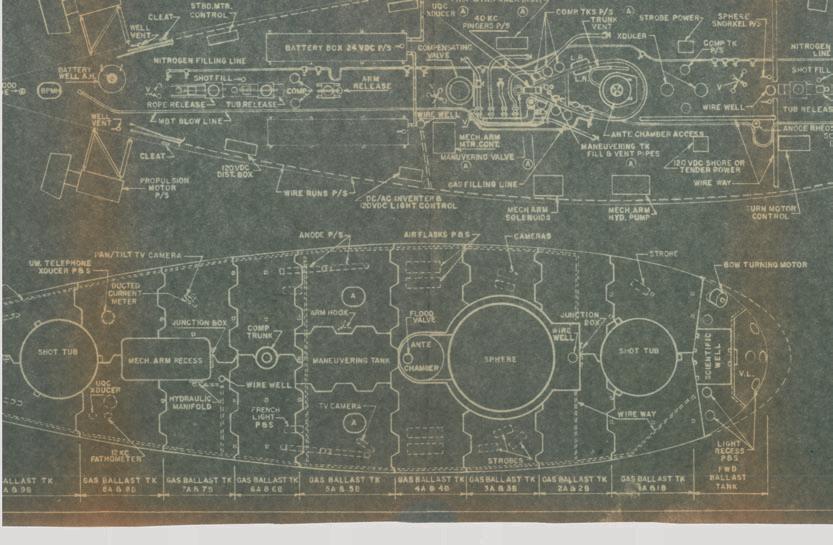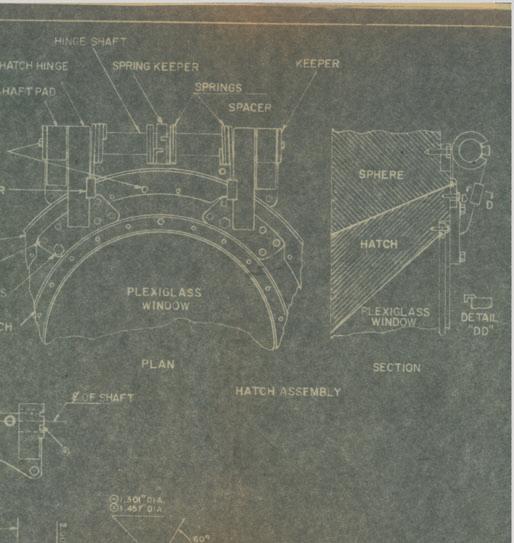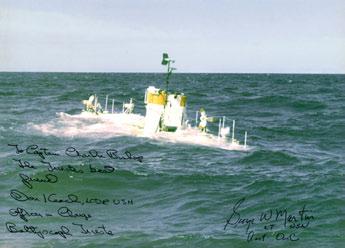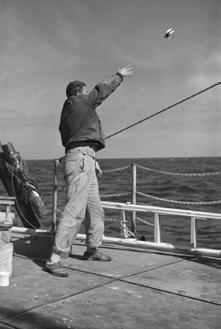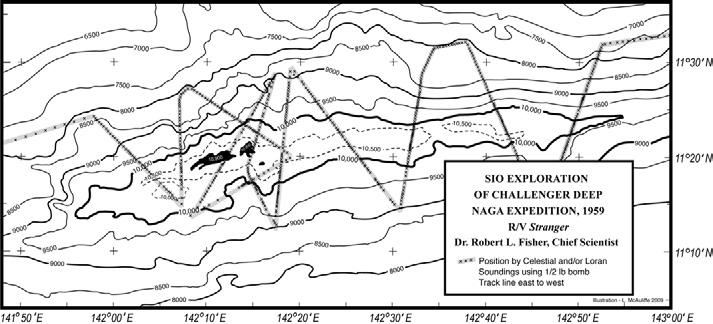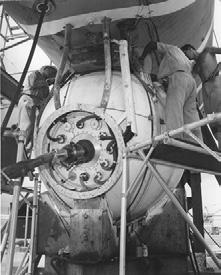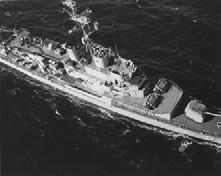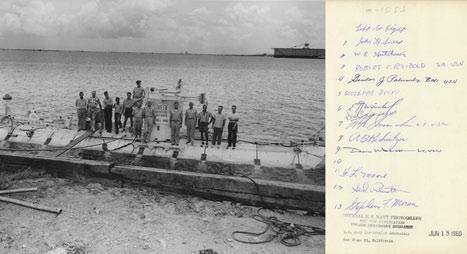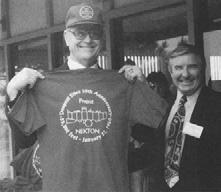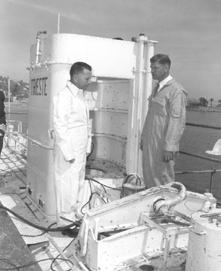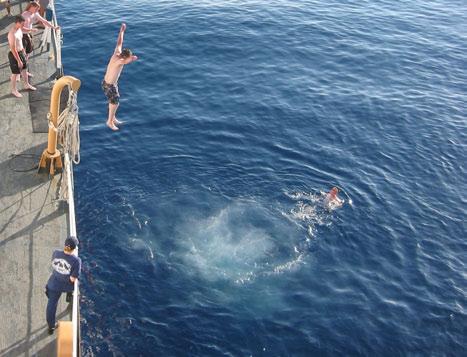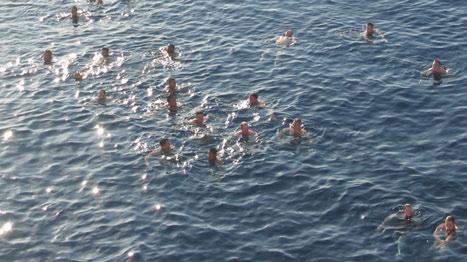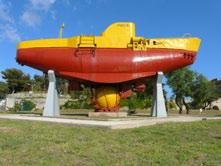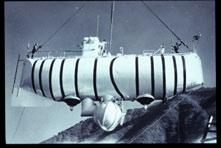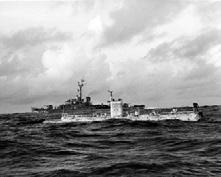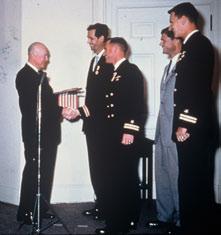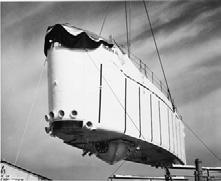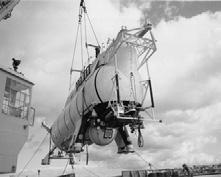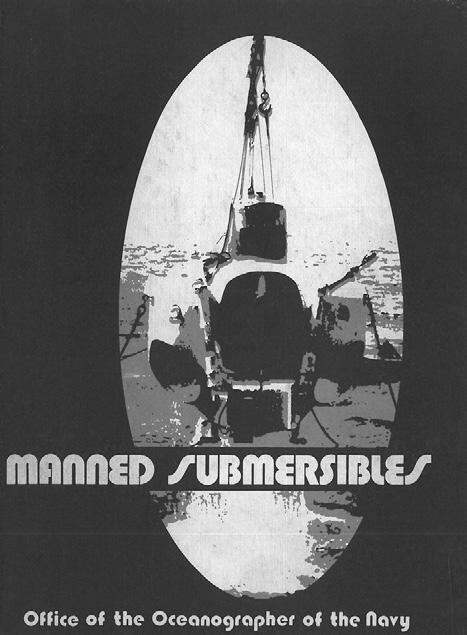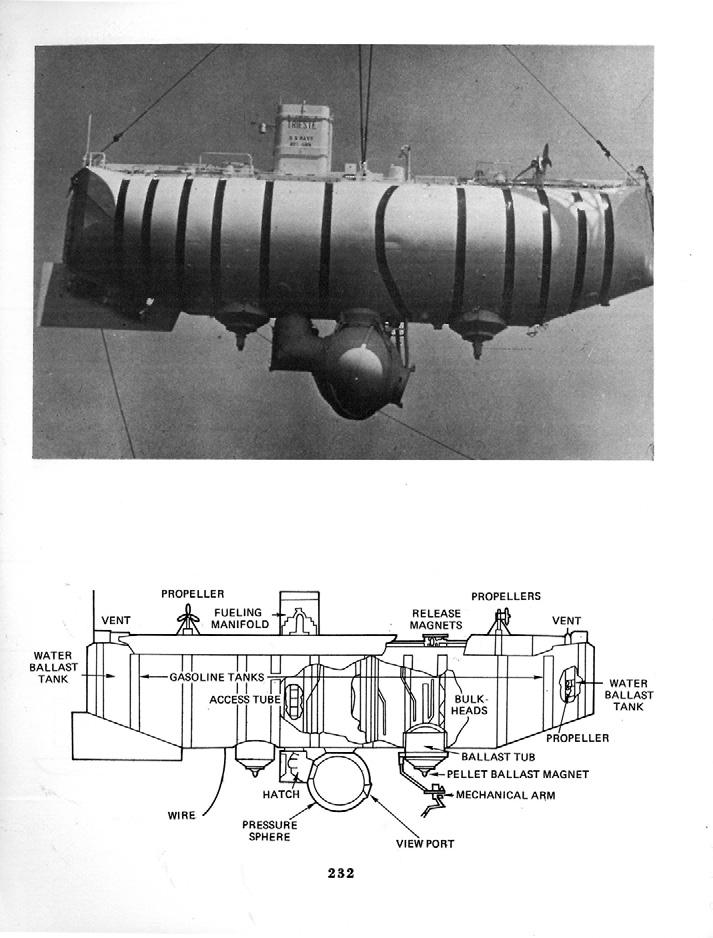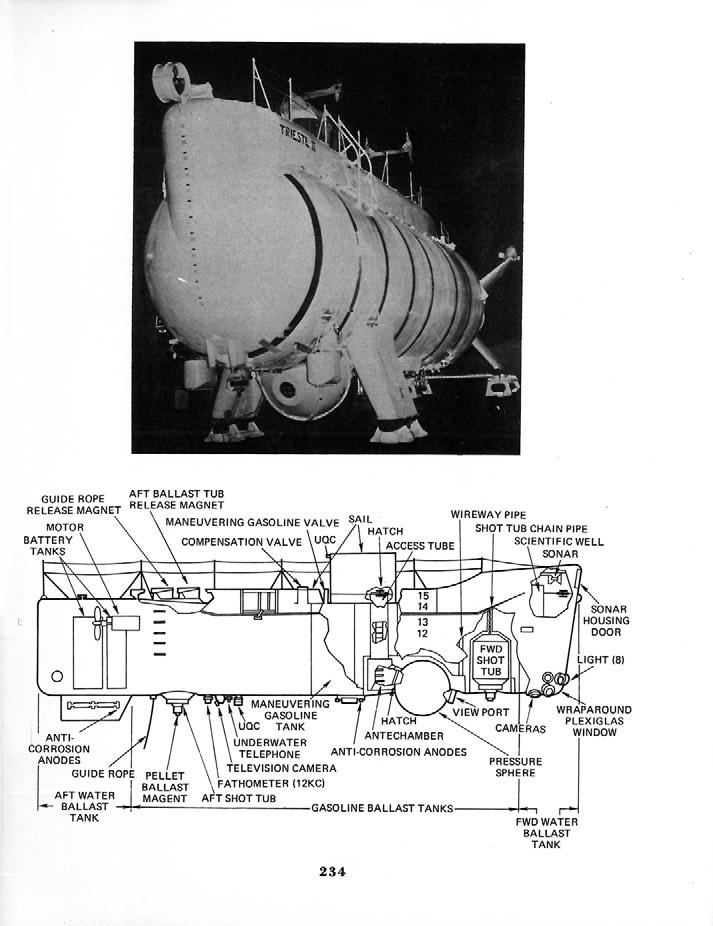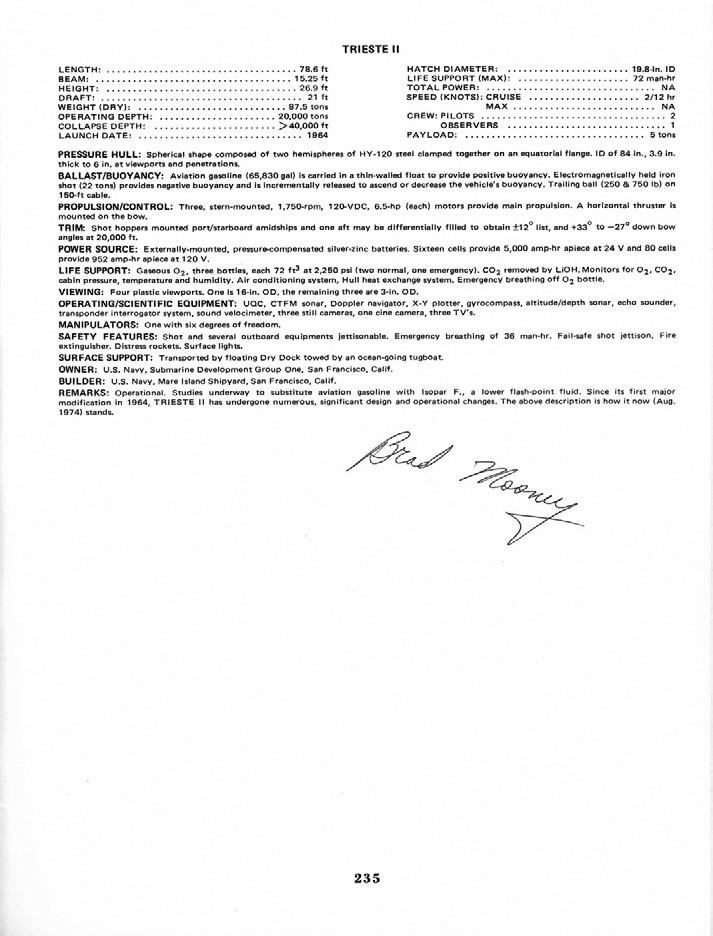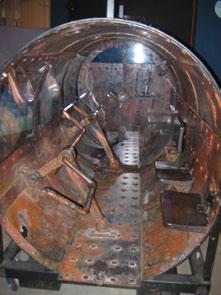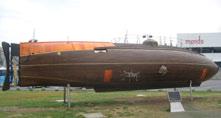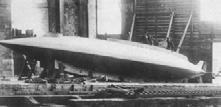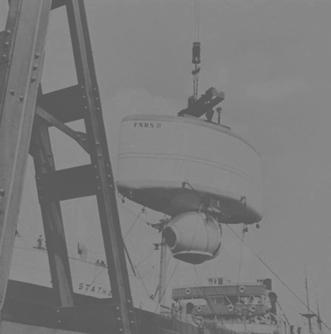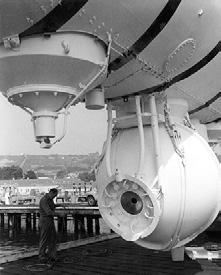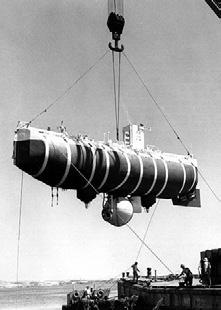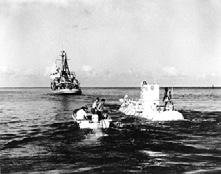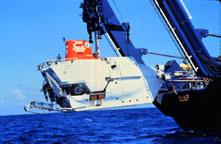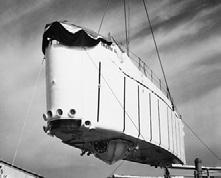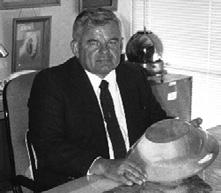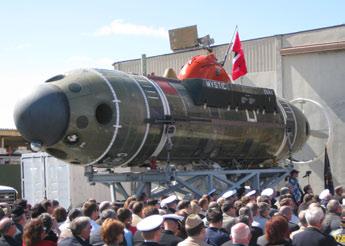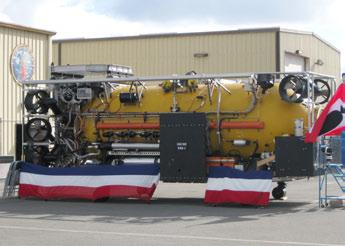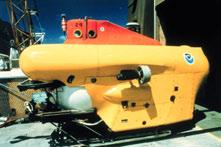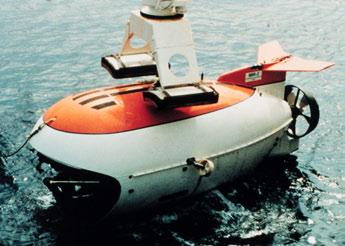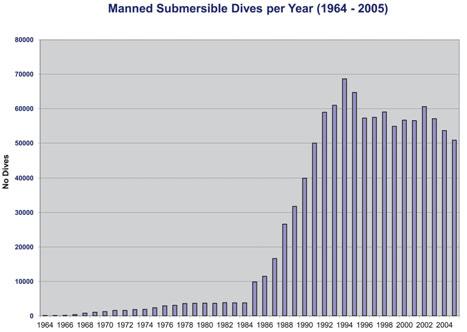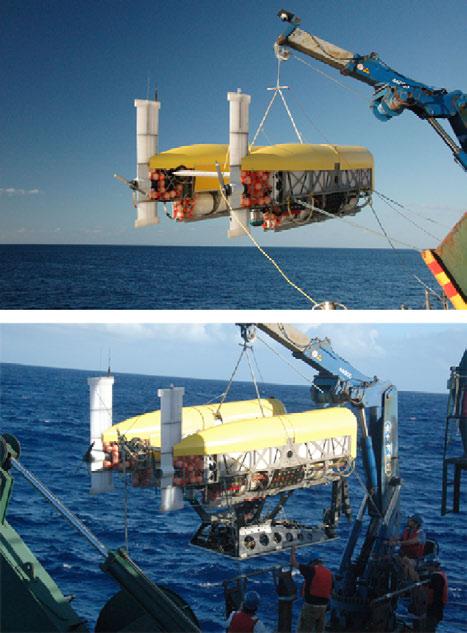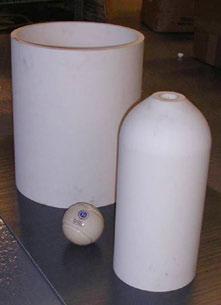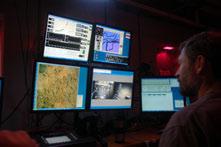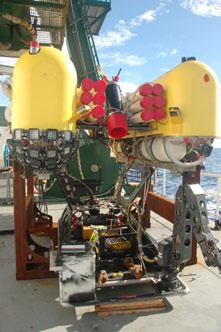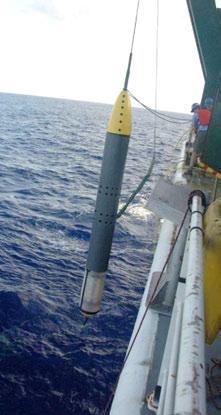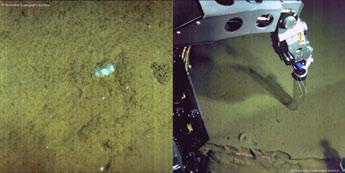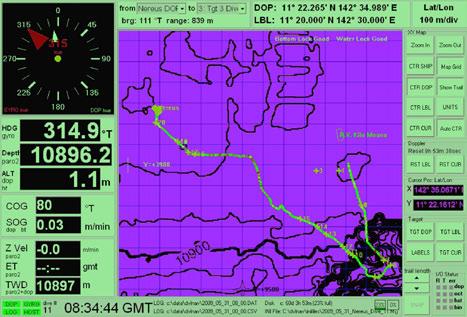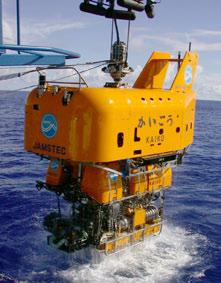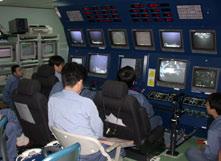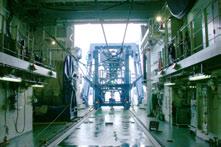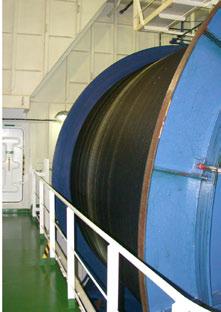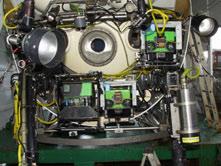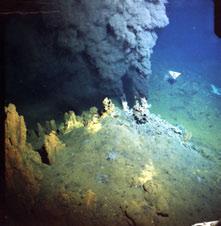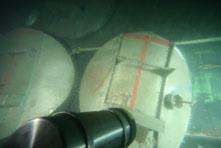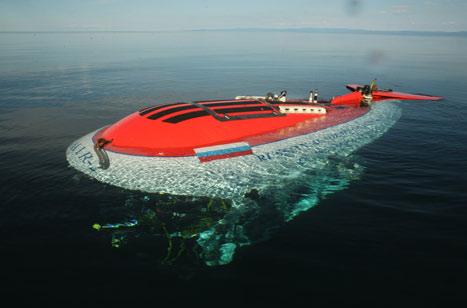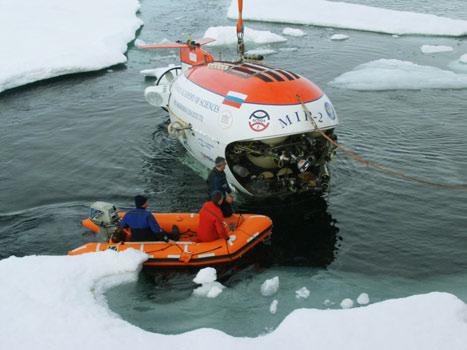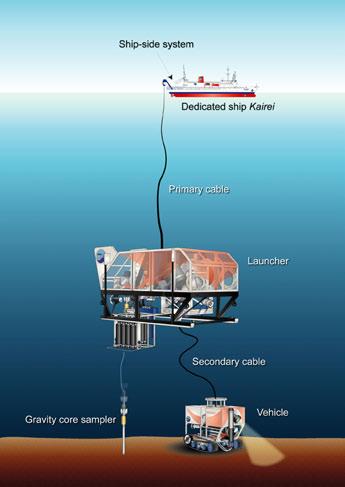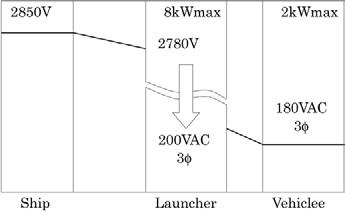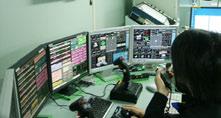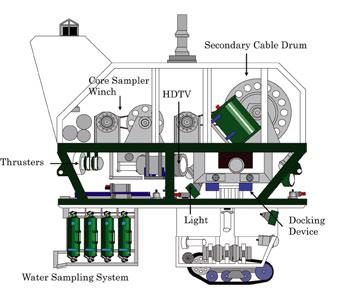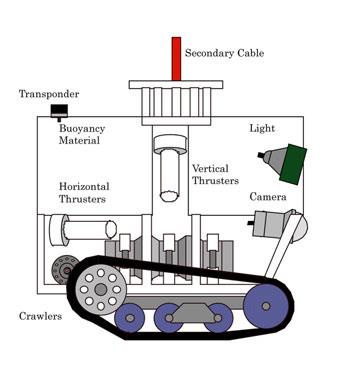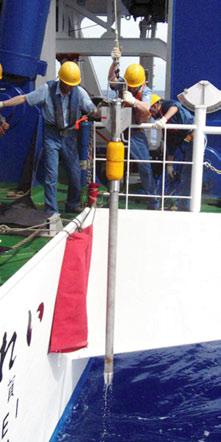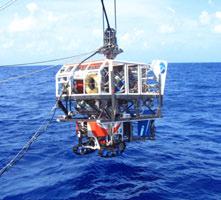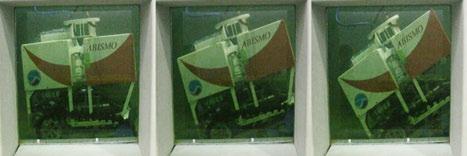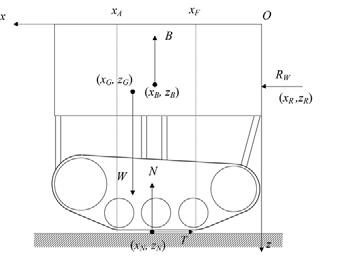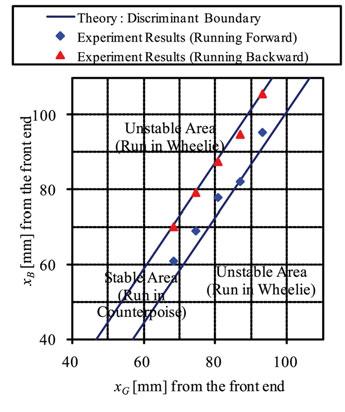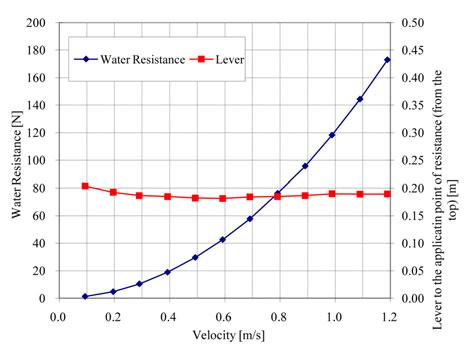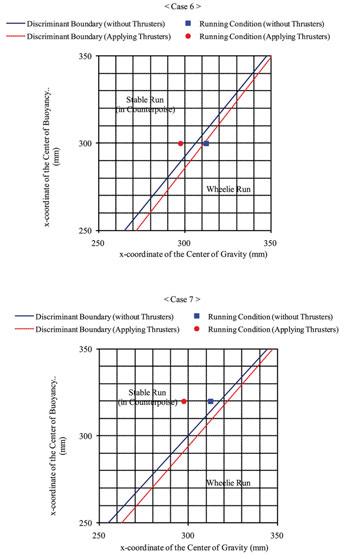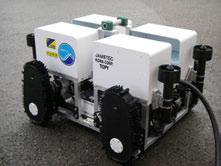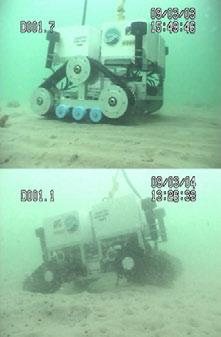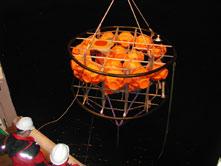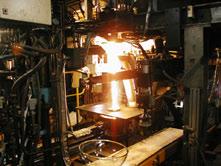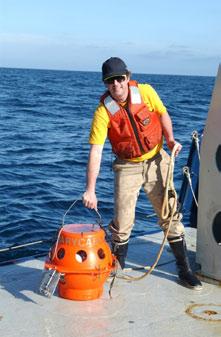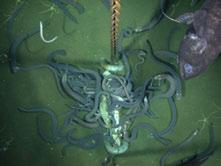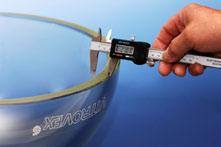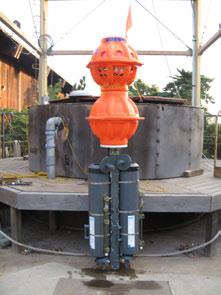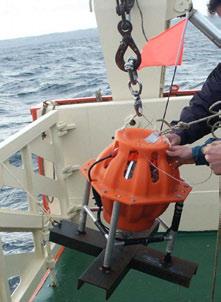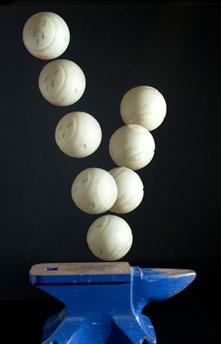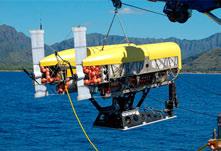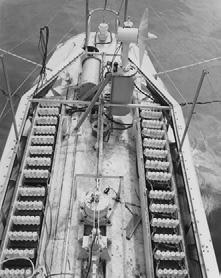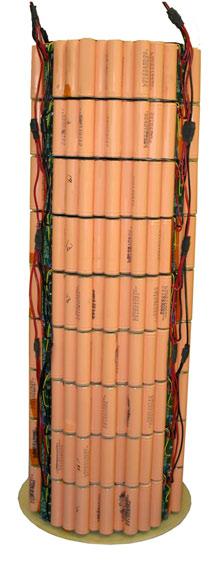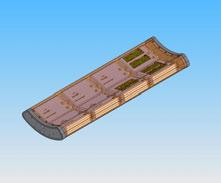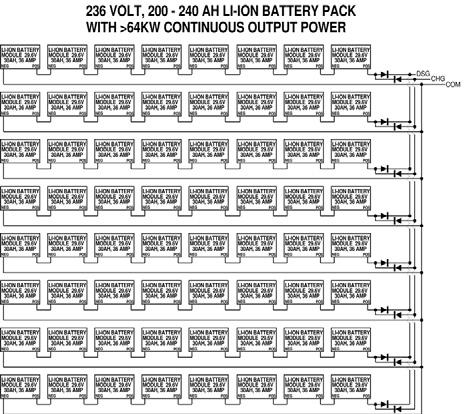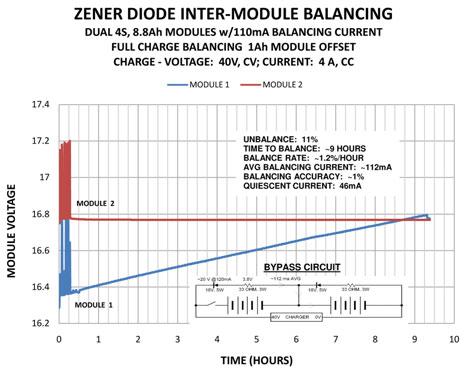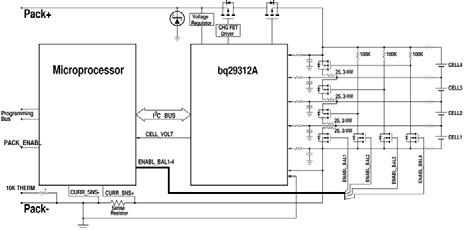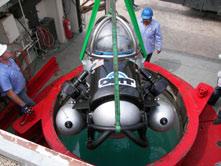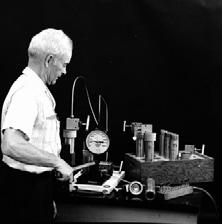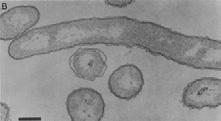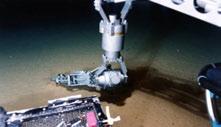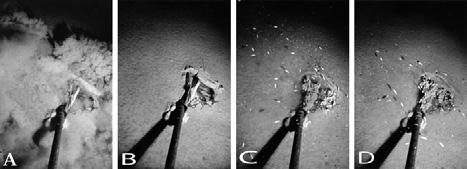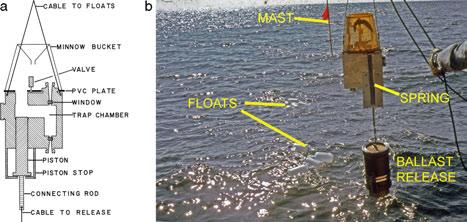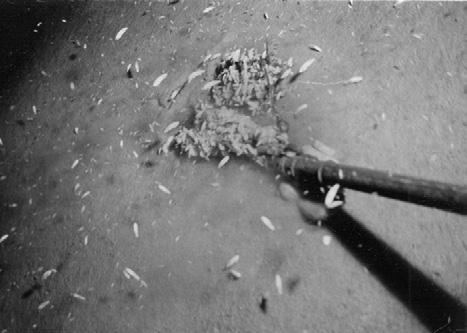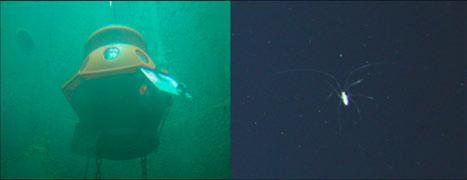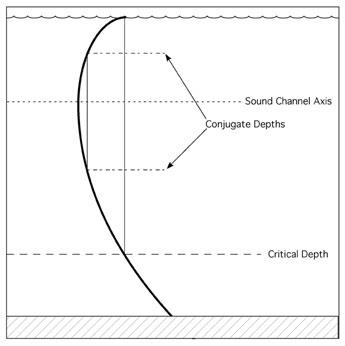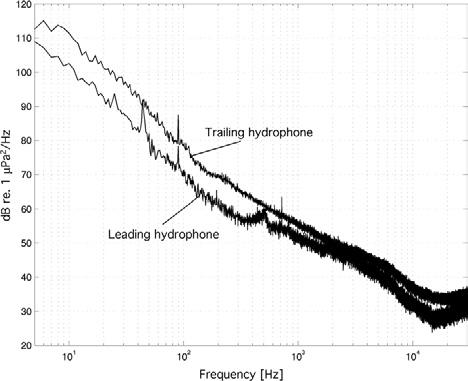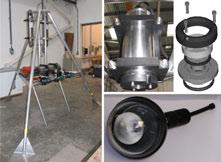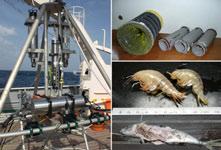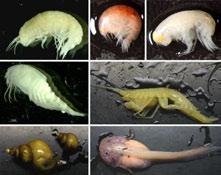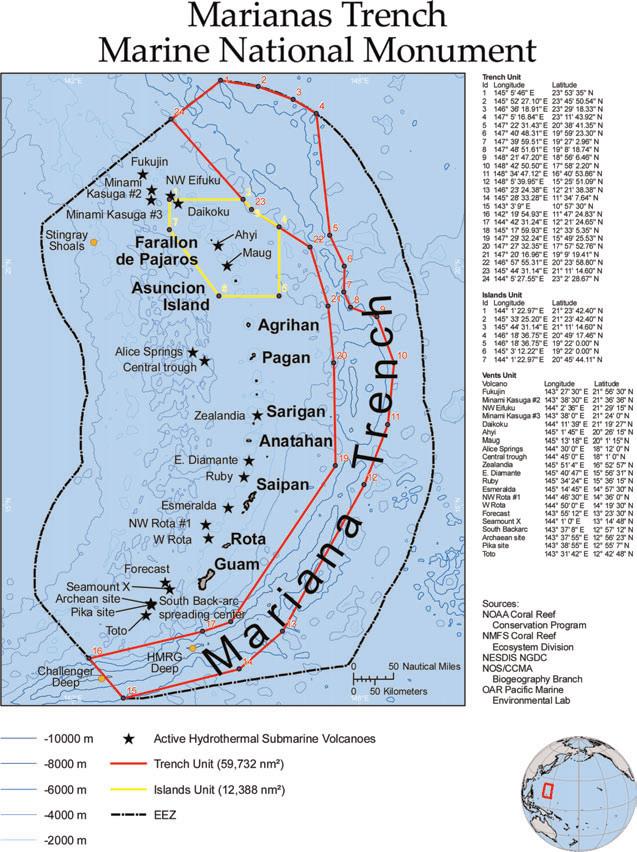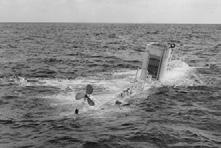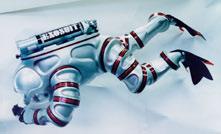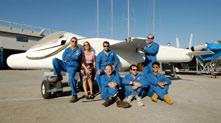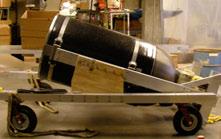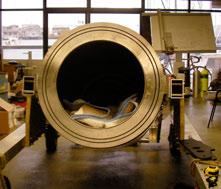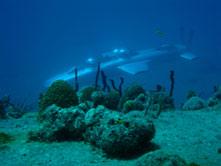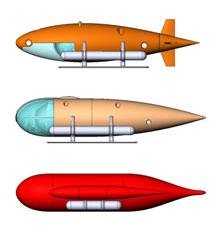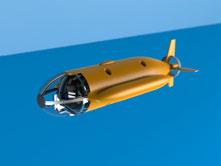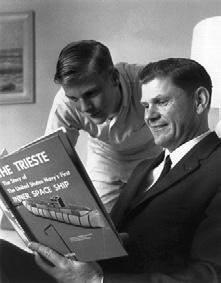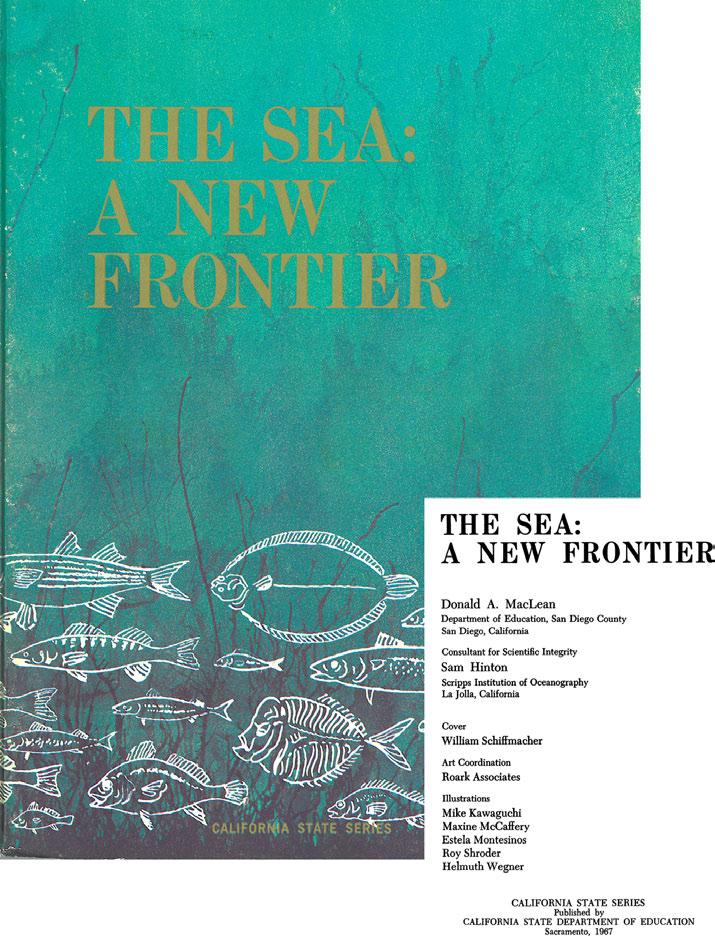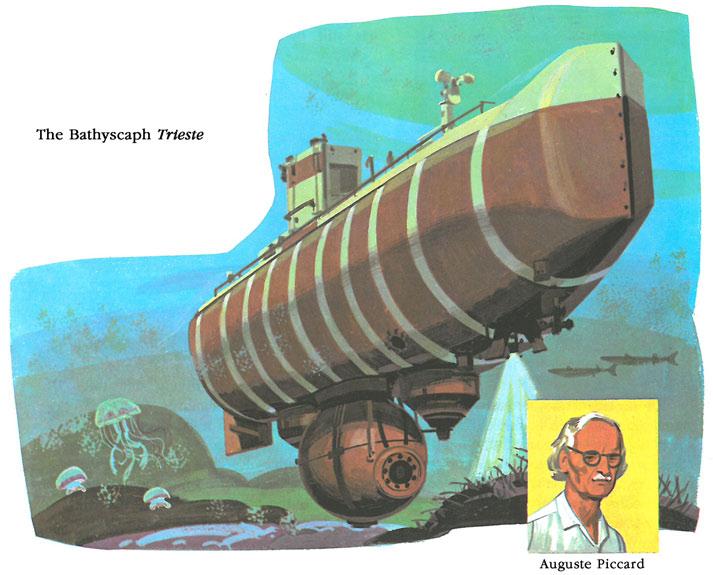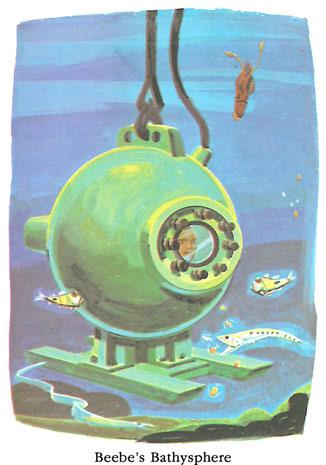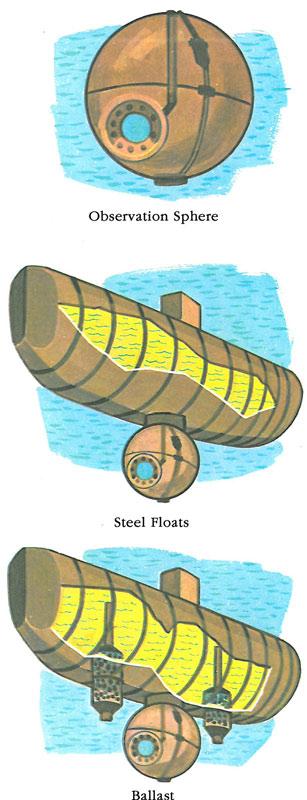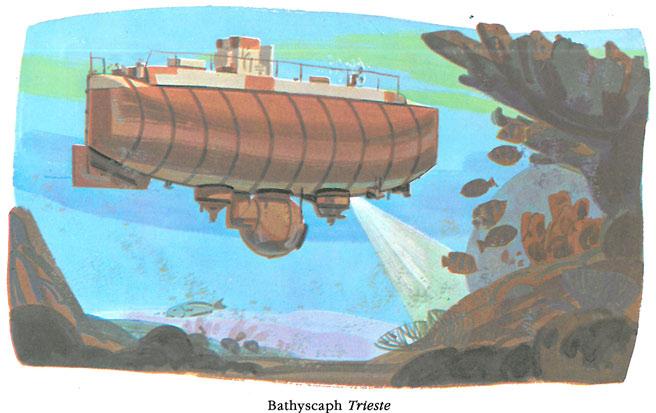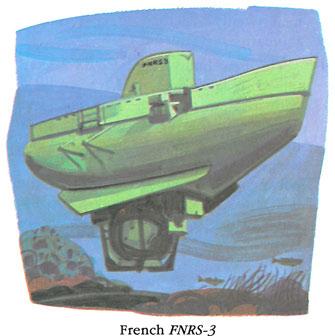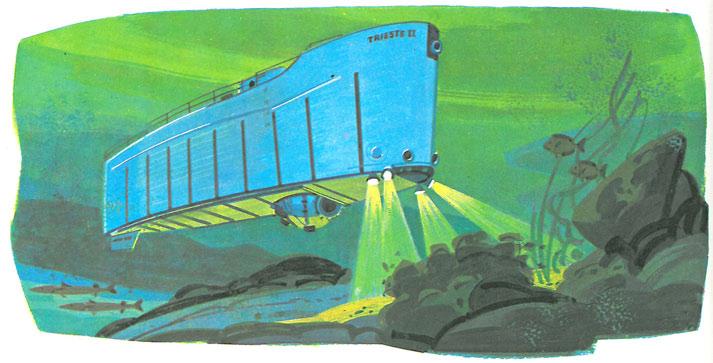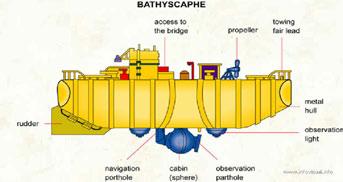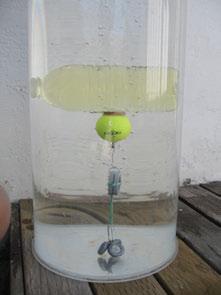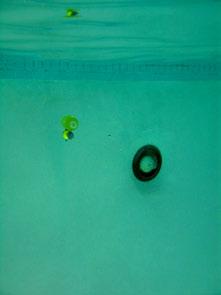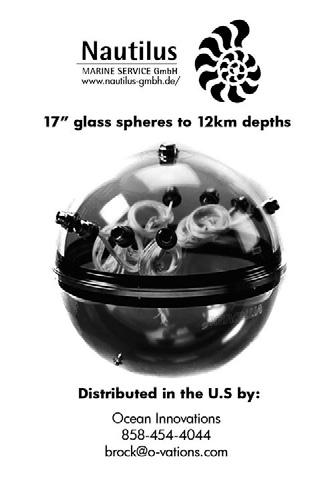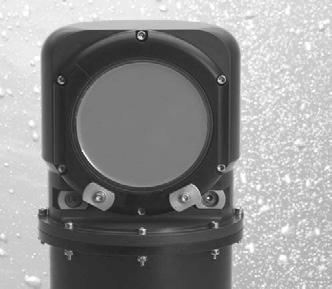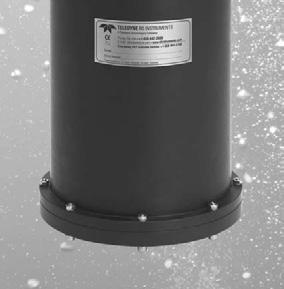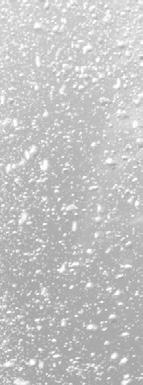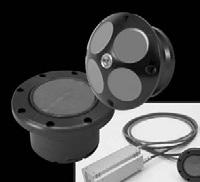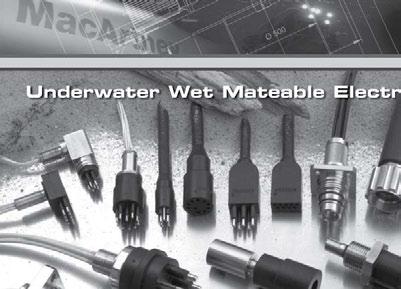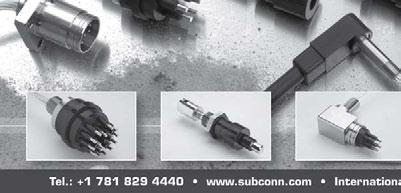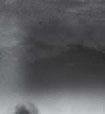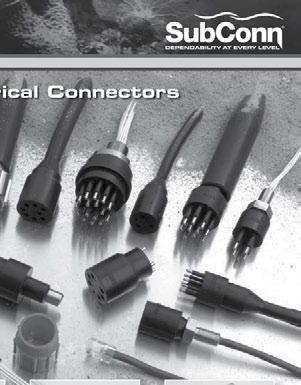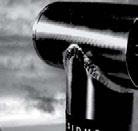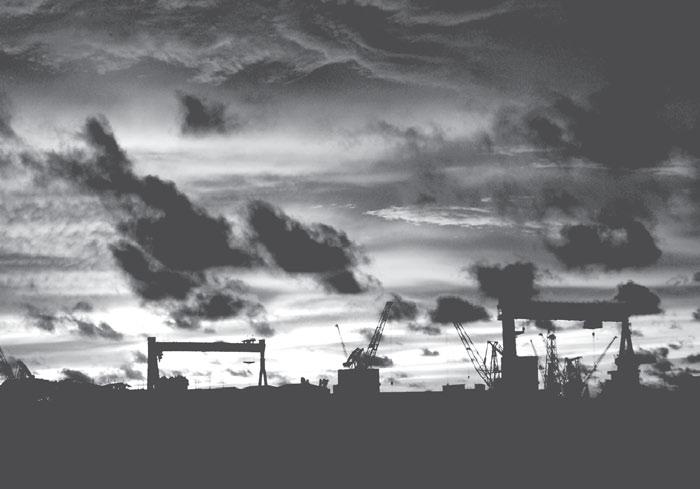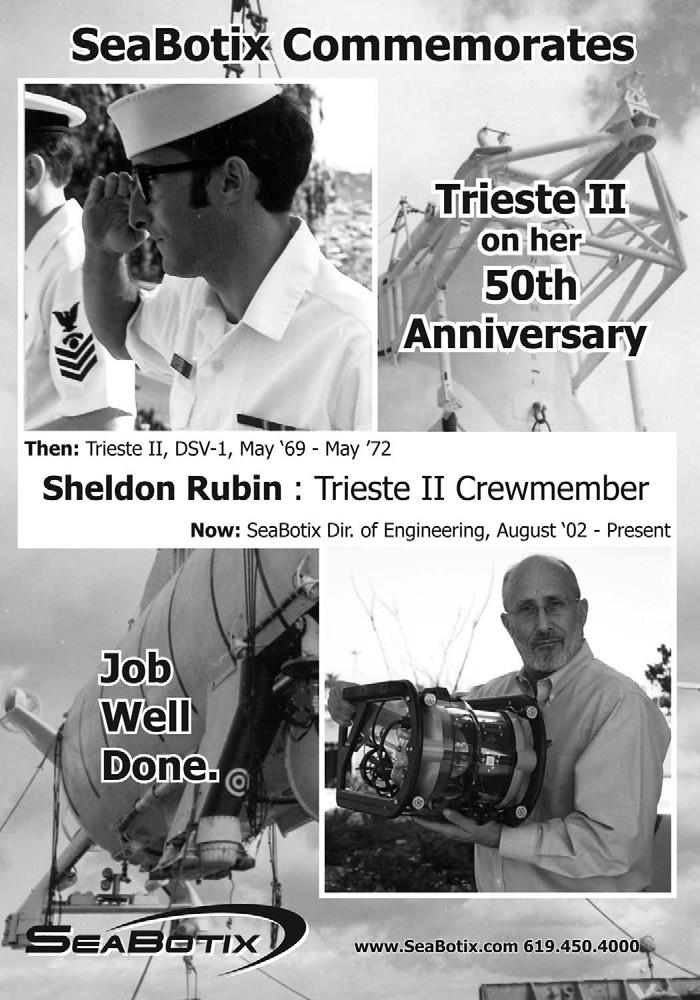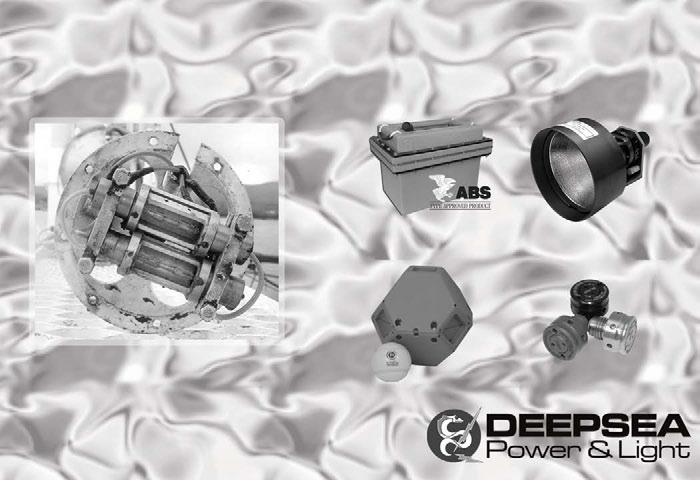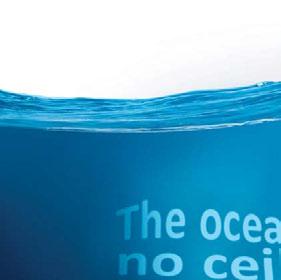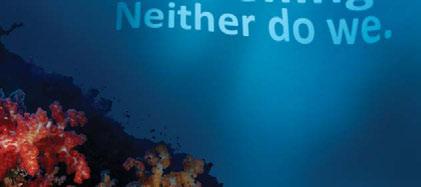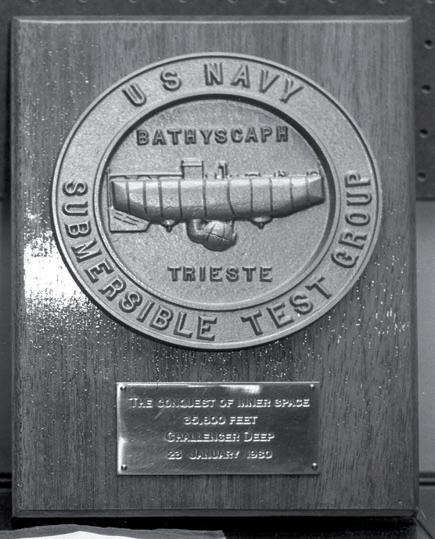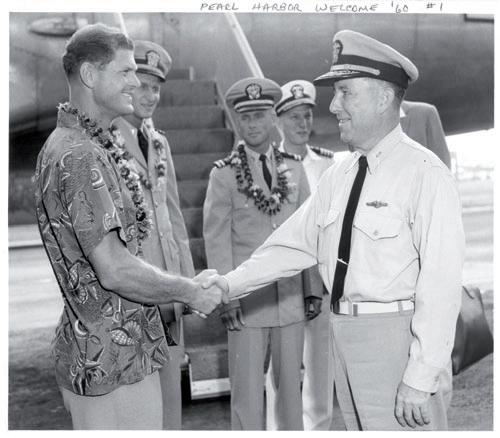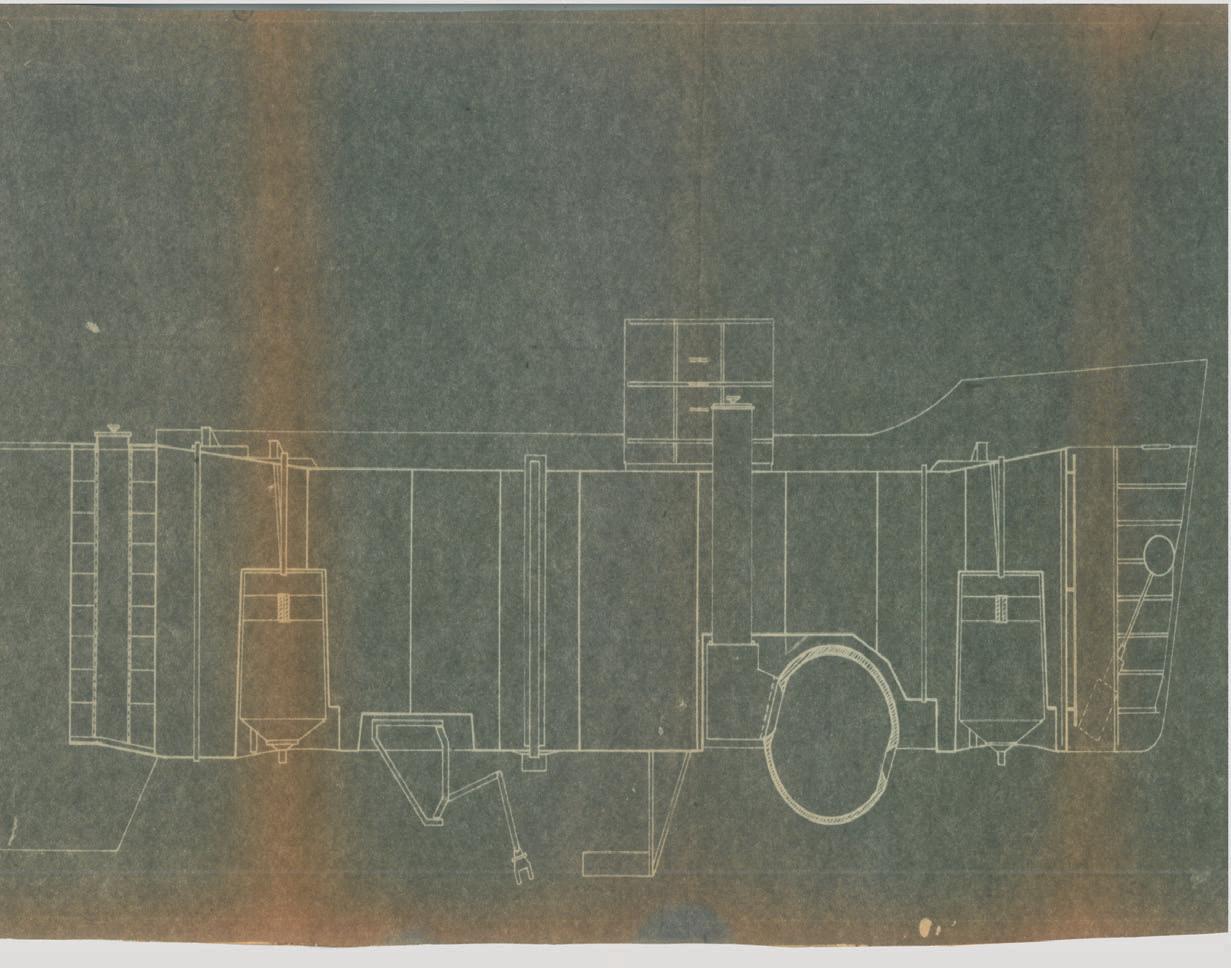Front Cover: Clockwise from top left: Inventor of the bathyscaph Swiss Professor Auguste Piccard examines one of the two acrylic plastic windows used to see outside the personnel sphere; Trieste Top Guns: Lt. Larry Shumaker, AOIC, Lt. Don Walsh, OIC and pilot on the Deep Dive, Dr. Andreas Rechnitzer, Project Nekton Director and Trieste Chief Scientist, and Jacques Piccard, son of Auguste and scientific observer on the Deep Dive; The bathyscaph Trieste as received at Sub Base-Point Loma, San Diego, California. (All photos: U.S. Navy) Trieste II blueprint background courtesy of Sheldon Rubin, SeaBotix, formerly with Trieste II
Back Cover: Clockwise from top left: Plaque given to crew of Trieste commemorating the “Conquest of Inner Space, 35,800-feet, Challenger Deep, January 23, 1960” (photo: Andrea Rechnitzer Fry); Returning to Honolulu following the Deep Dive, wearing a Hawaiian lei, is Trieste Program Director Dr. Andreas Rechnitzer, shaking hands with RADM W.E. Ferrall USN, COMSUBPAC. Behind Rechnitzer, and also wearing leis, are Trieste AOIC Lt. Larry Shumaker and, to his right, Trieste OIC Lt. Don Walsh, pilot of the bathyscaph on the Deep Dive (photo: U.S. Navy); Sixth grade student Justin Linvill studies the operation of his model bathyscaph to learn the physics that brought Trieste back from the deepest ocean trench (photo: Kevin Hardy).
Text: SPi
Cover and Graphics: Michele A. Danoff, Graphics By Design
The Marine Technology Society Journal (ISSN 0025-3324) is published by the Marine Technology Society, Inc., 5565 Sterrett Place, Suite 108, Columbia, MD 21044.
MTS members can purchase the printed Journal for $27 domestic and $50 (plus $50 S&H) international. Non-members and library subscriptions are $420 online only, $124 print—domestic, $140 (plus $50 S&H) print— international, $435 print and online (worldwide); Single-issue (hardcopy) is $20 plus $5.00 S&H (domestic), $10 S&H (international); Pay-per-view (worldwide): $15/article. Postage for periodicals is paid at Columbia, MD, and additional mailing offices.
POSTMASTER:
Please send address changes to:
Marine Technology Society Journal 5565 Sterrett Place Suite 108 Columbia, Maryland 21044
Copyright © 2009 Marine Technology Society, Inc.
In This Issue From Beebe and Barton to Piccard and Trieste Will Forman
Tech Specs: Trieste and Trieste II : From “Manned Submersibles” R. Frank Busby
Human Exploration of the Deep Seas: Fifty Years and the Inspiration Continues William Kohnen
A Look Back at the MTS Journal of June 1990: “A Deepest Ocean Presence” Jack Jaeger, Charles MacVean
Journey to the Challenger Deep: 50 Years Later With the Nereus Hybrid Remotely Operated Vehicle
Barbara Fletcher, Andrew Bowen, Dana R. Yoerger, Louis L. Whitcomb
77
Revisiting the Challenger Deep Using the ROV Kaiko
James P. Barry, Jun Hashimoto
79
From the Bathyscaph Trieste to the Submersibles Mir Anatoly Sagalevitch
In This Issue 87
The ABISMO Mud and Water Sampling ROV for Surveys at 11,000 m Depth
Hiroshi Yoshida, Shojiro Ishibashi, Yoshitaka Watanabe, Tomoya Inoue, Junnichiro Tahara, Takao Sawa, Hiroyuki Osawa
97
Crawler System for Deep Sea ROVs
Tomoya Inoue, Tokihiro Katsui, Hisataka Murakami, Ken Takagi
105
Under High Pressure: Spherical Glass Flotation and Instrument Housings in Deep Ocean Research
Steffen Pausch, Detlef Below, Kevin Hardy
110
Flotation in Ocean Trenches Using Hollow Ceramic Spheres
Steve Weston, Mark Olsson, Ray Merewether, John Sanderson
115
Modular Design of Li-Ion and Li-Polymer Batteries for Undersea Environments
David A. White
123
Pressure Testing: Best Practices
Kevin Hardy, Matt James
Hadal Science
128
Microbial Life in the Trenches
Douglas H. Bartlett
132
Recovery of Live Amphipods at Over 102 MPa from the Challenger Deep A. Aristides Yayanos
137
Living Deep: A Synopsis of Hadal Trench Ecology
Lesley E. Blankenship-Williams, Lisa A. Levin
144
Deep Sound: A Free-Falling Sensor Platform for Depth-Profiling Ambient Noise in the Deep Ocean
David R. Barclay, Fernando Simonet, Michael J. Buckingham
151
HADEEP: Free-Falling Landers to the Deepest Places on Earth
Alan J. Jamieson, Toyonobu Fujii, Martin Solan, Imants G. Priede
161
Charting a Course for the Marianas Trench
Marine National Monument
Michael Tosatto
The Future 164
The Old Arguments of Manned Versus Unmanned Systems Are About to Become Irrelevant: New Technologies Are Game Changers
Graham Hawkes
169
Project Deepsearch: An Innovative Solution for Accessing the Oceans
Liz Taylor, Tony Lawson
178
Excerpt from The Sea: A New Frontier, 1967
Donald A. MacLean, Sam Hinton
187
Modeling the Trieste to Explore Density and Buoyant Force
Marilyn Sniffen, Michelle Hardy
Index to Volume 43
195
Author Index
197
Subject Index
203
2009 Reviewers
Editorial Board
Justin Manley
Editor
Liquid Robotics
Corey Jaskolski Hydro Technologies
Donna Kocak
Maritime Communication Services, HARRIS Corporation
Scott Kraus, Ph.D. New England Aquarium
Dhugal Lindsay, Ph.D. Japan Agency for Marine-Earth Science & Technology
Stephanie Showalter National Sea Grant Law Center
Jason Stanley Schilling Robotics
Edith Widder, Ph.D. Ocean Research and Conservation Association
Jill Zande MATE Center
Editorial
Karin Lynn VP of Publications
Justin Manley Editor
Amy Morgante Managing Editor
Administration
Elizabeth Corbin President
Richard Lawson Executive Director
Susan M. Branting Communications Manager
Jeanne Glover
Membership and Marketing Manager
Michael Hall
Member Groups Manager
Chris Barrett
Director of Professional Development and Meetings
Suzanne Voelker
Subscription Manager
The Marine Technology Society is a not-for-profit, international professional society. Established in 1963, the Society’s mission is to promote the exchange of information in ocean and marine engineering, technology, science, and policy.
Please send all correspondence to: The Marine Technology Society 5565 Sterrett Place, Suite 108 Columbia, MD 21044 (410) 884-5330 Tel. (410) 884-9060 FAX
MTS Journal: morganteeditorial@verizon.net
Publications: publications@mtsociety.org
Membership: Jeanne.Glover@mtsociety.org
Programs: Michael.Hall@mtsociety.org
Director: Rich.Lawson@mtsociety.org
Online: www.mtsociety.org
MEMBERSHIP INFORMATION may be obtained by contacting the Marine Technology Society. Benefits include:
■ Free subscription to the online Marine Technology Society Journal, with highly reduced rates for the paper version
■ Free subscription to the bimonthly newsletter, Currents, covering events, business news, science and technology, and people in marine technology
■ Member discounts on all MTS publications
■ Reduced registration rates to all MTS and MTS-sponsored conferences and workshops
■ Member-only access to an expansive Job Bank and Member Directory
■ Reduced advertising rates in MTS publications
■ National recognition through our Awards Program
Individual dues are $75 per year. Life membership is available for a one-time fee of $1,000. Patron, Student, Emeritus, Institutional, Business, and Corporate memberships are also available.
ADVERTISING Advertising is accepted by the Marine Technology Society Journal. For more information on MTS advertising and policy, please contact Mary Beth Loutinsky, mbloutinsky@att.net
COPYRIGHT Copyright © 2009 by the Marine Technology Society, Inc. Authorization to photocopy items for internal or personal use, or the internal or personal use of specific clients, is granted by the Marine Technology Society, provided that the base fee of $1.00 per copy, plus .20 per page is paid directly to Copyright Clearance Center, 222 Rosewood Dr., Danvers, MA 01923.
For those organizations that have been granted a photocopy license by CCC, a separate system of payment has been arranged. The fee code for users of the Transactional Reporting Service is 0025-3324/89 $1.00 + .20. Papers by U.S Government employees are declared works of the U.S. Government and are therefore in the public domain.
The Marine Technology Society cannot be held responsible for the opinions given and the statements made in any of the articles published.
ABSTRACTS MTS Journal article abstracts, if available, can be accessed for free at http://www. ingentaconnect.com/content/mts/mtsj.
Print and electronic abstracts of MTS Journal articles are also available through GeoRef <http:// www.agiweb.org/georef/>, Aquatic Sciences and Fisheries Abstracts, published by Cambridge Scientific Abstracts <http://www.csa.com/ factsheets/aquclust-set-c.php>, and Geobase’s Oceanbase published by Elsevier Science.
CONTRIBUTORS Contributors can obtain an information and style sheet by contacting the managing editor. Submissions that are relevant to the concerns of the Society are welcome. All papers are subjected to a stringent review procedure directed by the editor and the editorial board. The Journal focuses on technical material that may not otherwise be available, and thus technical papers and notes that have not been published previously are given priority. General commentaries are also accepted and are subject to review and approval by the editorial board.
Winter 2009 Volume 43, Number 5 3
Messagefromthe MTSJournal Editor JustinManley
MTSJournal
Editor
LiquidRobotics
Manyeventsdeservetobecelebrated.Thisspecialissueisacelebrationofourcommunity’saccomplishmentsinthedeepocean.Science,technologyandthespiritofadventure havemotivatedgreatachievements.IammostappreciativetoKevinHardyandBrock Rosenthalfortheireffortsasguesteditors.Ihopeyouenjoythepapers,commentaries, technicalnotes,andhistoricalreviewsasmuchasIdid.
Formyselfthereisanothermomentworthcelebrating,oratleastacknowledging.This issuemarksmylastasEditorofthe MarineTechnologySocietyJournal.Overthe3yearsI haveservedinthisrole,wehaveseenmanychanges.Ibelievethesehavestrengthenedthe publicationandthevalueofmembershipinoursociety.Justasthisissuelooksbackover decadesofachievement,Iwouldliketotakeamomenttoreviewtherecenthistoryofthe Journal.
Since2006,wehavecreatedaregularfocusonthestateoftechnologywithbi-annual specialissues.Wecreatednewconceptsincludingour “bestofconferences” issueandan issuededicatedtotheworkofourstudentmembers.Toaccommodatethesenewideas,and themanyexcellentgeneralpaperswereceive,wehaveexpandedourpublicationtosix issueseachyear.Fiftypercentmorematerialforourreadersatnoadditionalcost that ischangeIbelievein.
Anothermajordevelopmenthasbeenourmovetoanewdigitalplatform.Whiledigital versionsofthe Journal wereavailablemanyyearsago,wehavesubstantiallyimprovedthis service.Wearemakingourarchivesavailableandslowlydigitizingourwaybacktothe earliesteditionsofthepublication.Combinedwithimprovedsearchcapabilitiesandreadability,thenewdigitalformathasbeenpositivelyreceivedbyourreaders.Thenewformat hasalsobeenamajorattractiontoinstitutionalsubscribers.Wehaveseenmanynew organizationssigningontoreceivethe Journal .Thisbothstrengthensthe fi nancesof oursocietyandbringsour flagshippublicationtomorereaders.
Ihavebeenhonoredtoleadthe Journal throughthesechanges,butIhavenotdoneit alone.Throughoutmytenure,Ihavebeensupportedbyexceptionalguesteditorsandmy colleaguesontheeditorialboard(ofwhichIwillremainamember).ItwouldnotbepossibletoremarkuponthisexperiencewithoutofferingthemostprofoundthankstoAmy Morgante.Asourmanagingeditor,sheisthebehind-the-scenesgluethatholdsthispublicationtogether.Tostealanotionfromthenauticalrealm,wecallthe Journal our flagship
publication;ifIamthecaptain,Amyistheexecutiveofficer.Thoseofyouwithseagoing experienceknowhowvaluableagoodexecutiveofficeristotheship.Forthoseunfamiliar, allIcansayisthe Journal couldnotbewhatitiswithouther.Amy,thankyouforsteering meclearoftherocks,helpingmeweathertheoccasionalstorm,andmakingheadwaytothe nextdestination.
Ileavethe Journal wellpositionedforcontinuedsuccessandIlookforwardtosupportingthenexteditor.Iprefernottopullbackthecurtainandwillleaveittomysuccessor tointroducehimselfandhisideas.Sufficeittosay,Ihaveeveryconfidencethispublication isingreathandsandIlookforwardtomanymoreyearsofexceptionalreading.
LiveLikeYouMeanIt KevinHardy GuestEditor
DeepSeaPower&Light
Whatsaysthatbetterthanthelivesoftheoceantrenchexplorersof Trieste ?
Our Journal teamaskedbeforewestarted, “Whatcanbewrittenaboutsuchanhistoric eventthathasn’talreadybeendoneinthepast50years?”
Greatbookscoveredthetopic, “SevenMilesDown” (JacquesPiccardandRobertDietz), “ Earth,SkyandSea ” and “ InBalloonandBathyscaphe ” (AugustePiccard), “ HalfMile Down” (WilliamBeebe), “TheWorldBeneaththeSea” (OtisBarton),and “TwoThousand FathomsDown” (GeorgesHouotandPierreWillm).MTSproduceda Journal issueonthe occasionofthe35th anniversary,reflectedoninthisissuebyJackJaeger.
Manyofthe Trieste pioneersbelongedtoMTSduringtheircareers,andalotstilldo.So itwasunderstoodwecouldnotpassbythisgoldenanniversarywithoutre flectingonce againonwhattranspiredunderblueskiesandblackwaterinthewesternPacificandtaking accountofwhatcametopassbecauseofit.Surely,thebowwaveofthosedaysinthedeep continuestorollforwardthroughtime.
Thecollectiveauthorsinthisissueexaminedthe “why ” and “how” of Trieste.They considered “what Trieste unleashed.” Theywentbackintimetoimportantrelevantevents thatpreceded Trieste andlookedaheadtoways Trieste stillinfluencesthefuture.Inall,this collectionofnotableauthorscoversacenturyandtheglobe.
Inthisissue,youwill findveryinteresting,unpublishedworkfromthetimewhenbathyscaphsruledthedeepsea.Otherstoriesdeta ilmannedvehicles,unmannedfreevehicles, remotelyoperatedvehicles,andautonomousunderwatervehiclesthatdwellinthedark hallsofthehadaldepths,forbiddentoterrestrialairbreathers.
Wearedelightedtopublishtheworkoftwomiddleschoolscienceteacherswhodevelopedanewandinnovativehands-onprojecttoteachconceptsofbuoyancybasedonbathyscaphs.Perhapssomepre-teenstudentswilldiscovertheyhaveaknackforoceanscience andengineeringandpursueacareerthatcouldwellextendintothelatterhalfofthis 21st century.WesuggestthatMTSincludesuchprojectsinfutureissuesofthe Journal. Finally,manythankstomygoodfriendandco-guesteditor,BrockRosenthal,forhis continuedcollaboration;AmyMorgante,theoutstanding MTSJournal managingeditor; andJustinManley,theyouthfulandenergetic MTSJournal editor.Ipointtothecenter ofmygalaxyfor30years,Michelle.She’sthe firsttoseetheglintinmyeyeasIpondera bigprojectandasks “Whatareyouuptonow?” Ouroffspring,JasonandKristin,vigorous
youngadults, flourishinaworldenrichedbythecontributionsofthemselvesandmany. Givemorethanyoutake,andweallliveinabetterplace.
IgratefullyacknowledgethecontributionsofLoraleeMcAuliffeforherartworkand graphicsskills,SheldonRubinforthe TriesteII blueprintsthatappearonthecover,and AnneCresseyandCarolynRaineyfromtheScrippsInstitutionofOceanography.Thiseditor ’ssincerethanksareextendedtoMarkOlsson,Scrippsgraduate,protégéofProfessor JohnIssacs,researcheroftheChallengerDeep,innovatorandentrepreneur,forhisinsights, encouragement,andpatronageofthisacademicenterprise.
Ithasbeenaprivilegetoworkonthis Journal commemoratingthe50thanniversaryof thedeepestdiveevermadebyman.Ihopeyouenjoyit.
HowDeepIsDeep? AUTHOR BrockJ.Rosenthal GuestEditor OceanInnovations
Asamarinetechnologyprofessionalandhistorybuff,Iamhappy tosaythatthisspecial MTSJournal issuecombinestwoofmyfavoriteinterests.Thus,whenIlearnedfrom KevinHardywhathehadinmindto commemoratetheanniversaryofthe DeepestDive,Ididnothesitateto jumpinwhenheaskedifIwould help.
Inordertoexplorethedeepocean, onehastoknowwhereto fi ndit. Measuringthedepths,orhydrographic surveying,isspeculatedbysometobe theworld’ ssecondoldestprofession. Beforecrossingariver,peopleinancienttimesundoubtedlyusedastick toprobethewaterstodetermine depth.Andthousandsofyearsago, theEgyptianswereknowntonavigate theircargovesselsthroughtheNile usingpapyruschartsonthebasisof depthsoundingstakenbymeasuring pole.
Itisinterestingtonotethatdespitethisearlystartinhydrography, throughoutmostofhistory,mankind hadnoideaofwhatdepthstheoceans contained inaveryliteralsense, theywereunfathomable.Soundings weretakento fi ndshallowswhere vesselsmightgetgrounded.There wasnoreasontoplumbthedepths untilthe1870swhenroutesfortransoceanictelegraphcableswerecontemplated.Atthissametime,the fi rst voyagesspecificallyforoceanographic researchwereconducted.
Theclassicmethodformeasuring depthswaswithaleadline,which consistedofalengthofropewitha weight,orplummet,attheend. Whenthelinewentslackandstopped runningout,thelengthofropeinthe waterwasmeasuredasitwaspulled backin.Thistechniqueworkedfairly wellinshallowwaters.Atdeeper depths,theweightoftheropeinthe waterwouldexceedthatoftheplummet,makingitdifficulttodetermine whenthebottomwasreached.Inaddition,thecurrentsworkingonlong lengthsoflinewouldcauseittocontinuetopayoutaftertheweight reachedthebottom.Accuratemeasurementswerefurthercomplicated bythelongertimesneededtodeploy andrecovertheleadline.Sincethere wasnowaytokeepthevesselstationaryindeepwater,theship ’ smovementwouldhavetobefactoredin aswell.
Usingaleadlineforsoundingwas thestateoftheartforhundredsof yearsuntiltheVictorianagewhen thedevelopmentofironwirerope andsteam-drivenwincheschanged thegame.Designingtheseso-called soundingmachinesattractedsomeof theleadingintellectsoftheera.Their inventionswereuseduntiltheearly 20thcenturywhenacousticmethods weredeveloped.
TheChallengerExpeditionof 1872 – 1877wasoneofthe fi rstto reportonthedepthsofdeepocean trenches.TheBritishsurveyship ChallengerII surveyedtheMarianas TrenchnearGuamin1951andidentifiedthedeepestknownpointinthe oceanat35,800feet.Thiswasnamed theChallengerDeep.
Our Journal issuepicksupthe storyfromhere.Weareveryfortunate tohaveascontributorstothisissue someofthepioneersofexploringand researchingthedeepestreachesofthe ocean.Ihopeyouenjoyreadingthis issueasmuchaswedidputtingit together.
IntheBeginning… APersonalView AUTHOR DonWalsh1
BathyscaphTrieste Officer-in-Charge, 1959-1962
InternationalMaritimeInc.
1TheMarineTechnologySocietyadditionally acknowledgesDonWalshforservingasthis Journal'sEditorfrom1976to1980.
Ihavebeenfortunatetobeactivein theworld’ sdeepsubmergencecommunitysinceitsverybeginningsa half-centuryago.However,Iwilladmitinadvancethatmyrecollections maydifferfromthoseofothers.In someways,itisdifficultforaparticipantinhistoricaleventstoavoiderrors ofomissionandfact.WhatIofferhere ishowIsawmyyearswiththeNavy’ s bathyscaphprogram.Hopefully,Ican addalittlebittotheexistingrecordof lessonslearnedandprogressmadeso longago.
ThishistorybeganinJanuary1958 whentheNavy’sOfficeofNavalResearch(ONR)purchasedthe BathyscaphTrieste fromitsinventor, ProfessorAugustePiccardandhis son,Jacques.Bythatsummer,ithad beenshippedfromNaplestoSan Diegotobeginitsnewlifewiththe U.S.Navy.
Inadditionto Trieste anditssupportingequipment,ONRhiredJacques Piccardasaconsultanttotrainour Navyteamtooperateandmaintainit. Jacquesbroughtwithhimhischief mechanic,GiuseppeBuono.
IbecameawareoftheNavy ’ s Trieste programthatsummer.Iwas alieutenantservinginsubmarinesat
1 TheMarineTechnologySocietyadditionallyacknowledgesDonWalshforservingasthisJournal’ s Editorfrom1976to1980.
SanDiegoandassignedtemporary dutywiththestaffofSubmarine FlotillaOnecommandedbyCaptain RalphStylesUSN.
Itwasasummerafternoonwhena Dr.AndreasRechnitzercametomy of fi ceonboardthesubmarinetender Nereus.Hewasfromthenearby NavalElectronicsLaboratory(NEL) andwasthe Trieste programmanager there.Heaskedifhecouldbrief CommodoreStylesaboutthenewly acquiredbathyscaphwhichwasone ofonlytwomannedsubmersiblesin theworld.
SinceSUBFLOTONEwasthe primarysubmarineforcecommand ontheWestCoast, “allthingsunderwater ” wereofinteresttothecommodoreandhisstaff.SoCommodore StylesinvitedAndytodothebriefing atlunchonboard Nereus.HealsoinvitedJacquesPiccardandmetojoin them.
Thebrie fi ngwentverywell. Andy’spresentationaboutthisstrange newdevicewasenergeticandlucid. Evertheentrepreneur,hearranged forabargecarryingthedisassembled Trieste tobetemporarilybrought alongside Nereus .Thesubmersible hadjustarrivedfromItalyandwas beingmoveddowntheharbortoNEL thatday.Aswelookedoverthesideof thetenderatthecollectionofmetal components,Ithoughtitalllooked likeanexplosioninaboilerfactory.
Attheendofthevisit,Commodore Stylesaskedhowhemighthelp.The answerwasimmediate!Andyhoped togettwoqualifiedsubmarineofficers andafewenlistedpersonnelassigned tohisproject.Whilescientistsatthe
laboratorywoulddeterminethescientificprojects,themilitaryteamwould operateandmaintain Trieste .Inhis view,submarinerswouldbeasclose astheNavycouldgettoajobdescriptionfor “bathyscaphpilots.”
Iwasorderedtosendamessageto allthesubmarinesontheWestCoast askingforvolunteers.Remarkably, therewasonlyone.Goodnewsfor me thiswasmychancetogetaway frombehindmydesk.Ivolunteered andwasselectedfortheprogram.Regrettably,Iwasnotpresentfor Trieste’ s fi rstU.S.NavydiveinDecember 1958.
Amonthlater,IreportedtoNEL andshortlythereafterwasdesignated as Trieste’sOfficer-in-Charge(O-in-C). Theprojectwasintheearlystagesof settingupitsoperatinghomeportat thewaterfront.Itwasaverybusy timeasacompletesupportinfrastructurewasputintoplace.
Andyhadrecruitedafewpermanentcivilianstaffforhisteam.They joinedJacquesPiccardandGiuseppe Buonoandbegantolearnaboutthe “ careandfeeding ” ofthisstrange newscientificplatform.
The firstNavypersoninourgroup wasSeniorChiefPettyOfficerE.John Michel.Aninventiveandbrilliant machinist,hehadbeenrecruitedby AndyjustbeforeIjoinedNEL.I thengotsubmarineofficerLieutenant LarryShumakertobeassignedasthe AssistantOf fi cer-in-Charge.Bylate springof1959,wehadaddedanother chiefpettyofficeranda firstclassboatswain’ smate.
Asoneofonlytwodeepdiving mannedsubmersiblesintheworld
(theotherwastheFrenchNavy ’ s FNRS-3bathyscaph),our “schoolof thebathyscaph” wasmoreofanapprenticeshipthanformallearning.At times,itseemedthatIspentmore timeinoverallsthaninmyNavyuniform,butLarryandIwereusedto thisasthatishowwequalifiedinsubmarinestoearnourgolddolphins.
InMarch,Ihadmy fi rstdive.It wastoadepthofabout4,000feet, butIwasveryimpressed!Ihadlittle knowledgeofoceandepthsbeyond whereasubmarinecouldsafelyoperate.Mylastsubmarinehadamaximumoperatingdepthof300feet. Soaslongastherewasacomfortable amountofwaterunderthekeelat thatdepth,thenthatwasallIneeded toknowaboutdepths.Yetonly 10monthslater,Iwouldbedivingin Trieste toadepthofnearly 7miles!
Ididnotknowabouttheproposed deepdiveprojectwhenIreportedto NEL.Andyhadnotmentioneditin hisbrie fi ngtothecommodore.It turnedoutthatthereweregoodreasonsforthis.WhilethePiccardsand ONRrepresentativeshaddiscussed thiswhenthe Trieste waspurchased, theNavy ’stoppolicylevelswerenot awareofit.Curiously,wedidhave theONRfundingtodothenecessary modificationsofthebathyscaph.
Itwasveryfortunatethatthe oceans ’ deepestspot,Challenger Deep,wasonlyabout200milesfrom theIslandofGuam,becausetherewas amajorNavypresencethere.Itwould berelativelyeasytoestablishouroperatingbaseattheNavalShipRepair Facilitywaterfront.
Onceorganizedonsite,wewould beginaseriesofprogressivelydeeper testdivestoworkourwaydownto thebottomoftheMarianasTrench. IfwecouldgetsetupatGuamby
latesummerof1959,thenweshould beabletodothedeepestdiveby January1960.
Early1959,ourprojectwas named “ ProjectNekton ” afterthe freeswimmingcreaturesinthesea. Itwasagenericnamethatbarely fit theunderpowered Trieste.NELgeologistDr.RobertDietzhadsuggested thename.Earlierhehadbeenstationed attheLondonONRof fi ceandhad beeninstrumentalinthepurchase negotiationswiththePiccards.
Originally, Trieste hadadepthratingofabout20,000feet.ThePiccards claimeditcouldsafelymakethediveto theplanneddepthof36,000feet. Nevertheless,itwasdecidedtogeta newspherefromtheKruppWorks inGermany.Theyweretheonlysupplierwhocouldproduceitontimeand withinourbudget.
Alsothe float(balloon)hadtobe enlargedtoprovidethebuoyancy neededforgreaterdepths.Thiswork wasdone,basedonourdesignrequirements,attheNavy’sShipRepair FacilityinSanDiego.
Meanwhile,backatNEL,the Trieste teamwasbusyworkingtodevelopnewon-boardequipment,sensors,andsamplers.Itwasslowgoing; therewereno “ off-the-shelf ” suppliers.Oursmallteamhadtodesign andbuildeverythingusingtheNEL shopsorlocalbusinessesthatcould buildfromourspecifications.
Ontheoperationalside,Iworked withAndyandLarrytopreparea proposaltogetNavyDepartment approvalforProjectNekton.Wedevelopedanoperatingplanandgotit approvedbythelaboratory’ stopmanagement.Whenitwasforwardedto Washington,Iwentbackthereto helppushthingsalong.
Tomysurprise,Iwasquickly passedupthroughtheofficesofcom-
manders,captains,andadmiralsat ONRandtheOfficeoftheChiefof NavalOperations.Noonewantedto makethe fi naldecision.Ultimately, I,alieutenant,endedupinfrontof AdmiralArleighBurke,Chiefof NavalOperations.
AdmiralBurkeaskedmewho wouldbemakingthedive.Ireplied thatI,astheNavycommanderof Trieste ,andDr.Rechnitzer,ourchief scientist,wouldbeonboard.Furthermore,ItoldhimthatLt.Shumaker wouldbeinchargeoftopsideactivities.Burkethensaid, “Iwantyouto tellShumakerthatifthe Trieste does notcomeback,thenyou,Walsh, aretheluckyonebecauseIwillhave Shumaker’sballs.”
Regrettably,Andydidnotmake thedivebecauseJacquesPiccardinvokedaclauseinhiscontractwith ONRthatgavehimtherightto makeanydivesthatwere “ different orunusual. ” SoAdmiralBurkemandatedthatJacquesandIwoulddive, eventhoughIhadsaidIwouldstep asideinfavorofAndy.HewasaCDR intheNavalReserveandtheNavy couldhaveorderedhimtoactiveduty. Thenwewouldstillhavehadanaval of ficeronboard.However,theNavy didnotagreetothat.Verysad,as Andydeservedtobethere.
AfterIhadbriefedAdmiralBurke aboutProjectNekton,hereluctantly agreedtoletusproceed.However, hestipulatedthattherewouldbeno Navypublicityinadvanceofsuccessfulcompletionofthedeepestdive. The “nopublicity” mandatewas fine withus;mediaattentionwouldinterferewithourtighttimetableforgetting outtoGuam.Theimportantthingfor uswashavingthehighestlevelapproval forgoingtotheoceans’ greatestdepth.
Bysummer1959,allofthiswork convergedatNEL’swaterfront. Trieste
wasreassembledfortestingandaharbortestsubmergence,followedbyan 800footoffshoredive.Everythingwas satisfactory,andonOctober5th, Trieste wassentbyshiptoGuam.Thenthe projectteam fl ewouttheretosetup ouroperatingbaseinApraHarbor.
BylateOctober,thebathyscaph wasreassembledandourtestdiving programbegan.Bytheendofthe year,wehaddoneeighttestdives. ThedeepestwasinNovemberwhen AndyandJacquesPiccarddoveto 18,150feettosetanewworld’sdepth record.Thepreviousrecordwasheld bytheFrenchFNRS-3witha1954 diveto12,300feet.
Uptothispoint,ourdiveshad beenrelativelytrouble-free,buton thisone,weranintoabigproblem. TheKruppspherewasmadeofthree pieces;insteadofamechanicalfastening,theyweregluedtogetherwith epoxycement.Aftersurfacingfrom thedive,thegluedjointfailedwitha greatbang.Atthetime,thecauseof thenoisewasnotevident,butonce backinharbor,wefoundevidence thatwaterhadseepedintothesphere alongthegluedjoint.Weneededto dry-dock Trieste and fi gureoutifwe could fixtheproblem.Alsowedecided nottobotherourmastersatNELwith thisparticularsituation.Mostcertainlythiswouldhavebeentheend ofProjectNekton.
JohnMichel figuredoutabrilliant althoughunorthodox fi xusinglocal materials.Hebuiltaseriesofmetal bandsthatwouldmechanicallyhold thespheresectionstogetherafterputtingautomotivegasketcompound andrubberstripsalongthetwojoints’ externalsurfaces.Usingaforkliftholdingapieceoftimberasa “ battering ram, ” he “bumped” thespheresections untiltheywereoutofalignmentby onlyafewthousandsofaninch.Con-
sideringthatthespherethicknesswas between5and7inches,wewereconfidentthatwehadagoodandsafe fix. Evenatthispoint,wedidnottellNEL whathadhappened.
InDecember,our finaldiveswere totestthesphere fi xandtodopilot trainingdivesinApraHarbor.While JacquesPiccardhadgonebacktoSan DiegoforChristmas,therestofthe teamstayedatGuam.Weneeded thattimetogetourequipmentready forJanuarydivestotheNeroDeep andChallengerDeep.
Onthe8th ofJanuary,theNavytug Wandank (ATA-204)andthedestroyer escort Lewis (DE-535)leftApraHarbor fortheNeroDeep. Wandank towed Trieste atastately5knotswhile Lewis actedasour “commandship” formost ofourgroup.
Wereachedthedivesiteonthe 9 th ,andwithwell-practicedmoves, thebathyscaphwasquicklyrigged foradive.WithJacquesandmyself aboard,wesubmerged.Thebottom wassightedat23,000feet,butwe didnotland.Wewantedtokeep this finaltestdiveasbriefaspossible toquicklygetbacktoGuamtoprepareforthe finaldive.
OnJanuary20,ourlittleconvoy againleftGuamforthemoredistant divesiteoftheChallengerDeep. Lewis wentaheadoftheslowmoving Wandank sowecoulddoourdepth soundingsto findthe “ exact ” location ofthedeepestpartofthesite.
Lewis didnothaveadepthsounder capableofmeasuringsuchgreatdepths. SoAndyarrangedtouse1-pound blocksofTNTandstopwatchesto timetheexplosionsandtheirreturn echoes.Watcheswerestartedwhen theblockexplodedandthenstopped whenthereturnechowasheardon theship’sfathometerhydrophone.So 12secondswasdeeperthan10seconds
andsoon.Afewdayslaterwhen Trieste arrivedonsite,Andyhad fi guredoutthatthe “ targetzone ” was aboutamilewideand7mileslong.
Trieste wasquicklydisconnected fromitstowingline,andteammemberswentaboardtoprepareforthe dive.The firstorderofbusinesswasto inspectforanytowingdamage.Many oftheexternalequipmentitemswere veryfragile.Evenatatowingspeed of5knots,somethingcouldhave beenrippedoffenroutetothedive site.Wefoundafewitemsmissing butnoneweremissioncritical.
Theseastateonsitewassixtoseven, soweneededtogetstartedassoonas possibletoavoidanyadditionaldamage. Thedivestartedatabout0800hwith Jacquesandmyselfonboard.Itwas the23rd ofJanuary,1960.
Initially,ourtrimwasgood,but thenwehadaproblemgettingthrough thethermoclineas Trieste wasonly slightlynegativelybuoyant.Wevalved offalittlegastogetheavy,and finally, wewereonourwayatagoodrateof descent.
Thediveproceededsmoothlyuntil about31,000feetwhenagreatbang shookthesubmersible.Welookedat eachotherandourinstruments.All seemedwell,soweproceededwiththe dive.Wetoucheddownsmoothlyafter near5hours.Thenanothersurprise,the depthgaugeread37,800feet!Hadwe foundanevendeeperspot?Later,we foundoutthatthedepthgaugehad beencalibratedinSwitzerlandusingdistilledwater.Correctingforthedensity differencebetweenthatwaterandseawater,ouractualdepthwasabout 2,000feetless.
OnceonthebottomIfoundout whatthe “ bigbang ” was.Itwasa crackedwindowatthebackofthe entrancetubethatleddownfromtopsidetothehatchonthesphere.This
tubewas fl oodedduringthedive andhadacurvedacrylicwindowat theback.Thisletuslookthrough theportinthehatchtotherear ofthebathyscaphtochecktheaft ballasttubandtheexternallights.
Seapressureactingequallyonthe insideandoutsidefacesofthelarge windowhadcausedtheacrylicto creepagainstitssteelframe.There wasnotenoughslackroominthe frametoaccommodatethismovement,andthestoredupstressresulted inthebangasthewindowcracked.
Theproblemwasnotourimmediatesafety.However,wemightnotbe abletoletourselvesoutofthesphere whenbackonthesurface.Ifnot,we wouldremaininthesphereuntilwe gotbacktoGuamandcoulddry-dock Trieste.Thismightbe5to7days.It wasnotanattractiveprospect…
After20minonthebottom,we madeaquickthree-and-a-halfhour tripbacktothesurface.Oncethere, weusedcompressedairtocarefully blowthewateroutoftheentrance tube.Thecrackedwindowheldand wequicklyleftthesphere,shutthe hatch,andwenttopside.
Onceonthesurface,theseastate hadincreasedtoabout8andwe couldnotseeanysignof Wandank or Lewis.Itwasalonelyfeelingafter our9-hourdive.Beforeleaving Guam,Ihadgottenanaviator’ semergencytransmitterandadvisedNavy andAirForceunitsaboutouroperationalplans.Asaresult,therewere aircraftsintheareawhenwesurfaced. Theyquicklyspottedusandvectored theshipstoourlocation.
Whydidweonlyspend20minat thebottom?Therewerethreereasons: lengthofday,seastate,andbottom sediment.
Althoughwewereinthetropics,it waswintertime.Thedayswereshorter
andtheseastatewasprettyroughfor ouroperation.Therefore,wewanted asmuchdaylightaspossiblefordroppingthetowbeforethediveand tohookupthetowafterwards.The 1-inchtowingwirehadtobehand connectedto Trieste withsomeofour teammembershangingoverthefront ofthevehicle.Theotherendofthe wirewasattachedtoalargetowing ship.Thepossibilityofinjuringsomeonewouldbegreatlyincreasedinpoor light.
Thethirdreasonwasthecharacter ofthebottomsedimentwherewe landed.Itwasa “diatomaceousooze,” very fi neandlightcolored.Aswe landed,acloudofsedimentwas stirred.Thishappenedwithallofour divesandusuallyafterafewminutesit woulddriftaway.Notthistime.The cloudremainedfortheentiretimeon thebottomandshowednosignsof movingaway.Itwaslikelooking inabowlofmilk.Sotherewereno photographsordirectobservations ofthesea fl oorotherthanjustbefore landing.
Withsomedifficulty,thetowwas hookedupwhiletherewassomedaylightleft.Mostofuslefttheareaon board Lewis.Wehadtohurrybackto port.OncetheNavyDepartment knewwehadbeensuccessful,Andy, Jacques,Larry,andIwereordered backtoWashingtontogivebrie fi ng reportstovariousof fi cials.ANavy transportaircraftwassenttoGuam tofetchus.
OurtriptoDCwasviaSanDiego sowecouldreporttoourdedicated supportersatNEL.Thesewerethe peoplewhoreallyhelpedmakethis projectasuccess.ItwasagrandhomecomingwiththosemostcloselyassociatedwithProjectNekton.
AtGuam,weneverhadmorethan 14civilianandmilitarypersonnelon
ourteamatanygiventime.There werelongworkingdayswithvirtually noweekendsoff.Butwegotthejob donebecausewehadagreatgroupof colleagueswithasharedsenseofmission.Nowwehaddonewhatwesaid wewoulddoandwediditonschedule.Thatfeelingofsuccessonbehalf ofthewholeteamandthoseothers whobelievedinuswassomething veryspecial.
AninterestingspecialeventhappenedwhilewewereinWashington. Thesecondmorningthere,ablackofficialcarpickedusupatthehotel.We expectedherewouldbeanotherdayof of fi cialbrie fi ngs.Instead,wewere driventotheWhiteHousewhere PresidentEisenhowerpresentedthe fourofuswithawards.Asa quidpro quo,wegavehimoneoftheAmerican flagswetookonthedive.
Anothermemorableoccasionwas whenwecalledonAdmiralBurke.To saytheleast,hewasdelightedthatwe hadactuallydoneit.Healsoseemed especiallyrelievedthatajuniorcivil serviceoceanographerandtwoNavy lieutenantshadactuallycarriedoff this “ fi rst. ” Wegavehimoneofthe fl ags…
AftertheWashingtonevents, ONRconsultantJacquesleftthe Trieste program.However,Giuseppe stayedwithus.Andy,Larry,andIreturnedtoGuamforProjectNektonII. Weplannedtomakemoredivesupto thebeginningofthetyphoonseason thenpackuptheprojectandcome hometoSanDiego.
Forsomereasonneverrevealedto me,theNavydecided Trieste could notdivedeeperthan20,000feet.Perhapsitwasbecausetheydidnotlike our “field fix ” forthesphere.However, LarryandAndydidmakeadivetothat depthaspartofoursecondseriesat Guam.
UponreturningtoNEL,webegan onacomprehensiveupgradeproject for Trieste .Thisworkwasbasedon “lessonslearned” duringtheveryarduousdivingprogramsatGuam. Wehadmanyimprovementsthat wewantedtomakeso Trieste could beanevenmoreeffectivedeepresearchplatform.
Theworktookseveralmonths, andwedevelopedoraddedseveral “ fi rsts ” forsubmersibles.Theseincludedthefollowing:
■ The firstsubmersiblemanipulator, builtbyGeneralMills.
■ The firstCTFMsonar,whichwe procuredfromStraza.AsIrecall, LarryShumakertookthegovernmentcheckfor$20,000andpersonallygaveittoJohnStraza.
■ Highpressurehousingsforunderwatercamerasandlights.Forqualityinsurance,webuiltourown precisionhighpressuretestfacilityusingasawed-off12-inch gunbarrelfromabattleship.Larry founditataNavyammunition depotinIdaho.
■ Underwaterconnectorsandpenetratorscapableofmaximumocean depths.Theseweredevelopedby companiesbasedonourspeci fi cations.Someofthembecamebig namesinthatbusiness.
■ ThedesignoftheROV Tortuga , oneofthevery fi rstROVs;itwas designedto “ fl yoff ” fromthe Trieste.Atthattime,NELwasthe leadingdeveloperofROVtechnologyintheUnitedStates.
■ Avarietyof insitu samplersand sensorsforonboardcollectingof physicalsamplesanddatawhile submerged.
■ Oneofthe firstdeepoceancolor televisioncamerasystems.
■ Re fi nementofthedesign,manufacture,anduseofpressurecom-
pensatedmotors,batterypods, andexternalelectricalsystems.
■ Developmentofunderwaterlight systemsthatcouldoperateeffectivelyathighpressures. Thereweremanymoredevelopmentstoonumeroustolisthere.SufficetosaythateventodayIcanseeour faint “ fingerprints ” onunderseavehiclesallovertheworld.Imakeno claimthatourgroupwasthebestor mostinnovativeinunderseatechnology.As Trieste wasoneofonlytwo mannedsubmersiblesintheworld,if weneededstuffwehadtodevelopit ourselves.Literally,necessitywasthe motherofinvention.Thatistheburden ofpioneers.
Inadditiontothedevelopmentof hardware,oursmallgroupatNEL alsohelpeddevelopnewcapabilities inunderwateroperationsforothers:
■ Andy,Larry,andIdevelopedthe baselinedesignfora Trieste replacement.Bylate1961,werealizedthat therewereimprovementsthatsimplycouldnotbemadetotheoriginaland8-year-oldbathyscaph. TriesteII wouldhavemoreofeverythingalthoughitsdepthrating wouldbelimitedto20,000feet. Wewerenotwiththeprogram whenitwasdeliveredtoNEL,but asbuilt,itembracedmostofwhat wehadproposed.Builtbythe NavalShipyardatMareIsland, California,itwaschristenedatthe NELwaterfrontinearly1964.
■ Thethreeofusalsodevelopeda conceptualdesignforasmallsubmersibletosupplement Trieste’ scapabilities.Thebathyscaphwasfar toofragiletododay-to-dayoperationsoffSanDiego.Weproposed toONRthattheNavyprocurea 6,000footsubmersiblethatwould beoperatedbythe Trieste group. Wecalledit SeaPup. Itookthepro-
posalbacktoONRandtheyliked itverymuch.Toomuch Instead ofNEL,theprojectwenttoWoods HoleOceanographicInstitution andagreatlychanged SeaPup became Alvin. Istillhaveacopyof theoriginalproposalinmy “ personalarchive.” Certainly,Idonot claimwe “invented’ Alvin.Agreat teamatWHOImadeitintothe world ’ smostproductivemanned researchvehicle.However,our Trieste teamwasmostcertainly presentatthebeginning.
■ Our Trieste groupwasalsohostto severalindividualsandorganizationsinterestedindeveloping mannedsubmersibles.Twonaval reservesubmarineof fi cers,Bill RainnieandArtMarkel,didtheir annualactivetrainingdutywith us.Billwastorunthe Alvin ProgramatWHOIandArtwasin chargeoftheReynolds Aluminaut submersibleforthatcompany.
■ DuringourtimewiththeNEL project,Andy,Larry,andIspenta lotoftimegivinglectures,speeches, andtalksallovertheUnitedStates tohelpspreadthe “gospel” onthe importanceofdeepoceanexploration.Atthetime,wehadeasyaccess toalltypesofmediasinceour deepestdivewasa “hotprospect.” Weusedthisaccesstothemaximumextentpossibleto “ advance thecause” ofunderseavehicles. Trieste resumeddivingoperations offSanDiegointhelatespringof 1961.Thebathyscaphwasnowa provenplatform,andouroperations wouldsupportoceanographicresearch. Inmid-1961,therecameonemissionthatIhadtoturndown.InJuly, AstronautGusGrissom’scapsulesank afterhissplashdownintheAtlantic.
NASAaskedtheNavyif Trieste could locateitandassistintherecovery.
Whilethewaterdepthwasnoproblem,wesimplyhadnowaytogetthe bathyscaphtothedivesite.Itwastoo farfromanylandsupportbase.Aproper mothershipwasneededforthe Trieste, andthisneverhappenedduringits 5-yearcareerwiththeU.S.Navy.
Nowitwasalsotimeforsome personnelchanges.Gradually,theold teamwasgettingdispersed.Laterthat year,Andyleftforaverygoodposition withNorthAmericanRockwell. NEL’sArtNelsontookoverasproject manager.
Theninearly1962,Larryreturned tosubmarineduty.Hisreplacement wasanothersubmarineof fi cer,LieutenantGeorgeMartin,whobecame Navysubmersiblepilot#3.
Inthespringof1962,myreliefas O-in-C Trieste reportedtoNEL.LieutenantCommanderDonKeachwasa submarineof fi cerwhohadgottena briefpostgraduatecourseinoceanographyfromtheUniversityofWashington.Don,submersiblepilot#4, commanded Trieste untilitsretirement atNELafterthe Thresher(SSN-563) wreckinvestigationin1963.
Bymyestimation,over200manned submersiblesweredevelopedworldwidefromtheearly1960sonward. AnditiswithsomepridethatIcan seefainttracesof Trieste inmostof them.Yes,wesetaperhapsunbeatableworldrecord,butmoreimportantly,weshowedthewayintothe oceans ’ greatestdepths.
Twomorebathyscaphs,bothcalled TriesteII,wouldcontinuetoservethe Navyuntilmid-1984whenthelast onewasretired.Remarkably,theyoperatedthesepioneeringmannedsubmersiblesforatotalof26years. However,thestoriesofthoselater yearsareforotherstotell…
WhileIwaswiththe Trieste programforslightlyoverthreeandahalf
years,itseemedmuchlonger.Wedid somuchinthatshorttime Returningtosubmarinedutyseemedquite tameafteralltheexcitementofdeep oceanexploration.IamhappythatI waspartofthebeginning.
U.S.NavyInvolvementWithDSV Trieste AUTHOR CharlesB.Bishop CAPTUSNRet.
In1957JacquesPiccardwasoperating Trieste basedinNaples,Italy. Hissupportwasquitelimited,consistingoffreeaviationgasfroman Italiancompanyandtowboatsupport fromtheItalianNavy. Trieste carried thecompany ’ slogoonhersailand flewtheItalian flag.HehadbeeninformedthatfurtherItalianNavy supportwouldnotbeavailable. WhenwordofthiscamefromONR London,RADMRawsonBennett, ChiefofNavalResearch,decidedto investigateitspotentialfornaval research.
AtthattimeIworkedforCNRin theUnderseaWarfareBranchandhad atriptoScotlandplannedtomake anevaluationrideinHMS Explorer , oneoftwoBritishsubmarineswith hydrogen-peroxidepowerplants.My orderswerechangedtovisitNaples firstandevaluatethe Trieste
OnarrivalattheNaplestrainstation,JacquesPiccardmetmeand tookmedirectlytoanappointment withtheItalianNavyViceAdmiral whowasthelocalareacommander.
Afterathree-waydiscussionin French,Italian,andsomeEnglish, theAdmiralagreedtoprovidetowboat supportforaU.S.Navyevaluation.
Trieste waslocatedintheharboron CapriIsland,butthemaintenancebase wasattheshipyardinCastellemare diStabia,atthesouthoftheBayof Naples.ThereIlearnedthattheprincipaltechnicalsupportcamefromone Italianmechanicwithateenageassis-
tant.WethenproceededtoCapriand inspectedtheDSVinharbor.The northwindsblewstrongfor3days, keeping Trieste inharborandpreventingmefrommakingatestdivebefore IhadtoleaveforScotland.AfterconsiderablediscussionwithPiccardon Trieste’sdivingexperiences,Ileftwith apositiveimpressiononhisabilityto use Trieste asaresearchplatform.
MyrecommendationtoCNRwas tosupport Trieste testdiveswithscientistsfromU.S.Navy-supportedresearchlaboratories.Atalatermeeting oflaboratorydirectorsattheNational AcademyofSciences,JacquesPiccard wasinterviewedandhissupportwas recommended.
Therewasacivilianscientistat ONRLondonwhowasastrongsupporter,andmyreliefasHead,UnderseaWarfareBranchin1958,CAPT C.B.Momsen,Jr.USN,carriedthe loadfromthere.
Mymemoryontheparticularsof whowasinvolvedwiththedecision
toupgradethesphereandbuoyancy tanksfordeeperdepthisfoggy,butI dorecallsomesuccessingetting Trieste supportedinthethreebudgetyears thatIwasinOP-713OPNAV’sUnderseaWarfareBranchforSubmarines, 1960–1963.Thatincludedgettingher assignedtothe Thresher searchwhen Iwasco-directoroftheTechnical SearchGroupin1963.
Fundingforadvancedscienceand technologyprojectshasalwaysbeen sketchy,evenfor Trieste .Iwasgiven aphotoofheratseainagoodwave, signedbyDonKeachandGeorge Martin,andaddressedto “ Trieste ’ s BestFriend ” .That ’ swhenIwas OP-713withmyhandonthethrottle forsubmarineR&Dmoney,and Trieste neededsomeurgentfundsfor aspecialproject.It’stoughforasubmarinertoleavetheboats,butitisimportantforof fi cerswithoperational experiencetomoveupthechainand helpourNavyrequestandwiselyallocateresearchappropriations.
FIGURE1
Meanwhile,BackontheSurface: FurtherNotesontheSoundingofTrenches AUTHOR RobertL.Fisher GeosciencesResearchDivision, ScrippsInstitutionofOceanography
Intheearly1950sthereremained anumberofstill-youngscientifi cally trainedcivilians,recentlydischarged fromtheU.S.Navy,whofoundthe smallbutestablished(orgestating) U.S.oceanographicinstitutionstobe exciting,fecund,andrewardingintellectuallyandcareer-wise.BroadsponsorshipfromtheenlightenedOf fi ce ofNavalResearch(ONR)provided useofconvertedsmallbutfullyseagoingvessels. Adhoc teamsappliedor inventedtechniqueswithdeckhardware,surplusWorldWarIIexplosives,andlaboratoryelectronicrigs toinvestigatetheoceansinregions andenvironmentskeytotheNavy ’ s potentialmissionsbutalsotoexamine severalcrustalstructuresandtectonic processesfascinatingtohumancuriosity,sometimesdeemed “basicresearch.” Onewar-bornexampleknowntoall istheobservationalexplosionmade possiblebySCUBA;manyofusdid becomesaltwaterdermatologistsin thoseicy,pre-wetsuitdays.Forsome, itwasnotenough.
By1952,asanestablishedgraduate studentatScripps,Ihadbecomefocusedonobservingandinterpreting thegeologyandgeophysicalsetting ofthetrenches,trulythetrademark ofthePaci fi c,andpresenttosome degreeelsewhere.WithONR’ssustaininginterestprovidingshiptime,withthe
NavyElectronicLaboratory(NEL) nearby,andRogerRevelle’ swarmencouragement,Iwasabletopersuade oraccompanyontheircruises a hard-nosed caudrilla ofsuperbseagoinggeologists seismologists,oceanographicengineers electronic “ older brothers” tobewithmeontheconverted147-footseagoingtugs Horizon and SpencerF.Baird .Personsthat MTSmembersinparticularmightrecallincludeMaxSilverman,Russell Raitt,AlanJones,BillMenard,Harris Stewart,GeorgeShor;eachatrue “ seaman ” intheElizabethansense. Thatinterval 1950through1963 indeedwasanexplorers’“GoldenAge” atSIO,alsoatLamont,WoodsHole, Cambridge;explorationdrivenbyscienceinthenavalinterest,butadventureanddiscoveryeveryday.
Scrippsearly1950sresearchships initiallywereequippedwithdeepwaterecho-soundersevolvingfrom theWWII “ fl ashingredlightrotary scale,” diceyatbest,andlater,2,000fathom “fivesecond” sweeps,printing onscalesof0–2,000and2,000–4,000 fathoms.By1953,LamontGeological Observatory’sBernardLuskinandcoworkersappliedWirephototechnologytodevelopa “ precisiondepth recorder” (PDR)thateliminatedtiminguncertaintieswithinthesounder (Luskinetal.,1953).Line-sourcefrequencyvariation(59 – 62cycles)did distortverymarkedlythedeepest soundingvalues.
ProgramelectronicspecialistsmodifiedthePDRsystem(1-skeyingrate, 400fathoms,i.e.,1stosweepacrossa
12-inch-widesensitizedrecording rollanddepthsbasedonanominal 4,800feet/s “ soundingvelocity ” )to permit “ singleping ” / “ listen ” for echo-trainat,say,a12-to15-sinterval.Ineffect,the “ virtual ” recording scaleat,forexample,4,400 – 4,800 bottombecameabout12feetwide, withonlytheoutgoingping(s) andanyreturnsechoingfromthat 400-fathomdepthrangebeingrecordedonthepaper.Withtimingprecision,clear1960s–1970sPDRrecords couldbereadto±1fathom.Apingreturningfromanextensive flatbottom wouldproduceadiscretenotation; withatrenchamushier,varyingechotrain returnsfrommultiple,commonlyroughreflectingsurfaceswithin theinsoni fi ed “ cone ”— couldmake spatial,hencegeological,interpretation maddening.Thestill-omnipresent probleminhadalgeologicalmapping: gettingenoughsharplyboundedpulse energyintotheoceantoyieldadetectableanddecipherableechoafterits 15-to21-kmjourney.1
Bymid-1959,ourowneffortshad delineatedextentandsinuosityofaxis, recognizedsedimentarypondingand
1 Intheyearspriorto1965evenU.S.research shipsrecordeddepthsoundingsinfathoms,usinganominalsoundingvelocityof4800feet/s. Bythe1970snearlyeveryoneworldwidehadacceptedthemetricscale,nominalsoundingvelocity of1500m/s(about4910feet/s).Fornearly five decades,depthvalues(orthecontouredbathymetricchartspreparedfromthem)asreportedinpopularaccountsaswellasscientifi cpapershave employed “correctedmeternotation”,thevalues adjustedtotheon-site,orregional,best-known velocityofsoundinthosewaters.
precipitous flanks,dredgedsomesmall rocks,andestablishedthecorrect maximumdepth(andlocale)forthe MiddleAmericaTrench,theTonga Trench,thePeru-ChileTrench,the RamapoDeepinJapan,andthe CedrosDeep,aseniletrenchoff SebastianVizcainoBay.Asforgeophysics,withourtwoshipsoffwestern Guatemalainlate1954doingseismic refraction,weobservedandconfirmed thetectonicprocesslatercalled “subduction, ” a fi rst.InTongaTrench justbeforeChristmas1952,wehad discoveredtheworld’sseconddeepest locality(anddeepestintheSouthern Hemisphere),HorizonDeep,ponded seafloorat10,800±5m.
AtTonga,themeasurementsrequired “ bombsounding,” employing half-poundTNTdemolitionblocksas thesoundsource,theecho-sounder’ s transducerampli fi erasanear,anda paper-tape/ink-needleBrushoscillograph,athigh-speedsetting,tographicallylogtheshotinstant,theensuing traveltime,andthecomplexwigglyreturningecho-train.Thequietedship movedattwotofourknots,crisscrossingthetrenchaxisandupthelower fl anks.Lighted-fuseTNTblocks weretossedoffthefantailat2-minintervals,ideallytoexplode35 – 40s later.Ipublishedacritiqueofthetechniqueandtopographicinterpretation (Fisher,1954).Noneaboardcould sleepduringthisoperation(Figure1).
Butbymid-1959,wehadnot reachedChallengerDeep,theHoly GrailsinceHMS Challenger ’ s1951 observations(CarruthersandLawford, 1952;Gaskelletal.,1953),oreventhe PhilippineTrenchoffMindanao, commonlyheldtocontainthegreatestdepthevenatthecloseofWWII (HessandBuell,Jr,1950).However, inJune1959,SIO ’sR/V Stranger ,a 134-feetwooden-hullyacht,builtin
FIGURE1 MaxwellSilverman,anengineerwithScripps InstitutionofOceanography,heavesahalfpoundexplosiveTNTdemolitionblockwith alitfuseoverboardduringthe1953trenchexplorationonR/V SpencerF.Baird.Thesmall chargeprovidedashortacousticburstthatallowedresearcherstodistinguishre fl ections frommultipletargets,suchastrenchwalls andthetrench floor.Thetechniqueisreferred toas “bombsounding.” (PhotousedwithpermissionofScrippsInstitutionofOceanography Archives,UCSanDiegoLibraries).
Seattlein1938,wastobesenttoBangkokforaseveral-yearbiologicalstudy toinventorytheGulfofThailand. Thatprogram’sleader,AntonBruun, theninnear-retirementatScripps,was aworld-renownedhadalbiologist,earlieronthe1929–1930DanishDANA Expedition,subsequentlyleaderof Denmark’s1950–1952world-circling Galathea Expeditiontosampletrench fauna.
IhadheardfrommyNELcontacts atPointLomathatourNavyhadacquiredthePiccardbathyscaph Trieste withtheintentionofreachingthe Pacificseafloorattheso-called “Inner Space” recorddepthtomatch Sputnik’ s
late1957 “OuterSpace” accomplishment.Irealizedthat Stranger ’ ssummerof1959deliverytrackcouldbe modi fi edtoletmereconnoiterChallengerDeepandperhapsmakeabase maptofocusNEL’sinvestigationand, secondarily,toscoutthePhilippine Trench.AntonBruunheartilyagreed: Irecruitedashooter,foundthenecessarysurplusdemolitionblocksin Hawaiitostowaboard Stranger and theshooterandIjoinedthevessel fortheAganatoManilatraverse (Figure2).
FIGURE2 Dr.RobertL.Fisher,ChiefScientist,1958,off EasterIsland.(Photousedwithpermissionof ScrippsInstitutionofOceanographyArchives, UCSanDiegoLibraries).
ShooterBobWinsett,certainlythe keyplayeronthisoperation,wasa longtimescientifi cillustratoratSIO. Someyearsearlierhehadspentseveral monthsonaconstructioncrewin Nomeandhadlearnedtoprepareexplosivecharges.Weenteredthedeep regionatabout142°50 ’ E.Idirected
ship ’ strackbyintercomwiththe bridge,calledtheshooting,andrecordedandmonitoredthereturnson theseverallaboratoryinstruments. Werecognizedthatthesouthernpart oftheMarianasTrenchtrendednearly East–West,soIhadthebridgerunmore orlessnorth-northwest/south-southwest coursesatthreeknots,withnavigation fromisland-basedLoran.Steepmiddepthtolowermosttrench flanksprovidedmultipleechoesonthePDR, deeperthan10,500monlythehalfpoundblocksoffereddecipherabledetailexceptforshortstretchesofcrisp echoesfromnarrowaxialponds.Followingpreliminarytrackadjustment, correlationofoscillographecho-trains and “ correction ” ofsoundingvalues, Stranger ’ sAugust1959traverserevealedtwo,maybethree,smallelongateddepressionsbetween142°35 ’ E and142°05’E,thelargestcenteredat about142°12 ’ Eandeach fl ooredat morethan10,800m(Figure3).
Throughoutthehoursthat explosiveswerebeingused,theship’ s messboyremainedenthralled,almost hiddenjustforwardofthefantail, fi xatedonWinsett ’ sperformance. Werepeatedlyinventoriedtheready boxsincethatcrewmantwiceattemptedtopurchasetwodemolition blocksfromtheshooter.Ourextreme cautionperhapswaswelljustified;not manyyearsthereafter, Stranger ’ smessboybecameaco-founderofLaJolla’ s “MacMedaDestructionCompany,” a coterieofperpetuallyadolescentsocietalanomalistscelebratedinauthor TomWolfe ’ s1968collection, The PumpHouseGang
OnreturntoLaJollaandfurther plotadjustmentinterpretation,Igave acopyof Stranger ’ sresultstoBill MenardtopasstoBobDietz,hisformercolleague,stillatNEL.Fromthen untilthefollowingJanuary,Iheard nothingabouttheprojectfromanyone,civilianorNavy.However,in
lateJanuary,Iwasatanadvisory boardmeetingofperhapsthreedozen academicandagencyscientistsand NavysponsorsinWashington,DC. Atmid-morning,anof fi cercame brisklytothepodiumandreadaloud apressbulletin:theNavy ’ sbathyscaph Trieste hadreached andreturnedfrom thesea fl ooratworld ’ s greatestdepth,6,300fathoms.The headlinewas “TheU.S.Navyhasconquered ‘InnerSpace!’” Weallcheered, mostsincerely,DonWalshandJacques Piccard’smagnificentachievementand notedtheirgreatcourageandgood luck.Readingon,thespokesmanrepeated Trieste ’ spreliminaryrecord depth,6,300fathoms,considerably deeperthatanythingIhadfound closenearbyonpondedsediment, minebeingspecifically10,915±10m byPDR/bombsounding(e.g.,Fisher andHess,1963).
Severalinthataudienceknewvery wellmylongtimetrenchobsession;
FIGURE3
MapshowingshiptrackofR/V Stranger asitsurveyedtheMarianaTrenchbeforethe Trieste’sdeepestdive.(IllustrationbyLoraleeMcAuliffe, 2009,basedonplotsbyR.L.Fisher).
hence,Iwasaskedtorespond,i.e.,to “ toast, ” withtabledSparklettswater, probably.ThisIdid,warmlycongratulating all theNELparticipants,but wonderingslightlyaboutthemaximumdepth Trieste haslogged.Several intheuniformedaudiencehissed,but thechairaskedtheNavy’sspokesman toqueryGuambyradiotosecureconfirmationoftheirmeasurement.
SittingwithmethatdaywereUniversityofMiamichemistFritzKoczy andJohnLyman,governmentagency physicaloceanographer.Immediately, andthenoverlunch,wethreecontinuedtocomparethenumbersreported, minefromecho-traininterpretation, Trieste ’ sbyrecordingpressure.By mid-afternoon,thespokesmanreturned,verycon fi dent,withGuam ’ s confirmation;hecitedtheexactsame value,6,300fathoms,actuallyjustrereadingthebulletinhehadpresented thatmorning.OncemoreIcongratulatedtheentireNELoperation.But Fritzdoodledandmusedaboutthe ratio: “ that ’ saboutthedifferenceof freshandsaltwater.” EarlyinFebruary,JohnLymantookhisannual 2-weekreserveassignmenttocheck outtheNavyWeaponsPlant ’ srecalibrationandre-calculate Trieste ’ s measurement.ByMarch10,ONR ’ s ArtMaxwelldistributedanotice “ correcting ” Trieste ’ sobservationto 10,913±5m.Veryreassuring,physicsis.
Fittingly,perhaps,inearliest MarchJacquesPiccard,anacquaintancesince1955,wasreturningfrom GuamtoSwitzerlandandcame throughLaJolla,visitingmywork area.Ishowedhim Stranger ’ splots andtoldhimoftheWashington,DC, incident.Jacqueswasamused. “ But Bob, ” helaughed, “ we ’ dcalibrated thedepthgaugeinLacLe’man!”2
References Carruthers,J.N.,Lawford,A.L.1952.The deepestoceanicsounding.Nature. 169:601-603.
Fisher,R.L.1954.Onthesoundingof trenches.Deep-SeaRes.2:48-58.
Fisher,R.L.,Hess,H.H.1963.Trenches, In:TheSea,ed.Hill,M.N.,Volume3, Chapter17,415-436pp.NewYork:WileyInterscience.
Gaskell,T.F.,Swallow,J.C.,Ritchie,G.S. 1953.Furthernotesonthegreatestoceanic soundingandthetopographyoftheMarianas Trench.Deep-SeaRes.1:60-63.
Hess,H.H.,Buell,H.W.,Jr.1950.The greatestdepthintheOceans.Trans.Am. Geophys.Union.31:401-405.
Luskin,B.,Heezen,B.,Ewing,M.,Landisman, M.1953.Precisionmeasurementofocean depth.Deep-SeaRes.1:131-140.
Wolfe,T.1968.ThePumpHouseGang. NewYork:Farrar,StrausandGiroux.309pp.
2LacLe′man,thefreshwaterLakeGeneva.
IntheTrenches… TopsideRemembrances bytheChiefoftheBoat,DSV Trieste AUTHOR JohnMichel MasterChief,USN
GuestEditor’ snote :Thediveprior totheDeepDivewasmadebyAndy RechnitzerandJacquesPiccardtotest theKruppsphereto18,500feet,a newworldrecorddepth.Notbad foratestdive.Surfacewatertemperaturewas84°F,whiledeepitwas 34°F,a50°Fthermalrange.Onthe returnfromthebottom,itisthought themassesofthethreepieceswere differentenoughthatthethermalexpansionofthethreepiecescauseda lateralshearforcethatcausedthe epoxyjointtofailwithaloud “ bang! ” ,recalledAndyRechnitzer, ProjectDirector,ProjectNekton. Afterrecoveryandexaminationof thebathyscaph,itwasfoundthe mid-sectionwasabout1/8-inchoffset fromoneend.Somethinghadtobe donewithwhateverwasavailableto thecrewinGuam.Failurewould endtheattemptatthedeepestdive. Here,inhisownwords,JohnMichel, ChiefoftheBoatandMasterMachinist,describeswhattheydidto getthespherebackinalignment. Keepinmind,thedivefollowing theserepairswastothebottomof theMarianaTrench.Asecondstory fromthechiefisa fi rst-personaccountofthemorningofthe Trieste divetotheMarianaTrench.Who cannothopethey ’ llmakethesame decisionwhenfacedwithsimilarcir-
cumstancesasAndyRechnitzer,who gambledhiscareertogivehismenthe fewextraminutestheyneededtoget underwayforthebottomofthe MarianaTrench.
Part1:Repairofthe KruppSphere Astothe “ repair ” oftheKrupp sphere,almostwithoutfail,thenarrativeasstatedbynumeroussources, althoughclose,doesnotrateacigar. Plan1wastoremovethewindowsin thedoorandfrontviewport,replace thesewithaluminumonesthatImachinedattheShipRepairFacility (SRF),putaspindlethroughwith nuts,washers,anda60-tonhollow borejackinlinelikeashish-kebob, thenapplypressureandhopefullyrealignthesphereseats,sincethefayingsurfacesaresomewhatconical. Soundsgood,butnotconicalenough forsuccess.
Ohyes,Ididthemachiningofthe windowsubstitutesbecause,although aworld-renownedphysicist,August Piccardwasnotanengineer.He chosethethicknessanddiametersfor thePlexiglasports,resultinginanincludedangleof86°,44 ′ .ThemachinistsatSRFwerescratchingtheir collectiveheadsastohowtobring thisangleabout,soItookoverthat chore.Wereoneofthewindow diameterschosenwiththeincluded anglebeing90°,machiningwould havebeenmuchsimplertoaccom-
plish.Ofcourse,Plan2wasnow needed(Figure1).
MasterMachinistJohnMichelmachinesa windowseatplugpriortorealigningand bandingtheKruppSphereafteradeepdive of18,500-feetcausedseparationandmisalignment.(PhotoU.S.Navy,courtesyof JohnMichel).
ThesteelalloyoftheKruppsphere isbasicallythesameasUS4340,ahigh strengthalloythatwhenheattreated issuperhardandstrong.Jacques,althoughasharpindividualandversed inseveraldisciplines,isalsonotanengineer.Hewouldhavehada fi tora heartattackifhecouldhaveseenwhat myalternativeplanwas.Tothisend, IhadAndytaketheteam,lessDenny Jensen,uptoCOMNAVMARhill.I askedDennytoremovefromthe sphere ’ sinterioranythingthatcould notsurviveamagnitude7quake, whichhepromptlydid(onlytwo items).
Fromday1inGuam,wehadtwo FilipinoSRFworkersassignedtosee toexpeditingwhateverwerequired. TheirnameswereSalvationand Conception,tothebestofmymem-
KevinHardy
FIGURE1
ory.IaskedSalvationtogetalarge forklift,thekindusedforheavylifting(twolargefronttires),rigitwith theforkspushedtogetheranda12 × 12inchesmountedontheminthe mannerofabatteringram.Meanwhile Iexaminedthefrontsectionofthe spheretolocatethemostout-of-place spotandmarkeditwithapenmarker. Thiswassome3mmoutofposition. OnceSalvationreturned,Ihadhim practicelurchingtheramandthen hadhimlineupwithmyXmark. Whenwewerebothcon fi dantwith himhittingandmewiththepump onthejack,wehadagoatit.After somerepositioningandthreeorfour hits,thespheresectionwasinalmostperfectalignmentonceagain (Figure2).
Now,muchhasbeenmadeofthe factthatIusedPermatextosealthe joint.Theonlyreasonitwasused wastokeepseawaterfromleaching
FIGURE2
Themachinedaluminumplugsareplacedin thewindowseats,anda60-tonhydraulic hollow-ramjackisplacedonaspindlethrough thesphereaxis.Nophotosweretakenofthe nudgingexerciseemployingtheforkliftdescribedbytheauthor.(PhotoU.S.Navy,courtesyofJohnMichel).
underthepaintandcorrodingthe metalofthesphere.Nopressureseal wasintended.Mynextchorewasto drawupabandingsystemtoeffecta mechanicalmethodforholdingthe spheresectionstogether.Thiswas promptlyfabricatedbythetroopsat SRFandtheninstalledbyGieuseppe Buono(Figure3).
FIGURE3
TheKruppSpherereseated,Permatexand rubbersealapplied,thenewbandsinplace, andthehydraulicramandspindleremoved. (PhotoU.S.Navy,courtesyofJohnMichel).
Part2:TheMorning oftheDeepestDive, AndyWaitstoPhoneIn Afterexpendingseveraltonsof mixedexplosivesinanefforttoget backtothedeepestspotwehad found,DonWalshandImadeour waytothemaindeckoftheDestroyer Escort(DE) Lewis andpreparedto boardthemotorwhaleboatforaride totheUnderwaterDemolitionTeam rafttrailingfromthebathyscaph (Figure4).Theseawasverylumpy andourvolunteercrewintheboat washavingahardtimetryingto comealongsidetopickusup.At timesitlookedliketheyweregoingtogooverthegunnelandcome aboard,thentheydroppeddownas farastheexposedbilgekeel.We
FIGURE4
DE535USS Lewis Trieste ’ steamlived aboardheratseaduringtheworld’srecord dive,240nauticalmilesSWofGuam. (PhotoU.S.Navy,courtesyofJohnMichel).
couldnotjuststraddletherailor climboutboardastheboatmight crushourlegs.Itwasgoingtobeup andoverinacarefullytimedjump. Theboatcrewhadspreadoutabout 20kapoklifejacketssowecould makeamoreorlesssoftlanding.I jumped fi rst.Timingwasnottoo good.Ifellthefullverticaldistance thattheboattraversedandhitmy rightshinonaseatedge.Myshin wasbleedingnicelyasIarranged somekapocsonthemotorcowling. DonwasnotlookingveryhappysoI toldhimtojumpwhenIcuedhim andIwouldsteerhimtoasoftspot. Hejumpedoncueandbecausehisverticalpositionwasoff,Ihithimwith kapocsinhandandhelandedonthe motorcowl.Unhurt.Imanagedto getbackonboardwhereIwasmetby AndyRechnitzerwhoescortedmeto thesickbaytohavemylegbandaged.
Atthistime,LarryShumakerhad takenapositionondeckandhadour UQCtransducerinthewater.Andy andIwerenowinsearchofacupof coffeeandweremakingliketourists withnotmuchtodobutwait.Aftersometimehadpassed,theship ’ s radiomanfoundusandsaidhehada messageforDr.Rechnitzerandhanded
ittohim.Andyreadit,hadnovisible reaction,thenhandedittome.
Themessageread:
FROMC.O.ANDDIRECTOR
U.S.NAVYELECTRONICS
LABORATORYtoDIRECTOR
U.S.NAVYPROJECT
NEKTON.C anceldiving. Comehome.
AndywasnonplussedbutIwas fit tobetied.Andysaid “Let’ s findsome morecoffee, ” andwemadeourway backtothemess.Afterashorttime, wewalkedtothestern.Wediscussed theprojectandotherthings.Thenhe said “Let’sgototheradioroom,Ihave tocheckin.” Wefoundtheradioman andhesaid “ Radioman,sendamessage. ” Thatmessageread:
FROMDIRECTORPROJECT
NEKTONtoC.O.ANDDIRECTORU.S.NAVYELECTRONICSLABORATORY. “ Trieste ” nowpassing 20,000 feet. (Figures5,6,and7).
FIGURE5 OnstationforthedeepdiveattheChallenger Deep,35,800-feetdown,January23,1960.A bitrough,theraftistheonlysafewaytomake anapproachtothebathyscaphatsea.Notethe rubberraftnearthebottomcenterofthephotograph.ThetugWandankstandsbyatthetop ofphoto.(PhotoU.S.Navy,courtesyofJohn Michel).
FIGURE6 PersonnelatGuamforproject “Nekton” (notappearingJacquesPiccard).Thebackoftheoriginalphotographwassignedbythecrew.(PhotosU.S.Navy,courtesyofJohnMichel).
FIGURE7 Ballasting Trieste atNEL,SanDiego,CA.Both Trieste tubseachheld8tonsofmagneticiron shotwithlowmagneticpermeability,approximately1/8-inchdiameter.(PhotoU.S.Navy, courtesyofJohnMichel).
TriesteI DeepestMannedDivePasses 35thAnniversary GuestEditor’ snote:
AndyRechnitzer,thebrilliantand sometimes fl amboyant Trieste ProgramManagerandScienceAdvisor, wasknownasaterrificfriendandengagingprofessionaltomanyaround theworldintheoceancommunity. Hewouldhavesincerelyenjoyedbeingapartofthisissue,andwesincerely couldnotimaginethisissuewithout him.ThankstoAmosBussmann,CompassPublications,weareabletoinclude areportbythisimportantpioneer.I willalwaysrememberthe firmgripof Andy ’sVikinghandshake.Herewith, Andyre fl ectsonthedeepestdiveat anearlieranniversary,andwhatit meanttothosewhomadeit.
KevinHardy (Reprintedwithpermissionfrom SeaTechnology,June1995,pp.59–60, www.sea-technology.com).
ByDr.AndreasB. “ Andy ” Rechnitzer,VikingOceanographics, ElCajon,California.
Asalutatorychangeindeep-searesearchbeganwhentheOfficeofNaval Research(ONR)purchasedthebathyscaph Trieste fortheU.S.scienti fi c communityin1958.ONRsponsored, alongwiththeBureauofShips,the 1959–1960phasesofProjectNekton, ascienti ficdeep-seaexplorationprojectthatincludedthedeepestdive possible 35,800feet.
ProjectNektonwasconceivedand implementedbyateamofciviliansand militarypersonnelseekingtodescendto
thedeepestknowndepthintheworld ocean theMarianasTrench aworld recordwasachievedthatcannotbe broken.January23,1995,wasthe 35thanniversaryofthatevent.
Tocommemoratetheevent,the SanDiegoSectionoftheMarine TechnologySocietyhostedaluncheon for135attheTorreyPinesInnon March18,1995.Thespecialmeeting theme, “ GenesisandMaturationof DeepSubmergence,” broughttheattendeesfromthebeginningtothe promisingfuturefordeepsubmergence.Dr.AndreasRechnitzer,master ofceremoniesandmeetinginitiator, introducedDr.DonWalsh,Larry Shumaker,Capt.CharlieBishop, JohnMichel,andStephenMoran(all membersofthedeepestdiveteam) (Figure1).
RAdm.BradMooney,Dr.Eugene LaFond,GlenLiddiard,andotherattendeeswhohadservedwithorconductedresearchusing Trieste and TriesteII werealsointroduced.
AuthorRechnitzermodelscommemorative T-shirtandcapforonlookerBobWernli(who alsochairstheupcomingOceans95MTS/IEEE Conference).DesignisbyDavidRechnitzer.
VAdm.JamesWebber,NavalUnderseaMuseum,announcedthat TriesteII isnowondisplayatthe Keyport,Washingtonmuseum. Trieste isonexhibitattheNavyMuseum, Washington,DC,NavyYard.
EvaluationDives Rechnitzercoveredtheinitial ONR-sponsored1957evaluation divesintheMediterraneanpriorto purchasingthe Trieste andexplained eventsleadingtoitstransfertoSan Diego.Healsoreviewedthehistoric deepestdiveto35,800feet35years ago.RobertFisherprovidedhistorical informationonhisMarianasTrench survey,whichestablishedthedeepest knownspotintheworldoceanand explainedthatacorrectionfortheonboardmanometerthatprovideda “ new, ” butwrong,depthof37,800feet.The instrumenthadbeencalibratedin Swissfreshwater,whichgaveanerroneousreadingthatwasunfortunately usedbythepress(Figure2).
Walsh,KevinHar dy,Dr.Sylvia Earle,andMooneydescribedthecurrentworld fleetofmannedsubmersibles andplansforfutureadvancements.It wasa5-hmarathonmeetingfullof factsaboutthesuccessofdeepsubmergenceintheU.S.andthelegacy of Trieste thatisbeingcarriedonby Americanmanufacturers,commercial operators,andgovernmentagencies throughouttheworld.
Deepsubmergencefacilitiesare nowconsideredtobeavitalcomponent
FIGURE1
FIGURE2
SpecialguestsattheMTScelebrationinclude Drs.WalterMunk(left),SylviaEarle,and Trieste recordco-holderDonWalsh.
oftheUniversity-NationalOceanographicLaboratorySystemfacilitiesinventoryandtheU.S.Navy fleet.Thus, theoriginalONRsponsorshipofdeep submergenceservedastheprimary catalystforU.S.achievementsin mannedexplorationofthedeep ocean.Academicprojectsusingthese uniquefacilitieshavecontributedto manyU.S. “ fi rsts ” andrevolutionary scientificdiscoveriesthathavechanged thecourseofoceanographicresearch.
TheU.S.Navyoperatesnoless thansixmannedsubmersiblesfrom SanDiegofacilities.Cdr.Patrick Baccei,of fi cerinchargeoftheU.S. NavyDeepSubmergenceUnit,gave anoverviewofvehicledevelopments andtheirimpressiveoperations,both domesticandforeign.
EvolvingNewTechnology Attendanttopragmaticsearchand recovery,plusscientificachievements, therehasevolvedanewtechnology field, “oceanengineering,” andaspectrumofunderwaterworksystems mannedandunmanned.Manyofthe fundamentalconceptsdemonstrated in Trieste ’ stechnologyhavebeen adoptedandmodi fi edtoprovidean industrialbasethatservesasignificant portionoftheunderwaterbusiness worldwide.Deepsubmergencehas
alsosignificantlyinfluencedbasicand appliedscientificresearch,engineering developments,internationallaw,government,industry,andacademia.It hasgivenagoodreturnoninvestment. Followingthishistoricachievement,therehasevolvedacontinuing andhighlyvariedseriesofscienti fi c andtechnology firsts.FirstitwasaburgeoningU.S.growthinmannedsubmersibles.Theavailabilityofdeep waterscienti fi cvehiclescontributedtothesuccessfulrecoveryofthe H-bomboffPalomares,Spain.Beginninginthemid-1970s,ROVtechnology,aderivativeofU.S.Navymanned submersibletechn ology,wasextensivelyadvancedbythecivilsectorto meettheneedsoftheoffshoreoiland gasindustryforunderwatersystems. Thereisanemergingautonomousunderseavehicletechnology.Itisgratifyingforthedeepestdiveteamtonote thattodaythelegacyofthe Trieste is evidentthroughouttheworldinthe formofadvancedvehiclesandother developments(Figure3).
FIGURE3
Bathyscaph Trieste ProgramManagerand ScienceAdvisorAndyRechnitzeronthe deckof Trieste inSanDiego,CAdiscussing operationalplanswithGiuseppeBuono.
REMINISCENCE SwimCall! AUTHOR
W.JamesKear1
CAPT,USNRet.and
formerCommandingOfficer, USS MobileBay
Didyouhavetheopportunityasa child,ormaybeevenasanadult,to takeadiveintothatidyllicswimming holeorriverasOpiedidinMayberry? Ifnothingelse,maybeyouthought howneatitwouldbeimmersingyour bodyinclear,pristine,andunchlorinatedwatersenjoyingtheexhilaration beinginwaterwhereyourtoesdonot touchbottom.
Let ’ stakethatdreamorchildhoodexperienceaquantumleapforward.Itwassummerof2002andthe 350+menandwomenservingaboard theGuidedMissileCruiser,USS MobileBay (CG53),haddepartedtheir homeportofSanDiego,CA,enroute totheArabianGulf.ItwasanuncertaintimefortheU.S.military.9/11 hadshakentheverycoreofournationseveralmonthsearlierand,not knowingthefullintentionofthe Iraqileadership,soldiers,sailors,and airmenalikewerepreparingforwhatevertheywerecalledupontodo. Hence,thecrewof MobileBay deployedthatsummer “ battleready ” inoneoftheU.S.Navy ’ smostsophisticatedwarships.
Thecrewwasconfidentandready butnotwithoutsomequestionasthe shipsteamedwestwardtowardthe
1 CurrentlyemployedwiththeAcousticand MarineSystemsOperation,ScienceApplicationsInternationalCorporation(SAIC),San Diego,CAkearw@saic.com
ArabianGulfaspartoftheLincoln BattleGroup.Foraportionofthe journey,theshipwasindependently steamingtoabriefportcallinGuam. TheSouthPaci fi cseasthatsummer weremagicalandalmost “ lake-like ” withasmoothglassysurfaceandbarely aswelldayafterday.
NotfarfromGuam,theNavigator exclaimed, “Captain,we ’llbesailing veryclosetothedeepestpartofthe MarianasTrench[11″21′ Northlatitudeand142 ″ 12 ′ Eastlongitude]. ” Wewouldarrivethenextdayaround midnight. “ Hmmmm” Ithought, “Hereisanopportunityforalittlestress releaseforthecrew!” AsCaptain,Idirectedmynavigatortolayacoursefor thatveryspottoarriveseveralhours earlierthenextday.Ihadanulterior motive swimcall.
Thewordwaspromulgatedthat eveningtothecrew;wewouldbe steamingforthedeepestpartofthe
MarianasTrenchandwouldarriveby lateafternoonforswimcallcomplete withaBBQ,BeachBoysmusicover thetopsidespeakers,andbeachattire. Theshipwasabuzzwithanticipation.
Thenextafternoonwearrived.As inthedaysbefore,theoceanwas perfect smoothasglassandsocrystal clearyoucouldhopetoseethebottom.Watertemperaturewasabalmy 84°. “Swimcall!Swimcall!” bellowed theboatswain ’ smateofthewatch fromthe1-MCspeakers.
TheBBQgrillswereprimedand readyforburgers,hotdogs,andchicken. Thecrewdonnedtheirbeachattire andswimsuitsandtheBeachBoys musicsetthetone.Therewasnolack ofsmilesthatdayamongthiscrew.
“ Fifteenatatime! ” declaredthe ship’sMaster-at-Armsfromthefantail, whowaschargedwithkeepingarunningheadcounttoensureeveryone wasaccountedforfromthetimethey
jumpedoffthefantailtothemoment theyascendedtheropeladderontothe deck.
But,hedidit!Hewasimmensely proudandhisshipmateswereimmenselyproudofhim.
Noonewashesitanttosharethis specialexperience;afterall,itwasonly alittleover36,000feetdeep.
Oneparticularsailorspeci fi cally comestomind.Duringtheswimcall, whichlastedovertwohours,one youngengineerstoodonthefantail watchingshipmateaftershipmate jumpintotheazurebluewatersbeneath.Hewasnotastrongswimmer andwasafraidofthewater,yethis heartandimaginationyearnedforthis once-in-a-lifetimememory.Nearthe endoftheswimcall,hequietlydisappearedfromthedeck.Tenminutes later,heemerged inhisswimtrunks. Hisshipmatesletoutahugecheerin approval.Hesitantlyyetwantonly,he stoodattheship’sedge itwasalong waydown;over20feethethought, evenfromthefantail.Buttotheenthusiasticcheersandencouragementofhis shipmates,heturned,smiledcalmly andmadetheleap!Thecrewwent nutswithjoy!Hehitthewaterwithlittleformandashesurfacedheturned hisbodyimmediatelytothehullonly toscurrybackuptheropeladder.
AstheBBQandswimcallcameto aclose,theshipengageditsengines andcontinueditsjourneyintothe eveningtowardGuam.Theyhadcreatedaveryspecialmemorytogether. Notrelatedtothehigh-technature oftheirbilliondollarwarshiporthe trainingthatwouldeventuallyserve themwellattheoutsetofIraqiFreedomlaunchingdozensofTomahawks duringtheinfamousnightof “shock andawe, ” butaveryspecialand sharedmemoryknownonlytosailors whogodowntotheseainships.
FromBeebeandBartontoPiccardand Trieste AUTHOR WillForman1 SubmersibleDesigner,Builder,and Pilot,SanDiego,CA
BeebeandBarton: Bathysphereand Benthoscope
OnJune3,1930,twoAmericans inaverysmallsteelspheredangled intheoceanattheendofacable belowabargenearBermuda,British WestIndies.Themen,William Beebe(1877–1962)andOtisBarton (1899–1992),initiatedmanneddeepseaexplorationonthatday.Itwasthe beginningofthemoderneraofhumans enteringthedeepabyssinapressure resistanthull.
Oncethetwotallmenandallof theirequipmentwereinsidethe4-foot, 6-inchdiametersphere,namedthe Bathysphere,acranehoistedthe400-lb hatchonto10boltsstickingoutfrom thehullaroundtheentryhole.Next, thedeckcrewtightenednutsontothe bolts, fi rst fi ngertightandthenever tighterbyhittingalongwrenchonits handlewithahugesledgehammer, whichnearlydeafenedtheoccupants. Afteradive,theprocesswasreversed togetthepeopleout.
Beebe,at53,hadwritten17scientific books,beencuratorofOrnithology fortheNewYorkZoologicalSociety (NYZS)for31years,andwasatthat
1Forthisarticle,theauthordrewupontheoriginal researchdoneforhisbook,Forman,Will,1999, TheHistoryofAmericanDeepSubmersibleOperations,BestPublishingCompany,Flagstaff, AZ,312pp.,inadditiontoothersources,including firstpersoninterviews.
timedirectoroftheDepartmentof TropicalResearchforNYZS.Barton washalfofBeebe’sage,anengineeringgraduateofColumbiaUniversity inNewYork,andhadjust fi nished a “ hoparoundtheworldplayingat beingexplorer” onasizableinheritance fromhisgrandfather’sestatethatalso fundedthedivingspheretheywere using.
Threeviewporthousingswerelocatedatthefrontofthesphereopposite tothehatchontheequatorialline.Insideofeachhousingwasan8-inchdi-
ameter,3-inch-thickviewportoffused quartzmadewatertightbypapergaskets.Theaxisofthethreeviewports convergedafewfeetinfrontofthe spheresothatcameras,lights,and viewingwereallaimedatthesame areaofview(Figure1).
Aspecial7/8-inchcableterminated intoapadeyeonthetopofthesphere. Theelectricalandcommunication wires,whichattachedtothehoisting cable,enteredthehullthroughstuffing glands.Theglandswere fi ttedwitha threadedtubeandtighteningnuttose-
Cutawayofthebathysphereasviewedfromthepersonnelaccesshatch.Itwasthe firstuseofa pressuresphereformannedobservationofthedeepsea.
FIGURE1
curethewiresfrombeingsqueezedinto thecabinbyseapressure.The110-V electricalcablepowereda250-W flood light.Communicationwiresservedfor thetelephonetothesurface.
Oxygenwasmeteredfromtwostoragetankswithanothertankasstandby. Eachtankcontainedenoughoxygenfor twomenfor2h.Carbondioxidewas scrubbedbytraysofsodalimeandmoisturewasscrubbedbycalciumchloride. AJapanesehand-heldpalmleafthat hadtobecontinuallyfannedmanually “keptairincirculation.”
The5,000-lbBathyspherewastetheredbyacable3,500-footlong,made byRoeblingandgoodfor29tonsintension.Bartonestimatedthecrushdepth ofthesphereat4,500feet.
UnmannedtestsoftheBathysphere wereconductedwhichprovedthesphere watertightbutresultedintheconductor cablegettingtangledaroundthehoisting cable.
Mannedobservationsinthedeepsea rewardedtheresearcherswithviewsof livemarinelife,whichtaughtmore thandeadsamplesavailablepreviously bytrawl.TheconcentrationandexcitementwassomuchthatBeebesatona monkeywrenchforoveranhourwithoutrealizingit,leavinghimwithasore tailbonelongafterwards.Ofthetwo men,Beebeseemstohavebeenthe calmer.Bartonrelates: “Weweredescending.Piecesofseaweedandsmall fishmovedupwardbeforeourwindow. ItwasatthistimeIhadmy firstfright.A streamofwaterwascominginunderthe door,wettingmyshorts.Dr.Beebe,I called, ‘There’saleak!ShallItellJohn topullusup? ’ Dr.Beebeglancedat thedoorandstudieditforamoment. ‘No,Ithinknot,’ hesaid. ‘Don’tfrighten thematthesurface.’”
Thedeepestdiveofthe firstseason wasto1,428feet.Mostofthemany otherdiveswereinshallowerwater
wherecontourdiveswerepracticed. Thesewereaccomplishedbyputting thebargeintoadesiredlocationand lettingitdriftwiththespherebelow. Ifanobstructionappearedorthebottomcameup,theresearcherswould calluptothewinchoperatortoraise themoutofdanger.
In1932,diveswereresumed,beginningwithanunmannedtestofthe Bathysphereto3,000feet.
Uponrecovery,thesphereseemed tooheavy.Whena4-inchdiameter pluginthehatchwasremoved,water pressurethathadbuiltupinsidethe spherefromleakageatdepthshot acrossthedeckanddentedasteel winch.Asecond3,000-foottestgave thesameresult,butthespherereturneddryonthethirdtryand manneddivescommenced.Thelast diveoftheseasonwasbroadcastover NBCfromBeebeandBarton ’ snew recorddepthof2,200feet.
Thankstothepublicityreceived fromthepressandradio,severalU.S. companiesfurnishedsomenewerequipmentfortheproject.TheAirReduction Co.providednewoxygentanksand anelectricblowertoreplacethepalm leaffan.GeneralElectricprovided newquartzwindowswhileBellTelephoneprovidedanimprovedtelephone system.
The1934divesbeganintheBahamasinAugust.A3-hdiveto2,510feet wasthelongestintheseries,while thebiggest fishseenoccurredondive No.32whena20-foot-longunidentifiedspecimenswambytheirviewports. Thedeepestdive,to3,028feet,was madeuntilonlyafewturnsofthehoistingcablewereleftonthewinchdrum androughsurfaceweatherrequiredthe divetobeterminated(Figure2).
TheBathyspherewasthenretired totheaquariumatConeyIsland, NewYork.
FIGURE2
Asthedeckbosssignalstheboomandwinch operators,thebathysphereisloweredinto theseaoffBermuda.Thepowerandcommunicationscableswillbemarriedtothewire ropeliftinglineasthesphereislowered.
Followinghisadventureswith WilliamBeebe,OtisBartontriedvariousendeavors.Someinvolved fi lmingunderseaorjunglelife,anothera newdivingsuitheinvented.Then, whenWW11began,hejoinedthe Navy.AfterhisNavydischarge,hehad anewdivingspherefabricatedwhich wasquitesimilartotheBathysphere whichBeebehaddesigned.Madeofa strongerchrome-nickelsteel,theinside diameterwasthesameasthatofthe Bathysphere(54inches),butahalf inchthicker(13/4inches).Bartoncalculatedthecrushdepthat10,000feet. NamedtheBenthoscope,itweighed 7,000lbinairandhadonlytwoviewports.Onewascenteredamidships ontheequatoriallineofthesphere andtheother,smallerone,wasangled downwardandlocatedbelowthe fi rst. LikethoseontheBathysphere,the quartzviewportswere3-inchthick andsealedwithpapergaskets.The newhatchwasconcaveinshape, whichreduceditsweightto150lb.Externallightsconsistedofa1,500-W spotlightandasmallhighintensity photographylight.Sixthousandfeet ofelectrical,phonelineandhoisting cableconnectedthespheretothetop-
sidewinches.TheBenthoscopecost $16,000comparedwiththe$12,000 costoftheearlierBathysphere(Figure3).
FIGURE3 OtisBarton ’ sBenthoscopeisdeployedoff SouthernCalifornia,1949.
Afteranunmannedtestofthesphere at6,000feet,nearSantaCruzIslandoff SouthernCalifornia,Bartonmadethe firstmanneddiveinAugust1949.On hisfourthdive,hewentto4,500feet. InOctober,contourdivesweremade fromCatalinaIslandtothesouthof SantaCruzIslanduntilwinterweather causedtheoperationstobeended.
Therefolloweda5-yearsabbatical fromtheoceanswhileBartonwasin Africa.UponhisreturntotheUnited Statesin1954,Bartonheadedfor theSanClementeBasin,offthecoast ofSouthernCaliforniawiththe Benthoscope.Stillphotosweretaken forLifeMagazineat3,100feet.After thelightsmalfunctioned,thediveserieswasterminated.TheBenthoscope waslastseenonexhibitintheoldMarinelandofthePacificinLosAngeles. It’slocationtodayisuncertain.
WilliamBeebecontinuedhiswork inthenaturalsciences,writingmany booksandpapers.Hislastarticlein NationalGeographic in1958atage 81yearswasassharp,clear,andinstructionalashisseveralcontributions
tothatmagazinewereinthe1930s. Hediedafewyearslater.
BeebeandBarton ’ sundersearesearchbydirectobservationwasthe firstofitskindintheUnitedStates. Theirworkalsorepresentedsomeof theearliestsubmarineresearchtobe sponsoredbynonmilitaryfunding andaforerunnerofmanymoreoceanographicprogramstofollow.
WhiletheBathysphereand Benthoscopecannotbedescribedas deepsubmersibles,theirinclusionis necessaryforbothhistoricalbackgroundaswellasfortheappreciation oftheworkofthegiantsthatleadthe wayforothers.
PiccardandtheInvention oftheBathyscaph TheSwiss-designedbutmostly Italian-funded Trieste wasanimportantbridgebetweentheearlyU.S. submersiblesandtheAmerican-built deepsubmersiblesthatfollowedits purchaseandoperationbytheU.S. Navy.ThecatalyticaffectoftheNavy Trieste programwasamajorfactorin theinitiationofdeepsubmergence technologyintheUnitedStates.
Thedesignerandbuilderofthe Trieste wasAugustePiccard(1884 –1962).Hisextensiveknowledgeasa physicistcontributedtopracticalengineeringandestablishedmanyof thebasicdesignstandardsstillinuse todayover70yearsafterheintroduced them.Asauniversitystudent,Piccard dreamedofoceanographicexpeditions insubmersibles.Beforeheeverwent belowthesea,thesameconceptsled tohisstratosphereballooning.About ayearaftertheBeebe/Bartondives began,Piccardsetaballoonaltitude recordoverSwitzerland.
ProfessorAugustePiccardbegan workonhis firstbathyscaphin1938,
buttheSecondWorldWarforced himtosetthatprojectaside.Shortly afterthatwar,RobertH.Daviswrote inhisdefinitivetext, DeepDivingand SubmarineOperations , “ The ‘ bathyscaph ’ designedbyProfessorPiccard, theSwissscientist,withwhichhe hopedtoattaintheremarkabledepth of14,000feetormore,didnotrelyon asubmarinecableforcontrollingitsascentanddescent,butonanintricatesystemofballasting.Asiswellknown,the attemptbythisintrepidprofessorhadto beabandoned,butitisunderstoodthat anotherwillbemade.Itwould,therefore,beprematuretoattempttodescribeithereasapracticablediving proposition” (Davis,1951,p.218).
AfterWWII,Piccardrequestedand receivedfundingforabathyscaphfrom thesameBelgiangroup(F.N.R.S.) thatfundedhisballoonexplorations. Namedthe FNRS-2,sincetheballoon projectwasthe firstFNRS,itoperated withasystemsimilartothoseusedon balloons,withgasolineforbuoyancy andironshotforballast.Piccardchose anoilheavierthanwaterinwhichto submergethemotors.Therotating shaftstuckupthroughtheoilintothe surroundingseawaterverticallyand, consequently,didnotrequireashaft seal.Gravitykepttheoilinplace,inor outofthewater(Figure4).
Thesphericalsteelhullhadaninternaldiameteroftwometers(6feet, 63/4inches)withanominalwallthicknessof9cm(3.54inches).Thesteel castingsofthehullweremadeinto twohemispheresclampedtogetherat theequatorwithahatchcontaininga viewportatonepoleandaviewport onlyintheoppositepole.Thesphere waspositionedsothattheviewport oppositethehatchwasfacingforward anddownward.
Afterextensivetesting,Piccardchose a90°conical-segment-shapedview-
FIGURE4
Piccard ’ sbathyscaph FRNS-2 ,modi fi edby theFrenchNavyandrechristened FNRSIII, ondisplayatToulon.Photoby:YvesTennevin, 2008,usedwithpermission.
portwitha10-cm(3.94inches)internaldiameteranda15-cm(5.91inches) thickness.Piccard ’spressuretestsindicatedthattheviewportswouldnot failatlessthan7.4milesdeep.
Thetestsofthe FNRS-2 duringthe winterof1948offDakar,Senegal, Africa,werepioneeringinnaturesince theytestedthevalidityandwatertight integrityofPiccard ’ sdesigns,both mannedinshallowwaterandunmannedat4,620feet.TheFrench Navywitnessedthe FNRS-2 testsand weregreatlyimpressed.Inresponse, thefundinggroupatFNRSsoldthe FNRS-2 tothemsotheycouldcannibalizeitandbuildthe FNRS-3 totheir specifications.Piccardwaskeptonasan advisor,buttheamateursintheFrench Navythoughttheyknewmorethanhe didsohewasprettymuchignoredand lostinterest.
Inearly1952,theItaliancityof Trieste offeredAugustePiccardfundingandindustrialsupporttobuildhis ownbathyscaph.Heaccepted.With someSwissdonationsandthehelp ofhisson,Jacques,hebeganbuilding thebathyscaph Trieste .Mostofthe basicdesignwasalreadycompleted andtestedbasedontheexperience withtheFNRSs,butsomeminoryet significantimprovementswereneeded.
Thenewspherewasidenticaltotheone on FNRS-2 exceptthat,insteadof beingcast,itwasforgedandmachined attheTerniplantinItaly.Thismadeit muchstronger.Thevolumeofthenew floatwasincreasedto3,742cubicfeet, butthebattery,buoyancy,andballast controlsystemswouldbethesameas inthe FNRS-2 .Where FNRS-2 had tobeenteredpriortolaunching,the Trieste couldbetowedtothedivesite andenteredintheopenseabymeans ofawatertightentrytubeextended fromthetopofthe floattothesphere below.
Compartmentalizationofthe float into12segmentsprovidedintegrityif onemoreofthecompartmentsbecamedamaged.Theforeandaftsectionsofthe floattaperedtowardthe endsforstreamlining.Corrugations inthebulkheadsbetweensectionsprovidedforexpansion/contractiondueto temperatureandpressurechanges. Twoballasttubscontainingnine tonsofreleasableironshotwereprovidedforvariableballasting.Oneballasttubwasforwardofthecabinand onewasjustaft.
Twomotorswithpropellerswere locatedontopandattheforward partofthe fl oatforpropulsionand maneuvering.Duringdiving,theentrancetunnel,runningverticallyfrom ontopofthe floatdowntothesphere, was floodedwithseawater.Whileat thesurface,itwasblowndrytopermit accesstoandfromthesphere.Thepolaraxisofthesphericalcabin,whichintersectsthetwoviewports,wastilted 18°withthehorizontaltoprovidea downwardandforwardviewingangle. Overalllengthofthesubmersible,was 49feet,6inches.
In1953,the firstdiveswith Trieste beganwithAugustePiccardandhis sonJacquesPiccard,makingmostof thedivestogether.Themaximum
divedepthfortheyearwasmadeto 10,390feet.ItwasAuguste’slastdive afewmonthsbeforehis70thbirthday.Afewshallowdivesweremadein 1954,butnoneweremadein1955due toalackoffunding.Afewdiveswere madein1956withsomemodestfundingfromSwissandItaliansources.
Trieste ComestoAmerica Manypeopleassociatedwithoceanography,science,andtheOf fi ceof NavalResearch(ONR)wereaware ofthe Trieste anditscapabilities.The Londonof fi ceofONRbroughtthe Trieste tothespecialattentionofONR inWashington,DC.Interestedparties intheNationalAcademyofScience gottheSecretaryoftheNavytolean ontheheadofONRto “ dosomethingaboutthe Trieste . ” Thus,in 1957,almostallofthe26 Trieste divesinEuropeweremadewithU.S. scientistsorONRrepresentativesevaluatingthebathyscaphoperations.As aresult, Trieste waspurchasedbyONR fromthePiccardsfor$200,000,and shippedtotheNavalElectronicLaboratory(NEL)SanDiego,California,in August1958(Figure5).
FIGURE5
Thebathyscaph Trieste asdeliveredtothe U.S.Navycirca1958–1959.
Soonafterthepurchase,plansfor ProjectNektonstarted.Nektonwasthe namegiventoallofthepreparations
andmodi fi cationsnecessarytoreach thebottomoftheChallengerTrench atover35,000feetofdepthinthe Pacific.Dr.Andreas “Andy” Rechnitzer (Scripps,1955)wasselectedasProject DirectorforProjectNekton.Lt.Don WalshUSNvolunteeredandbecame theof fi cerinchargewithLt.Larry Shumakerasexecutiveof fi cerandas scienti fi cadvisor.GiuseppeBuono camewithJacquesPiccard,asanallroundchiefoftheboatandmasterof allitsidiosyncrasies.Aheavierandstrongerspherewasneededaswellasalarger floattobuoyuptheheaviersphere.The KruppWerkesinGermanycommitted toadeliverytimeof6monthsataprice of$65,000forathree-piecesphere with3.5-inch-thickwallsinthenonreinforcedareas.Thethree-piecedesignwascomprisedofamidsection andtwoendcapstoformasphere. Thethreepiecesweremachinedtoa nearperfect fi t.Athincoatofepoxy glue,actingincompression,bonded thepiecestogether(Figure6).
Evenwiththegluecracked,theexternal seapressuresustainedatight fitinthe jointsbothatdepthandatthesurface. Thebestexplanationfortheepoxy bondbreakingwasthatthelarger centralhullhadundergoneachange indimension duetopressureand/or temperatureaffect thatwasdifferent fromthesmallerendpieces.
Largescrewjackswereobtained fromaNavyyardinJapan,andthe partsweremovedbackintonearperfect alignment.Thejoint,afterreseating, wasthengivenanadditionalexternal seal,andextraretainerringsandstraps wereaddedandplacedaroundthe spheretopreventreoccurrence.Withoutcallingofficialattentiontothe field repairs,DonWalshtestdivedthemodified Trieste tothebottomoftheNero Trenchat23,000feetonJanuary8, 1960 fortunately,withnofurther leaksornoises(alsosee Trieste Master ChiefJohnMichel ’ srecollectionof thiseventinthisJournal).
Abriefstoponthe firstthermoclineat 300feetwasmadewhiledescending,as theyhitthedenser,colderwater.More gasolinewasejectedtomaketheboat heavier,andthedivecontinued.Additionalthermoclinesstoppedthemmomentarilyat425and530feet.After 600feet,thecraftattainedaconstant rateofdescentatabout3feet/s.They observedluminescenceat2,200and 20,000feet.At26,000feet,therateof descentwasreducedto2feet/s,andat 30,000feetto1feet/s.Walsh,inthe Trieste,andShumaker,atthesurface, madephonecallstooneanotherat 5,600,10,000,and13,000feet.In thesphereat26,000feet,Walshand JacquesPiccardcouldheartheconversationsbetweenthetugboatandthe Navydestroyeratthesurface.
Thebathyscaph Trieste undergoingmodificationsforthedeepdive.
AftertheKruppspherewasinstalledandthe fl oatlengthenedan extra8feet,thevesselwasshippedto Guam,reassembledanddivetestedto 18,150feetinNovember1959,with RechnitzerandPiccardascrew.While onthewaybacktothesurface,the epoxyjointpoppedwithaloudnoise.
OnJanuary23,themodified Trieste wastowed220milesfromGuamtoa divesitedirectlyoverthedeepestspot intheMarianasTrenchforthe65th diveofitscareer(Figure7).
The Trieste fl oodeddownand ejectedgasolineuntilitsubmerged.
Themodifiedbathyscaph Trieste onthesurfacebeforedescendingtothe fl oorofthe MarianasTrench,January23,1960.
At32,500feet,theyheardadull crack-likesoundcomingfromsomewhereinthebathyscaph.Theystopped andlookedaboutthemtoseewhat theproblemwas,but findingnothing wrongtheycontinueddownwards.At 1256h,thebottomsounderindicated thatthebottomwas300feetaway. Tenminuteslater,at1306h,they landedonthebottomreportinga flat fi sh.Afewminuteslater,ashrimp swamby.Walshcalledtothesurface, “Thisis Trieste onthebottom,ChallengerDeep.Sixthreezerozerofathoms,over. ” Theyheardhimtopside, weakbutclear.Herepeatedthemessage adding, “Wewillsurfaceat1700h.” Later,Walshlookedthroughtheaft viewportlocatedinthehatchandnoticedthattheviewingwindowinthe accesstrunkwascracked,explaining thenoisetheyhadheardontheway down.Thethinacrylicwindowwas notnormallysubjecttostress,since theaccesstrunkwas filledwithwater priortoleavingthesurfaceandwas notsubjecttopressurization.Thewindowwouldbeneededinplaceatthe
FIGURE6
FIGURE7
surface,sothatthebathyscaphcrew couldblowthetrunkfreeofwater andgoupthetrunktothesurface.
After20minofobservationsand notetaking,theydecidedtoleavethe bottomandheadforthesurface.The ascentwaswithoutincidence.Their verticalvelocityincreasedastheyascendedduetothegasolineexpandingasthewaterpressuredecreased. Thelessbuoyant,warmerwatersat thethermoclineswerebarelydiscernible.Bioluminescencewasnotedat 3,300and2,000feet.Theysurfaced at1656handblewtheaccesstrunk veryslowlyandcarefully.Theacrylic windowheld.Fifteenminutesafter surfacing,theyexitedintodaylight afteradivethatlastedatotalof8h and35min.
Thecrewwereeachgivenaspecial awardandhandshakebyPresident Eisenhowerfortheirpartintakinga manmadevehicletothedeepestpart oftheoceanat35,800feetandsafely returningforthe firsttimeinhistory (Figure8).
Afterabriefhomestay,theAmericancrewreturnedtoGuamplanning torevisittheChallengerDeeptwo moretimes,buttheywereenjoined bytheNavyandlimitedtodepths of20,000feetorless.Ontheseventh diveoftheirreturn,thelastmercury vaporlightburnedoutendingthe Marianasdives.
OnApril10,1963,the U.S.S. Thresher waslostatseawith129 menaboardduringaroutineseatest afterashipyardoverhaul.ThesinkingofU.S.S.593occurred260 milesoffthecoastofNewEngland in8,400feetofwater.Resultsofthe of fi cialinquirywouldindicatethat thecauseofthedisasterwasduetoa ruptureintheseawaterpiping;jetting waterwipedawaypowerandcontrolcablesinitspathasiftheywere cobwebs.
TheonlysubmersibleintheUnited Statescapableofexploringtheoceanat 8400feetwasthebathyscaph Trieste, inSanDiego,onesmallcanalandone largeoceanaway.
PresidentDwightEisenhower(left)shakes handswithLt.DonWalsh.ToWalsh ’sright isJacquesPiccard.BehindWalshintheforegroundisLt.LarryShumaker,andDr.Andreas RechnitzertoShumaker’srightinalightsuit.
Trieste wasimmediatelyorderedto BostonbytheNavy.Ithadbeenover 3yearssincetheChallengerdive.Don WalshhadbeenrelievedbyDon Keach,whowasnowtheof fi cerin chargeof Trieste .Itwasafrustrating timeforKeachwhenhegotthecall. Theold Trieste floatwasfullofholes, pluggedwithwoodenpegstoprevent thegasolinefromleakingout.Arecent overhaulhadnotincludedabadly needednew float.Undertow,theold floatcouldactuallystretchasmuchasa footinlength.Onthepositiveside,the field-repairedKruppspherehadbeen replacedwiththeoriginalTernisphere, whichwasstillgoodforthousandsof divesasdeepas12,000feet.
KeachgotwordtodeploytoBoston onApril11,1963. Trieste wasimmediatelyhoistedaboardtheLandingShip
Dock U.S.S.Preserver .Afteralong slowtriptoBostonfollowedbyalong towtothedivesite,the firstdivewas madeonJune24,1963.Aftermonths ofback-breakingeffortandobserving endlesspiecesofnondescriptdebris indiveafterdive,thewreckageitself wasnotdiscovered.However,aplastic shoecoverusedforradiationprotectionwithpartofthe Thresher’ s hull numbervisibleonitwasfound.The Trieste ,lackingamanipulator,could photographitbutnotrecoverit. Needingrepairsandadditional batteries,the Trieste wasreturnedto Boston,whereamongotherthings,a manipulatorwasadded.Returningto thediveareaonAugust18,theybegan theirseconddiveseries.Withtheapproachingfallweatherthreateningto disruptoperations,theypersistedand foundatangledmassoftwistedmetal anddebrisofallkinds.Positiveidenti fi cationwasmadewhenapieceof pipewasrecoveredwiththeinscription “593Boat” onit.Thetrickwasto maneuvertheunderpowered60-footlongblimp-likestructurewhilelooking outofonesmallviewportinasteel spherehangingbelowit.Scooting anddodgingthebathyscaphamong thewreckage,theyphotographedeverythinginsightwiththeautomatic cameras.AfterdiveNo.10,thebadly wornanddamagedbatterycompartment finallyfailed,andoperationswere halted.UponreturntoSanDiego,the faithfulold Trieste float,alongwiththe Kruppsphere,wasretiredtotheNaval HistoricMuseumattheWashington, DC,NavyYard.The Thresher search waslatertobecontinuedby TriesteII
TriesteII Afterthelastdivesforthe Thresher searchin1963,theoriginal Trieste float, enlargedfortheMariana’sdives,wasin
FIGURE8
suchbadshapethatanewonewasrequired.Withapointedbowand fl at sides,thenew float sometimescalled the “boat float”—hadtheoriginalbut refurbishedTernisphererecessedintoit forabettertowingcombination.Larger, externallylocatedpressurecompensated leadacidbatteriesweresubstitutedfor thesilver-zincbatteriesprovidingeight timesthepowerpreviouslycarriedinsideofthesphere.Thetwopropulsion motorswereupgradedto5hpwith 48-inchdiameterpropellers.Sonar, othersearchsystemsandinstrumentationwereallvastlyimprovedinpreparationforunderseasearch,salvage, andphotography.Bylaunchdate,January17,1964,modificationshadbeenso majorthatthevesseldeservedanew name: TriesteII (Figure9).
TriesteII isseenshortlyafterhernew fl oat wascompletedatMareIslandinNovember 1963.(U.S.Navyphotono.63526,submitted byDarrylBaker).
Afterthedeploymentandinitial testing,itwasfoundthattheseparationofthecenterofbuoyancyand thecenterofweightwasnotenough forastablecraftaftertheballasthopperswereemptied,soskidswithlead pigswereaddedtotheleftandright ofthepersonnelsphere.The firsthalf dozendivesin1964werespenttesting thenewequipmentandtrainingnew pilots.Oceanographic-orienteddives
werethenmadeforthescientistsat theNavalElectronicLaboratory.In June,thesubmersiblewasmovedto Portsmouth,RhodeIsland,inpreparationforthesecondseriesof “Thresher search” dives.Duringdiveno.1ata depthof8,400feet,asevereshortoccurredinthebathyscaph’smainpropulsionmotors,causingtheexternal batteriestodraintozerovoltage.Arcing fromtheshortedcircuitsoccurredonly 4feetfromthegasolineinthe fl oat, causinggreatconcernthat,atthesurface,gasolinefumesmightbeignited fromthesparks.Fortunately,thisdid nothappen.Photographstakenon fi vedivesandfromacameraarray towedonasledfromtheUSNSMizar showedthetailsectionof Thresher withsterndraftnumbers,sternplanes, andthesailwiththesidenumbers “593.” Afterthelastdiveintheseries, TriesteII wasreturnedtoSanDiegofor maintenanceandoverhaul.InMarch 1965, TriesteII wastransferredfrom NELtotheDeepSubmergenceSystemProject.
The firstdiveof1965tookplacein May,intheSanDiegoarea.Testing oftheoverhauledsubmersibleequipmenttookplaceinthe firstfewdives, butmostoftherestoftheyearwas spenttrainingpilotsandcrewsindevelopingsearch,operation,rescuevehicle,andobjectrecoverytechniques. Alldivesin1965weremadeinthe SanDiegoarea,mostlyat3,400 –3,500feetdepths.Thelastdiveof theyeartookplaceinAugustfora year ’stotalofnineteendives.
Mostofthe1966divesweremade inLaJollaorScrippsCanyon.Alldive depthswere2,000feetorless.The diveswerevirtuallyalltrainingdives.
The fi rstdiveof1967tookplace inLaJollaCanyon.Allninedivesin 1967weremadeintheSanDiego –LaJollaareawithfourpilotsqualify-
ing.Thelastdiveofyearandforthe submersiblewasno.54inMarch, afterwhichitwasretiredfromservice.
Towardstheendofit’soperational life,thetopofthesubmersiblewas modifiedtohaveaV-tailandothercosmeticfeatures.Secretly,athirdbathyscaphwasbeingbuiltthathadthat toppro fi le.Over fl ightsbySoviet satelliteswouldknowwhereourbathyscaphwas,whilethesecondbathyscaph couldbesomewhereelse.
TheDSV-1 Inearly1968,thereemergedfrom MareIslandShipyard,acompletely redesignedsubmersible,theDSV-1. TheDSV-1wasthe firsttobedesigned andfabricatedentirelyintheUnited States.Ithadabluntedtorpedoshaped floatcontaining65,830gallons ofaviationgasolineandextendedlegs forsettingonland,seabeds,orshipboard.The “X”-shapedstabilizer fi ns aftprovidedtwopointsofsupportat thestern,facilitatedseakeepingability,andprovidedcontactpointsduring dockingandundocking(Figure10).
Thepressurespherewasmadeof twohemispheresofHY-120steelde-
TheDSV-1isshowninApril1975atMareIslandNavalShipyardnearthecompletionofher overhaulattheyard.(U.S.Navyphotono.MSA 130555-4-75,submittedbyDarrylBaker).
FIGURE9
FIGURE10
signedbySouthwestResearchInstituteofSanAntonio,Texas,withan operatingdepthof20,000feetanda safetyfactoroftwo.The firstdiveof thenewbathyscaphwasmadein April1968.Morethanahalfdozen newpilotswerequali fi edduringthe divesmadein1968.InJuly,a6-h divewasmadeto12,720feet,all otherdiveswereintheSanDiego areaanddidnotexceed6,300feet.
WhenthenuclearsubmarineU.S.S. Scorpionwasdeclared “officiallymissing” inearlyJune1968,anexhaustive searchoftheseabottomwasimmediatelyinitiated.Inthefallof1968, 5monthsafterthesearchbegan, thewreckofScorpionwaslocated bysubmergedcameras,remotelyoperatedfromsurfaceships.Thelocation,400milesSWoftheAzores at10,800feet,indicatedthatthesub hadsunkonMay22,adayafterthe lastradioreport.
OnFebruary3,1969,U.S.S. Apache ,towingU.S.S. WhiteSands withDSV-1onboard,lefttheWest CoastoftheUnitedStatesfora 14,000-miletriptotheScorpiondive sitebywayofthePanamaCanaland theAzores.EnroutetotheAzores, launchingtestsofDSV-1wereconducted.Duringoneofthetests,the towlineonDSV-1gotlooseandit wasadriftfor9h.Later,2daysof stormscauseddamagetothesubmersiblesonomoretestswereconducted untilrepairscouldbemade.Another stormencounteredenroutecausedadditionaldamagetotheequipmenton DSV-1,includingthehangeronthe bathyscaphthathoused “ Tortuga. ” The fi rstROV,suggestedbyJohn Craven,developedatSanDiego ’ s NavalUnderseaCenter(NUC)and builtbytheSanDiego fi rm,HydroProducts.Repairstoalltheequipment werecompletedbyarrivaltimeinTer-
ceira,Azores,onMay21.Departurefor thedivesitewasmadeafewdayslater withtheonsitecommanderCaptain BobGautier(pronounced “go-shay”) whowastheCOMSUBDEVGRP ONE(CommanderSubmarineDevelopmentGroupOne)onboard.The divesitewasreachedonJune2.Three dayswerespentimplantingDOTs (deepoceantransponders),smalldevices restingonorimplantedinthesea floor thatgivedirectionalorhomingsignals. Another5dayswerespentwaitingout theweather.
OnJuly2,duringthefourthdive, Scorpion anditsentombedcrewof99 werelocatedduringa14-h,17-min dive.Onall fiveadditionaldives,Scorpionwaslocatedaccuratelyandtimely. Duringthose fi vediveson Scorpion (theaveragelengthofdivewasjust under15h),manyphotographswere taken.Atlast,Tortugawaslaunched. WhiletheROVworkedasintended, the fl otationballsontheumbilical tethercontinuallygotsnaggedinthe debris,preventingasurveyofthetorpedotubes.Thelastofninediveswas madeinJuly.TheDSV-1wasreturnedtoSanDiegoinOctoberand anoverhaulbeganinDecember.
BackinSanDiego,thepictures weredeveloped.Inthephotos, Scorpion’sringstiffenershadbuckled;betweenstiffeningrings,thehullplates hadcavedin,andinaddition,anaccordioncollapsewasevidentlengthwiseof thehull.Itseemedapparentthatthe sectionofhullbeingshownhadfailed inallthreeclassicfailuremodesatthe sametime,indicatingthatthearea photographedhadpasseditscrush depthveryrapidly.
Mostof1970foundDSV-1in overhaul.
Aftertheoverhaul,theNavyconductedonlytwodivesthatyear,onein NovemberandoneinDecemberat
13,200feet.BothwereintheSouthernCaliforniaarea.
The fi rstdivesin1971wereall madeintheSanDiegoareaatdepths of4700feetorless,forpostoverhaul seatrials,vehiclecerti fi cation,navigationalnetworktraining,andone 5-hdivetorecoveraScrippsinstrumentationpackagethatwaslost.Thenext twodivesweremade300miles NNWofKauaiIsland,Hawaii,torecovermilitaryinstrumentationpackagesat16,400feetdepthsduringtwo 10-hdives.
InApril1972,DSV-1returnedto thedivesitenearHawaiiforanadditionalinstrumentationpackagerecoverydiveat16,400feet,lasting 9h,19min.Thenextdiveswere madenearSanDiegoat4,575feetin searchofanF-4aircraftcrashsitein mid-July,averaging7hperdive. ThreedivesweremadeinlateSeptember,searchingforthehulkofasunken NavyShipat4,700feet.
The firstdivesin1973weremade nearSanDiegoattheF-4planecrash siteinJanuary,February,andMayat depthsof4,600feet,averaging5hper dive.InJuly,DSV-1wasdeployedto anareaNWofSanFrancisco.Ata depthof10,699feet,sherecovereda lostandsubmerged,unmannedsled carryingoceanographicequipment withareplacementvalueestimatedat $250,000.Twodivesweremadeinthe SanDiegoareaforpilotcertification. Thelastdiveoftheyearwasmadein Octoberforamanipulatortestnear SanDiego.Thedivedurationwasreducedto4hduetoabatterymeltdown. Inlate1973,DSV-1wentinformajor overhaulthatlastedallthrough1974.
AfterleavingtheshipyardonMay4, 1975,threedivesweremadepierside whiletetheredforpostoverhaultests. Thefourthandlastdiveoftheyear wasmadeinAugustnearSanDiego.
Majornewelectronicsystemsinstalledduringthe1974overhaulcontinuedtobetestedinearly1976.A “10Kcertificationdive” wasmadein Februaryto10,004feetfor7hnear SanDiego.Fourdivesweremadeto locatealosthelicopterandforpilot trainingnearSanDiego.Twodives weremadetorecoverF-14debrisnear Ensenada,Mexico.Adivewasmadeto recoveraDOTat3,946feetnearSan DiegoinNovember.AlostSeaStallion HelicopterfromBrownFieldwas locatedduringan111/2-hdive. Therotorassemblywasrecoveredin November,andonthelastdiveof theyearinDecember,thetailrotor wassnaredandpulledlooseaftera 13-hdive.
Themostdivesperyear,thedeepestseriesofdives,andthemostimportantscienti fi cdivesmadebyDSV-1 wereallmadein1977.The fi rstof thesewereinJanuaryto4,000feet nearEnsenada,Mexico,torecover DOTS.Theyaveraged13hperdive. Thenextdiveserieswasmadenear CatalinaIslandforseatrialsandpilot traininginconjunctionwiththesupport shipPointLoma.Adivewasmadewest ofSanFranciscoinanattempttocertify DSV-1for20,000feet;however,the submersiblereachedonly17,246feet atthebottomofthatsiteintheMendocinoFractureZone.
DSV-1,onboardU.S.S. Point Loma,departedSanDiegoinMayfor a16diveseriesofgeologicalinvestigationsintheCaymanTrough,Puerto RicoTrench,Blake-BahamaPlateau, andMid-AmericaTrench,inconjunctionwithseveraluniversitiesandresearchinstitutionssponsoredbythe ONR.TheshipsreachedtheCayman Troughoperationsareainmid-June. TheCaymandivesweremadeinconjunctionwithDr.BobBallardof WoodsHoleOceanographicInstitute
toinvestigatetectonicplatespreading andvolcanism.
The firstdiveintheserieswasmade onJune23toadepthof20,236feet for10htocertifythesubmersible. Whileonthebottom,DSV-1recovered apieceoflavathesizeofasoftball,still cracklingfromcontactwithseawater.It wasthedeepestobjectrecoveredfrom thesea flooratthetime.TheCayman Troughisunusualinhavingallthree tectonicgeologicalzones:subduction, spreading,andstrikeorslipzones. Theseconddivewasinthesamearea at19,310feetfor161/2hunderwater.Thethirddivewasinthesamearea butwascutshortto31/2hwhena verticalcliffwasbumpedwhileblindly sinkingtothebottomduringdescent. Thebowplanesandforwardpanand tiltweredamagedbutrepairable. Sincebubblesinthewaterresulting fromtheimpactmighthavebeen AVGASusedforbuoyancyinthe float,thedivewasprudentlyaborted. Uponsurfacing,itwasdetermined thatnodamagetothe fl oathadoccurredandthatthediveseriescould continue.
Dives4,5,and6weremadeinAugustat9,200feetorless,withtheNaval OceanScienceCenterscientistsasobservers.Thediveslastedfrom141/2to 201/2h.Dives7thru11ranfromSeptember20toOctober1intheBlakeBahamaOuterRidge.Thesemadeit possibletostudytheformationsand structuresoffurrowsandmudwaves aswellasthecurrentsthatcaused them.Thesmallermudwaveswerea yardwideandayarddeep.Others wereover30feetwideanddeeper thantheheightofDSV-1.Arcticcurrentsandtsunamismayhavecaused the “ripples.” Diveswere16,446feetor lessindepthandwereof5to14hin duration.Onedivehadtobeaborted after5hwhenbottomsandgotjammed
intooneoftheshottuboutlets,preventingitsballastdroppingvalvefrom working.
Dives10and11weremadeto provePuertoRicohadrotated90° duringitsgeologicalhistory.Dives 12thru15weremadeinsupportof scientistsinterestedinthestructure ofcalciumcarbonateplatforms,their modificationbyplatetectonicforces, andthenatureofplatetectonicsubductionintheareaofMonaCanyon. Fossilcoralwasdiscoveredduringthe diveswhichweremadebetween 16,500and20,200feetdepthsfor 12–1/2to21–1/2hperdive.Dive16 wascompletedonOctober28forthe lastdiveoftheseries.Thesubmersible wasreturnedtoSanDiegoinNovemberandthecrewwasawardedtheMeritoriousUnitCommendationforthe deployment.
LCDRLesParsonsrelievedKirk NewellasOICforthe1978dives. The fi rstthreeoffourdivesmade duringtheyearweremadeinSouthernCaliforniawatersfortrainingand DOTretrieval.Amajordeployment wasmadetoanareanearMidwayIslandinlateAugust.AnAirForce navigationsystemwithrecorderhad splasheddowninopenoceanata depthof16,000feet.Uponsighting thesunkenhardware,atdepth,it wasapparentthattheonetoncapsule hadburieditselfdeepintotheseabed. Afteramanipulatorwasbrokentrying tofreetheheavyobject,theChiefof NavalOperations(CNO)calledthe projectoffandDSV-1returnedto SanDiego.Thedetailsoftheoperationremainclassified.
The firstdivesin1979weremade betweenSanDiegoandSanClemente Islandatdepthsof12,700feetorless forpilottrainingandcertification.In June,DSV-1andtheU.S.S. Point Loma departedSanDiegoforthe
PanamaCanalandtheMid-Atlantic Ocean.Twodivesweremadeonthe DeepOceanStations1and2topick upspecimensforWoodsHoleOceanographicInstitute,asDSV Alvin was outofcommissionandinoverhaul.
Threedivesweremadeonthe crashsiteofthe Scorpion forCNOat 11,300to11,700feetdepths.Onone oftheseverallongdivestoseeifradiationactivityoritsmigrationexisted(it didnot),25hwasspentsubmerged. Duringanotherofthedives,thesurface shiplostallpower.Communications fromtheshiptoDSV-1weremade bybatterypower.Aftersurfacing,the DSV-1wasleftsurfaced,unmanned, for3dayswhiletheship’ spowerwas restored.OnadiveintheAUTEC RangeintheBahamasinOctoberat 5,000feet,amobilesubmarinesimulatorwasrecoveredinrecordtimedueto thefactthat,afterthelaunchandtravel totheseabed,DSV-1hadaccidentally landedonthebottomonlyafewfeet fromthesimulator.Afterthislastdive oftheyear,DSV-1wasreturnedtoSan Diegoforpostdeploymentanalysisand upkeep.
The fi rsttwodivesin1980were madeinSouthernCaliforniawaters inFebruaryandMarch.Thenext diveswereexpeditionaryinnature,requiringtransittoanareaoffofthe coastofGuatemalaknownasthe Mid-AmericaTrench.ThedeploymentwastoassistScrippsInstitution ofOceanographyininvestigatingplate tectonicdynamicswithinthetrench. ThedivestookplaceduringAprilata 16,140feetdepth.Earlierintheyear, aNavy-ownedRUWS(remotelyoperatedunderwaterworksystem)waslost atseanearthebigislandofHawaii. DSV-1wasaskedbyCNOto fi nd andrecoverit.InJuly,adivewas madeinthearea,butthebottomwas sofullofmassiveblocksofrockbigger
thanthebathyscaph or,moretothe point,biggerthanRUWS thatit madeSONARnearlyuseless,asalltargetslookedalike.Duringthenexttwo divesinAugustto16,330feet,thevehiclewaslocatedandrecovered.
Aftertheeighthandlastdivein 1980,allfuturedivesbyDSV-1 werefortraining.ChiefWarrantOfficerBurtTharpbecametheofficerin chargeuntilthesubmersiblewasdecommissioned.DSV-1waskepton lineduetoaletterfromCNOordering thata20Kcapabilitybemaintained untilSeaCliffcouldbeoutfittedwith itsnew20Ktitaniumhull.
Fourdivesweremadeduring1981 at5,000feetorless,followedbyabrief overhaulofthesphereinJuly.Thesix divesin1982weremadeinthe “ reducedoperatingstatus. ” Theywere routinedivesto4,000feetoperating fromabargestationedatSanClemente Island.In1983,tworoutinediveswere made,followedbythe122nd andlast diveofhercareer.Duringthelastdive onOctober7,amalfunctioningSan ClementeIslandRangehydrophone wasrecovered.DSV-1wasdeactivated onMay18,1984,andarrivedatthe NavalUnderseaMuseuminKeyport, Washington,onAugust3,1988, whereitwasplacedondisplay.
FromDr.Piccard’ s firstvisionof aballooninreverse,tothehistoric Piccard/Walshvoyagetothebottom oftheMarianasTrench,and finallyto thenumerousscienti fi candmilitary missionsthatweretofollowuntilthe winddownoftheU.S.Navy’sbathyscaphprogramin1984,allofthoseinvolvedranatruly first-classoperation.
Reference Davis,R.H.,1951.DeepDivingand SubmarineOperations,5thed.London: SaintCatherinePressLtd.,654pp.
TechSpecs: Trieste and TriesteII:From “MannedSubmersibles ” byR.FrankBusby GuestEditor’sNote:
Followingarefourpagesoftech specsofthebathyscaph Trieste and thelater TriesteII (DSV-1).Thepages arenotableforthesignaturesofmany ofthepioneeringmenwhodaredto enterthedeepwaterinbathyscaphs.
Thepagesaretakenfrom “Manned Submersibles, ” byR.FrankBusby. Busby ’ stextbookremainsthe fi nest singlevolumeeverassembledon humanoccupiedunderseavehicles. Publishedin1976bytheOf fi ceof theOceanographeroftheNavy,the bookisareservoirofpracticalknowledge,presentedwithcleardescriptions andrelevantexamples.Itremainsa powerfulreference35yearsafterits fi rstpublication.Insupportingthe publicationanddistributionofthe book,RearAdmiralJ.EdwardSynder, thenOceanographeroftheNavy,said intheForeword, “ItistheNavy’sintent toencourageawiderandmoreproductiveexchangeofinformationconcerning therequirementsforperforminguseful workinthedeepoceanandinformationaboutrecordedachievementsin thedesignandoperationofmanned submersibles.”
Thebookisnolongerinprintbutis inthepublicdomain.Thankstotheeffortsofsomehardworkingvolunteersat thePersonalSubmersiblesOrganization(PSUBS),thisbookhasbeenconvertedtoCDformatwithpermissionof theU.S.Navyandisavailableatnominalcostathttp://www.psubs.org/store/ media/psubs/busbycd.html.
PSUBS.ORGalsomakesBusby ’ s bookavailableforfreeonline.Visit
MannedSubmersiblesOnlineat http://busby.psubs.org/forcomplete accesstothebook.
Originalcopiesarealsooccasionallyavailableat:http://www.bookfinder. com.
KevinHardy
HumanExplorationoftheDeepSeas: FiftyYearsandtheInspirationContinues AUTHOR WilliamKohnen Chair,MTSMannedUnderwater VehiclesCommittee
SEAmagineHydrospaceCorporation
Everybreathresonatedinthe tightspaceofthesubmergedsteel construct.Theyhadendured5hof endlessexertion.Theairhadturned musty,andheavyhoursago,everythingwasdarkandhumid.Muscles achedfrombeinghunchedoverin unnaturalpositionsandthecoldseeped intoallextremities.Thesilence,broken onlybygutturalstrainofeightpeople turningthecrankshaft,ampli fi edthe tension,theneedforutmostselfcontrol.Thelaborofeachbreathhurtsas muchasthehandsonthecrankshaft. Alonecandlewasrobbingprecious air,butthemiserable flickeroffereda glimmerofhopeinthisclaustrophobic ordeal.Willthegunpowderexplode? Willtheyeversmellfreshairandsee blueskyagain?
Mentally,Icontrastthatpastwith thepresentasIwatchmyguestgasp inwonderattheverticalrockformationspopulatedbysponges,crabs, and fi sh.Aswepass300mandrise backfromthecanyon,Mobilarays swirlandfantasticcreaturesglowin themid-watercolumn.Wordsdevelopedforlifeonlandareinadequate forthisaquaticpanorama.Thecamera shootsnon-stop.Wewatchinsilent awe.Themagicofmoderntechnology,freshairatatmosphericpressure, transparentpressurehulls,plentifulsi-
ABSTRACT Thedeepseashavefacinatedtheworldforcenturies.The flowofnewideashas traveledthroughthecenturiesandinspiredpeopletodivebelowthesurfaceandexploretheformsoflifethatexistintheabyss.Manyearlyideasledprimarilytomilitary developments,withscientificresearchemergingmuchlater.Onlyinthepast100 yearshasthetechnologicalcapabilitymatchedthehumandesiretodeepdiveinto theoceansanddiscoveritstruemysteries.Thisarticlelooksbackatthehistory and flowofsuchideasthatinvolvedsubmersiblevehicles,howthisledtothedevelopmentofthe Trieste bathyscaph,concurrentactivitiesaroundtheworld,theefforts involvedincompletingthedives,andtheimpactthisdeepdivehashadontheevolutionofsubmersibles.Itpresentsthesuccesses,thechallenges,aswellasthegrit andluckitsometimestooktomakeithappen.After fiftyyears,itisclearthatthesea stillholdsmanymysteries.Human-occupiedunderwatervehicleswillremainacentralelementamongthemoderntoolsattheserviceofknowledgeacquisition.The futurecallsustoseeanddiscoverthisunderwaterworld notsimplytobeawed byitspowerandbeautybuttolearn;tocomprehendthecomplexwebofinterrelationsbetweenourlifeonlandanditsimpactontheseas.Westandonthe shouldersofmanydedicatedengineersandexplorersaswecontinuetoinspire thenextgenerationtostudythemanyaliencreaturesthatwillteachusanew.
Keywords:Submersibles,Bathyscaph Trieste,submarines,MarianasTrench,ALVIN
lentelectricpower,theconvenience ofhighpressureairsystems,areall instarkcontrasttothehardbeginningsofunderwatertravel.TheexperienceisrightoutofH.G.Wells asthesubmersibletransportsyetanotherguestintoaworldheretofore unknown.
Theevolutionofhumancreativity, thehistoryofthetechnologicaladvancesthathavemadesucharidepossible,istheresultoftheeffortand imaginationofmanygenerationsof persistentengineers,sponsors,and programs;andtheirstoriesinevitably dissolveinwatersoftime,somethings rememberedmorethanothers.With the50th anniversaryoftheTRIESTE’ s record-breakingdivetothebottomof theMarianasTrench,atadepthof
10,916monJanuary23,1960,it seems fittingtopaytributetotheinfluencethiseventhashadontheworldof submersiblesandnotehowthissingulareventemergesontothepagesof history.Aswelookbackovertimeperhaps,wecan findhintsabouttheconvolutedroadtowardthefuture.
TheEarlyStages Passingbymedievalconstructsof underwatervessels,the fi rst “ submarine ” istheAmericanTURTLE, builtin1772byDavidBushnellduringtheAmericanRevolution.This particularsubmersibledidnothave anypracticalachievement;however, itisthe firsttohaveallsystemsneeded formakingasubmarine:ballastand
trimcontrol,tubesforventilation,verticalandhorizontalpropulsion,and demonstratesclassicingenuitypaired withmilitarymotivation.Smallinsize andofwoodconstruction,human powered,thesubsignalsastarting pointintheongoingquestformilitary stealth,anagelessconcept.Roughly 25yearslater,RobertFulton,anAmericanwhomovedtoEuropetostudy, conceivesandbuildstheNAUTILUS. Alsoahand-poweredvehicle,thisfourmanhullismadeofcopperand attemptsa70-milevoyageintheBay ofSeine.Reasonablesuccessresultsin FultongainingNapoleon’ssponsorship foruseofthesubagainstBritishnaval forces(Figure1).
Theseconceptsappearbefore1800, wellinadvanceofelectricity,batteries, aircompressors,andengines.The 19 th centuryopenswiththeturmoil oftheAmericanandFrenchrevolution, andtheNapoleonicwarsinEuropefurtherchurnupmanynewideas new socialconcepts,fromutopiatothe sustainmentofaristocraticpower,as wellasinventionsthatcoalesceinto theindustrialrevolution.Soitisthat earlyinthecenturyRobertFulton, afterbeingdisillusionedbythevagaries ofpoliticalwhim,givesuponNapoleonandtheNAUTILUS,andreturns totheUnitedStatesin1806tofather
hismoresuccessfulinvention,the 1835steamship “Claremont”
Withtheadventofelectricity,the worldchangesforever,butslowly. AlexanderVoltaformulatesthe fi rst principlesofelectricityandbatteries in1800.Itisclearbythenthatmechanicalpowercanbenefitthegreatest humancause:qualityoflife.Windand waterpowerareoldfriendsbutarein nowayportable.Theideaofasecret energy,anelectricformthatcanbe stored,seemspurescience fictionbut dogsthemindsofinventors.The genieisoutofthebottlebutprogress isslow.Notuntil1835isapractical batterydeveloped.MichaelFaraday (inEngland)developsthe fi rstconceptsofelectricmotorsby1821,but ThomasDavenport(intheUnited States)doesnotproducethe firstpracticalelectricmotoruntil1837;and whileitgeneratesrealwork,itisnot commerciallyviable.Theideaofsendingmenunderwatertorecoverobjects, however,gainsmomentuminEnglandasAugustusSiebedevelopsthe “closed ” divinghelmetandsuit(also 1837),andinFrance,Dr.Manuel Guillaumetinventsatwinhosedemanddivingregulator(1838).More andmorediversstarttoexplorethesea.
Fully50yearsafterthe NAUTILUS,in1850,Wilhelm Bauer,innorthernGermany,builds theBRANDTAUCHERatthe HowaldtswerkeshipyardsduringGermany ’swarwithDenmark.Designed asanincendiaryvesseltodisruptthe surface fleet,thusbreakingtheDanish navalblockade,ithaslimitedsuccess, butBauer ’ ssecondgeneration SEETEUFELisbuiltanddeveloped inSt.Petersburgin1855forRussia (hefoundnosponsorsinGermany). Althoughitiswithoutlifesupportsystemsandhuman-poweredbyapairof wheelcages,itdoesintegrateadiver
lockoutsystemandpresentsamilestoneinoperationalsuccessperformingatotalof133dives.Thisperiod doesnotcontributetotheeventual submarinedevelopmentinGermany, butitprovidesabridgefromthe earlyembryonicconceptsintothesecondhalfofthe19th century.
Bythelate1850sandearly1860s, theAmericanstagepreparesforsubmarineinnovationinmilitaryconfl ictonseveralfronts.Atthestartof theCivilWarin1862,amultiperson, hand-operatedsubmarine,the ALLIGATOR,isdevisedbyBrutus deVilleroi,aFrenchengineerinthe serviceoftheUnionNavy.(Hehad designedandbuiltasmallsubmarine inNantes,hishometown,in1833, andhadtried,unsuccessfully,tosell ittotheFrenchnavy.Heisalsosaid tohavebeenamathematicsprofessor atSaint-DonatienSeminaryinNantes in1842,whereayoungJulesVerne wasalsoastudent.)DeVilleroi movestotheU.S.inthe1850s(from Wikipedia,2009).
AfterthestartoftheAmerican Civilwar,HoraceHunley,James McClintock,andBaxterWatsonbuilt thesubmarinePIONEERin1861.It isscuttledin1862withtheUnion armytakingofNewOrleans.The teambuildsasecondsubmarine,which sinksinMobileBay,Alabama.Hunley thenbuildsanewsubmarineon hisownfortheConfederateNavy. Deployedin1863 – 1864,theCSS H.L.HUNLEY,empoweredbythe boldnessofitscrew,seesnumerous catastrophictestdivesbetween Mobile,Alabama,andCharleston, SouthCarolina(Figure2).Oneof theraresurvivors,Lt.Hasker,who wastheballastcontrolof fi cerduring thesecondtragedyinCharleston,will passonthetorchandrecounthisnarrowescape40yearslatertoathen
FIGURE1
1800NAUTILUS ConceptofRobertFulton inFrance.
FIGURE2
1863HLHUNLEY Crosssectionviewofan eight-manhullandcrankshaft.
youngSimonLake,whogoesonto buildsomeofthe firstU.S.Navysubmarinesinthe1900s(Forman,1999). Ultimately,theHUNLEYmakeshistoryonFebruary17,1864forthe first sinkingofanenemyshipbyasubmarine (Forman,1999).TheHousatonicwasa powerfulUnion16-gunsteamsloop. Fiveofitscrewarekilledinthesinking;theentirecrewoftheHUNLEY perishes.
This “ success ” engendersmorepassionandgritthantechnologicalinnovation.Rangeandenduranceare determinedpurelybyhumanexertion.Lifesupportproblemsmandate shallowdivinganduseofasnorkel; navigationisbysub-surfacetravel andconningtowerwindows.Stealth istheprimaryfocus,divingonlydeep enoughtoavoiddetectionforexplosiveordnancedeli very.Areturnto safetyismorehopethanexpectation. Travelthroughthedeepoceanisunimaginable,anditisdif fi culttoconceiveoftheterrifyingvisionsofthe abyssprevalentatthattime,orthede-
siretosealoneselfinahumanconstructthatbecomesalltoooftenthe coffinitresembles(Figure3).
FIGURE3
1863PLONGEURsubmarinewithcompressedairpropulsion(BourgeoisandBrun, FrenchNavy).
InaparalleleffortinEurope,Cmdr. BourgeoisandengineerCharlesBrun developthePLONGEURforthe FrenchNavyin1863.The fi rstsubmersiblenotpropelledbyhuman power,itleveragestheinventionof compressedairtoequipthesubmarine withanair-poweredpropeller.Range islimitedbutthesystemworks.By 1864,theFrenchteamofBenoît RouquayrolandNavyLt.Auguste Denayrouzedevelopthe firstautonomous(untethered)divesystemfordivers,winningtheGoldMedalatthe 1867ExpositionUniverselle.Bothdevelopmentsaresignificanttechnologicaladvances.JulesVerne,presentat theExposition,isfascinatedbythepotentialofthistechnologyandwith electricpower.In1869,hewriteshis classic “ 20,000Leaguesunderthe Sea.” Notonlyarehisideasoftechnologyrevolutionary,butjustasboldand fantasticistheideaofasubmarineused incivilianapplication.Heenvisions notonlyasubmersible(anunderwater vehicleoflimitedrangewhichneedsa supportship)butafullsubmarine,a selfsustainingmachinecapableofventuringoutonitsownforlongperiods oftime.Seventy-eightyearslater, JacquesCousteau,alsoimpressedby theworkofDenayrouze,refersto hisconceptinhisSCUBAinvention (Figure4).
FIGURE4
1864ICTINEOII Air-independentsteamenginepropelledsix-personsubmarine(Narcis Monturiol,Spain).
Withasingleexception,global buildupofmodernarmaments throughoutthesecondhalfofthe 19th centurydictatesamilitaryapplicationinallsubmarinedesign.ThenotableanomalyistheSpanishwooden submarineICTINEOof1859,designedandconceivedbyapolitical revolutionarywithutopianvisions. NarcisMonturiolisaself-taughtdesignerinBarcelona,whodreamsof anunderwaterboatafterwitnessing thehardshipsandanactualdrowning ofaclamdivernearhishometown (Stewart,2004).Monturiolhasno nauticaldesignbackground,andhis lackoftrainingfreeshimfromanypreconceptionofwhatisandisnotpossible.Hedevelopedachemicalscrubber systemtoremovecarbondioxide,producesoxygen,andadeliverysystemto achievefulllifesupportcapability. Foremostinhisoutside-the-boxthinking,however,heincorporated19viewportsindicativeoftheexploration natureoftheprojectanddevelopsexternalunderwaterlightscombusting hydrogenandoxygeninacontrolled reaction.Ultimately,heproducesa secondsubmarine(ICTENEOII, 1864),unhappywiththemanualpropulsionsystem.Althoughthisbecomeshis financialdemise,hecreates the fi rstmechanicallydrivensubmarineusingananaerobicpropulsionsystem.Heharnessesthesteamengine
technologyofhistimeanddevisesa chemicalreactionthatgeneratesheat andsteamusingperoxidecompounds. Thisprovidespoweraswellastheoxygenneededbythecrew.Itisagiant leapforitstimeandamostlyunheraldedaccomplishment,compared toHalstead ’ sINTELLIGENT WHALEdesignof1870fortheU.S. Navy,which,althoughhasasteelhull, isstillhand-operated.TheICTINEO, likemanydesignsoftheera,falls farshortofitsplannedendeavors. Monturiol fi rmlybelievesthatasubmarinecouldbeputtouseforthe greatergoodofhumanity,exploring themysteriesoftheterrifyingabyss, but findshimselfisolatedbyhisutopist senseofpurpose,andthecommercial venturefails.Interestingly,itwould notbeuntil1940thatanAirIndependentPropulsion(AIP)conceptistested bytheGermanexperimentalV-80 submarine Dr.HellmuthWalter ’ s newturbineuseshydrogenperoxide anddieselasfuelastheprimaryenergy sourcetoformthebasisoftheGerman Navy’snewU-bootsecretweaponthat couldgotwicethespeedofanyconventionalsubmarinebutnevermadeitto service.
By1870,thepaceofdevelopment acceleratesbrisklywiththeproduction ofnewmilitarysubmarines.Underwater explorationisentirelysuspendedfor nearly60years,untilwellpasttheend ofWWI.ThisiswhenBartonand Beebewiththeirbathysphereappeared onthepagesofhistory,descending intothedeepoceansolelyinsearchof knowledge.Toputthatmomentincontext,itisinterestingtoseehowtoday’ s militarysubmarineindustrygetsstarted.
EarlyMilitarySubmarine Development Ironbecomesavailableinplentiful quantitiesinthe1860s,butittakesan-
other15yearsbeforetheevolutionof theBessemerprocess(inventedin 1855)makesteelreadilyavailable.In 1873,ZenobeGrammeproducesthe firstcommercialDCmotorinFrance. In1888,NicolaTesladevelopsthe fi rstinductionmotorbringingAC electricpowerforefront.Theminds ofEdison,Ford,andDaimlerareall workingtoimpacttheturnofthecentury(Figures5and6).
FIGURE5
1888PERAL Allelectricsubmarine(Spain).
FIGURE6
1888GYMNOTE Allelectricsubmarine (France).
MovetoIreland,whereJohn Holland ’ searlysubmarinesemerge withtheFENIANRAMin1881, fundedbyIrishgroupsintheUnited Statessupportingresistanceathome againsttheBritish.Thedesignhas roomforthreecrewmembers.Meanwhile,intheUnitedKingdom(1885), anewcompany,Garret&Nordenfelt, buildsaseriesofsteampoweredsubmarinesfortheGreekandTurkish navies.In1887,theNORDENFELT IIbecomesthe firstsubmarineto fire
atorpedowhilesubmergedunder water.TheNORDENFELTdesign wouldlaterproducetheW1andW2 submarinesbuiltattheHowaldtswerke shipyardsinGermany,creatingalineage ofsubmarineconstructionthatstill exists:theHowaldtswerke-Deutsche Werft(HDW)todaybuildmodern Type209,212,and214submarines. By1887inFrance,HenriDupuyand GustaveZédébuildstheGYMNOTE fortheFrenchNavy.Thisisthe first fullyelectricsubmarine,capableof speedsof4.3knots.(Itperformsmore than2,000divesandisequippedwith the firstnavalperiscopeand firstelectric gyrocompass).Notfaraway,IssacPeral completesthePERALsubmarinefor theSpanishNavythatsameyear.Also all-electric,andwithlimitedrangedue tothebatterysituation,itsdesign achievesaspeedof10knots,anincredibleperformance,respectablethrough WWI.Equippedwithtorpedoes,itcontendswithGYMNOTEfor first “fully capable” militarysubmarine.Unfortunately,thePERALstoryisatextbookexampleoftechnologicaldevelopment sequesteredbythevagariesofpoliticalintrigue.Asaresultofthestunningtest data,PeralisfundedbytheSpanish Navyforasecondgenerationsubmarine. PrevioustensionwiththeNavyledPeral torequestchoiceoftheshipyardand designteam.TheNavytakesoffense, interpretingthisasarefusaltofollow ordersandendssubmarinedevelopmentefforts(Figure7).
FIGURE7
1898USSHOLLAND Firstdieselelectric submarinedevelopedbytheElectricBoat Co.(J.Holland,U.S.Navy).
ItisJohnHollandwho findsthesolutiontoextendtherangeoftheelectric submarine.Hecombinestheadvantage ofelectricmotorsandelectricbatteries withthepowerofgasengines.TheconceptisembodiedinHolland ’ ssixth submarine,whichrunssubmergedon electricmotors,rechargingthebatteries withthegasenginebackatsurface,a systemstillusedtodaywithdiesel. Thiswouldsetthestandardforthe restoftheworld,andnearlyevery countrypurchasesasubmarinefrom thenewlyestablishedElectricBoat Company(50yearslateritwouldbecomeadivisionofGeneralDynamics). Bythemid1890s,allsuperpowersare wellintothedevelopmentofmassive navalcapabilities.SimonLake,agenerationaftertheCivilWarandinspiredbyJulesVerne,developsthe ARGONAUTandthePROTECTOR, competingforU.S.Navycontracts withtheJohnHollandCo.Infact, SimonLake’sPROTECTORlaunches thesameyearasJohnHolland’ssixth submarine,theUSSHOLLAND, eventuallycalledtheU.S.Navy’sSS-1.
Theferocityofdevelopmentatthe turnofthecentury,withtheemergenceofcommercialelectricity,the developmentoflandvehicles,andthe focusofsubmarinesforwarfare,iswell known.ThroughWWI,the fl owof submarineinnovationfollowsasteady trajectorytowardnavalpower.Technologiesinbatteries,electricmotors,underwatercabling,steelfabricationand forgings,highpressurevalves,andcontrolsallcarryforwardintoanewera.
ScientificExplorationResurfaces WellafterWorldWarI,Otis Bartonbeginstodesignhisbathysphere(1928).TogetherwithWilliam Beebe,afamedexploreranddirectorof theNewYorkZoologicalSociety, Bartonsetsouttoseeandrecordwhat
ifanythinglivesatthebottomofthe ocean.Thetechnologyisrudimentary comparedtowhatweaponshavealreadybeenunleashedintheoceans, butthefocusisknowledgeacquisition, andtheresultingobservationsdocumentedfromthesevoyagesarepureinspiration.Otherthanthedevelopment ofthesteelpressurevessel,thebiggest featureofthebathysphereisthe setofthreelarge(8.0inch)windows (Figure8).Thesearemadeoffused
worldastonishingrecordsanddrawingsofglowingseacreatures.His drawingscanhardlybebelieved,and fordecadeshisobservationsare doubtedtobereal.Still,theyopena gate,howeverlimited,whichwill leadtoaglobalendeavorwithintwo generations.
AugustePiccardInvents 1934Bathysphere,WilliamBeebe(left)and OtisBartonsetarecord3,028feetdeep.
quartz,3in.thick,manufacturedby GeneralElectricandare,atthetime, thelargestpiecesevermade.Both BartonandBeebebelievethatsightis themostimportantofhumansenses, accountingformorethan80%ofall knowledgeacquisition(Stachiw, 2003).Thequestforbettervisibility willcontinuetoevolvethroughthe centuryandbecomeade fi ningelementforsubmersiblevehicles.The teamisdedicatedandpassionate aboutextendingknowledgeofthe deepocean.BartonandBeebeseta worldrecordonAugust15,1934 nearBermudabydescendingwith theirbathyspheretoadepthof923m. Beebe,whowritesregularlyforthe NationalGeographic,offersthe
Inthatsametime,aSwissphysicist attheFreeUniversityofBrussels,ProfessorAugustePiccard,setshissights onexplorationaswell,butinaquest todetectandquantifyhighenergycosmicparticlescomingfromspacethat wenowdefineasNutrinos.Hewanted todetectandtracetheseparticlesusing insitu activatedphotographicemulsions, firstwithaminimumofattenuationbytheatmosphereandsecondly withmaximumattenuationfromboth theatmosphereandseawater.Funded bytheBelgianFNRS, FondsNational delaRechercheScientifique,hedesigns andconstructshis fi rststratospheric balloon,whichhecallstheFNRS, withwhichhemakes27 fl ightsand willsettheworldrecordinaltitude. OnMay27,1931,PiccardandPaul Kipferprepareforasunriselaunchat 5:30amfromBavariainGermany. Followingafewmishaps,theballoon departsprematurelyalittlebefore 4:00am,withthemaboard.Within 30mintheyareat15,500manddiscoveraleakinthehatch.Theymanage to fixtheseal;thetemperatureiscold buttheymanagetotakemeasurements. By6:30am,theydecidetoreturnand discoverthatthevalvemanifoldlines usedtoreleasehydrogenfromtheballoonaretangledoutsidewithatiedownlinethatwasnotremovedduring theprematureliftoff.Theironlyoption istosurvivethecoldandwaitfornightfalltocoolandlowertheballoon.They landonaglacierintheTyrolAlpsafter
FIGURE8
17hupinthegondola.Theyspenda chillynightbytheballoonandare foundbythevillagersinthemorning. Theirrecordstandsat15,781m,for whichtheywouldreceivetheLégion d’honneur(PiccardandDietz,1961).
WorldWarII BothFNRSandtheBeebe bathysphereadventuresarecelebrated asachievementsofhumanexploration inpursuitofscientificpurpose.Thisis anearlytrendinthe20 th century, whenunlikeanyprevioustimeinhistory,technicalcapabilitiesstartto matchthedesiretouncoverlongstandingworldmysteries.WWII quicklycatchesuptothisquietperiod, draggingalongwithitahugethrustof humanminds.Itisinthistumultuous contextthatideascontinuetoincubate. By1940,withtheArmisticedeclared byFrance,ayoungJacques-Yves CousteautakesrefugeintheFrench Alps.Heestablishesafriendshipwith neighborandfuture filmmakerMarcel Ichac,andtheyshareadesiretopublish thewondersoftheworldinfarandremoteplaces,whichincludetheocean andthehighmountains.Forboth,it isadecisionthatwillguidetheirlive’ s endeavors.Theywina fi rstprizefor anunderwater fi lmin1943,around thetimewhenJacquesCousteauand EmileGagnandevelopthe fi rst SCUBAregulator.
TheSecondWorldWaraffects greatadvancesinnaval,air,andland technologies.Postwarscientistssurge forward,seekingtechnologicalprogressinalldirections.Inthe fi eldof submarines,theGermanwareffort hasprovidednewideasforfaster,quietermachines.Dr.Walterandhis famousunderwaterturbinedevelopment findahomeatAerojetinAzusa California,wherehigh-speedpropulsionsystemsaredeveloped.Ayoung
engineernamedCalGongwerwill workunderDr.Walterandprovidea link30yearslatertohighef fi ciency submersiblethrusterdesigns.
Developments(rad ar,navigation tools,nuclearpower,rocketpropulsion)leapfromconceptiontoactuality.Strategicnuclearresearchcreates the fi rstnuclear-poweredsubmarine (USSNAUTILUS)in1954,awatersheddevelopmentthataffectsall majorsubsequentnavalsubmarine developments.France,however,maintainsaclearindependenceofthought andpoliticsfromtheUnitedStates, apositionthatislaterinterpretedby theUnitedStatesasasecurityrisk withrespecttonucleartechnology transfer.Theclearseparationleads Francetomaintainmanyindependent technologicalpaths,amongwhichis thepro-activedevelopmentofnew underwatersystems.
Duringthistimeoffrenziedsubmarinedevelopment,diving sans sub isequallyempowered.Asearlyas 1946,FrenchNavyLieutenant PhilippeTaillier,Ensign1 st Class Jacques-YvesCousteau,andengineer FredericDumasestablishthe Groupe d’ÉtudesetdeRecherchesSous-marines, GERS( UnderseaResearchGroup ) withtheaimofdevelopingnewsolutionstofurtherenablethepracticeof scubadiving.Atthesametime,a youngFrenchengineer,Dimitri Rebikoff,continueshisworkinphotography.By1947,hedevelopsthe firstelectronic flash,awatershedmomentallowingthephotographyofextremelyhigh-speedeventsnevervisible before.HemarriesphotographerAda Niggelerandby1950inCannesthey developthe fi rstunderwatercamera with flash.Rebikoff(1953)continues todevelopthe firsttetheredremotely operatedvehicle.RebikoffandNiggeler eventuallymovetoFtLauderdale,
Florida,in1959wheretheyestablish theInstituteofMarineTechnology andleavealegacyofunderwater filmingandphotographytechnology.The Rebikoff-NiggelerFoundationtodayoperatesaresearchsubmersible LULAontheislandsofAzores,in Portugal(Jacobsen,2009).
InBelgiumafter1945,Auguste Piccardpicksuphisbathysphereproject,whichhehadstartedbeforethe warin1937,andstartsthinkingof waystomodifyitfordeepoceanexploration.Invitedtoaformalgathering, heisintroducedtoKingLeopold, whoinquiresonPiccard’slatestprogress.Afraidtoborethekingwithhis cosmicresults,Piccardsays, “ Your majesty,Iamplanningtobuilda deep-searesearchsubmarine,a ‘bathyscaph’,fordivingtotheverybottom ofthesea” (PiccardandDietz,1961). Thekingisfascinatedandwantsto hearallthedetails.Thenextday, Piccardreturnstohislabandrelates theconversationtoallhisassistants. Nowtheyhavetomakeithappen! Withtheslowreturntonormalcy afterthewar,Piccard fi nallyreceives sponsorshipin1948bytheBelgian FNRSgroupthatfundedthe firstvoyagetothestratosphere.Thebudgetis minimalbutitisanopportunityto moveahead.
TheOriginofTRIESTE Piccardsetsofftostudytheocean andrealizesthattheonlywaytoresolve alongstringofmysteriesis “bygoing downtothedepthsofthesea … to clearthemup ” (Piccard,1956). Piccarddeeplyappreciatesthework ofBartonandBeebe,notingthat “ it isnoexaggerationtosaythatitishe (WilliamBeebe)whoopenedthe doorsoftheabysstoman ” (Piccard, 1956),but findsseveralfeaturesofthe
bathysphereunattractive.Theseinclude thefollowing:
1.Itstetheredstate:Surfacemotionof themothershipcouldintroduce motioncausingdiscomfortor evenviolentcontactwiththesea floor(Piccard,1956).
2.Thepossibilityofcablebreakage causedbyload-inducedstrain (Piccard,1956).
3.Thequartzmaterialforthewindows:Itwasbrittleandcouldfracture(PiccardandDietz,1961).
Piccardcreateshis “ bathyscaph, ” whichisdesignatedastheFNRS-2 inhonorofhissponsors.Hebases thedesignonthesameconceptsas theballoon.Apressure-resistantpersonnelsphereincorporatestwowindows andholdstwoexplorers.Insteadofa gas fi lledballoon,hedevisesalarge fl oatforbuoyancy fi lledwithanessentiallyincompressiblelight-weight fluidfromwhichhesuspendsthepersonnelsphere.Hechoseareadily availablelighter-than-watermedium, gasoline.Theballastingsystemuses largebinsofmetalpelletsasopposed tothesandbagsusedwithaballoon. Electricpowerfrombatteriesisnow readilyavailable.Amonghismost brilliantachievements,however,is hiswindowdesign,ofwhichheispersonallyquiteproud: “Thesewindows areperhapsthe fi nestfeatureofthe bathysphere” (Piccard,1956).(Made ofacrylicplastic,suchwindowsare commontodayandstillusedon mostdeepsubmergencevehicles.) Basedonatruncatedconewithan includedangleof90°,Piccard’swindowsprovidea10cmviewingdiameter,15cmthick,andhaveanouter diameterof40cm.Thewindowis insetintoa fi nelymachinedmetal seat.Withgenerouslubrication,the acrylic,aplasticmaterial,yields undercompression,seatingmorese-
curelyastheexternalpressureincreases.Thisgreatlysimpli fi esthe heretoforebiggestproblemwithwindows:complexseals,gasketsandretainingrings.
Piccardgoesontodesignandconstructamassivepressurehull.The sphereiscastinBelgiumbyUsines EmileHenricot,withthe finalsphere of2.1minsidediameterandaweight of11tons.Thetwoendswherethe windowandhatcharelocatedarereenforcedwithadditionalthickness. FinalassemblyisperformedinBelgiumattheMercantileMarineEngineeringCie.
TheFrenchNavyofferstosupport theinitialdiveswiththeiroceanographicship ElieMonnier .Aboardis theGERSgroupofJ.Y.Cousteau, FrederickDumas,andCmdrPhillippe Taillezassupportdivers.Theuntested assemblyisshippedtoDakarin Senegal,WestAfrica,fromwhereitis towedtoCapeVerde,anarduousand slowprocess.The firstdiveislimitedto afunctionalmannedtestto25m.In this fi rstdesign,duetoscheduleand budgetpressures,manysystemsare kepttoaminimum.TheFNRS-2 mustsealthetwooccupantsinthe spherebeforelaunchingandthen fi ll thetankswithgasoline.Thismeant thereversewasalsorequired.Auguste PiccardandnaturalistTheodore Monodenterthebathyscaphand thehatchissealed.Thevesselis hoistedintothewaterandtheslow processof fillingthe floatswithgasolinecommences.Ittakesalongtime. Eventually,thebathyscaphsubmergesforadivelasting15min.All seemsinorderandthesubmersible ascends.Thegasolineisslowly pumpedoutofthe fl oat,thenthe craftishoistedoutofthewaterand thehatchopenedfortheexplorersto emerge.Thetotalprocesstakes12h.
Severaldayslater,anunmanned testispreparedtogo1,400mdeep. FRNS-2isequippedwithanautomatic ballastreleasesettoatimer(Figure9).
1948FNRS-2,deployedforAugustePiccard’s firstBathyscaphtestinCapeVerde.
VeryearlyinthemorningPiccardsets thetimerfor16:40,allowingample margintopermitthesubtomakeit downtothebottom.Oncelaunched, thetimercouldnotbechanged.A longseriesofmishapsincursone delayafteranother.Theseasmake handlingdifficult;thecargovesselhas severalmechanicalfailures.At13:00h, theFrenchoceanographicshipannouncesitssoundercannotlocatea deepenoughdivesite.By15:45,they fi ndasuitablelocationwhenPiccard noticesthesubisridinghighonthe surface.Diversneedtojumpinthe watertoaddballast.TheFNRS-2is finallyreleasedat16:00anddisappears belowthesurface.Would40minbe enoughtoreachthebottom?Thewaitingistenseandthereisskepticismthat thisuntetheredmasswilleverbeseen again.Whenitsurfaces,thereisamazementbutitisevidentsomethingwent wrong.Diversgotoinspectthehull andsawafewdropsofwaterinone window.Themoodremainssubdued.
FIGURE9
Asquallkickedupanditwasnotpossibletopumpoutthegasoline.Alast resortdecisionwasmadetojettison thefuel,whichmeantlossofprecious materialandtheendofalltesting. Manyhourslater,thebathyscaphis hoistedbackondeckandPiccardcan openthehatchandreadthedepthrecord.FNRS-2madeitdownto1,380m andprovessuccessful.Theexpedition returnshomewithoutamanneddeep dive.Mediadeclaresitafailure.
Nevertheless,FNRS2validates Piccard’sbathyscaphidea,andhenegotiatesthesaleoftheFNRS-2tothe FrenchNavy(1950),whichhasplans formajorimprovements.PiccardisretainedastechnicaladvisorforFNRS-3 despitegrowingtension.Theprincipal upgradesareforbetterstability,easier towing,andbetteraccesstothepersonnelsphere.Thesphereofthe FNRS-2isre-used,butalarger 16m fl oatisbuiltinToulon,tapered onbothendsforbettertowing.Anaccesstunnelisdevisedtoallowoccupantstoreachthespherefromthe topofthe fl oat.Thenavytakes FNRS-3onits fi rstdeepdiveto 4,050monFebruary15,1954 (Houot,1955).De-commissionedby 1960afteratotalof93dives,FNRS-3 neverthelessprovidestheFrench Navythenecessarytechnologyto buildtheirnextdeepsubmersible: ARCHIMÈDES
DuringconstructionofFNRS-3, Piccard,alreadyatoddswiththe FrenchNavy,receivesanofferfrom Italianindustryassociatesinthecity ofTriestetofundhisownbathyscaph. ThemoveisaneasyoneforPiccard, whowillbeworkingwithhisson Jacques.HeduplicatesthespheredesignofFNRS-2butinsteadofacasting, optsforamuchstrongersteelforging builtbyanengineering firminTerni, Italy.Theassemblyisdoneatthe
Navalmeccanica yardinCastellammare diStabia.NowtheItalianNavytakesan interest,andtheysupporttestingnear theislandofPonza.The firstdiveisperformedtoadepthof1,080m,alater diveonSeptember30,1953reaches adepthof3,050m.Lackoffunding in1954 – 1955meansthatPiccard canperformmaintenanceandimprovementsonly.JointSwissandItalianNavy fundingallowsforsomedivesin1956, butthepacepicksupthenextyearafter JacquesPiccardmeetsRobertDietzin LondonandtheU.S.OfficeofNaval Research(U.S.ONR)takesaninterest. AmericanfundingallowsPiccardtoperformaseriesof26divesintheMediterraneanin1957inserviceofU.S.Navy personnelandscientists.Theresultsare impressiveandtheUnitedStatesNavy purchasestheTRIESTEcontractin 1958for$250,000.Thebathyscaph isshippedtotheNavalElectronics Labs(NEL)inSanDiego,California, wheretheU.S.Navysetsitsgoalto reachfulloceandepthof11,000mat thebottomoftheChallengerDeep,in theMarianasTrenchnearGuam.
TheWorldby1959 Severaleffortsinoceanexploration, somenotcommonlyknown,parallel aroundtheworldduringtheperiod 1952–1959.Thedevelopmentbythe FrenchNavyofFNRS-3leadsdirectlytotheconstructionplansof ARCHIMÈDE,drawnin1955with theobjectivetoreach11,000m.The primaryimprovementsareforbetter maneuverability,easiertowing,and moreinsidespaceforscientists.The fundsforARCHIMÈDE(tobeconstructedinToulonwithsupport fromBelgium)areformalizedin 1958.Thenewsphereistohaveaninsidediameterof2.1m,athicknessof 15cmwiththreeviewports,andwill besupportedbyadedicatedmother
ship,theMarcelleBihan.By1959, constructionandengineeringwork onARCHIMÈDEarefullyengaged.
Cousteau “Soucoupe Plongeante” JacquesCousteauisenjoyingsigni fi cantsuccesswithhis fi lmwork. In1950,heissponsoredbyfamous breweryownerLoëlGuinesstopurchasehislandmarkresearchship, Calypso.Thisgreatlyhelpshis filming effortstocirculateknowledgeabout theunderwaterworld.TightlyassociatedwiththeGERSandhavingassistedtheseatrialsofFNRS-2,he workswithengineerJeanMollardto buildhisownsmallpersonalsubmersible,whichhedesignatesthe SOUCOUPEPLONGEANTE(the DivingSaucer)(Figure10).Cousteau
FIGURE10
1959 TheGERSandJ.Y.Cousteaulaunch theSP350DivingSaucer.
launchestheSP350in1959.Truly uniqueinitstime,itisdesignedfora depthof1,000mbutratedtoamaximumdepthof350m(Tailliez,1964; Terry,1966).Thesphericalcabinis madeofsteelwithtwoviewportsthat usePiccard ’sconicalfrustrumacrylic windowdesign,oneforeachoftheoccupants.Thesubmersibleissmalland easilycarriedaroundtheworldonhis ship.Cousteaunowhashiseyesinthe oceanwithhissubmersibleandbothbecomefamous,despiteSOUCOUPE’ s
relativeshallowdivingcapabilitycomparedtoTRIESTEandFNRS-3.
KUROSHIODevelopment inJapan InJapan,oceanexplorationmoves forwardasanindependenteffortofthe country ’ s fisheriesresearch.Dr.Naoichi Inoue,whostartedasaprofessoratthe HakodateCollegeofFisheriesin1937, becomesanassociateprofessoratthe HokkaidoImperialUniversityDepartmentofFishingSciencein1950, Inoue firmlybelievesthat,inorderto study fishinggrounds,incontextwith thesurroundingenvironment,itisnecessarytostudythem insitu,fromalaboratorysubmergedinthesea(Busby, 1976).Inoueperforms729divesfrom 1951to1960withKUROSHIOIand II,bothdesignedbyAdmiralRyosaki Oaki(Terry,1966;Busby,1976). KUROSHIOII(38feetlongand 12tons)hasanoperatingdepthof 200mandusesaslackumbilicalfor transmittingpowerandcommunicationratherthanthetightlinetetherof KUROSHIOI.AdmiralOakiretires asheadofJapan’snavalresearchunit andworksforKawasakiDockyardsto designanothertetheredsubmersible, theUZUSHIRO.Launchedin1970, ithasanoperatingdepthof300m andispropelledbywaterjetswitha tetherlengthof500m.Withamaximumspeedof2knots,ithasalife supportof48h.Unfortunately,on June17,1974,anelectrical fireleads toafatality.Tragically,Adm.Oaki takeshisownlifeto “acceptandtake fullblamefortheincidentsothatno othersneedto.”
Nationalinterestcontinuesand leadstotheconstructionofseveralsubmersibles.Ultimately,theJapanAgency forMarine-EarthScienceandTechnology(JAMSTEC)fundsandlaunches SHINKAI2000andthenSHINKAI
6500in1989.Ratedtoamaximum depthof6,500m,itisthedeepest ratedsubmersibleatitstime,atitleit stillmaintainstoday(Kohnen,2005a). JAMSTECalsooperatestheremotely operatedvehicleKAIKO,which makesadeepdiveto10,911mtothe bottomofChallengerDeepinMarch 1995.KAIKOwasunfortunatelylost atseawithaseveredtetheronMay 29,2003andwasneverfoundagain.
ProjectNEKTON WiththebathyscaphTRIESTEin SanDiego,theU.S.Navyformsthe NektonProjectteamearlyin1959. ThenLieutenantDonWalsh,USN, becomesOf fi cerinCharge,Larry ShumakerExecutiveOfficer,andDr. AndreasRechnitzerProjectNekton ProjectDirectorandScienti fi cAdvisor.JacquesPiccardandGiuseppe BuonocometoSanDiegowiththe submersibleasexpertconsultants. JacquesPiccardwillbepilot,andthe contractincludeshiminstructingtwo newpilots.TheTRIESTEwillneed significantchangestoreachfullocean depth,buttheU.S.Navyispayingfor thedevelopment.
Thetwomainimprovements Piccardoriginallymadeonthe TRIESTEfromFNRS-2were(1)the pressurespheremadefromtwoforged hemispheresand(2)betteraccessto thepersonnelspherethroughavertical entrancetunnelthatledfromthetop ofthe fl oattothehatch.Thisaddressedakeylogisticsconcernthat wouldallowthesubtobetowedtolocationbeforeboarding.Thesteel sphereconsistedoftwohemispheres clampedtogetherwithtwoviewports. Atonepolewasthehatchwithanintegratedwindow,attheotherawindowonly,lookingforwardand slightlydown.Piccardalwaystookut-
mostcaretoprotectthesteelhull,consideringitextremelydelicate.
Themodi fi cationsforProject Nektonrequireanewpressurehull toreach11,000mandacorrespondingincreaseinthe fl oatsizetocarry theextraweight.ThesphereiscontractedouttotheKruppsteelworks inGermany.Thecompanynolonger hadaforgecapableofmakinghemispheresthatsize.Ithadbeenshipped toYugoslaviaforwarreparationsand laidrustinginaYugoslavharborbecausetheroadswerenotstrong enoughforitsfurthertransfer(Piccard andDietz,1961).Hence,Kruppproducesathree-partspherewithalarge machinedbarrelshapedcenterequatorialringsectionandtwocapswith matingsurfacesmachinedonradial lines.Oneofthecapsholdsthefront window,theotherthehatchthatalso hadasmallerwindow.Allpartsare bondedandmechanicallystrapped together.WhiletheoriginalTerni Spherewas9cmthickwithreenforcementareasaroundthewindowsof15cm,thenewKruppsphere is12cmthickwithre-enforcementsof 18cmthick.Thenewsphereweighs 13tons.Thenew fl oatsectionis lengthenedby2.4m,thetwolarge ironpellethoppersarekeptforcontrol ballastingwithtwopropellersatthe bowformaneuvering(Figure11).
TheNavy ’ snuclearsubmarine USSNAUTILUSreachesthemilestoneofcrossingundertheNorth Polein1958.Developmentofnuclear powerforits fleetofsubmarinesisof highestinterestatthistime.Tosome extent,thisisablessingtotheNekton projectastheNavyhasmuchhigher strategicpriorities.SometopNavy personnelareskepticaloftheneed fordeepexplorationanddubiousof thecost.Fortheteam,thereisrealmotivationtogetthejobdone.
FIGURE11 1958–1959 TRIESTEoriginalpressurehull withTerniSphereandacrylicwindow.
Inlessthan10months,the TRIESTEistogetheragain.Allparts areshippedtoGuam,thesubmersible isre-assembledanda firsttestdiveto 22mmadeNovember4inApra HarborwithJacquesPiccardand LarryShumaker.Aweeklater, TRIESTEperformsa1,500mdive withAndyRechnitzerinWestof Guam.Everythingworkswelland onNovember15,1959,Piccardand Rechnitzerdivetoanewrecorddepth of5,530m.Everythingis flawlessthe entirewaydown.Theexcitementis highasTRIESTEascendsnormally. Atshallowdepthssheascendsrapidly whenthecrewhearstwoviolentexplosionsat15mdepth.Noleaksaredetectedandthesubmersiblesurfaces. Afterashortstudy,theproblem becomesevident.Thethreepartsmakingupthepersonnelspherehave shiftedandarenowmisaligned.The steelbandsandepoxybondshave yielded.Thepolecapwiththefront windowhasshifteddownbymore than3mm.Itisdeterminedthatthe causeisthedifferentrateofthermalex-
pansionbetweenthelargeequatorial ringsectionandthesmallerendcap.
WhiletheCommandOfficeisinformedabouttheevent,theteam searchesfarandwideforspecialty toolstoenablearepair.Thegeneralresponseisthatitwillbeweeksbefore thetoolscanbegathered.Engineering chiefJohnMichelknowsexactlywhat heneeds.Whilenobodycanlocatethe righttools,heremembersexactly whereandinwhichlockeronthe USSPRAIRIEisa60tonhydraulic jack.TheUSSPRAIRIEisinJapan. Thejackislocatedand fl ownto Guamwithinaday,andthecrewsets towork.The fixrequiresunorthodox methods,andtraditionalattemptsfail miserably.JohnMichel fi ndsthe partssobigandheavythatonlyacombinationofthepowerfuljack,big woodbeams,andaverylargeand heavyforkliftimpartsthenecessarykineticenergy,whichmustbesynchronizedwiththepushofthejackto slideitbackintoposition.Given Piccard’sextremeuneasewithanycontactwiththesphere,theimpactofthe forklifthastobedonewithouthispresence.Ittakesafewattemptsbutit works.Anadditionalsetofsixsteel bandringsismadetosecurethepartstogether,andsealantisappliedtotheoutside.TheTRIESTEisreadytogoagain.
Sincetheproceduresusedarenot thosedescribedinthenavymanual andtheredtapecouldimpartundue delays,therepairisnotof fi ciallyreportedtotheCommandingOf fi ce. ByDecember14,TRIESTEisback inthewaterwithashallowharbor diveandonDecember18anocean diveto1,660mwestofGuamwith PiccardandDonWalsh.Thisleads tothenextbigstepwithatestdivein theNeroTrench.AgainitisPiccard andWalshwhoattempttoreachthe depthof7,600monJanuary8,
1960.Onthewaydown,tworapidexplosionsareheardat6,025m.Piccard dropsballastrapidlytostopthe TRIESTEandinvestigate.Allsystems arefunctional,butitisthetwoexternal stanchionsthatimploded,whichhad notbeendrilledthroughtofree flood thepipes.Thedoubleimplosionwas causedbythesympatheticimplosion ofthesecondstanchionafterthe first hadimploded.Athirdimplosionoccursat6,780m,andTRIESTEcontinuesitsdive.However,Piccard findsouthecannolongerreleasegasolinetoadjustbuoyancy.Atadepthof 7,000m,theechosounderabruptly showsthesea fl oor40mbelow. Piccardnormallyexpectsawarningat 150–200m.TRIESTEisdescending toofastforsuchcloseproximity,and herapidlyreleasesballastfromboth ironbinstoavoidbottomimpact. TRIESTEcomestoastopandstarts torise.Unabletoreleasegasoline, thereisnowaytoreversedirection. Thedivereachesarecordof7,025m, buttheydonotreachthesea fl oor andgetnophotosofthebottom (Figure12).
Thebathyscaphsurfacessuccessfully,andthecrewpreparesforthe record-breakingdivetwoweekslater. TheoriginalNektonplanincluded threedeepdivestotheChallenger DeeptoincludeR.Dietz(ONR), K.Mackenzie(USNEL),A.Rechnitzer, D.Walsh,andJ.Piccard.From Guam,TRIESTEistowed220miles (whichtakesfourdaysinroughweather) topositionitdirectlyovertheChallengerDeep,thedeepestpartofthe MarianasTrench.Itbecomesclear thatonlyonedivewillbepossible, makingthechoiceofcrewdif fi cult. Lt.DonWalshfortheU.S.Navyand JacquesPiccardaspilotareselected, andonthemorningofJanuary23, alldivepreparationsaremadeearly.
U.S.NavyBathyscaph Trieste (1958– 1963) hoistedduringtestingbytheNavalElectronicsLaboratoryinSanDiego,California.
Theyboardthebathyscaphwithdifficultyduetoseaconditionsandnotice evidentdamageduetotheroughfour daystow.Afteraquicksurveyfromthe cabintheydecidetoproceed.At 8:23am,theTRIESTE fl oodsdown andbeginsitsdescent.Atthesame time,amorningtelegramarrives fromtheCommandingOf fi cerof NELinSanDiegoforDr.Andreas Rechnitzer,theCOandProgram Manageroftheprojectontheship. Afterabrieflook,Dr.Rechnitzerinsertsthenoteinhispocketandsuggeststohisengineeringchiefthat theytakeawalk.
Duringthewalk,theTRIESTE proceedsdown,descendingat1m/s, hitsthe firstthermocline(aboundary betweenwarmandcoldwater)at 100m,andcontinues.Withthe bathyscaphafewhundredmeters down,Dr.Rechnitzerreadstheorders tostopalldivingoperations.He acknowledgeswithareplythat TRIESTEisalreadycrossing3,000m.
TRIESTEwouldcompletethislast dive.Soagreatfeatisaccomplished throughacombinationofsolidplanning,gritanddetermination,bolddecisionstofollowthrough,andthepriceless benefitofoccasionalluck.
Thecommandof fi cehadbeen awareofthepressurehullincident butonecanbelievethatithadnever calculatedonthespeedoftherepair. Hadthetelegramcomeonedayearlier, thepaperworkfortherepairtools takenanextradayorweek,hadweather delayedthelongtowingprocessor Dr.Rechnitzernottakenhiswalk, theprojectwouldhavehadtostand down.TheChallengerDeepwould havebeenconqueredbutnotbythe UnitesStates.
Withnoroomforerror,Walshand Piccardcontinuetheirdive.Theynotice luminescenceatseveralpointsalongthe descent.Theoceancurrentsatthese depthsareunknown,andat8,000m (26,000feet),theyreducetherateof descentto60cm/s,furtherslowing to30cm/sat9,000m(30,000feet). LarryShumakermanagestomaintain intermittentacoustictelephonecontact.At10,000m(32,500feet), WalshandPiccardhearadullcracking soundinsidetheBathyscaph.They cannot findanythingwrongandcontinuedown(Figure13).
January1960 Bathyscaph Trieste atthe MarianasTrenchpreparingforthedive.
At13:06h,theTRIESTElandson thebottomoftheChallengerDeep. Thecrewseesa fl at fi shandared shrimp,con fi rmingsealifeevenat thisextremedepth.Unfortunately, thewaterisverystillandthebottom verysilty.Theparticlecloudinitiated onlandinghangslikea fi xedcurtain andsoonblocksallview.After 20minofobservationandnotetaking, theyheadbackup.DonWalshthen noticesthattheexternalwindowin theouterexittunnelhascracked.Itallowsoccupantstolookouttherear (hatch)windowandseethroughthe tunnel.Thiswindowisnormallyexposedtobalancedpressureanddoes notaffectthesphere.However,itis neededtoblowthewateroutofthe tunnelbackatthesurfacetoenable themtoevacuatethesphere.The ironballastisreleasedfurtherand Triestereturnstothesurfaceaftera totaldivetimeof8hand35min.At surface,thecrewisextremelycarefulto blowthetunnelclearofwaterwithair pressuretoavoidstressonthecracked window.Thesurfaceshipontheother handseesTRIESTE’ssurfaceandnobodycomingout.Joyismixedwith concern,notunderstandingtheunusual20mindelay.Finally,alliswell andtheprojectwouldliveon.The crew fliestoWashington,D.C.forcommendationbyPresidentEisenhower andreturnstoGuamwithplansto diveatleasttwomoretimestothebottomofthetrench.However,immediateorderslimitdivestolessthan 6,000m.TRIESTEendsitsstayin Guamwith7additionaldivesalong thetrench’svicinity.
UponreturnfromGuam,the TRIESTEhasloggedatotalof 72divessinceitsinception.ItnowundergoesafulloverhaulinSanDiego.The Kruppsphereisremovedandreplaced withtheoriginalTernispherefrom
FIGURE13
FIGURE12
Italy,whichstillhasa4,000mrating. TheTRIESTElingersatNELforthree yearswhentheworldofsubmarines foreverchangeswiththesinkingof thenuclearUSS593THRESHER.
USSTHRESHER ThelossoftheUSS593Thresher duringaroutineseatestonApril10, 1963changeseverything.Thenuclear submarineunexpectedlysinks 260milesoffthecoastofNewEnglandin2,560mofseawater.The ColdWarisragingandalotofquestionsgounanswered.TheTRIESTE istheonlyassetcapableofattaining thisdepthandisimmediatelyordered toBoston.Thebathyscaphisnot ingoodconditionandthetransport isdif fi cult.ItisnotuntilJune24, 10weeksafterthedisaster,thatthe fi rstdiveismadeatthefatefulsite. Weeksofsearchingfailto fi ndthe wreckage.Thesubmersiblehastoreturn toBostonforoverhaul,batteries,andthe installationofaroboticarm.Therationaleforasmaller,more flexiblesubmersiblecouldnotbeanyclearer.OnAugust 18,theTRIESTEreturnstothewreck site.TheremainsoftheTHRESHER arefoundandobservationsmade throughthesingleviewport,withphotos ofeverything.TRIESTE'sbatteries eventuallyfail,endingtheseasonand theinvestigation.TRIESTEisreturned toSanDiegoandretired.TwonewversionsoftheTRIESTEareeventually builtovertheyears:theTRIESTEII whichoperatedfrom1964to1968, andamorecovertfollow-onproject alsocalledTRIESTEII,sometimes designatedDSV1forclarity,which operatedfrom1968to1984witha 6,098mrating.
TRIESTEleavesalegacyofaccomplishmentand,duetotheUSS THRESHER,triggersafar-reaching setofDeepSubmergenceguidelines
fortheU.S.Navy.Asadirectresult ofaDeepSubmergenceReview GroupestablishedbytheSecretaryof theNavy,manymilitaryandcivilian expertsareengagedtodeterminethe bestapproachtorespondtoanyfuture Thresher-likeincident.Recommendationsdirectdevelopmentinthefollowingareas:
1.Asubmarinerescuesystemfrom collapsedepth(whichleadstothe developmentoftheDeepSubmergenceRescuevehicles).
2.Adeep-oceansearchsystemwith investigationandrecoverycapabilitydownto20,000feet(which leadstoALVIN,SEACLIFFand TURTLE).
3.Aman-in-the-seaprogramwith 600footoperationsforlongduration(whichleadstotheconstructionandoperationofSeaLabs1, 2,and3).
Thesecriteriaarefarremovedfrom theoriginalmotivationsamere30years earlierinEuropeofextendinganaltituderecordinastratosphericballoon toincludeadeepoceandive.Itisrarely possibletoextrapolateintothefuture withanyaccuracy.Certainly,thepresentturnofeventswouldhavebeenunimaginabletoAugustePiccardwhenhe wassearchingforsponsorship.The futureoftheReplacementHOV (RHOV)forALVIN,after45years ofsuccessfuloperation,canbeplanned butinnowayfullyimagined.If thereisanylessonfromFNRS-2to TRIESTEtoALVINandRHOV,it isthattheonlydestinyistomoveforward.Withimagination,goodwill, hardwork,andsomeluck,greatthings alwayslayinwait.
FromTRIESTEtoALVIN Duringtheoverhaulofthe TRIESTEatNELinSanDiego
(1961–1962),GeneralMills(GM)developsanewroboticmanipulatorfor thebathyscaph.TheongoingdiscussionsbetweentheTRIESTEcrewand HaroldFroehlichfromGMexpandon NEL’sideaforasmallersubmersible, onewithsimplerdeploymentlogistics. (Slowandbig,theTRIESTErequired fourdaysofdivepreparation,plusthe towingtimetothedivesiteandback andthensevendaystoreturntoits landcradle.)Thenewconceptisfor avehiclesmallenoughtobeloaded onaregularshipandabletoperform multiplemissionsonasinglevoyage, greatlyreducingthecostofoperations. Themaximumdepthisreducedto 2,000minreturnforbetteroperational ef fi ciency.GMiseagertosupport suchaproject.DonWalsh,asOfficerin-ChargeofTRIESTE,presentsthis smallerprojectideatoCharlesMomsen, Jr.,ChiefofUnderseaWarfareatthe Of fi ceofNavalResearch(ONR)in Washington,D.C.Theconceptwas nicknamedSEAPUPandtheproposal iswelcomed;notsomuchtosupport NEL’splansbutbecauseONRhada standingrequestbyAllenVineatthe WoodsHoleOceanographicInstitution (WHOI)toprovidethemwithadeep oceanresearchsubmersible.
Duringthisperiod,ReynoldsAluminumispushinghardforONRto consideranallaluminumsubmersible, theALUMINAUT.Designedfora maximumdepthof4,500m,thesubmersibleislarge,51feetlong,andcapableofholdingsixpassengers.Louis Reynoldshimselfisthedrivingforce behindthiseffort,apersonalinspirationresultingfromavisitofSimon LaketotheReynoldsfactoryafter WWII.(Reynolds,thenarecentcollegegraduate,wascaptivatedbythe storiesof50yearsofbuildingand divingsubmarinesrelatedbySimon Lake.)
TheU.S.Navyisstillquestioning theeffort.InspiteoftheTRIESTEaccomplishments,thereisnoclearconsensusontheimportanceofdeep oceanexplorationanditscost.Charles Momsen,oneofitsstaunchproponents,eventuallysecuresfundsfora deepsubmersible.(ONRhadbeennegotiatingwithReynoldsforsome time,hadevenappropriatedfundsfor leasingtheALUMINAUT,buthad notcometoanagreement.)General Millsprovidesanaggressivebidof $500,000tobuildtheSEAPUP,a three-persondesignratedfor2,000m. Thefundsareavailable,andtheGM contractincludesaguaranteedperformanceclause.Thecontractissigned, andtheU.S.NavynamesthesubmersibleALVIN,inhonorofAllen Vine,thedrivingforcebehindthis deepsubmersiblecapabilityat WHOI.
ThecontractwithONRissoonrevised:thefabricationofthreespheresis tobemadeofHY100steel.Two spheresaretobepressuretestedwith afullarrayofstraingauges,athird wouldbetestedtodestruction.This takesplaceatSouthwestResearchInstituteinSanAntonio,Texas.The straingaugedatashowthatthetwo spheresaremuchstrongerthanthe speci fi edratingof2,000m.Oneof theseisusedonALVIN(Figure14).
FIGURE14
1964 –present,DSVALVINoperatedbythe WoodsHoleOceanographicInstitution.
Anothersphereisinstalledinthetest tankfordestruction.Atapressure near3,000mofseawater,thetank fails.Theremainingtwospheresare clearlygood.Theseareeventually usedintheconstructionoftwodeep submersiblesfortheNavy ’ sAtlantic UnderseaTestandEvaluationCenter (AUTEC)intheBahamas.General Dynamics ’ ElectricBoatCompany buildsAUTEC1andAUTEC2, ratedto2,000mandsoonrenamed SEACLIFFandTURTLE.ALVIN wascommissionedonJune5,1964; SEACLIFFandTURTLEwere launchedonDecember11,1968(Figures15and16).
FIGURE15
1964–1968,TRIESTEIIdesignmodi fication (DSV-0).
FIGURE16
1968 – 1984,TRIESTEIIcompleteredesign (DSV-1).
Theimmediatenetresultofthisactivity,however,didenergizemanyof theleadingtechnologycompanies andresearchlabsintheUnitedStates toforgefullspeedaheadinthedevelopmentofoceanographictechnology. Throughoutthe1960s,everyonesaw abrightfutureinbusinessandtechnologydevelopmentparallelingthe nationalmomentumNASAwasexperiencinginspaceexploration.Toput theperiodincontext,itisusefulto glanceatthedevelopmenteffortsthat arehappeningduringtheperiodof 1960–1970.
1960:StartofanEra By1960,theUnitedStatesisinthe midstofagrowingdevelopmentof mannedsubmersibles,fromprivate, commercial,andmilitarysources. Theknowledgeassociatedwithdesign andconstructionofsubmersiblesis sparse.CousteauandtheGERSareactivelydivingtheSOUCOUPE PLONGEANTE.However,others havealsotakennoticeandareintriguedbythefutureofsub-seaexploration.Itisinterestingtoseewhere someofthecompanieswereatthe timeofthat firstTRIESTEdive,and thepathsthatwouldleadthemto getinvolvedindeepsubmersible operations.
ChinaLakeNavalTestFacility BesidesitsworkattheNavalElectronicsLabinSanDiego,theU.S. NavyNavalOrdnanceTestStation (NOTS),inChinaLake,California, isproceedingwithawindowlessconcept,theMORAY(610.m),andthe DEEPJEEP(610.m),whichwillbecomethe fi rstAmerican-builtdeep submersibleafter itsinitiallaunch 6monthsbeforeALVIN.DEEP JEEPmakesover110diveswithWill
Formanasthetestandoperations pilot,divingoffthecoastofSpain lookingforthehydrogenbombaccidentallydroppedbyaB-52,until ALVIN,whichwascompleting overhaulandwasnotimmediately available,arrives.Fiveyearslater,the ACElectronicsDefenseResearchLab (ACE-DRL)inGoleta,California,developstheDEEPOCEANWORK BOAT(DOWB),anotherconcept withasophisticatedopticalviewfinder systeminsteadofwindows,ratedtoa maximumdepthof2,000m.
WhileDEEPJEEPisindevelopment,theNavyNOTScenterisalso workingontheMORAYforusein anti-submarinewarfare.Thebudget issignificant,andthekeycharacteristicsofthismannedunderwatertorpedo arehighspeed,positivebuoyancy,and aluminumhullconstructionforlow magneticsignature.MORAYisdesignedforacruisespeedof15knots usinganouterhullconstructionof ring-stiffened fi berglassandsyntactic foam,withtwocastaluminumspheres atitscenter:oneforsonarelectronics andtheotherfortheoperators.Withoutwindows,aTVcameraprovides visualnavigation.Althoughbelonging muchmoretothemilitarysubmarine developmentthantheciviliansubmersible,theprojectinitiatesakey ingredientforthefutureofalldeep submersibles:syntacticfoam.ThepositivebuoyancyoftheMORAYiscrucial,andthedepthratingof610m requiresstrongfoam.Theprojectengineers findthatShellOilisusingaspecialtypeofpowdertocoverthetopof itslargeopenoiltanksinCalifornia. Thispowderismadeofextremely smallglassspheresthat fl oat.Thisis soonusedinconjunctionwithdifferent epoxybinderstoproduceextremely solidfoamthatcanresistincredible depth.MORAYmakesafewspectacu-
larrunsoffSanClementeIslandwith newsilver-zincbatteries.MORAY ’ s batterycompartmentblowsupandthe subsinks.Quickworkbydiverssecures alineonitbeforeitsinksallthewayto thebottom.Thebatteriesaretooexpensivetoreplace,soonlyafewshallow slowoperationsareconductedtilloperationsareterminated.
Allthreevehiclesshowcapability, butthecostadvantagesofeliminating/ minimizingthewindowsdonotoffset thedisadvantages,andthislineofdesign isdiscontinued.Interestinglyenough, WillForman,whodesignedanddevelopedtheDEEPJEEPatChinaLake, continuesonandbecomesthedesigner ofthe firstfullacrylichullsubmersible, theKUMUKAHI(1967),andthe first glasshullsubmersible,theDEEPVIEW (1972).Thesuccessoftheacrylicblazes areliable,practical,enduringtrail.Glass isextremelyexpensive,producesonly limitedsuccess,andwillnotestablish itselfasacommonsolution.
AcrylicWindowMaterial andStandards The1960sprovesafertiletimefor developmentofoceanengineering technologyforboththeNavyandsciencecommunity.Motivatedinlarge partbytheacceptedneedforahydrospaceexplorationprogram,allnaval laboratoriesparticipate inparticular, theNavalCivilEngineeringLaboratory(NCEL)inPortHueneme,California.JerryStachiw,anengineering studentwhoin1960isworkingona graduatedegreeinmaterialsciences atPennsylvaniaState,willeventually specializeinpressureresistantstructuralcomponentsfordivingsystems, includingglass,acrylics,andceramics. Stachiwgraduatesandmovesto NCELin1965.Buildingonthe knowledgegainedfromAuguste
Piccardandthecontinuedexperimentationbythecrewofthe first Trieste, thelabbecomescentralinthestudy ofmaterialsandstructurefordeep oceanvehicles.Stachiw ’ scomplete dedicationandmasteryofthebehavior ofacrylicsgreatlyimpactthemostdefi ningdesignfeatureoneveryfuture submersible itswindows.TheinternationallyrecognizedsafetystandardsofASMEPressureVesselsfor HumanOccupancy(PVHO)are foundedon40yearsofresearchby JerryStachiw,alegacythatcontinues tocarrytheindustryinthe21st century (Figure17).
Conicalfrustrumacrylicwindow,asusedon theBathyscaph Trieste.J.StachiwatNCEL wherethemajorityofacryliccerti fi cation testswereperformedtoestablishASME PVHOsafetystandards.
Westinghouse From1960to1965,Westinghouse isveryactiveinmilitarydevelopment withitssonarandtorpedotechnology. Keenlyinterestedinthedesignofsubmersibles,Westinghouseworksin closecollaborationwiththeGERS groupandJacquesCousteau.Westinghousehaddesignedthreevehiclesrated to610m,3,600m,and6,000m. GERSagreestobuildthe3,600mversionbutwhiletheFrenchbasetheir designsononesteel(Vascojet90),
FIGURE17
Westinghouseinsistsonusinganother (HY80),whichisacceptabletotheU.S. Navybutwhichde-ratesthemaximum depthto1,220m(4,000feet).ThesubmersibleisbuiltinFrancewithmany componentssimilartotheDIVING SAUCER,andisshippedtotheUnited States.DesignatedDEEPSTAR4000, itarrivesinSanDiegoin1965andis certi fi edbytheU.S.Navyin1966. Useduntil1968,itperformsatotalof 540dives.The6,000mdesignisnever built,buta610m(2,000feet)submersible,theDS2000,launchesin 1969.TheDS2000divesuntil1975 afterwhichitispurchasedbytwoof Cousteau ’ scolleagues.TheFrench GERSgroupthenbuildsthe3,600m designusingtheVascojet90steel. TheCYANA,launchedin1969and ratedtoadepthof3,000m,becomes partoftheresearcharsenaloperated byIFREMERinToulonanddives until2003.
GeneralDynamics GeneralDynamics,throughthe ElectricBoatCompany,developsthe (SubmarineTestAndResearch) STARIsubmersiblein1961 – 1962 asaplatformtotestsubmarinehatch landingsandlater(1965)theuseof fuelcells.By1963,Dr.GeorgeBass becomesthe firstciviliantopurchase aresearchsubmersible,theASHERAH, (Bass,2006)forhisnauticalarchaeologyworkinTurkey,alifelongeffort thateventuallyprovesatheorythat re-writesthecommercehistoryofthe ancientworld.Thesubmersibleis usedfrom1964to1967,testedto 225feet,andprovidesatotalofsixobservationviewports.GeneralDynamics thenconstructstheSTARIIandthe STARIIItobeusedforresearchwork andintheoilandgas fieldsoftheGulf ofMexicoandSantaBarbara.STARII eventually findsitswaytotheUniver-
sityofHawaiiin1979.STARTIIIis retiredin1969.
PerrySubmersibles WhileGeneralDynamicsisdevelopingtheSTARIin1961,PerrySubmersiblesinFloridaismanufacturing itsPERRYCUBMARINE(PC3X), oneofaseriesofsubmersibles:PC-2 (1962,2-manat600ft),PLC-4 (1967,four-manat1350feet),PC-5 (1968,three-manat1,200feet),and PC-9(1970,three-manat1,350feet) developedduringthe1960s.The PLC-4isajointeffortwhenPerry meetsupwithEdLinkandtheydesign this fi rstdiverlockoutsubmersible. EdLinkwouldgoonseparatelytodeveloptheJohnsonSea-Linksubmersibles(seebelow).Perrycontinues producinghisdesignstoservethe commercialdivingindustryandoil andgas fi eldsandintegrateeverincreasingdiverlockoutcapabilities. Theevolutionofthefamilyofsubmersibleseventuallyleadstothe famousPC-12,PC-14,PC-15, PC-16,andPC-18seriesofsubmersiblesproducedthroughoutthe1970s. TheyalsoproducetheREEFRANGER andWORKRANGERseries.In1991, thesubmersibledivision,nowcalled SubmersibleSystemsTechnology,is soldandcontinuedtodesignandman-
ufacturebothdryandwetsubmersiblesuntil2004(Figure18).
JohnsonSeaLink EdLinkdevelopedagreatideaduringWorldWarII:a fl ightsimulator thatwasusedtotrainalmosteveryaviatorinthearmedforces.Afterselling hisinterestsinthecompany,heturns tooceanexploration.Inthesummerof 1966,hemeetswithJohnPerryatthe berthinFlorida.Theysooncollaborate onthePLC-4(Perry/Link4),the first smalldiverlockoutsubmersible.Ithas roomfortwocrewandtwodivers.The subislaunchedin1967andLinkloads DEEPDIVERonhisship.InJanuary 1968,heinvitesadiver/photographer fromtheNationalGeographicmagazineforadiveintheBahamas,acoveragethatwouldmakeitintothe January1968issue.
1967PLC-4Perry/LinkDiverLockoutsubmersibleondisplayatHarborBranchOceanographicInstitution,Florida.
EdLinksoonthereaftermeetswith SewardJohnsonSr.,sonofJames WoodJohnson,aco-founderof Johnson&Johnson.Themeetingresultsinthedesignandconstructionof theJOHNSONSEALINKforthe HarborBranchOceanographicInstitution.Twosubmersiblesarebuilt, JOHNSONSEA-LINKIandII, launchedin1971and1975,respectively.Thesesubmersiblesprovidea fullacrylicpressurecabinforobserversandleverageagreatdealof developmentworkinacrylicwindow designfosteredbyJerryStachiwat theNCELlabduringthe1960s(this includestheconstructionbyStachiw oftheU.S.NavyNEMO,anallacrylichullsubmersible).Agreatdeal ofhistorycomestogetherthroughthe JSLIandII,particularlyinthedevelopmentoflargeacrylicwindowsfor submersibles.The fi rstspheresare madejustlikeNEMO’sfrompentagonalcurvedsectionsbondedtogether thatratedthesubmersiblesto300m
FIGURE18
deep.CaliforniaartistBruceBeasley (1969)developsatechniquethatallowsthickacrylicsectionstobecast withoutanybubblesorimperfections. Asinglepieceacrylicsphereiscastand installedonJSLIin1980,whichincreasesthedepthratingto610m. Eventually,bothsubmersiblesare upgradedusingfullacrylicspheres withadepthratingof915m.The JOHNSONSEA-LINKSoperate until2009andcontributeinvaluable servicetothestudyofoceanography aswellaspelagicandbenthicresearch (Figure19).
(DSRV1MYSTIC,andDSRV2 AVALON)in1966.Bothsubmersiblesareratedto1,525mandallowa crewofthreewithspacefor24rescues.DSRV-1launchesin1970and DSRV-2thefollowingyear.Thelast oftheDSRVsisdecommissionedin 2009andreplacedwithanewgenerationPRM(PressurizedRescueModule)System,atetheredsubmersible conceptdevelopedbyOceanworks InternationalinVancouver,Canada (Figures20and21).
GrummanAircraftCompany Awareofandeagertocompetefor partoftheU.S.Navy ’ sDSSPprogram,GrummanAircraftseekstopositionitselfforapartoftheU.S. HydrospaceExplorationagendaexpressedbyVicePresidentHubert Humphreyinhis “WetNASA” promises.GrummanapproachesJacques Piccardandeventuallydesignsand buildstheBENFRANKLINasa floatinghydrospacelabforthelongtermstudyofoceanographicfunc-
De-commissioningofDSRV-1MysticbuiltbyLockheedMissiles&SpaceCo.in1970.
1971 JohnsonSea-Link,fullacrylichullresearch submersiblewithdiverlockoutchamber.
LockheedMissile&SpaceCorp. By1964,aftertheTHRESHERincidentandtheU.S.Navy’sDeepSubmergenceSystemsProject(DSSP), Lockheedparticipatesinthedesign andconstructionofasubmarinerescuesystem.TheDEEPQUEST,designedduring1964 – 1965and launchedin1967,hasadepthrating of2,440mandacapacityoffouroccupants.Thesubmersibleiscreatedas atechnologydemonstratorconceptto theU.S.Navyandasameansforthe companytogainexperienceinthe fi eld.Thegamblepaysoffwhen Lockheedisawardedthecontractfor thedesignandconstructionofthe DeepSubmergenceRescueVehicle
InaugurationofPRMSFALCONrescuevehiclein2009toreplaceDSRV.
FIGURE19
FIGURE20
FIGURE21
tionssuchassalinity,temperature, density,etc.Thesubmersibleis launchedin1968.Initiallyfocusing ontheGulfStream,thecrewofsix scientistsworksatadepthof610m foradurationofsixweeks(July14 toAugust13,1969).Grummanalso studiestheeffectsonhumanbehavior ofclosequartersforlongperiodsof time,thusgainingexperiencetoleverageitsbidontheSKYLABcontract forNASA.Thesixcrewmemberson thisuniqueexpeditioninclude JacquesPiccard,teamleader;Don Kazimir,Captain;FrankBusby, OceanographeroftheNavy;Erwin Aebersold,SwissPilot;KenHaigh, OceanographeroftheBritishRoyal Navy;andChetMay,NASAengineer.TheGulfstreamexpeditionis anunquali fi edsuccess,theinformationcollectedextensively.Grumman winsthecontractfortheSkyLab. Muchlater,asNorthropGrumman, thecompanywinsthecontractfor theAdvancedSealDeliverySystem (ASDS).
NorthAmericanRockwell Aftertherecord-breakingdives withthebathyscaphTRIESTE, Dr.AndyRechnitzertakesaposition withtheR&DAutoneticsDivisionof NorthAmericanRockwellin1961. Heinitiatesadevelopmenteffortfora deepocean,offshore fi eldworkand oceanographicresearchsubmersible, BEAVERIV.Thesubmersiblehasacapacityof fivepersonsandisratedtoa maximumdepthof610m.Thecompanyproducestwoidenticalhulls;the secondissoldtoHYCOinCanada. Thishulleventuallybecomesthe CanadianNavy ’ sSDL-1diverlockoutvehicle.TheBEAVERIVdesign providesadiverlockoutcapabilitytoadepthof305m.Launchedin 1968,thesubmersibleischristenedin
LongBeach,California,byNancyReagan,wifeofthen-governorRonaldReagan. BEAVERIVisuseduntil1970whenitissoldbyN.A.RockwellaftertheNixon administrationmakesitcleartherewillbenosupportforawet-NASA.
ModernConquestoftheDeep TheTRIESTEprojectwasnotthe onlyinternationaleffortintendingtoreachthetrenchesofChallengerDeep.The conquestofthedeepoceanspawnedasmallfamilyofdeepsubmergencevehicles, fiveofwhicharestillinoperationtoday.Theseincludethefollowing:
SubmersibleCountry
DepthRating (m)LaunchDateRetiredDate
TRIESTEIUnitedStates12,00019531963
ARCHIMEDEFrance12,00019611981
ALVINUnitedStates4,5001964
TRIESTEIIUnitedStates6,00019641984
CYANAFrance3,00019692003
TURTLEUnitedStates3,00019801998
SEACLIFFUnitedStates6,00019851998
NAUTILEFrance6,0001985
MIR-1Russia6,0001987
MIR-2Russia6,0001987
SHINKAIJapan6,5001989
HARMONYChina7,0002009–2010
DeepOceanWorkinFrance TheFrenchefforttoexplorethedeepoceandatesbacktotheverybeginnings oftheFNRSprojects.AftersuccessfultestingoftheFNRS-3in1954,theFrench NavyundertakesthedesignofARCHIMÈDE.Abathyscaphdesignlike TRIESTE,thesubmersibleisdesignedfor12,000m,toconquerthedeepest partoftheocean.Initiatedin1955butonlyfundedin1958,ARCHIMÈDEis launchedbytheFrenchNavyonJuly28,1961,wellaftertheTRIESTEdivein Guam.Havingsearchedforadeepcanyon,theFrenchNavyoptsfortheKourille Trench,northofJapan,mappedbyaRussianresearchshipat10,500m.Thesupport Ship MarcelleBihan arrivesinJapanin1962.TheARCHIMÈDEcompletesa diveto9,200monJuly15,1962.WhereastheTRIESTEspent20minatthe bottomoftheMarianasTrench,theARCHIMÈDEspends3hatthebottomof theKourille.Itscrewperformsaseriesofdeepdivesbutthedeepestis9,500m.Itis curiousthatalthoughthesubmersiblecontinuesdivinginJapan,theMediterranean,PuertoRico,Madeira,andtheAzores,itisneverdeployedovertheChallenger Deep.Aftercompletingatotalof139dives(thelastonJuly22,1970),thebathyscaphARCHIMEDEisultimatelydecommissionedin1981.
FranceandtheUnitedStatescontinuetoleadthewaywiththe fi rst non-bathyscaphtypesubmersibles ratedto6,000m.TheU.S.Navy certi fi estheSEACLIFFto6,000m afteranoverhaulin1985,whichupgradesits1968steelspheretotitanium. Francestartsfromthegroundupand designstheNAUTILE,alsousinga titaniumsphereratedto6,000m. TheNAUTILEaccruesmorethan 1,675divestodateandremainsinservice,operatedbythe InstitutFrançaisde Recherchepourl’ExploitationdelaMer (IFREMER)outofToulon(Figure22).NAUTILEisamongthe first
1985 – present,DSVNAUTILEoperatedby IFREMER,France.
submersiblestovisitthewreckofthe TitanicinJuly1987,performing32 divesovera2-monthperiodto fi lm andrecoverartifactsfromthesite. (Thisspotofoceanwillbefrequented bytheMIR-1andMIR-2submersibles manyyearslaterforJamesCameron’ s feature film.)TheNAUTILEisfully equippedwiththelatesttechnologyfor lighting, filming,navigating,andsample collecting.Oneofitsuniquefeaturesis theROVROBIN(ROBotd’Inspection du Nautile ),whichisintegraltothe submersibleandhasa70mtether range.Operatedfrominsidethesub,it providesasafeandeffectivemeansto reachdif fi cultplaces.In2002and 2003,NAUTILEisdeployedafterthe
sinkingofthetanker Prestige onNovember19,2002(with77,000tonsofheavy fuel,133milesofftheSpanishcoast line).Thewreckisfoundat3850m. NAUTILEspends75daysonsiteand makes36divesto filmthecondition ofthewreckandreduceitsoilloss,initiallyfrom125tonsperdayto2tonsper day(Lévêque,2006).Areturnmission in2003allowsthesealingofthewreck, the firstattempttocloseupanoiltanker indeepwater.NAUTILEcontinuesto operatefromitsnewsupportship,the PourquoiPas?,launchedin2007.
HYCO,aCanadianPassport totheDeepSea InternationalHydro-dynamicsCo. Ltd.(HYCO)isfoundedin1964and basedonNorthVancouver,Canada. Theventureispurelycommercial, andtheoriginatingconceptistheconstructionofacost-effectivesmallsubmersiblevehicle.PISCESIislaunched in1966andbecomesthe fi rstofa familyofsubmersiblesthatincludes PISCESIItoXI.
Inthelate1960s,HYCOexpands itsfamilyofworksubmersibles.The companydesignsa2,000mvehicle, butthepressurehullsarebuiltby VickersintheUnitedKingdomand therearepressingdelays.HYCOdecidestofabricatetwohullslocallywith differentsteelandde-ratethedesign. ThisproducesPISCES2andPISCES 3,bothlaunchedin1969.Eachhasa three-personcapacityanda1,000m depthrating.Basedonclientrequirementsandavailabilityofwaterdepth duringcertificationtesting,PISCES2 and3arecertifiedto732mand1,000m, respectively(Figure23).
In1970,thecompanybuildsthe SubmersibleDiverLockout(SDL-1) usingthesparehullfromBEAVER IV.Ratedto610mandallowing diverlockoutto305m,theSDL-1is
FIGURE23
1971PISCESVisconstructedbyHYCOin Vancouver,Canada,ratedto2,000mdeep. TodayoperatedbytheUniversityofHawaii (HURL).
launchedandoperatedbytheCanadian ArmedForcesin1971.Deliveryofthe VickerspressurehullsleadstocompletionofPISCESIV,the first2,000m ratedsubmersible.PISCESIVwas orderedbytheMoscowbasedP.P. ShirshovInstituteofOceanology.(In 1970–1971,theprospectofanyEast Blockcountrybuyingadeepocean submersiblefromtheU.S.wasnonexistent).Dr.AnatolySagalevitch spends1971inCanadaduringthe constructionofPISCESIV.InNovember1971,aU.S.Navycommander arrivesinOttawatomeetpersonally withPrimeMinisterP.E.Trudeau andpersuadeshimtorevoketheexportlicensepreviouslygrantedbythe CanadianGovernment.TheCanadian governmentendsupbuyingPISCESIV fortheOceanographicInstitutein Victoria.PISCESIVislaterpurchased bytheUniversityofHawaiiUnderseaResearchLabin1999wherethe submersiblestilloperates.
HYCOproceedstobuildPISCESV (1973)andPISCESVI(1975),both 2,000mratedsimilartoPISCESIV. Duringthattime,theP.P.ShirshovInstitutecontinuesitseffortstopurchasea deepsubmersiblefromHYCO.This leadstotheeventualdeliverytothe USSRofPISCESVIIandXIin1975
FIGURE22
and1976,respectively.Botharethreepersonsubmersibleswithadepthrating of2,000m.PISCESVIIisassembledin SwitzerlandandtestedinItalybefore beingshippedtoNovorossiyskona Sovietcargoship.PISCESXIisassembledinVancouveranddeliveredto Vladivostok.HYCObuiltthreemore submersibles,includingAQUARIUS, athree-personsubratedto365m launchedin1973;LEO,a610m ratedthree-personvehicle(1976); andthelastsubmersible,TAURUS (1976),asix-personvehicleratedtoa depthof335m.Expertisedeveloped atHYCOeventuallyspinsoffinto severalcompaniesthatturnCanada intoaconcentratedsubmersibletechnologycenter.Vancouverbecomes hometofoursubmersiblecompanies thatstillexisttoday,includingAtlantis Submarines,InternationalSubmarine Engineering,NuytcoResearch,and OceanworksInternational.
ARussianDeep SubmergenceEffort Anindependentchainofconnectionsleadstothedevelopmentofa pairofcelebrateddeepsubmergence vehicles:theMIR1andMIR2submersibles.Ratedto6,000mandoperatedbytheP.P.ShirshovInstituteof Oceanology(PPSIO)inMoscow, thesebecomefamousthroughJames Cameron’ s film “Titanic.” Atthefore ofanextraordinaryeffortbythe PPSIO,Dr.AnatolySagalevitch,submersibleexplorerandpilot,becomes renownallovertheworldforhisdeterminationanddedicationtosubmersiblediving.Thestorystartedin Canadain1971withPISCESIVand PPSIO ’ seventualprocurementof PISCESVIIandXI.ItisthisCanadian effortthatwilleventuallyhelplaunch theRussianoceanexplorationeffort
ofthe1970s.Dr.Sagalevitchreadily acknowledgestheimportantlessons learnedfromtheirearlyexploration workwiththePISCESsubmersibles.
AssoonasthePISCESVIIandXI arriveinRussia,thesubsaretestedin theBlackSea.In1977,theygoona 43diveexpeditioninLakeBaikal andcontinuetoexplorethePaci fi c OceanandtheRedSea.Theexperienceisextremelyvaluable,andthe institutestartsplanningdeepsubmergencecapabilityto6,000m.Intheperiodof1978–1979,aproposalismade byCanadianUnderwaterVehiclesfor a6,000mdesignusingahydrazine poweredgasturbineinsteadofbatteries.TheengineistestedbytheCanadianmanufacturerUlvertech,a contractissignedbuttheprojectis neverexecuted.TheInstitutecontinuestoseekaforeignpartner,negotiatingwithFrance,Sweden,and
1987MIR1andMIR2submersiblesratedto6,000moperatedbyP.P.ShirshovInstituteof Oceanology,Moscow.
Switzerlandfrom1979 – 1982.By 1982,theFinnishcompanyRauma Repolashowsinterestinanickel cadmiumbatterypowereddesignand ultimatelybuildstheMIRsubmersibles(Sagalevitch,2009).
Atthattime,RaumaRepoladevelopednewtechniquestoproducehigh strength,highnickel-contentsteelfor pressurehulls.This “MaragingSteel” canbetracedbacktoLockheed’sdesignoftheDEEPQUEST,which usedthisalloyforitstwopressure spheres.However,theweldingbetweenthetwospheresprovestobea signi fi cantproblem,andthedecision ismadetoavoidanyweldingonthe MIRhulls.A fi nalcontractissigned in1985betweenRaumaRepola, whichincludesonedeepsubmersible andonedeepremotelyoperatedvehicleforrescuecapability.Thecompany soondeterminesitcannotproducea 6,000mROVandproposestobuild aseconddeepsubmersible.Onthis twistoffate,theP.P.ShirshovInstitute acquirestwoidenticaldeepsubmersibles,abene fi tthatlaterprovestobe enormous(Figure24). Thesesubmersibleslaunchin1987 andoperatefromtheAkademik MstislavKeldyshmothership,which takesthecrewandsubsaroundthe world.Mediaexposurethroughthe filmfeature “Titanic” helpstheprogram
FIGURE24
remainoperationalwithoutcentralgovernmentsponsorshipafterthebreakup oftheSovietUnion.TheMIRsubmersibles findamixofexpeditions:taking payingpassengerstovisitthewrecksof TitanicandBismarck,aswellasthe wreckofthesunkenJapanesesubmarine I-52;transportingscientiststodeephot vents,BlackSmokers,andoceanrift zones;supportingRussiaremediationeffortsforthesunkennuclearsub Komsomolets;varioussearchesfordeep seatreasures;anditsgreatexpeditionof 2007,divingtothebottomoftheNorth Pole.Thesubmersiblesarefullyoverhauledandthesteelspheresre-tested forGermanischerLloydsclasscertificationin2007;theycontinuetosurvive theseaconditionswithexcellentresults.
TheGoldenAge The1960sand1970sareoften thoughtofasthegoldenageofsubmersibles.Thedevelopmentsinpressurevesselmaterials(steelalloys, aluminum,titanium)aswellasnonmetallic(acrylicsandceramics)provideengineersagreatselectionof safe,wellunderstoodmaterialstoproducebetterdesigns.Newcomponents andsystemsweredevelopedtooperate athighambientpressures,batteries, externallights,scanningsonars,data andvoicecommunications,andextremelycompactcomputersanddisplays.Thesimultaneousformulation ofsafetystandardsforthedesignof mannedsubmersibles,pressurevessels, andacrylicwindowsisinvaluableand restsontheshouldersofmanygreat menandwomenwhohaveprovided technologicalknowledgeintheservice ofbetter,saferdesigns.Theemergence oflargetourismsubmersiblesinthe mid1980swiththelaunchof ATLANTISIbyformerHYCOstaff foreverchangedthelandscapeofunderwatertouring(Figure25).Twelve
FIGURE25
ModernAtlantistourismsubmersible.
submersiblesconstructedbetween 1985and2004ledthewayforanumberoflarge firmsinEurope,Finlandin particular,tolaunchtheproductionof 44+passengersubmersibles.Statistics (Kohnen,2005b)showthattheaverage yearlytotalnumberofsubmersibledives inthe1960swasintherangeof500–1000.Duringthe1970s,thisincreases to1000 – 4000divesandbythemid 1980s,to4000–5000dives.Withthe introductionoftourismsubmersibles, thenumberincreasesto50,000 –
FIGURE26
70,000divesinthemid1990s.Such anorderofmagnitudescaleincreasein divingoperationscombinedwithaperfectrecordofsafetyamongprofessionally operatedsystemsisatributetothesuccessofmoderndesignandtheregulatory systemsthathavemadehydrospace travelsafe(Figure26).
InspirationforNewPlayer
Progressisastringofinspirationsfromonegenerationtothenext: DeVilleroi’sinspiration flowthrough JulesVernetoSimonLaketoRJ ReynoldsandleadstoALUMINAUT. Piccard ’ spassion fl owsthroughthe FrenchNavy,Cousteau,RobertDietz atONRtothedeepdiveandeventually toALVIN,SEACLIFF,TURTLE,and today’sReplacementHOVproject.In addition,bothIndiaandChinahave anincreasinginterestindeepoceanexploration(Kohnen,2008).Chinahas developeda7,000mratedsubmersible, HARMONY,undergoingseatrials,and
1964–2005totalnumberofsubmersibledivesperformedeachyearforcivilianuse,including research,commercial,andtourismoperations.
Indiaisinterestedinbuildinga4,000m ratedvehicle.Andsothepatterncontinuesintothefuture,bringingever newplayersinthe fi eld(Kohnen, 2005a).In1963,Dr.GeorgeBassis the fi rstciviliantocommissionaresearchsubmersible(Ashera)forhis archaeologicalworkinhissearchtorewritehistory.Thesubmersible’scapabilityislimited.Twenty-oneyearslater (1984),hemakeshispenultimatediscovery.Atthatsametimein1984,a youngCanadianengineer,WillKohnen, vacationsinMexicoandgoessnorkeling forthe firsttime.Sevenyearslater,while workinginaerospaceinCalifornia,he formulatesanewconcepttoreturnto thisunderwaterworldinasmallpersonal spacevehicle.AsmallteamofengineersformsSEAmagineHydrospacein 1995.EngagedbyDr.Bass’ ongoing dream,thecompanydeliversHull#3 (CAROLYN)in2000,whichexplores theTurkishcoastwithgreatsuccess,overseeingexcavationworkandsearchingfor newwrecks.Theall-acryliccabinoffers Dr.Bassthevisibilityandbottomtime, whichhehaddreamtoffor37years.
TheFuture Whattheseareservesasmysteries wearelefttouncover.Humanoccupiedunderwatervehicleswillremain acentralelementintheselectionof moderntoolsattheserviceofknowledgeacquisition.Consideringthathumanslearnthroughall fivesenses,but disproportionallythroughthevisual, thefuturecallsustoseeanddiscover thisunderwaterworld notsimply tobeawedbyitspowerandbeauty buttolearn;tocomprehendandunderstandthecomplexwebofinter-relations betweenourlifeonlandanditsimpact ontheseas.Withever-expandingtechnologiesofdataacquisition,itisleftfor ourmindstodecipherthepuzzlesaswe
standontheshouldersofmanydedicatedengineersandexplorersandstrive toinspirethenextgeneration.Thereremainsagreatopendoorintothe fieldof oceanexploration.Broaderaccesstothis worldthroughanefficientandsafetransportvehicleispossibleforthestudyand observationofmanyaliencreaturesthat willteachusanew.Wearelimitedonly byourabilitytoimagine.
LeadAuthor: WilliamKohnen
SEAmagineHydrospaceCorporation 1420N.ClaremontBlvd,Ste111-A, Claremont,CA91711,USA
E-mail:will.kohnen@seamagine.com
References Bass,G.F., “Carolyn:ASubmersiblefor NauticalArchaeology”.NewOrleans,LA, UnderwaterIntervention2006,MTS MannedSubmersibleProgram.
Busby,F.1976.MannedSubmersibles. Arlington,VA:OfficeoftheOceanographer oftheNavy.
Forman,W.1999.AmericanDeepSubmersibleOperations.Flagstaff:BestPublishingCo.
Houot,G.S.,Pierre.,H.W.1955.2000 FathomsDown.NewYork:E.P.Dutton& CompanyInc.
Jacobsen,J.2009.Scientificworkandvideo documentationwiththemannedsubmersible LULAupto500mofdepthintheAzores. In:UnderwaterIntervention2009,New Orleans,MTSMUVProceedings.
Kohnen,W.2005a.Mannedresearchsubmersibles:stateoftechnology.MarTechSoc J.39.3:121-126.
Kohnen,W.2005b.SubmersibleSafetyStatistics1964–2005.In:ProceedingsofUnderwaterInterventionConference,2005,New Orleans,LA.MarineTechnologySociety.
Kohnen,W.2008.MTSOverviewof MannedSubmersibleActivityin2007.
In:ProceedingsofUnderwaterIntervention Conference,2008,NewOrleans,LA.Marine TechnologySociety.
Lévêque,J.P.,Drogou,J.F.,2006.OperationalOverviewofNAUTILEDeepSubmergenceVehiclesince2001,NewOrleans, LA,UnderwaterIntervention2006.In:ProceedingsofUnderwaterInterventionConference,2006.NewOrleans,LA.Marine TechnologySociety.
Piccard,A.1956.Earth,SkyandSea.New York:OxfordUniversityPress.
Piccard,J.,Dietz,R.S.1961.SevenMiles Down.NewYork:G.P.Putman’sSons.
Sagalevitch,A.M.2009.TheDeep. RedondoBeach:BotanicalPress.
Stachiw,J.December2003.Handbook ofAcrylicsforSubmersibles,Hyperbaric Chambers,andAquaria.BestPublishingCo., FlagstaffAZ.
Stewart,M.June2004.Monturiol’sDream: TheExtraordinaryStoryoftheSubmarine InventorWhoWantedtoSavetheWorld. ProfileBooksLtd.,London.
Tailliez,P.1964.Aquarius.London:George G.Harrap&Co.Ltd.
Terry,R.1966.TheDeepSubmersible. WesternPeriodicalsCo.North Hollywood,CA.
ALookBackatthe MTSJournal ofJune1990: “ADeepestOceanPresence ” AUTHORS
JackJaeger PastMTSVPTechnicalAffairs
CharlesMacVean USN(Ret)
Fiftyyearsago(January23,1960), theU.S.Navy Trieste descendedto thedeepestplaceintheworld ocean.Twentyyearsago,theJune MTSJournal wasdedicatedtocommemoratingthishistoricaccomplishmentandattemptedtopredictthe future.
Theissueconsistedofan Overview ,whereinDonWalsh,pilotof the Trieste, summarizedthethencurrenttechnologystatus;SylviaEarle suggestedrecentcost-effectivetechnologydevelopmentsthatcouldenableareturntothedeepestsea, whereasJohnCraven ’ spresentation focusedonthegeopoliticalsignificance ofadeepestoceanpresence.
The Science sectionincludedan overviewbyLarryMadinthataccuratelypredictedatimewhenrobotic technologyissotransparentthat humanobserverscouldnottellby anyobjectivesensethattheywere notintheocean,directlycontrolling theiractions.PatriciaFryeroutlined theneededgeologicalresearchinthe deepestoceansbuildingoncurrent discoveries.JohnEdmondconcluded inadirectquotethat “adetailedappraisaloftheROVoptionistheimportantnextstep ” indeep-seamarine geochemistry.Thebiologicalaspects ofdeepoceanresearchpreparedby BruceRobison,KarenWishner,and HolgerJannaschconcludedthatremotelyoperatedvehicles(ROVs) holdthegreatestpromiseforwidespreaduse.
The Technology chapteroverview byNormEstabrookidentifiedtheelementarytechnologiesnecessarytoestablishameaningfuldeepocean presence,witheachsequentiallyaddressedbythefollowingauthors. R.E.Garveyprovideddetailsforacylindricalcompositehull,whereas J.D.Stachiwsuggestedceramichousings.ErnestBlaseandRichardBis describedpotentialpowersourceoptions.SamKellyconcludedthatcurrenttechnologyexistedfornavigation andcommunication.
The DesignConcepts finalsection providedcriteriainanintroduction byR.Adm.J.B.Mooney,Jr.USN (Ret),resultingindesignsfortwo mannedandtwounmannedvehicles. TapaniMuukkidescribedaconcept
ofamannedsubmersiblecapableof 11,500mdepth.GrahamHawkes andPhilipBalloupresentedaradical departurefromconventionalmanned vehicledesignswith DeepFlightChallenger ,subsequentlydevelopedbut notyetmakingtherecordsetting dive.JamesMcFarlaneconcludedan ROV–AUVhybridsolutionasautonomousunderwatervehicle(AUV) technologyandsoftwarewerenotyet developedtomanagemanipulative tasks.T.A.GlennandD.R.Blidberg offeredtwopossibleconfigurationsfor adeepoceanautonomousvehicle.
The Journal issueofadeepest oceanpresencewasnotlimitedto anyonevehicleortypeofapproach. Itconcludedthateachvehicle manned,unmanned,ROV,orAUV hasitsstrengthsandweaknessesthat needtoberecognizedinplanningfor long-andshort-termstudies,transects, anddelicatemanipulativetasks.
HowThesePredictions oftheFutureActually Occurred Thepast20yearshaveevidenced notablechangeinthecapabilitiesfor deepoceanexploration.The MIR submersiblesdeliveredin1987candive toamaximumdepthof6,000m (19,685feet).Thatmadethemtwo ofonlysevenmannedsubmersibles intheworld(atthattime)thatcould divebeyond3,000m(9,843feet),the othersbeingtheU.S.submersibles Alvin, SeaCliff ,and Deepstar20000 , theJapanese-owned Shinkai,andthe
French-owned Nautile.Upto98%ofthe world’soceansarelessthan6,000m deep.
Withtheadventofremotelyoperatedandautonomousvehiclesover thelastdecade,thecrewedsubmersible’sutilityhasdeclined.Themodified deepsubmergencevehicle(DSV) Alvin willbereadytomakedivesbytheend of2011,butenablingthevehiclefor greaterdivedepthsmaynothappenuntil Alvin ’ snext5-yearscheduledoverhaulin2015.With Turtle (DSV3),October1997,and Sea Cliff (DSV4),havingbeenretired inOctober1997andAugust1998,respectively,andwhileaccordingtothe NavalVesselRegisterthesomewhat puzzling Nemo (DSV-5)remainsin service,thefactoftheexistenceof thisvehicleisnotwidelyattestedto anddetailsremainentirelyobscure.
OtherlesscapableU.S.manned submersibles(<1,500m)havebeen similarlyretired.Deepsubmergence rescuevehicle(DSRV) Avalon (DSRV2)wasdecommissionedin 2000and Mystic (DSRV1)inSeptember30,2008.TheSubmarineRescue DivingandRecompressionSystem RescueCapableSystem(SRDRS-RCS), depthratedto610m,replacedthe DSRV.SRDRSconsistsoftheAtmosphericDiveSystem2000,whichwas deliveredtotheNavyin2006.AtmosphericDiveSystem2000isamanned, one-atmospheredivesuitcapableof inspectingdisabledsubmarinesand clearingdebrisfromescapehatches. SRDRS-RCSconsistsof Falcon ,a tethered,remotelyoperatedpressurized rescuemodule,itslaunchandrecoverysystem,anditssupportequipment,allofwhicharecontrolledfrom aVesselofOpportunity.The fi nal phaseoftheSRDRSprogramisthe SubmarineDecompressionSystem, scheduledfordeliveryinlate2012.
TheSubmarineDecompressionSystemwillallowrescuedsubmariners toremainunderpressureduringthe transferfromthepressurizedrescue moduletohyperbarictreatmentchambersaboardtheVesselofOpportunity.
Despiteherrecentrepairandupgrade,the USS555Dolphin wasdecommissionedinJanuary2007andis nowattheMaritimeMuseumofSan Diego.NR-1isscheduledtostartthe inactivationprocessattheendofthis year.
The Shinkai6500 isamannedresearchsubmersiblethatcandivetoa maximumdepthof6,500m.Itwas completedin1990andhasthegreatest depthrangeofanymannedresearchvehicleintheworld.Thevehicleisowned andrunbytheJapaneseAgencyfor MarineEarthScienceandTechnology.
Twentyyearslater,WoodsHole OceanographicInstitution(WHOI’s) Nereus dovetheMarianaTrench.It isfurtherdescribedinthe “ Journey totheChallengerDeep:50Years LaterWiththe Nereus HybridRemotelyOperatedVehicle, ” included inthis Journal.
Inaddition,perhapsmoreofa conceptquestion,whatisthereason forthecurrentmigrationandtransitiontowardmoreunmannedsystems, andwhythathashappened?Likely thebiggestdriverhasbeencomputer processingpowerandbandwidth.In the1960s,beforethedaysof fi beropticcablesandmassivecomputing power,itwasnecessarytoputa man/womanonthescene.Notonly forinterpretationofthe “ view ” but alsotoprovidean “ onscene ” cognitivepowerfornormalandemergency operations.Now,thebandwidthand processingpower/techniqueshave givenusatele-presenceorremote cognitionallowingustomorefully appreciatethe “ onscene ” actionand
informationwhileremainingtopside orremote.
Thiscapabilitycombinedwiththe improvedpowerdensityandpowerdeliverysystemsavailablehasmademore andmoredecisionmakerstooptfor theremoteorautonomoussolution. Addedbenefitsderivedinclude a.increasedhumansafety, b.decreasedsurfacesupportship requirements, c.fewerseastaterestrictions, d.improvedoperationalcyclesor timeonstation/site, e.improvedefficiency/costeffectiveness,and f.decreasedtrainingrequirements. (Ascientistdoesnothavetopass aphysicaltouseanROV/AUV. TheydidiftheydoveinaDSV.) Inconclusion,furtheradvancesin theseimprovedcapabilities(inconjunctionwithcontinuingouterspace explorationtechnologyadvances)will resultinfutureadvancesinthecapabilitiesfor “ADeepestOceanPresence.”
JourneytotheChallengerDeep: 50YearsLaterWiththe Nereus HybridRemotelyOperatedVehicle AUTHORS
BarbaraFletcher SpaceandNavalWarfareSystems CenterPacific
AndrewBowen DanaR.Yoerger WoodsHoleOceanographic Institution
LouisL.Whitcomb JohnsHopkinsUniversity
Introduction ObjectiveandScientific Rationale Thegoalofthe Nereus hybridremotelyoperatedvehicle(HROV) projectistoprovidetheU.S.oceanographiccommunitywiththe firstcapableandcost-effectivetechnologyfor regularandsystematicaccesstothe world’soceanstodepthsof11,000m. Thevehicleisabletooperateboth untetheredasafullyautonomousunderwatervehicle(AUV)andalsoasa self-poweredremotelyoperatedvehicle (ROV)employingasmalldiameteroptical fibertetherforreal-timetelemetry ofdata(Figure1). Nereus isdesignedto incorporateusefulfeaturesandcapabilitiesofbothROVandAUVsystems, providingbothcapabilitiesatanaffordablecost.InitsAUVmode, Nereus operatesautonomously,performingsonar andcamerasurveys,withanacoustic linkformonitoringandmissionupdating.InROVmode,itisremotely controlledbyanoperatortoperform
ABSTRACT Thehybridremotelyoperatedvehicle Nereus ,developedbytheWoodsHole OceanographicInstitutionincollaborationwiththeSpaceandNavalWarfareSystemsCenterPacifi candJohnsHopkinsUniversity,isdesignedtoprovideanew levelofaccesstoamaximumdepthof11,000m. Nereus operatesintwodifferent modes.Thevehiclecanoperateuntetheredasanautonomousunderwatervehicle forbroadareasurvey,capableofexploringandmappingtheseafloorwithsonars, cameras,andotheronboardsensors. Nereus canbeconvertedatseatobecomea remotelyoperatedvehicle(ROV)toenableclose-upimagingandsampling.The ROVcon figurationincorporatesalightweight fiber-optictethertothesurfacefor high-bandwidthreal-timevideoanddatatelemetrytothesurfacetoenablehighqualityteleoperation,additionalcamerasandlights,manipulatorarm,andsampling gear. Nereus underwentseatrialsinMayandJuneof2009duringwhichitcompletedeightdives,includingtwodivestomorethan10,900mintheChallenger DeepoftheMarianaTrenchwithatotalbottomtimeinexcessof12h.
close-upinspection,sampling,and otherinterventiontasks.Thetwo modesprovideforrobustoperation:if the fibercableconnectionislostwhile intheROVmode, Nereus revertstothe autonomousmode,allowingforautonomousmissioncompletion.
Background Avarietyofstudieshaveidentified thedevelopmentofan11,000-m deep-submergencevehicleasanationalpriority(DESCEND,2000; NationalOceanicandAtmospheric Administration[NOAA],2000;NationalScienceFoundation[NSF], 1996;Shepardetal.,2002),themandatetosurveyandunderstandthegeologicandbiologiccomplexitiesofdeep trenchsystemsinthenewlydesignated MarianaMarineNationalMonument area(Fryeretal.,2003;Williams,
2009)andnationalandinternational imperativesregardingoceanexploration.Existingdeep-submergencevehicle systemsprovidecritical,routineaccess tothesea floortoamaximumdepth rangeof7,000m forexample,the 4,500-mAlvinhumanoccupiedsubmersible(Broad,1997),the4,500-m autonomousbenthicexplorer(ABE) AUV(Yoergeretal.,2007),andthe 4,000-mTiburonROV(Newman andStakes,1994).Onlyafewcurrently operationalvehiclesarecapableof divingtobetween6,000and7,000m suchasthe6,500-m JasonII ROV (Whitcombetal.,2003)andthe 7,000-m Kaiko7000 (Murashima etal.,2004).Theseand othersystems haveledtosignificantscientificdiscoveriesoverthepast50years,including identifyingandsamplingmid-ocean ridgevolcanicprocesses,hydrothermal
processes,andbiologicalecosystems thathaverevolutionizedthebiological sciences(NSF,1996).The Nereus will extendthereachbeyond7,000m,to thefulloceandepthof11,000m,providingnewscientificaccess.
Before Nereus ,onlytwovehicles hadreachedthedeepestplaceon Earth theChallengerDeepofthe MarianaTrench.Fiftyyearsago,on January23,1960,thehuman-piloted
Bathyscaph Trieste ,developedby AugustePiccard,madeonesuccessful divetotheChallengerDeep(Piccard andDietz,1961),withabottom timeof20min.Fifteenyearsago,in 1995,theremotelycontrolledROV Kaiko ,builtandoperatedbythe JapanAgencyforMarine-EarthScienceandTechnology(JAMSTEC), madethe fi rstofseveralsuccessfuldivestotheChallengerDeep
(Takagawa,1995).Neither Trieste nor Kaiko iscurrentlyoperational. Moreover,thedesignapproachesemployedinthesevehiclesresultinhigh operationalcosts toocostlytobe routinelysupportedbyU.S.oceanographicsciencebudgets.
Useofconventionaltethered ROVssuchas JasonII forfullocean depthoperationislimitedbytwo mainfactors:weightofthenecessary pressurevesselsandtheneedfora power/communicationstether.Typical deep-seapressurevesselsmadeoftitaniumbecomeprohibitivelyheavy whenbuilttothestrengthrequired for11,000moperation.Theuseof ceramics,withthehighstrengthto weighratio,allowsforreasonablysized pressurevesselstobeusedon Nereus
Steel-reinforcedcablescannotbe utilizedto11,000mbecausetheyare self-supportinginseawateronlyto lengthsuptoabout7,000m.Alternativetensionmembermaterialsfor 11,000-moperations,suchasKevlar, resultinlarge-diametercablesthatrequireverylargecablehandlingsystems andsigni fi cantlyrestrictmaneuverability.Theuseoflight, fi ber-optic tethersoffersanalternativetoconventionallarge-diametersteelandKevlar cables.Todate,thistypeoftether hasprincipallybeenemployedinmilitaryapplications;relatively,fewlight fi bertethersystemshavebeenemployedforoceanographicresearch.
Theself-poweredROV UROV7K employedanexpendable fi ber-optic tether(Nakajohetal.,1998).Unlike Nereus,thisvehiclewasdesignedtooperateexclusivelyasatetheredROV anddidnothaveonboardcomputationalresourcesnecessarytooperate autonomously.In1999,International SubmarineEngineeringLimited reportedthesuccessfuldeployment ofanAUVdesignedtodeploy fi ber-
opticcommunicationcablesonthe arcticsea fl oor(Fergusonetal., 1999).Tothebestofourknowledge, McFarlanewasthe fi rsttoreportthe conceptualdesignofan11,000m capablevehicleemployingasmalldiameter(3/8in)electro-optictether (McFarlane,1990).
ConceptofOperations Nereus wasdesignedasaportable vehiclesystemthatcanberapidlydeployedfromashipofopportunity, withoutrequiringdynamicpositioningoftheship,thusenablingittobe deployedfromregionalclassaswell asoceanclassships.Withtwomodes ofoperation,itcanful fillavarietyof oceanexplorationtasks.
AUVMode LikeotherAUVssuchastheABE (Yoegeretal.,1998), Nereus canoperateindependentlyinAUVmodeto performthewideareasurveyfunctions.Thelowbandwidthandthe timedelayofacoustictelemetry,however,limitreal-timeremotecontrolby humanoperators,andconsequently, AUVoperationsarelimitedtomappingsurveytasks. Nereus carriesseveral sensorsthatallowittomakemapssurveysofthewatercolumnandseafloor. Forthewatercolumn, Nereus carriesa conventionalCTD(SeabirdSBE49), anopticalbackscattersensor(SeapointSTM),andaredoxpotentialsensor(Nakamura).Forbathymetric mapping, Nereus carriesanImagenex 881675-kHzscanningsonarmodified bythemanufacturerfor11,000-moperation.Todate,wehavebeenunable tosecureamultibeamsonarthatmeets ourdepthrequirements.
WhenoperatingasanAUV, Nereus beginswithasetofpreprogrammed tracklinesthatcanberunatconstant depthorwhilefollowingtheseafloorat
aprescribedheight.Abstractedvehiclestateandscienti fi csensordataare communicatedtothesurfaceinreal timeusingtheacousticlinks(Singh etal.,2009).Tracklinesandbottomfollowingparameterscanbeupdated overtheacousticlinkwhenanomalies areobserved.
ROVMode Inordertoperformthecomplex samplingandmanipulationtasks commonlyexecutedbyROVsand inhabitedsubmersibles, Nereus may beconvertedfromitsAUVcon fi gurationtoanROVcon fi gurationon boardtheship.TheROVmodeconceptofoperationsisasfollowsanddepictedinFigure2:
1.Deployment:TheHROVisdeployedwiththedepressorfromthe supportvesselusingastandard oceanographiccable.Thiscable servesasamethodbothtophysically launchthedepressorandtoenable transitiontothe fibercableinacontrolledenvironmentawayfromsurfaceeffects.TheHROVisequipped withonereleasabledescentweight andtworeleasableascentweights.
2.Descent:Oncethevehicleandthe depressorhavereachedthedesired depth,thevehicleisreleasedfrom thedepressor,andthevehiclebegins afreefalltotheseafloor.Fibercanisterscontainedinboththedepressorandthe floatpackattachedto thevehiclepayout fiberpassively.
Nereus ROVmodeconceptofoperations.
FIGURE2
Thecanisteronthe floatpackpays outprimarilyduetovehiclemotion, andthecanisteronthedepressor paysoutasthedepressormoves duetovesselandsurfacemotion.
3.Onbottom:Oncethevehiclehas reachedthebottom,thedescent weightisreleasedfromthevehicle. TheneutrallybuoyantHROVis thenfreetomaneuverandconduct itsmission.
4.Ascent:OncetheHROVhascompleteditsmissiononthesea fl oor, the fi ber-opticcableiscutatthe floatpackandthedepressor,andthe vehicledropsitsascentweightand returnsautonomouslytothesurface.
5.Recovery:Thedepressorisbrought onboardtheshipwhile Nereus ascends.Oncethevehicleisonthe surface,itisrecoveredusingashipboardcrane.
SystemDesignOverview VehicleStructureandPropulsion The Nereus corevehicleemploys twinfree-floodedhulls,anditcanbe recon fi guredatseaintoROVmode orAUVmode.Thecorevehiclecontainsthemain floatation,thebatteries, andtheelectronicscommontoboth con fi gurations.AUV-modepropulsionisprovidedbytwo1-kWthrusters fi xedontheafttailsandone1-kW thrusteronthearticulatedmid-foil. InAUVmode,thereisnolateral thrusteractuation.InROVmode, propulsionisprovidedbytwo1-kW thrusters fixedontheafttailsandthe additionofonelateral1-kWthruster andtwovertical1-kWthrusters.
CeramicHousings andBuoyancySpheres Ceramicwasselectedforthepressurehousingandbuoyancyspherematerialbecauseofitshighcompressive
strength-to-weightratio,allowingfor near-neutrallybuoyanthousingscapableofgoingtotheseextremedepths (Figure3).Allonboardelectronics,
batteries,andinternalsensorsare housedat1-atmosphereinnovel, lightweightceramic/titaniumpressure housingsdevelopedspeci fi callyfor thisproject(Stachiwetal.,2006). ThehousingsconsistofaceramicsectionformedbyCoorsTekInc.,titaniumjointrings,andtitaniumend capsdesignedandmanufacturedat WHOIthatarebondedtotheceramic withahigh-strengthepoxymaterial. Thetitaniumelementsweredesigned toensurethattheceramicandtitanium elementsdisplacedcompatiblyduring compression.Thesedesignswereevaluatedusing finite-elementanalysisthen testedintheWHOIpressuretestfacility.Seamlessspheresof99.9%aluminaceramic,manufacturedbyDeep SeaPowerandLight,werechosen (StachiwandPeters,2005;Weston etal.,2005)toserveastheprimary
buoyancyforthesystem.Additional informationmaybefoundinBowen etal.,2008andStachiwetal.,2006.
Power Nereus ispoweredbya16-kWhrechargeable,lithiumionbatterysystem, developedforthisproject,contained intwoadditionalceramicpressure housings.Buildingonthedesignof lithiumionpoweredABE(Yoerger etal.,1998)andREMUS(Allen etal.,1997)AUVs,WHOIdesigned amodularbuildingblockof12cylindricalcells.Themaximumpoweroutputofthebatteriesis3kW.
CamerasandLighting ForAUV-modeimaging,afullmotion-capablecolorimagerbasedon aUniqUC-1830CL-12Bmachinevisioncamerausedinpreviousdeepseaworkhasbeenemployed(Howland etal.,2006).TwoNTSCInsitePaci fi cAurorasubseavideocamerasin 11,000mhousingssupportviewing oftheworkpackageandotherutility tasks.Lightingisprovidedbylightweight,ambient-pressureLEDarrays, customdevelopedbyWHOIforthe Nereus project(Howlandetal.,2006).
Navigation The Nereus navigationsensorsuite includesthefollowing:
Paroscientific9000-20K-101pressuredepthsensor
SBE49FastCATCTDSensor
Teledyne-RDInstruments300kHz Dopplersonar
IXSEAPHINSINS(inertialnavigationsystem)
WHOILBLtransceiver
WHOIMicro-Modem(Freitag etal.,2005)
FIGURE3
Ceramichousingsandspheres.
Microstraingyro-stabilizedattitudeandmagnetic-headingsensor Navigationsensordataarereceived bythe Nereus controlcomputer,where thenavigationprocessNavEstcomputesvehiclestateestimates.NavEst isnavigationsoftwaredevelopedby WHOIandJHUforuseondeepsubmergencevehicles(Kinseyand Whitcomb,2004;Jakuba,2007; Yoergeretal.,2007).
Communications ForworkingintheAUVmodeand asbackuptothe fiberinROVmode, Nereus employsanacoustictelemetry system.Theacoustictelemetrysystem isdesignedtosenddatabetweenmultiplevehiclesincludingoneormore surfaceships.Thesystememploys WHOIMicro-Modems(Freitag etal.,2005).Thesetupforthe2009 Nereus seatrialsinvolvedoneEDO/ StrazaSP23transducermountedon theforwardstarboardbrowofthe vehicle.Thegeneralacousticcommunicationsarchitectureisreportedby Eusticeetal.(2007)andWebsteretal. (2009),andanalysisoftheMay–June 2009communicationperformanceis reportedbySinghetal.(2009)and Websteretal.(2009).
CommandandControl Oneofthemostnotablefeaturesof the Nereus systemistheabilitytobe accommodatedonoceanographic shipsofopportunity.Thecompleteoperationscentermaybeinstalledina shipboardlaboratory,notrequiringa dedicatedvan(Figure4).Withinthe operationscenter,anetworkofcomputersperformsoperationsofnavigation, command,control,andcommunications.Onboardthevehicle,the Nereus missioncontrollerperformsthejob ofthepilotintheabsenceofhigh-
FIGURE4 WHOIresearchengineerMatthewHeintz remotelypilots Nereus duringDive10.Vehicle controlsanddisplaysincludemanipulator mastercontrol,high-resolutionimagingcameradisplay,depressornavigationandcontrol panel,vehiclenavigationdisplay,vehiclecontrolpanel,andutilitycameradisplays.
bandwidthtelemetry(Jakubaetal., 2007;Bowenetal.,2008).InAUV mode,themissioncontrollersupports fullyautonomoussurveymissions.In ROVmode,themissioncontrollerpermitsnormalpilot-controlledteleoperationofthevehicleand,intheeventof thelossoftethertelemetry,assumes controlofthevehicleandautonomously completesapreprogrammedmission. Duringthe2009Marianaseatrials,all ascentswereexecutedautonomously undertheguidanceofthemissioncontroller(Bowenetal.,2009a,b).
ManipulatorandWorkSystem Nereus isdesignedsothatitmaybe convertedintoROVmodeonboarda shipwithinabout24h.Inadditionto the fiber-opticcommunicationsystem, thismodeaddsaworkpackagecontaininga6degree-of-freedomelectrohydraulicrobotarm,samplingtools, samplecontainers,anadditionalhighresolutiondigitalcamera,twoutility cameras,andseveralLEDarrays(Figure5).The Nereus worksystemconsistsofa2.4 × 1.2-mplatformwitha custom-designedKraftTeleRobotics
FIGURE5 The Nereus intetheredROVmodeaboard the R/VKiloMoana showingmainceramic pressurehousings,lateralandverticalthrusters,auxiliaryROV-mode fl otationspheres mountedin12red-cappedcylinders,robotic arm,digitalimagingcameras,LEDlighting arrays,biologicalandgeologicalsamplecontainers,scanningsonar,acousticmodemtransducer,andLBLtransducer.
manipulatorandaWHOI-designed hydraulicpowerunit(Bowenetal., 2008,2009a,b).
Fiber-OpticTetherSystem Anovelpartofthe Nereus systemis thelightweight fiber-optictetherused whenoperatingintheROVmode (Table1).Inordertomeetthevehicle requirements,anexpendabletether systemsimilartothatusedinexpendablebathythermographsandtorpedoeswasdeveloped(Fletcheretal., 2008;Youngetal.,2006).Thedesign analysisofthiscablefordeepoceandeploymentsisreportedin(Bowenetal., 2009a,b).
Thetetherdeploymentsystememploysasnag-resistantdepressoranda
Fibercharacteristics. Sanmina-SCI Fiber
Diameter(mm)0.25
SG(freshwater)1.36
FIGURE6 Tetherdeploymentsystem(depressorand fl oatpack)withthevehicleinthewaterin background.
Workingstrength(N)8
Breakingstrength(N)108
vehicle fl oatpack,eachholdinga canisterof fi ber.Thedepressorwas designedtogettheuppertetherdeploymentpointbelowsurfacecurrentsandbelowthemostenergetic andbiologicallyactivepartofthe watercolumn.Thevehicle floatpack, containinganoptical fi bercanister, brake, fibercounter,andcutter,isattachedtothevehicleviaa20-mneutrallybuoyantcable.The fl oatpack floatsabovethevehicleandisdesigned tominimizethechanceofsnaggingthe fi beroneitherthevehicleorthesea fl oor.Thedepressorandthe fl oat packarematedtogetherduringlaunch asshowninFigure6,protectingthe fiberduringthetransitionthroughthe air–waterinterface.Thedepressor-float packandthevehicledescendtogether toadesignateddepth.Onceanappropriatedepthhasbeenreached,thevehicleandthe floatpackseparatefrom thedepressor.Asthevehiclemoves throughthewater,thetetherispaid outfromboththevehicleandthe depressor,minimizingmotionofthe tetherthroughthewater.Thecable deploymentsystemwas firstintegrated withtheactual Nereus HROVvehicle infall2007andisreportedinfurther detailelsewhere(Fletcheretal.,2008, 2009;WebsterandBowen,2003; Youngetal.,2006).
Nereus Development Chronology The Nereus developmentprogram hadseveralimportantmilestones, manyofwhichwerebasedonthedevelopmentandvalidationofcertain keytechnologiesorconcepts,leading uptosuccessfultestingofthevehicle at11,000m.Thesemilestoneswere comprisedofthreemainactivities:determinationofasuitableconceptof operations,developmentoftherequiredtechnologies,and fieldtrialsto validateassumptionsandsolutions.
TheBeginning Theconceptofalighttetheredvehiclefor11,000-moperationsappears tohavebeen firstproposedbyJames
MacFarlaneofInternationalSubmarineEngineeringCompanyin1990 (McFarlane,1990).Sincethattime, developmentworkatJAMSTECrealizedaself-poweredvehiclebasedona smalldiameter fi bertether(Nakajoh etal.,1998).
In2001,usinginternalfunds awardedtoSeniorTechnicalStaff atWHOIforhigh-risk/high-payoff activities,weexaminedthepotential andfeasibilityofalightlytetheredvehicleinrepresentativecurrentprofiles ofthedeepocean.Byadaptingthe WHOIcablesimulationprogram (GobatandGrosenbaugh,2006),we wereabletodeterminethatavehicle ofthistypewasfeasible.Withthisinternalstudycomplete,wesubmitteda proposaltotheNSF,theNOAA,and theOf ficeofNavalResearch(ONR) todevelopavehiclecapableofreaching11,000m.In2002,thisproposal wasfunded,withNSFasthelead agency.Tosupportthe fi bersystem development,ONRfundedSpace andNavalWarfareSystemsCenterPacific(SSCPacific)tobuildonitspreviousworkinlight fibersystemsforthis project.
Withthisfundinginplace,work beganonthecriticalhigh-riskelementsoftheproject.Inparticular, thesewereidenti fi edasthetether, lightweightstructures(ceramics),and large-scaleenergystorage.
InitialDesignandTesting: 2004–2005 Asigni fi cantamountofearly workcenteredonthe fibertetherand ceramicsdevelopmenttoinsuresystemscapableofsustainingvehicleoperationsto11,000m.Inadditionto expandingtheWHOIcableprogram, weengagedseniormembersofthe PhysicalOceanographyDepartment toprovidethebestunderstandingof TABLE1
currentprofileswithinexpectedoperatingregimes:trenches,polarregions, andmid-oceanridges.Inparallel,several fi bertethertypeswereevaluated forperformanceatpressure.Several fieldtrialswereconducted,witheach stepinthetestprogramintendedtoprovideanincreasinglevelofconfidence, leadingtoa finalsystem.Inparallel,prototypesoftheceramic fl otationwere beingdevelopedbyDeepSeaPower andLightandasecondsource.Similarly, cylindricalceramiccomponentsweredesigned,developed,andtested(Stachiw andPeters,2005;Stachiwetal.,2006). Therequirednavigationandcontrolsystemswerealsoassembledinaprototypicalenvironment,drawingtogether elementsfromthe Jason ROVandthe ABEvehicles(Yoerger,etal.,1998; Whitcomb,etal.,2003;Kinsey,etal., 2004;Yoerger,etal.,2007).
Testingwasperformedtoverifythe conceptandnumericalsimulationsof passivepayoutofa fi ber-opticdata linkindeepwater.InNovember 2004,both fi ber-opticmicrocable andthebuffered fiberweresuccessfully deployedin2000m,indicatingthe feasibilityoftheapproach.InDecember2005,theABEvehiclewasusedto demonstratethevehicle fi ber-optic
tetherasitwouldbeusedinHROV operations.Thelongestdivewasnearly 17h,provingthefeasibilityofusinga fiberwithamobilevehicle.Manylessonswerelearnedthataffectedthe subsequentdeploymentsystemdevelopment,inparticular,theneedfor controlof fibertensionpayoutandmaneuveringofthevehicleonceonthesea floor(Youngetal.,2006).
SystemDevelopment: 2006–2007 Systemdevelopmentcontinued through2006and2007.Thelessons learnedfromtheDecember2005 testswereincorporatedintoa fiberdeploymentsystemdesignthatwasconstructedandtestedinMay2006.The deploymentsystemconsistedofalong, snag-resistantdepressoranda fl oat packattachedtoatestplatform.Four deploymentsofthesystemweremade to4000mduringthistestperiod,with onedeploymentinexcessof18hand anothercloseto12h,demonstrating thefeasibilityandutilityofthedeploymentconcept(Youngetal.,2006).
SeaTrials:2007 InNovember2007,weconducted full-scaleseatrialsoftheentire Nereus
vehiclesystemfromthe R/VKilo Moana offthecoastofOahu,Hawaii. Bythistime,allcriticalcomponentsof Nereus hadbeentestedindependently. Previoustestscon fi rmedandre fi ned themicro fi bertetheranditstwostagedeploymentasdescribedabove. Ceramichousings,ROVworkpackage,LEDlighting,andlithiumion batterieshadbeentestedseparately. Whatremainedwastotestallthese partsasacompletesysteminasuitable at-seasetting.Operationalprocedures forlaunchandrecoveryweredevelopedandtested,andbothAUVand ROVmodeswereexercised(Table2). AUVfeaturesdemonstratedincluded automated fl ightcontrol,terrainfollowing,autonomousnavigation,realtimeuplinkofnavigationdata,and preprogrammedhigh-levelmission control.Fivedivesweremadeinthe ROVcon fi gurationusingthe fi ber, culminatingina4.5-hdiveto2257m, returningsamples andtubecores. DuringallROVdives,the fi berremainedintactuntilpurposelycutduringoperations(Fletcheretal.,2008). Dr.PattyFryer(UniversityofHawaii) andDr.TimShank(WHOI)participatedinthetrialsasthescience party.Theseseatrialsdemonstrated
DATE(UTC) Dive Vehicle Mode Depth(m)Time(h:min)FiberPayout(m) (mm/dd/yyyy)VehicleDepressorSubmergedBottomVehicleDepressorTotal 11/20/2007FreejoyAUV2 – 05:5600:00 11/21/20070AUV4 – 02:1200:00 11/23/20071ROV18000:5700:00 11/23/20072ROV39810005:5604:55556422977 11/24/20073ROV40040001:2000:001911,1771,368 11/24/20074ROV56920003:4702:436797431,422 11/25/20075ROV2,2701,00006:5003:211,2141,1382,352 11/26/20076AUV22 – 11:3300:12
TABLE2
Nereus Dives:November2007.
theviabilityofthehybridROV concept.
PreparationfortheDeep: 2008–2009 Followingthesuccessfulshallow watertrialsofthevehicleinlate 2007,thevehiclereturnedtoWoods Holewhereworkcontinuedoncompletingthesystem.Furtherdocktrials wereheldinearlyspring2009,before thesystemwasshippedtoGuamfor theinitialdeeptrials.
2009MarianaSea TrialOperations Thissectionbrieflysummarizesvehicleoperationsofthe2009 Nereus sea trials.Thedivelocationswereconcentratedinthesoutheasternpartofthe Marianaarcregionandthesouthaxis oftheMarianaTrench.Theprincipal engineeringobjectiveofthese fi eld trialswastotestthe Nereus mechanical, electrical,andopticalsubsystemsand itsbuoyancyatprogressivelygreater depths andthereforehigherpressures(Table3).The Nereus expedition mobilizedanddemobilizedaboardthe
TABLE3
R/VKiloMoana attheU.S.NavalBase Guam,ApraHarbor,Guam.
Dive007 Dive007wasto900m.Thismissionincludedaballasttesttoverifythe buoyancymodel,lightingandimaging tests,amanipulatortest,aDS7000 rangetest,andatestoftheperformanceoftheDopplerVelocityLog (DVL).Sensortestsshowedallsensors tobefunctional.Scientificobservation andsamplingoperations(coraland sponges)wereconducted.
Dive008 Dive008wasto3500m.Similar toDive007,thismissionincludeda ballasttesttoverifythebuoyancy model,lightingandimagingtests, andamanipulatortest.Thedivewas terminatedbecauseofanintermittent (biodegradable)oilleakfromthe manipulatorthroughoutthedivebecauseofadefectiveseal.Sensortests showedmostsensorstobefunctional. Scienti fi cobservationandsampling operationswereconducted.
Dive009 Dive009wasto6500m,equivalent neartothemaximumachievablebyex-
Nereus Dives:May–June2009.AlldivesweredoneinROVmode.
istingtetheredsystems.Thedescent weightdroppedprematurelyafterseparationfromthedepressor.Shortlyafter reachingthesea floor, fibertelemetry becameintermittentandthenlostpermanentlybecauseofa fiberbreak.The missionwasabortedbyanacoustic abortcommand.Postmissionanalysis revealedthatthetetherbreakwasaconsequenceoftetherentanglementwith thedepressor,causedbyatorsioninducedrotationofthedepressor whenthe fl oatpackseparatedfrom thedepressor.Thiswasduetotherelaxationofanewdepressorcableandwas notseeninsubsequentdives.
Dive010 ThegoalofDive010wastodeploy Nereus to9000m adepthdeeper thanthecapabilityofanyothercurrentlyoperationalunderwatervehicle. DVLwaterlocktestswereperformed at1,900m.Thismissionincluded aballasttesttoverifyourbuoyancy model,lightingandimagingtests,navigationsensortests,amanipulatortest, DVLtests,lightingandimagingtests, andatestofthescanningsonar.Tube cores,rocksamples,andbiological sampleswerecollected.Thevehicle fibercutterfailedtocutthe fibertether
DATE(UTC) Dive Vehicle Mode Depth(m)Time(h:min)FiberPayout(m) (mm/dd/yyyy)VehicleDepressorSubmergedBottomVehicleDepressorTotal 05/25/20097ROV91258705:4803:466993311,030 05/26/20098ROV3,5103,02211:0602:136264001,026 05/27/20099ROV6,4245,88711:1800:34411,3531,394 05/28/200910ROV9,0295,77718:0304:508,4241.96910,393 05/30/200911ROV10,9035,86925:3810:403,4793,3086,787 06/01/200912ROV10,9025,87118:0302:302,0584,0146,072 06/03/200914ROV10,1665,70613:0600:001,9432,9654,908 06/04/200915ROV2,9602,40611:4806:568025561,358
beforeascent,resultinginexcessive fi berpayoutfromthevehicleduring ascentandrecovery.
Dive011:ChallengerDeep Nereus reachedadepthof10,903m at1122.1′N,14234.4′Eonour first diveattemptintheChallengerDeep. Thevehiclestartednearthedeepest knownspotintheChallengerDeep andthentransitedsouthapproximately 0.5kmandexploredtheedgeofthesubductingplate,takingrocksampleswith themanipulator,whichwasfullyoperational.Thevehiclethenmovednorthwestacrossthetrench floortowardthe overridingplate,takingtubecoresand biologicalsamplesforapproximately 2km(Figure7).Acousticcommunicationsbetweenthevehicleandthesurface wereoperationalthroughoutthedive.
Dive012 Dive012wasto10,902m.Ondescent,amid-waterDVLTestwasper-
FIGURE8 Coresamplingat10,898mdepth; Nereus dive12:June2,2009.
formed.Tubecoresandbiological sampleswerecollected(Figure8). Dive12terminateddueto fibertether failureafter2honthebottom,after whichtheonboardmissioncontrollerautonomouslycommandedthevehicletothesurface.
Dive014 ThegoalofDive014wastodeploy Nereus to10,900m.Thedivewas
Nereus screenshotoftheDVLNAVprogram(KinseyandWhitcomb,2004)duringdiveNER011, showing Nereus’sextremehorizontalmobilityintetheredROVmodeenabledbyitslight fiberoptictether.Theplotshowsthepositionofthe R/VKiloMoana, Nereus’sposition,and Nereus’s bottomtrackafter8hand45minbottomtime.
abortedbecauseoffailureof fibertether nearthedepressorduringvehicledescent.Thedivewasabortedautomaticallybythemissioncontrollerwhen the fi ber-optictelemetrywaslostfor over30min,andtheascentweights weredropped15minlaterfollowing anacousticabortcommand.
Dive015 Dive015wasto3,000mata knownhydrothermallyactivesite.It wasoccasionallydifficulttomaneuver Nereus becauseofhighcurrentsatthe site.Numerousgeologicalandbiologicalsampleswerecollected.Themissionwasterminatedviaanacoustic abortcommanduponcompletionof thesamplingtasks.
Conclusions Forthepast50years,vehiclelimitationshaverestricted routine benthic accesstodepthsof7,000morless. Onlyafewpreviouslyreportedvehiclescapableofdivingbelow7,000m haveeverbeendevelopedandsuccessfullydeployed,andnoneofthesevehiclesarepresentlyoperational.The scienti fi ccommunityhasestablished substantiveimperativetoinvestigate thedeepocean flooratdepthsbelow 7,000m,yetalackofpracticaltechnol-
FIGURE7
ogyhaspreventedroutineaccesstothe deepestocean.Theselargelyunexploredareasoftheoceanofferthepotentialtomakeimportantbiological andgeologicdiscoveries.Preliminary seatrialswith Nereus inMay – June 2009demonstratedbasicfunctionality ofcapabilitiesinceramichousings, fi ber-optictethersystems,manipulators,camerasandlighting,navigation, control,andacoustictelemetry.This developmentpointstoawayforward forbothscienti fi candcommercial operationsthroughtheuseofaunique combinationoftechnologies.
Acknowledgments Wegratefullyacknowledgethe supportoftheNationalScienceFoundationunderawardOCE-0334411, OCE-0453105,OCE-0452262,the Of ficeofNavalResearchunderwork orderN0001409WX20051,the NationalOceanicandAtmospheric Administrationunderaward NA04OAR4300168,theWoods HoleOceanographicInstitution,and theRussellFamilyFoundation.
WearegratefultoEmmaDieter andBrianMidsonfortheirforesight andoversight.The Nereus projecthas bene fi tedfromexternalreviewfrom anindependentadvisorycommittee whosemembershipincludesthefollowing:PatriciaFryer(Universityof Hawaii),LawrenceLawver(University ofTexasatAustin),ChuckFisher (PennsylvaniaStateUniversity), DeborahKelley(Universityof Washington),KeirBecker(UniversityofMiami),andJamesMcFarlane (InternationalSubmarineEngineering Ltd,BritishColumbia,Canada).
Wearegratefultotheofficersand crewofthe R/VKiloMoana whocapablysupportedthe Nereus teamduring the2007and2009seatrialsandto
Lieutenant(JG)JamesFlahertyand thebaseDiveLockerofU.S.Naval BaseGuamforoperationssupportof ourexpeditioninMay–June2009.
Wearegratefultotheentire Nereus projectteam,whichincludesthefollowing(inalphabeticalorder):John Bailey,KeenanBall,BrianBingham, LisaBorden,EleanorBors,Andrew D.Bowen,AlbertBradley,Hunter Brown,JamesBuescher,Megan Carroll,TitoCollasiusJr.,Thomas Crook,AlDeuster,DanielDuffany, PaulDugas,GeoffEkblaw,Robert Elder,NormanFarr,JudyFenwick, BarbaraFletcher,DanielFornari, PhillipForte,LeeFreitag,Robert Fuhrmann,PatriciaFryer,Alan Gardner,ChrisGerman,Daniel Gomez-Ibanez,ChristopherGriner, MarkGrosenbaugh,EdwardHall, MatthewHeintz,JeffHood,Jonathan Howland,SamuelHulme,Michael V.Jakuba,CraigJohnson,Richard Johnson,MelissaKeane,James C.Kinsey,TomLanagan,Chris Lumping,StephenMartin,Robert McCabe,GlennMcDonald,Casey R.Machado,CarlosA.Medeiros, ChristopherMcFarland,Cathy Of fi nger,DonaldB.Peters,Hugh Popenoe,EricSchmitt,Stephen Schmitt,WillSellers,TimShank, HanuSingh,SandipaSingh,Edward Slate,JerryStachiw,JoanStachiw, AmyStetten,AnnStone,Linda Tatreau,BenjaminTradd,ChrisTaylor, TimThiel,GiancarloTroni,Jim Varnom,MichaelVermette,Karlen Wannop,SarahE.Webster,LouisL. Whitcomb,LidiaWilliams,DanaR. Yoerger,andChrisYoung.
InMarch2004,WHOIengaged thenotedceramicsexpertsDr.Jerry StachiwandDr.JoanStachiwof StachiwAsssociatestoassistwiththe developmentofceramicpressure housingsand flotationforthevehicle.
Theyledtheefforttodevelop,procure, andtesttheceramiccomponentson Nereus andprovidedinvaluabletechnicalsupportthroughouttheprogram. WeregretthatJerryStachiwpassed awayonApril25,2007.Ourheartfelt thanksgotoJoanforallofherand Jerry ’ scontributionstothe Nereus project.
FIGURE9
TheMay–June2009 Nereus SeaTrialTeam.
References Allen,B.,Stokey,R.,Austin,T.,Forrester, N.,Goldsborough,R.,Purcell,M.,vonAlt, C.October1997.REMUS:asmall,lowcost AUV;systemdescription, fieldtrialsand performanceresults.In:OCEANS ’97, IEEE/MTSConferenceProceedings.Vol.2, pp.994-1000.
Bowen,A.D.,Yoerger,D.R.,Taylor,C., McCabe,R.,Howland,J.,Gomez-Ibanez,D., Kinsey,J.C.,Heintz,M.,McDonald,G., Peters,D.B.,Fletcher,B.,Young,C., Buescher,J.,Whitcomb,L.L.,Martin,S.C., Webster,S.E.,Jakuba,M.V.September 2008.The Nereus hybridunderwaterrobotic vehicleforglobaloceanscienceoperationsto 11,000mdepth.In:OCEANS ’08,IEEE/ MTSConferenceProceedings,Quebec.
Bowen,A.D.,Yoerger,D.R.,Taylor,C., McCabe,R.,Howland,J.,Gomez-Ibanez,D., Kinsey,J.C.,Heintz,M.,McDonald,G., Peters,D.B.,Fletcher,B.,Young,C., Buescher,J.,Whitcomb,L.L.,Martin,S.C., Webster,S.E.,Jakuba,M.V.2009a.The Nereus hybridunderwaterroboticvehicle. UnderwaterTechnol.28(3):79-89.
Bowen,A.D.,Yoerger,D.R.,Taylor,C., McCabe,R.,Howland,J.,Gomez-Ibanez,D., Kinsey,J.C.,Heintz,M.,McDonald,G., Peters,D.B.,Bailey,J.,Bors,E.,Shank,T., Whitcomb,L.L.,Martin,S.C.,Webster, S.E.,Jakuba,M.V.,Fletcher,B.,Young, C.,Buescher,J.,Fryer,P.,Hulme,S.Oct 2009b.Fieldtrialsofthe Nereus hybrid underwaterroboticvehicleintheChallenger DeepoftheMarianaTrench.In:OCEANS ’09,IEEE/MTSConferenceProceedings, Biloxi,MS,IEEE.
Broad,W.1997.TheUniverseBelow:DiscoveringtheSecretsoftheDeepSea.Simon &Schusters.
DESCENDWorkshopProceedings.2000. CaliforniaStateUniversity-NationalOceanographicLaboratoryWorkshopReport.
Eustice,R.M.,Whitcomb,L.L.,Singh,H., Grund,M.April2007.Experimentalresults insynchronous-clockone-way-travel-time acousticnavigationforautonomousunderwatervehicles.In:ProceedingsoftheIEEE InternationalConferenceonRoboticsand Automation.pp.4257-64,Roma,IEEE.
Ferguson,J.,Pope,A.,Butler,B.,Verrall,R. 1999.TheseusAUV tworecordbreaking missions.SeaTechnol.40(2):65-70.
Fletcher,B.,Young,C.,Buescher,J., Whitcomb,L.L.,Bowen,A.,McCabe,R., Yoerger,D.2008.Proofofconceptdemonstrationofthehybridremotelyoperatedvehicle(HROV)light fibertethersystem. In:OCEANS ’08,IEEE/MTSConference Proceedings,Quebec,Canada,IEEE.
Fletcher,B.,Young,C.,Buescher,J.,Whitcomb, L.L.,Bowen,A.D.,Yoerger,D.R.August 2009.Developmentanddemonstrationofa light fibertethermanagementsystem.In: Proceedingsofthe16thInternational SymposiumonUnmannedUntethered SubmersibleTechnology(UUST2009), Durham,NewHampshire,USA.
Freitag,L.,Grund,M.,Singh,S.,Partan,J., Koski,P.,Ball,K.2005.TheWHOImicromodem:anacousticcommunicationsand navigationsystemformultipleplatforms.In:
OCEANS ’05,IEEE/MTSConferenceProceedings.Vol.2,pp.1086-92,Washington, DC,IEEE.
Fryer,P.,Becker,N.,Appelgate,B.,Martinez, F.,Edwards,M.,Fryer,G.2003.Whyisthe ChallengerDeepsodeep?EarthPlanet.Sci. Lett.211(3-4):259-69.
Gobat,J.I.,Grosenbaugh,M.A.2006. GobatandGrosenbaughtimedomain numericalsimulationofoceancablestructures. OceanEng.33:1373-1400.
Howland,J.,Farr,N.,Singh,H.September 2006.Fieldtestsofanewcamera/ledstrobe system.In:OCEANS ’06,IEEE/MTS ConferenceProceedings.pp.1-4,Boston, MA,IEEE.
Jakuba,M.,Yoerger,D.R.,Whitcomb,L. October2007.Longitudinalcontroldesign andperformanceevaluationforthe Nereus 11,000munderwatervehicle.In:OCEANS ’07,IEEE/MTSConferenceProceedings. pp.1-10,Vancouver,Canada,IEEE.
Kinsey,J.C.,Whitcomb,L.L.December 2004.Preliminary fieldexperiencewiththe DVLNAVintegratednavigationsystemfor oceanographicsubmersibles.ControlEng. Pract.12(12):1541-1548.
McFarlane,J.1990.ROV-AUVhybridfor operatingto38,000feet.Mar.Technol. Soc.J.24(2):87-90.
Murashima,T.,Nakajoh,H.,Yoshida,H., Yamauchi,J.N.,Sezoko,H.November 2004.7000mclassROVKAIKO7000. In:OCEANS ’04,IEEE/MTSConference Proceedings.Vol.2,pp.812-817,IEEE.
Nakajoh,H.,Murashima,T.,Aoki,T., Tukioka,S.1998.7,000mclassexpendable optical fibercableROV(UROV7K)system. In:ProceedingsoftheInternationalConferenceonOffshoreMechanicsandArctic Engineering–OMAE-98,July.pp.5–9, Lisbon,Portugal,OMAE.
NationalOceanicandAtmospheric Administration.2000.DiscoveringEarths FinalFrontier:AU.S.StrategyforOcean Exploration.NationalOceanicandAtmosphericAdministration,Washington,DC.
NationalScienceFoundation,1996.The FutureofMarineGeologyandGeophysics. NSFWorkshopReport.NSFDivisionof OceanSciences,Washington,DC.
Newman,J.B.,Stakes,D.1994.Tiburon: developmentofanROVforoceanscience research.In:OCEANS ’94,IEEE/MTS ConferenceProceedings.pp.483-488,IEEE.
Piccard,J.,Dietz,R.1961.SevenMilesDown: TheStoryoftheBathyscaphTrieste.Putnam.
Shepard,A.,Fryer,P.,Bellingham,J.,Moore, B.,Kelly,M.,Zande,J.,McCurdy,A., Carless,J.,Ward,M.,Lemmerman,L.2002. 2002Linksymposium:seaandspaceexperts jointodevelopunderseatechnologies NOAA–NASAsymposium.NOAA-NASA, NASAKennedySpaceCenter.
Singh,S.,Webster,S.,Freitag,L.,Whitcomb, L.L.,Ball,K.,Bailey,J.,Taylor,C.October 2009.Acousticcommunicationperformance inseatrialsofthe Nereus vehicleto11,000m depth.In:OCEANS ’09,IEEE/MTSConferenceProceedings,Biloxi,MS.
Stachiw,J.D.,Peters,D.B.2005.Alumina ceramic10in flotationspheresfordeepsubmergenceROV/AUVsystems.In:OCEANS ’05,IEEE/MTSConferenceProceedings. Vol.1,pp.164-171,Washington,DC,IEEE.
Stachiw,J.D.,Peters,D.B.,McDonald,G. September2006.Ceramicexternalpressure housingsfordeepseavehicles.In:OCEANS ’06,IEEE/MTSConferenceProceedings. pp.1-7,Boston,MA,IEEE.
Takagawa,S.1995.Advancedtechnology usedinShinkai6500andfulloceandepthROV Kaiko.Mar.Technol.Soc.J.29(3):15-25.
Webster,S.E.,Bowen,A.D.September 2003.Feasibilityanalysisofan11,000m vehiclewitha fiberopticmicrocablelinkto thesurface.In:OCEANS ’03,IEEE/MTS ConferenceProceedings.Vol.5,pp.2469-2474, SanDiego,CA,IEEE.
Webster,S.E.,Eustice,R.M.,Murphy,C., Singh,H.,Whitcomb,L.L.October2009. Towardaplatform-independentacoustic communicationsandnavigationsystemfor
underwatervehicles.In:OCEANS ’09, IEEE/MTSConferenceProceedings,Biloxi, MS,IEEE.
Webster,S.E.,Eustice,R.M.,Singh,H., Whitcomb,L.L.October2009.Preliminary deepwaterresultsinsingle-beaconone-waytravel-timeacousticnavigationforunderwater vehicles.In:ProceedingsoftheIEEE/RSJ InternationalConferenceonIntelligent RobotsandSystems.
Weston,S.,Stachiw,J.,Merewether,R.,Olsson, M.,Jemmott,G.2005.Aluminaceramic3.6 in flotationspheresfor11kmROV/AUVsystems.In:OCEANS'05,IEEE/MTSConference Proceedings.Vol.1,pp.172-177,Washington, DC,IEEE.
Whitcomb,L.L.,Kinsey,J.,Yoerger,D., Taylor,C.,Bowen,A.,Walden,B.,Fornari, D.2003.NavigationupgradestotheNational DeepSubmergenceFacilityvehiclesD.S.V. Alvin,Jason2,andtheDSL-120A.EosTrans. AGU.84(46),FallMeet.Suppl.,Abstract OS32A-0225.
Williams,N.2009.Seachange.Curr.Biol. 19(2):49-50.doi:10.1016/j.cub.2009.01.001.
Yoerger,D.R.,Bradley,A.M.,Walden, B.B.,Singh,H.,Bachmayer,R.1998. Surveyingasubsealava flowusingthe autonomousbenthicexplorer(ABE).Int. J.Syst.Sci.29(10):1031-44.
Yoerger,D.R.,Jakuba,M.,Bradley,A.M., Bingham,B.Jan.2007.Techniquesfordeep seanearbottomsurveyusinganautonomousunderwatervehicle.Int.J.Rob.Res. 26(1):41-54.
Young,C.,Fletcher,B.,Buescher,J.,Whitcomb, L.,Yoerger,D.,Bowen,A.,Mccabe,R., Heintz,M.,Fuhrmann,R.,Taylor,C.,Elder, R.September2006.Fieldtestsofthehybrid remotelyoperatedvehicle(HROV)light fiber optictether.In:OCEANS ’06,IEEE/MTS ConferenceProceedings.pp.1-6,Boston,MA, IEEE.
RevisitingtheChallengerDeep UsingtheROV Kaiko AUTHORS
JamesP.Barry MontereyBayAquarium ResearchInstitute
JunHashimoto NagasakiUniversity
Aftertheremotelyoperatedvehicle Kaiko (Figure1)waslaunched fromthedeckofitssupportship,the researchvessel Kairei,itdescendedfor morethan3hthroughnearly11km fromthesurfaceofthecalmseas 320kmSWofGuamtotheseabed atthebottomoftheChallengerDeep intheMarianasTrench.Evenwatchingthe Kaiko systeminoperation,it isdifficulttoimaginejusthowdeep 11kmisuntilyouputitinthecontext
FIGURE1
ROV Kaiko duringrecoveryfromtheChallenger Deep.Thelauncher(tophalf)andvehicle(lower half)arebothvisible.
ofnormalhumanexperience itis thesamedistanceasthealtitudeofa commercialtranscontinentalortransoceanic flight.Althoughsittinginthe ROVcontrolroom(Figure2)aboard
FIGURE2
ROVcontrolroomontheR/V Kairei during descentofthe Kaiko intheChallengerDeep. Twoprimarypilotsoperatethe Kaiko thrusters andmanipulatorswhileothersupportpersonnel andresearcherswatch.
the Kairei in1998couldnothave equaledtheintensityofadescentinsidethecrampedsphereofthe Trieste 38yearsearlier,watchingasthedisplayof Kaiko ’ sdepthsensorinthe ROVcontrolroomcountedpast 5,000,7,000,and10,000mwas captivating,tosaytheleast.When theseabed fi nallyappearedthrough thedarknessastheROVreached 10,924m,weknewwehadwitnessed somethingveryspecial.
JAMSTEC,theJapanAgencyfor Marine-EarthScienceandTechnology, developedtheROV Kaiko in1995to enablescientificresearchinthedeepest trenchesoftheoceans.The Kaiko isa two-bodysystemwithasmallermobile vehicle latchedtothe launcher during
descent.The launcher,about5.2min length,2.6mwide,and3.2mhigh, actsasaheavyweight(5.8tonsinair) tohelpthe Kaiko systemtosinkrapidly todepth.Ithaslimitedcapabilitiesfor operationneartheseabed,butcanbe usedwithoutthe vehicle asatowedsystemequippedwithside-scansonar, asub-bottomprofi lingsystem,anda sensorpackage(CTD).Forusewith the Kaikovehicle ,thetwoaremated througha250mlongtetherthatunreelsfromaspoolmountedinthe launcher,allowingthe vehicle arelatively shortbutunconstrainedambit.The vehicle istheheartofthe Kaiko system, andoncereleasedfromthe launcher,it canuseitsfourhorizontalandthree verticalthrusters(∼5kWeach)tomaneuverfreelynearthe launcher,exploringandsamplingtheseabed.Itis smaller(3.0mlong × 2.0mwide,and 2.1mlong)andlighter(3.9tonsinair) thanthe launcher andisequippedwith severalCCDandwideanglecolorvideo cameras,adigitalstillcamera,several high-intensitylights,andseveralsensors(forwardlookingsonar,altimeter, depth,compass,GPS).Twohighly dexterousmanipulatorarms(sixaxes andsevenaxesofmotion)enableoperatorstodeployandrecoversamples orgearfromthefront-mountedsamplebasket.
Deployment,positioning,andrecoveryofamassivesystemlikethe Kaiko arecomplicatedoperations.At 106mlengthand4500tonsdisplacement,theR/V Kairei isaverycapable supportship,withberthingfor22researchers,andisoutfittedwithalarge
multipurposeA-frameandwinchsystem.The Kaiko isprotectedinahanger whenaboardthe Kairei (Figure3).Be-
FIGURE3
AfthangerforROV Kaiko maintenance,looking towardthesternA-frame.Theprimarytetheris visibleabovethecoarsenet.
foreeachdive,itisrolledtotheaftdeck deploymentstationonrails.Upondeployment,theA-frameliftsthenearly 10-tonmated Kaiko systemoverthe stern.Theprimarytether, 4.5cm diameterwithopticalandcopperconductors,isthenpaidoutat 1m/s fromasinglemassive(>7mindiameter)steelspool(Figure4)holding 12,000mofcable,throughacable-
FIGURE4
PrimarytetherspoolforROV Kaiko
tensioningsystem,acrosstheaftdeck totheA-framepulley,andoverthe side.Veryaccuratenavigationofthe Kaiko isaccomplishedusingasetof threeacoustictranspondersarranged asalong-baselinesystemthatcan bepingedfromthe launcher and vehicle .Oncethe Kaiko systemiswithin 100moftheseabed,the vehicle isunlatchedfromthe launcher andthesecondarycable(∼3cmdiameter)ispaid outtoallowthe vehicle towanderthe nearbyseabed.Transitinglongdistances(severalhundredmormore) whilethe Kaiko isdeployedisdifficult butpossiblebytowingthe launcher usingthe Kairei.Recoveryofthe Kaiko fi rstrequiresre-reelingtheprimary cableonthe launcher andre-mating the vehicle,thenrewindingtheprimary cableuntilthe Kaiko canbereattached totheA-frameandliftedaboardthe Kairei .The Kaiko madenumerous divesinvarioustrenchsystemsuntil 2003,whenthe vehicle waslostnear thesurfacewhenthesecondarytether wasseveredduringastorm.Unfortunately,apowerfailureonthe vehicle hadpreventedre-matingitwiththe launcher priortoascent.The Kaiko wasreturnedtoservicein2004asthe Kaiko7000II (ratedto7,000m)after adaptinga7,000mratedROVasa vehicle compatiblewiththeoriginal launcher.
TheROV Kaiko completedaseries ofdivesattheChallengerDeepin1998 andsucceedingyearsduringwhich researcherssawverysparselifeonthe seabed(Figure5).Twomajorfactors greatoceanpressureandpotentially severefoodlimitation makethe ChallengerDeeponeofthemostextremeenvironmentsonEarth.The weightofseawaterreachingnearly 1,100atmospheresaffectsproteinstabilityandmembranepermeabilityin allorganisms,suchthatanycapable
FIGURE5
Collectionofsedimentcoresamplesat 10,924mintheChallengerDeep.
ofinhabitinghadaldepthsmusthave proteins,enzymes,andmembranes tunedtoextremepressures.Foodisanotherproblem.Deep-seaecosystems dependontherainoforganicdebrisderivedfromsurfaceproduction,whichin theoligotrophicwatersovertheChallengerDeepistypicallyquitelow.In addition,consumptionandrecycling oforganicmaterialasitsinkstoward hadaldepthsburnmuchofitsnutritionalvaluethrougheachkilometer ofdepth,resultinginwelllessthan 1%ofsurfacelevelsexpectedtoreach 11km.Consequently,littlefoodis availableforanylifetolerantofthe highpressuresintheChallenger Deep.FuturevisitstotheChallenger Deepusingnewdeep-divingvehicles willallowresearcherstotesthypotheses relatedtotheroleofextremepressure, foodlimitation,orperhapsotherfactorsindefiningtheboundariesoflife inthisextremeenvironment.
FromtheBathyscaph Trieste totheSubmersibles AUTHOR AnatolySagalevitch HeadofDeepMannedSubmersibles Laboratory,P.P.Shirshov InstituteofOceanology, RussianAcademyofSciences
Introduction
Theendless,roaringocean ThreemenoutoftheEarth ’ssixbillioninhabitantsarenow5,000m underthewavesoftheCentralAtlantic.Theyalonecanexperiencethis uniquesensation,asnooneelsein theentireworldhasventureddown tosuchadepthinthisarea.Onlythe thinsteeloftheirsubmersible’shullseparatesthemfromthecrushingweight thatsurroundsthem;theydonotfeel thepressurereaching500atmospheres (518.4kg/cm2 or7,350lb/inch2).
Theirthreeviewportsallowobservationofeverythingaroundthem. Thecentralviewportismadefroma plasticacrylicwithaninnerdiameter of200mmthathastowithstandthe forceof145metrictons(160U.S. tons),theweightoffourheavytanks. However,themenaresafebecause theirDeepMannedSubmersible (DMS)hasbeendevelopedandtested wellbeyondthemaximumoperating depthofthesubmersible.Theyeven forgetwheretheyare,soabsorbedare theyinwhattheysee.Theyhavebecomeasonewithnature.
Iwasfortunatetobeoneofthese adventurers,andthisisthestoryof ourjourneyand,inalargersense,the sagaofdeepseaexploration.
Mir Foranyonefortunatetoexperience “thedeep,” thissenseofthedepthis subconsciouslyever-present,fromthe momentthehatchcloses,totouching theseabed,todepartingfromtheunderwaterlandscape,and finallytosurfacing.However,evenafterthehatch isopenedandfriendsandcolleagues aremetonboardthemothership, thisextraordinaryfeelingdoesnotsimplydisappear itlivesonsomewhere inside.
Formyself,nowthatsomanyof thesedivesarebehindmeandafter havingspentthousandsofhoursunderwater,Ifeelthatthissenseofthe deepisalwayswithmewhenImeet withpeople,whethertheyarefriends orrelativesandatworkorathome. Itispartofmylife.Itisaninsatiable passion.Everydivebringsnotonly greatpleasurebutalsonewsensations fromthedeep.
FromBathyspheretoModern Six-Thousanders OnOctober26,1948,Auguste Piccard,aSwissscientistandengineer,alongwithFrenchbiologistDr. TheodoreMonod,madethe fi rst deepdiveinafree-diving,manned submersible.Itwasabathyscaph, the FNRS-2 ,anditreachedadepth of1,515m(4,970feet).Thiscould beconsideredthebirthdayofDMSs.
Thebathyscaphplayedaconsiderableroleintheexplorationandresearchoftheoceandepths.In1954, the FNRS-3,withacalculateddiving depthof4,000m(13,123feet), reached4,050m.Thisrecordwasset
bytheFrenchpilotsGeorgesHouot andPierreWillm.The Trieste bathyscaph,originallydesignedbyAuguste Piccard,thenmodifiedforthedeepest depthsbytheAmericanNavy,reached 10,916m(35,814feet),thebottomof theChallengerDeepoftheMarianas Trench,onJanuary23,1960.The crewwasSwissscientistJacquesPiccard (AugustePiccard’sson)andAmerican NavalofficerLt.DonWalsh.Therecordsetbythe Trieste stillstands. Why?Today,thedevelopmentofa DMSwithanoperatingdepthof 11,000mpresentsnotechnicalproblem.Thehurdleisthehugeamountof capitalneededtodesignandbuildsuch avehiclethatwouldneedtoberecoupedduringitsfuturemissions.So far,noorganizationorsponsorhas comeforwardto financescientificprojectstolookdeeperintothesecrets, thehiddennooksandcranniesofthe world’soceans(Figure1).
Themaingoalinthe1950sforthe majorityofdeepdiveswastolocate andtoreachrecorddepths.Inthe
FIGURE1 DonWalsh,Anatoly,andLarryShumakerin Kaliningrad(2001).
1960s,aftertheconqueringofthe MarianasTrench,thedevelopmentof submersiblesfocusedonthesolutionofcertainpracticalandscientific problems.
Intheentirehistoryofdeepdives, onlyeightDMSshavebeenbuilt thatcanreachadepthof6,000m (19,685feet).Threeofthemwereof thebathyscaphtype;thatis,theyuseda float filledwithgasolinetoprovidethe vehiclewithbuoyancy.Beforeeachdive, about200tonsofgasolinewerepumped intothe float,whichtookmostofaday. Aftereachdive,thegasolinehadtobe pumpedout,whichalsotookalong time.Therewasthedangerof fire,and swimmersdidnotenjoywhenpetroleumfuelwasinthewater.Thesevehicleswereheavyandbulky.
However,theywereabeginning, andtheiruseledtoimprovementsin materialsanddesign.The fivemodern submersiblesbuiltinthesecondhalfof the1980shadsmallerdimensions, lighterweight,goodmaneuverability, andhigherspeed.
Thecriticaleventthatspedthedevelopmentofthenewunderwater technologywasthelossoftheAmericannuclearsubmarine Thresher in April1963.Thesubsanktoanapproximatedepthof2,500m(8,200feet). Atthisdepth,theonlypossibleway tosearchforandsurveythesunken submarinewaswiththebathyscaph Trieste. Unfortunately,itspreparation anddeliverytothesceneofthetragedy tooksome2months.Afterseveral diveswithunsuccessfulresults,the bathyscaphneededrepairsandshe wastowedtoanAmericancoastal base.Afterthat,problemsappeared withthenavigationalpositioningof the Trieste whileitwasintheoperationalsearchmode;therewasno methodofdoingthiswiththeseabed hydroacoustictranspondersinuseat
thattime.Insteadrescuersusedasystemofmarkingtheroutewith fl ags ofdifferentcolorsthatthepilots fixed ontheseabedusingthemanipulator armsofthe Trieste. Thesedif fi culties forcedtheleadingAmerican fi rms dealingwithunderwatertechnology todevelopnewsubmersiblesthat werecompact,light,andcouldbe transportedtothedisasterorresearch sitebyshiporplane.Syntacticrigid foam,anew,hard, fl oatingmaterial thatwasabletowithstandthehigh pressureofgreatdepths,playedthe mainroleinthedevelopmentofa newgenerationofdeepwatercraft. Thismaterialisacompositeofglass microspheresboundtogetherby epoxyresin.Theintroductionofthis newmaterialallowedsubmersiblesto bedesignedanddevelopedwithouta bulky fl oat,andthisallowedtheir weighttobeloweredconsiderably andtheirsizereducedbyafactorof twotothreetimes.
During1960sto1980s,over100 mannedsubmersibleswerebuiltall overtheworld.Allofthemcanbesubdividedintotwocategoriesbyoperatingdepth:lessthan6,000mandover 6,000m.The “ six-thousanders ” can benominated “ universal ” because theyareabletoworkon98%ofthe ocean.Only2%ofoceanictrenches andtroughsareinaccessibleforthem.
Accordingtopublisheddata,there havebeenonly fivebathyscaphsinthe world,twoofthemwerethe Trieste-I andthe Archimede,whichweredevelopedforthemaximumknowndepth oftheocean,11,000m.The Trieste-II hadadivingdepthof6,000m,and the FNRS-2 and FRNS-3 wererated todepthsof2,000and4,000m,respectively.Formorethan25years, the Trieste-II andthe Archimede were theonlyunderwatercraftthatcould reachthedepthof6,000m.
In1984inSanDiego,afarewell partywasorganizedforthelastofthe bathyscaphs,the Trieste-II. Bythat time,theU.S.Navyhadalreadypreparedanewsix-thousander,the Sea Cliff. Itstartedasanoldsubmersible butwasmodernizedandreequipped. Itssteelpressurespherewasreplaced withonemadeoftitanium,andmany operatingsystemswereimproved,essentiallycreatinganewvehicle,butit keptthesamename.
Theeraofthebathyscaphswas over,buttherewerestillnosubmersiblesofadeeperclass.Asithappened, theredevelopedaneedinthe1980sfor DMSswithanoperatingdepthof 6,000m.Thediscoveryofhydrothermalventsandotherdiscoverieson oceanbottomrequiredthedevelopmentofsubmersibleswithan operatingdepthof6,000m.The submersiblescouldalsobeusedforappliedtaskslikesurveying,videorecording,photographingdifferent objects,salvaginglostinstruments, conductingsearchoperations,andso on.Theseurgentneedscausedtheappearanceof fivemodernsubmersibles withanoperatingdepthof6,000m inthe1980s.
ThedeepestdivingDMSsaregiven inTable1.Threeofthemwerebuilt onthebathyscaphprincipleinthe 1950sand1960sandanother fiveare modernDMSsdevelopedinthe 1980s.Sincethe SeaCliff wasdecommissioned,U.S.scientists’ remaining accessistothe Alvin DMS,which wasretro fi ttedin1972tooperateat 4,500m(14,760feet)insteadofthe 2,000-m(6,560feet)depthshehad whencommissionedinthemiddleof the1960s.
Thetechnicaldataregardingthe compact,light,andmaneuverable six-thousandersareshowninTable2. Onlyfoursuchsubmersiblesarestillin
TABLE1
DMSswithoperatingdepthof6,000mandmore.
SubmersibleCountry Operating Depth(m)Launched Withdrawn FromService
Bathyscaph
Trieste-1 Switzerland;after 1958 UnitedStates 12,00019531964
Bathyscaph Trieste-II UnitedStates6,00019641984
Bathyscaph Archimede-1 France12,00019611981
Nautile France6,0001985
SeaCliff UnitedStates6,00019861998
Mir-1 Russia6,0001987
Mir-2 Russia6,0001987
Shinkai-6500 Japan6,5001989
use:theFrench Nautile,theJapanese Shinkai-6500 ,andthetwoRussian Mirs. Acomparisonoftheirtechnical datashowsthatthe Mirs haveseveral advantages,includingtwicethebattery powerandahigherunderwaterspeed, bothofwhichareimportantforeffectiveandeconomicaluse.
TABLE2
Thesesubmersibleshaveledlong andinterestingliveswhileconducting scientificresearchindifferentregions oftheworld ’ soceans,searchingfor andsurveyingmanyobjectsontheseabeds,takingtouristsondives,andparticipatinginprofessional filmshoots. Asmanyscientistsandengineerstes-
TechnicaldataofthemodernDMSswithanoperatingdepthof6,000mandmore. VehicleBasicData
Dryweight(tons)18.518.625.2
Energyreserves(kW/h)5010055
Lifesupport(man/h)390246300
Maximumspeed(knots)2.55.02.0
Buoyancyreserve(kg)200290220 Crew333
Pressuresphere
Diameter(m)2.12.12.1
PressurespherematerialTitaniumalloyNickel–steelTitaniumalloy BatteriestypeLead–acidNiCdSilver–zinc
tify,the Mirs arethebestdesignedof alltheDMSsinusetoday. Iremembersomeofourmeetings and fi rstdiveswithourforeigncolleagues.In1988,the Keldysh wasreturningfromhermaidentriptothe Atlantic.Onthewayhome,wehad tomakeacallatAmsterdam,Ihad sentinvitationstocomeandseethe newunderwatervehiclestoJacques Piccard,DonWalsh,andFrank Busby,whowastheleadingAmerican expertinthedesignanduseofmanned submersiblesinthosedays.Piccardand BusbycametoAmsterdam(Figure2).
FrankBusbyonboardR/V AkademikMstislav Keldysh,Washington,DC(1989).
Apartfromdivingintothe MarianasTrench,JacquesPiccard wasalsoadesignerforthetouristvehicle AugustePiccard,andthesubmersiblethatwasusedtoresearchtheGulf Streamduringamonth-longdriftin TheDeep, BenFranklin .Finally, therewasthe Forel,asubmersiblethat allowedresearchoperationstobeconductedinLakeGeneva,Switzerland, andintheMediterranean(Figure3). AfterPiccardandBusbyhadstudied the Mirs ontheoutside,theyentered oneofthemandspent2hinside,after whichtheybothpronouncedthatthis wasauniquecraft.Theylikedthe streamlinedstyle,thelogicaltechnology,andtheinternalsetupthat wasbothmodernandspacious.When
FIGURE2
FIGURE3 JacquesPiccardwithAnatoly,academician Lisitsin,Amsterdam(1988).
hereturnedtotheUnitedStates,Busby informedtheinterestedscientistsand undersearesearchersaboutthenewvehicles.Afterthat,wereceivedarequest foranarticlefrom SeaTechnology magazineandinvitationstogotothe MarineTechnologySocietyOCEANS ConferenceinBaltimoreandtothe UnderwaterInterventionconference onunderseavehiclesinNewOrleans.
Allofthishelpedtopromotethe Mir nameamongscientistsandexperts inunderwaterresearchduringthediffi culteconomicsituationthatwas developinginRussia.Italsopaved thewaytosomeextentfortheUnited States ’ participationininternational projects.In1989,theInternational GeologicalCongressopenedinWashington,andthe Keldysh withthe Mirs onboardwaspresent.
Anexhibitionopenedontheship showingtheachievementsofRussian scientistsinmarinegeology.The Keldysh broughtagroupofourleading geologiststothecongress.WhilecrossingtheAtlantic,wemadeastopto conductseveraldivesontheKings Trough,averyinterestinggeological structure.Therewereforeignspecialistsworkingwithus,amongwhom weredeepdivingexpertsEmory KristofandRalphWhitefromtheNationalGeographicSocietyandJoseph MacInnisfromCanada.Thesewere the firstdivesofthe Mirs withAmeri-
cansandaCanadianonboard.Two divestothedepthof5,100msurpassedalltheirexpectations,andthey praisedthetechnicalcapabilitiesofthe Mirs. Understandably,theyhavenot missedanopportunitytodiveonthe Mirs since.
The Keldysh stayedintheUnited Statesfor2weeks,andmanyscientists anddeepoceanexpertsvisitedtheship withtheaimofgettingtoknowthe Mirs. TheexpertsincludedAllyn Vine,thedesignerofthe Alvin DMS, BarrieWalden,whoheaded Alvin DMSoperations,andDudleyFoster, itschiefpilot.Thesituationwas muchthesameasithadbeenwhen PiccardandBusbywereinAmsterdam; theexpertssatinsidethe Mirs without askinganyquestions,readingtheEnglishinscriptionsundertheswitches andindicators,studyingthesubmersible.Whenleavingtheship,Allyn Vinesaidtome, “Thebest,” highpraise fromoneofthemostoutstandingmen inthedesignanddevelopmentofdeep seaequipment.
TheCreationofthe Mirs Thedevelopmentoftheconstructionanduseofthesubmersiblesinthe P.P.ShirshovInstituteofOceanology RussianAcademyofSciencesstarted fromthebuildingof Pisces submersibles inCanada,atInternationalHydrodynamicsCo.inVancouver.The firstattempttopurchasethe PiscesIV vehicle in1971–1972wasunsuccessfulbecause anembargoblockedthedeliveryofthe vehicletotheSovietUnion.
TheCanadiangovernment,under pressurefromtheU.S.Navy,canceled theexportlicenseforthealmostcompleted PiscesIV. Iwassomewhataware ofthe finerpointsoftheseeventsand wasinformedofmoredetailsbyPierre Trudeau,theformerprimeministerof Canadawhoaccompaniedmeduringa
Mir-1 diveinMontereyBay,California,in1990.Asitturnedout,ahighly positionedU.S.admiralpersonally arrivedinOttawainNovember1971 tomeetwithTrudeau.Inthosedays, theexportofallequipmentforunderwateroperationsatadepthofmore than1,000mtocommunistcountries wasprohibited.Thatiswhytheexport licensepreviouslyapprovedbythe Canadiangovernmentwasrevoked.
The PiscesIV wasboughtfrom HYCObytheCanadiangovernment andgiventotheOceanographicInstituteinVictoria.
However,thenextattemptin 1974–1976wassuccessfulwiththedeliveryofthe PiscesVII and PiscesXI to USSR.Assoonaswereceivedthe Pisces ,westartedusingthem.First theyworkedintheBlackSeawhere weinstallednavigationandotherscienti fi cequipmentboughtseparately (alsoduetotheembargo).InGelendjik, aresortcityontheBlackSea,theInstituteofOceanologyhaditssouthernmostsite.Thereweinstalledacoastal launchsystemtolaunchandrecover the Pisces vehicleswiththeuseofpowerfulwinches.Thiswasdonewithouta surfacesupportship.
Atthesametime,agroupofpilots tooktrainingcoursesandtheninthe summerof1977,duringanexpeditiontoLakeBaikal,both Pisces made 42divesandcollectedveryinteresting scienti fi cdata.Afterthat,anexpeditionwasorganizedthatwenttothe PacificOceanandanothertotheRed Seawherewedidresearchintotherift zones.Duringthesetrips,weaccumulatedconsiderableexperienceinworkingintheunderseaenvironmentthat cameinquitehandylaterduringthe Mir designphase.
Duringtheoperationswiththe Pisces submersibles,wefoundthatthe mainobjectsofscienti fi cinterestin
theoceanarelocateddeeperthan 2,000m,theoperatingdepthofthe Pisces .Ourscientistsrequireddeeper submersibles.A6,000-mvehiclewas consideredthemostreasonablebecauseitcouldbeusedtoreach98% oftheoceanbottom.Afteraworldwidesearch,theFinnishcompany RaumaRepola waschosentobuild ournew6,000msubmersibles.
Inthedesignofthenewsubmersibles,alltheproblemswehadduring theoperationofthe Pisces weretaken intoaccount.The Pisces pilotsvery oftenhadproblemswiththethrusters andhydraulicpowerunitthatused HYMAKDCmotors.Inaddition, thehigh-pressureballastpumprefused toworkduringdivesdeeperthan 1,500m,presentingalimitationto gettingtofull-designdepth.Ourdesignersalsoconsideredthedesignfeaturesofothervehiclesfromaroundthe world.ThisdetailedandthoughtfulreviewbyourjointSoviet-Finnishdesignteambecamethebasisforour new6-kmsubmersibles.
The Mir Submersibles Thesafetyofmenatgreatdepthis firstandforemostduetothepressure hull;theotherelementsandsystems aremeanttobringthehulltothenecessarydepth,tomoveatthatdepth,and toreturntothesurface.Themajority ofthemodernDMSsuserechargeable batteriesastheirpowersource.
Thepressurehullandtheseparate element,thebasicunitsofthesystems, areputtogetheronasolidframeand unitedinanassemblycoveredbya lightouterhullcalledthefairingthat isusuallymadeof fiberglass,andthis givesthevehicleitsstreamlinedform. Thisistheprincipalconstruction setupofanymannedsubmersible.
Thepressurehullormainsphereof the Mirs ismadeofhighnickelsteel.
Twocasthalf-spheresundergothenecessarymachinetoolingandthenare puttogetherandfastenedwithbolts. Thespherehasthreeviewports:one centralwiththeinnerdiameterof 200mm(7.87inches)andoneon eachsidewitha120-mm(4.72inches) innerdiameter.Theseviewportsprovidethecrewwithanadequate fi eld ofvisionduringtheirworkunderthe surface.Weinstalledmoreef fi cient nickel – cadmium(NiCd)batteriesto replacetheiron – nickel(FeNi)batteries.Theenergycapacityof Mir is 100kW/h.
The Mirs havethreeballastsystems:main, fine/trim,andemergency. Themainballastconsistsoftwo fiberglasstanks,andtheircombinedcapacityis1,500L(396gal).Whilediving, thesetanksare fi lledwithseawater, bringingthevehicleclosetoneutral buoyancy.Fineballastingallowsusto descendandascendatspeedsofupto 35–40m/min.The Mirs canalsosuspendatanydepth.Whensurfacing, thetanksofthemainballastare blownwithcompres sedair,giving thevehiclepositivebuoyancyupto +1,500kg.Thatamountofliftalso keepsthecraftsteadyonthesurface.
Thesystemof fineballastingconsistsofthreepressuretanks:twoat thebowandoneaft,withcombined capacityof999L(264gal).When the Mirs dive,thesetankstakeinseawater,sotheyhavenobuoyancy.To givethe Mirs positivebuoyancy,the waterisevacuatedwithhigh-pressure pumps.This Mirs workwithwaterballastalone,unliketheircounterparts thatcontinuetousethebathyscaph systeminwhichcastironpigsorsandbagsaredropped.
Thehigh-pressurepumpsare hydraulicallyoperated.Each Mir has threehydraulicsystems:the fi rst, with15kWofpower,operatesthe
mainhigh-pressurepumpandthepropulsionsystem.Theenergyfromthe batteriesisfedintoaspecialAC/DC converterthatdrivestheelectric motorforthehydraulicpump.Controlofthehigh-pressurepumpand thepropulsionsystemiseffected throughasystemofvalves fi xed ontheoutsideofthevesselinanoil boxthatiscontrolledbythepilot frominsidethe Mir
Thesecondhydraulicsystemworks alongthesamelinesbutwithless power,usingonly5kW.Itoperates alltheexteriorequipmentsuchasthe manipulatorarms,rods,booms,and thetrimpumpthatpumpsthewater backandforthbetweenthebowand aftballasttanks,providingthenecessarytrimangle.Besidesthis,thesecondhydraulicsystemalsooperatesa secondhigh-pressurepumpthatis onlyusedinanemergency.Ifthe mainpumpbreaksdown,thesecond pumpallowsustopumpoutthe waterballastandbringthevehicleto thesurface.
Thethirdhydraulicsystemisused onlyinanemergency.Itallowsusto dropsomedetachablepartsincaseof aseriousproblem.TheDCmotor thatdrivesthepumpofthissystemis feddirectlyfromthemainbatteries orfromtheemergencybackupbattery.Theemergencyreleaseofcertain elementsofthesubmersiblemayalso bedonewiththesecondhydraulic system.
The Mir candetachsomepartsin thecaseofentanglementoremergency. First,therearethepartsthatjutout fromthehullbywhichthevehicle cangetcaughtonobjectslyingon theseabedsuchascablesandropes. Theseincludethemainandtheside thrusters,thewing,themanipulator wrists(ifthearmpicksupsomething andthereleasemechanismdoesnot
work),andtherescuebuoythatsurfaces afteritsreleaseonathinnyloncable 8,000mlong.Also,thelowerbattery boxofthemainpowersource,weighingabout1,000kg,canbereleased anddroppedaswell.
The Mirs alsohaveasystemof emergencyballast(itisreferredto aboveasthethirdballastsystem).It consists300kgofnickelshotlocated intworigid fi berglasscontainers. Thisballastiskeptinplacebytwoelectronicmagnetsthatallowustodrop theshotpartiallyorcompletelyby switchingoffthecurrent,muchas thebathyscaph Trieste did,giving usameasureofadjustablepositive buoyancy.
Thepropulsionsystemsareavery importantpartofthesevehicles. Themainsternthrusterhas12kW ofpower.Itswivelsinahorizontal plane,turningup60°toeachside. Twosidethrusters,with3.5kWof powereach,areequippedwithturning devicesthatallowustoswivelthemin averticalplanewithin180°limits. Thisgivesthe Mirs theabilitytothrust verticallywhilethemainthruster movesusforward.Wecanalsouse thesetomoveforwardifthemain thrusterbreaksdown.Thisredundant constructionofthepropulsionsystemprovidesus flexiblecontrolofthe Mirs,makingthemhighlymaneuverable,animportantabilitywhileworkingclosetotheseabedindif fi cult terrainoronobjectswithcomplex con fi gurations.
Interiorcabinpressureismaintainedatoneatmosphere.Thelifesupportsystemconsistsofoxygentanks fromwhichtheairisreplenishedby computercontrol.Thereisacarbon dioxidescrubberwithreplaceablecassettes filledwithachemicalabsorber, suchaslithiumorpotassiumhydroxide.Ventilatorscontinuouslypump
theairthroughthisabsorberand thenthroughaspecial filterthatcontainscarbonandpalladiumtoremove anyharmfulimpurities.Thecrew monitorsthelevelsofoxygen,carbon dioxide,andcarbonmonoxidewith gaugesthatshowtheambientlevels atalltimes.Therearealsopressure andhumiditygauges.
The Mirs are fittedwithprecision underwaternavigationsystems.This allowsustoaccuratelydeterminethe positionofthevehicleinrelationto theocean floor.Acoustictransponders aredeployedandsurveyedfromthe shipwiththeuseoftheGPS.While submerged,thepilotcanseethe routeonadisplay.Later,weimplementedultrashortbaseacousticnavigationandinertialnavigationbased on fi ber-opticgyro.Wehaveused bothsystemsquitesuccessfully.An underwateracousticcommunication systemprovidesuswithvoicecommunicationtotheKeldyshatdistancesof upto10miles.Thesonarscandiscern objectsassmallas10cm(4inches)on thebottom.Bothsubmersibleshave physicalandchemicalsensorstiedto adataacquisitionsystem.Twoidenticalstarboardandportmanipulator armsallowfourdegreesoffreedom, makingitpossibletocollectdifferent samplesfromtinyandfragiletothose thatweighupto80kg(176lbs).
The Mirs havemultiplevideocamerasforunderwatervideo-recording alongwithstate-of-the-artphotographicequipment.During22years oftheoperation,weupgradedthe videosystemsasthattechnologyhas advanced.Three-dimensionalHD cameraswereoperatedfortheJames Cameronprojectduringshootingof hismovies Bismarck , Ghostsofthe Abyss,and AliensoftheDeep.Forthe safetyonthesurface,thereareoutside strobelightsandradiobeaconsthat
canbespottedaftera Mir surfaces. Theradioreceiversystemonboard thesupportshipreceivesthesignals oftheradiobeaconaftera Mir surfaces anddirectsthecaptaintotheawaiting submersible.
Thebuildingofthe Mirs was completedinOctober1987,andin Decembertheyweretestedinthe CentralAtlanticatadepth6,170m (Mir-1)and1,620m(Mir-2).Ocean operationsofthe Mirs beganin 1988.
Thebasicstructureofthe Mirs and thedesignandmakeupoftheirsystems remainthesameastheywerein1985–1987whentheseuniquesubmersibles werebuilt.Atthesametime,themodernizationofthe Mirs andtheinstallationofnew,state-of-the-art equipmentconsiderablyexpandstheir capabilities.Asaresult,theyarein greatdemandfromorganizationsinterestedinunderwaterexploration.
The Mirs areconstantlybeingimproved,asnavigationalandscientifi c instrumentsanddevices,videoand photocameras,andothersystems andcontrolsadvance.Becausethevehicleswerecommissioned,considerableimprovementsincludethe navigationsystem,thecollectionand recordingofscienti fi cdata,photo andvideoequipment,newexterior lights,newsonars,andotherimportantinnovations.IntheLaboratory oftheDeepMannedSubmersibles attheInstituteofOceanologyin Moscow,anumberofsmall,remotely operatedvehicles(ROVs)withTV camerasandunderwaterlightshave beendevelopedandbuilttooperate fromthe Mirs.Thesemini-ROVsare usedforexploringcon finestoosmall forthe Mirs toenter,suchasthe innerspacesofshipwrecks.Theyare controlledthroughacablefromthe Mir andcanbeoperatedatadistance
of60m(200feet).OtherROVsdevelopedbyJimCameroncouldbe operatedupto2milesfromthe Mir by fiber-opticcable(Figure4).
Arevolutionarystepinunderwater cinematographywasthedevelopment ofdeepwater,powerful1,200-WHMI (HydrargyrumMedium-arcIodide) lights,developedbyMarkOlssonat DeepSeaPower&Light.Theywere firstusedin1991whenweshotthe film Titanica withStephenLowandIMAX. Afterthat,theHMIswereincludedas normal Mir equipment.Later,with JimCameronandthemovie Titanic, weuseduptoeight1,200-WHMIs atatimeduring filming.
ScientificResearchStudies Usingthe Mirs During22years,the Mirs werea partofawiderangeofunderwateroperations.Some22hydrothermalvent sitesintheAtlantic,Paci fi c,Indian, andArcticwereinvestigated.Many discoveriesweremadeduringthe dives.JamesCameronmadeanexcellent film, AliensoftheDeep, using film ofhydrothermalventsoftheAtlantic andPaci fi ctakenbythe Mirs .The fi lmwasshowninIMAXtheatresin 3-DHDformat(Figure5).
Blacksmokersatthehydrothermal fi eld, Rainbow.
Onthe Titanic wreck,the Mirs conductednineexpeditionsfrom 1991to2005.The fi lm Titanica withIMAX, Titanic and Ghostsof Abyss withJamesCameron,and TreasureoftheDeep withAlGiddingswere doneduringthedives.
The Mirs aretheonlysubmersibles thathavetakentouriststothegreat depthofthe Titanic (3,800m),the Bismarck (4,700m),andthehydrothermalventsoftheAtlanticand Paci fi c.
Anunusualoperationwasdone withthe Mirs inJuly2005on Titanic, whenthe firstliveTVbroadcastinhistoryfroma3,800-mdepthwasmade. Duringthe2.5-hprogram,people worldwidewatchedalivebroadcastas threeROVsexploredtheinteriorof the Titanic. Thisoperationcanbe comparedwiththe fi rstliveradio broadcastfromtheBeebebathysphere fromthedepth934min1934.
The Mirs performedsurveyand containmentworkonthesunkenRussiannuclearsubmarines, Komsomolets and Kursk.On Komsomolets,eightexpeditionsweredonewiththe Mir submersibles,totaling80dives.Constant radiationmonitoringwasconducted
bymooredinstrumentsinstalledby the Mirs nearthewreck.In1994and 1995,titaniumcapswereinstalledby the Mirs toencapsulatepartofthe bowtopreventtheexitofradionuclidesoutofthenuclearwarheadsof thesubmarine ’ sforwardtorpedoes. Bymeasurementsandobservations conductedduringfollowingyears,the workofthe Mirs wasshowntohave beendoneeffectively(Figure6).
Titaniumcapsonthebowofthe Komsomolets wreck.
Oneexpeditiononthewreckof submarine Kursk wasmadeinSeptember2000rightaftertheaccident.The Mirs made10divesduring5days andestablishedthereasonfortheloss ofthesubmarine.Onthebasisof dataobtainedbythe Mirs ,thedecisionaboutrecoveringthewreckwas made.
In2007,the Mirs doveonthegeographicalNorthPole.Thediveswere doneunderthickice(2.5m)entered throughaquitenarrow,unfrozen patchofwater(50 × 80m),thendove toadepth4,300m.Thesedramatic diveswerethe fi rstinthehistoryof ArcticExploration.The Mir-1 and the Mir-2 spentover9hunderthe ice.Thecrewofthe Mir-1 planteda Russian flaginthisuntouchablelocation.Itwasatremendoustechnical andhumanachievement.
FIGURE4
Mir-2 submersiblewiththreeROVsduringa liveTVbroadcastfromthe Titanic.
FIGURE5
FIGURE6
Duringthelast2years,the Mirs haveconductedscienti fi cresearchin thedeepestfreshlakeonourplanet, LakeBaikal.Wemade122divesduringthesummersof2008–2009.Many discoveriesweremade,includingthe discoveryoflargedepositsofgashydratesat900mdepth,foundonthe fi rstdive.Theseformationslooklike ice,astrangesighttosubmersiblepilotsata900-mdepth(Figure7).
For22years,the Mir-1 and Mir-2 submersibleshaveperformedanincrediblywiderangeofdeepoceanoperations.Theyhaveful fi lledalltasks demandedofthemunderwaterbyscience,engineering,nationalinterests, fi lming,andeventourism.In1989, now20yearsago,myfriend,Emory Kristof,calledthe Mirs “Thesubmersiblesofthe21st century. ” Theyhavealreadyoperated9yearsinthiscentury andremainthepremieresubmersibles ofourage.
Fiftyyearsago,thebestDMSwasa hugebathyscaphusinggasolinefor flotation.Shewascumbersometooperatebutmadethevaliantpioneering divetothegreatestdepthinthe ocean.The Mirs areproudtojointhe Trieste withtheirownrecord:the first manneddivetotheseaflooratthegeographicNorthPole.Both Mirs made thejourneysafelyundertheArctic ice.Theseachievementswillberememberedforcenturies(Figure8).
FIGURE7
The Mir onBaikalLake.
FIGURE8
Thelaunchingofthe Mir-2 submersibleontheNorthPole.
The ABISMO MudandWaterSampling ROVforSurveysat11,000mDepth AUTHORS HiroshiYoshida
ShojiroIshibashi
YoshitakaWatanabe
TomoyaInoue
JunnichiroTahara
TakaoSawa
HiroyukiOsawa
JAMSTEC(JapanAgency forMarine-EarthScience andTechnology)
Introduction
Recently,anumberofnovelbacteriahavebeenisolatedfromsediment samplescollectedintheChallenger DeepoftheMarianaTrench.Those sedimentsampleswerecollectedwith theremotelyoperatedvehicle(ROV) Kaiko (Takaietal.,1999).Scientists wantaccesstothedeepestpartsofthe world’soceansusingavehicleequipped withsedimentsamplersandbelieve thatitisimportanttosurveythebacterialcommunityoftheMarianaTrench assoonaspossibletoprovideabaseline forfurtherstudies.
TheROV Kaiko (Kyoetal.,1995), whichJAMSTECdevelopedandwas operatingforscientificresearchsurveys inthedeepsea,wasabletorespondto suchdemands.Inactuality,theROV Kaiko hadachievedvariousmilestones suchasobtainingsedimentsamplesfromtheChallengerDeepinthe MarianaTrench.However,onMay 29,2003,thevehicleportionofthe launcher/vehiclecomplex Kaiko was lostbecauseofsnappingofthesecondarycablelinkingthelauncherwiththe vehicleaftercompletionofaresearch
ABSTRACT Recently,anumberofnovelbacteriahavebeenisolatedfromamudsampletaken intheChallengerDeepoftheMarianaTrench.Althoughtheneedexistsfortaking sedimentsamplesatfulloceandepth,nohigh-powerremotelyoperatedvehicle (ROV)withfulldepthcapabilityandtheabilitytotakesedimentsamplesexistedanywhereintheworldasofApril2005.JAMSTECstarteddevelopingsuchasediment samplingsystembeginninginApril2005.Thesystemconsistsofasamplinglauncher andapre-observationprobevehicle.Thelaunchercontainsawatersampleraswell assedimentsamplers.Itlaunchestheprobevehicletomakeapreliminarysurvey, droppingthesedimentsamplertoobtainasample.Wecarriedoutfourseatrials fromJanuary2007toJune2008,includingdivesintheMarianaTrench,andwe wereabletoobtainsedimentsamplesfromthedeepestpartoftheChallengerDeep.
Keywords:ROV,Fulldepth,Sedimentsampling,Watersampling
missionintheNankaiTroughoff Japan(Mommaetal.,2004;Tashiro etal.,2004;Watanabeetal.,2004). NotonlyJAMSTECscientistsbut scientistsallaroundtheworldthereby losttheironlywaytoaccessfullocean depthsforscientificresearch.
Afterthisincident,JAMSTECdevelopedtheROV Kaiko7000 (Nakajoh etal.,2005;Murashimaetal.,2004, 2005),composedoftheoriginallauncher fromtheROV Kaiko andanewlydeveloped7,000mclassvehicle.Thissystem hasplayedanactiveroleinresearchin thedeepseaupto7,000mbutisnot abletoreachfulloceandepth.In 2005,wethusstartedthedevelopment ofanewfulldepthROV, ABISMO (AutomaticBottomSamplingandInspectionMobile),withthecapability tosamplebothsedimentsandwater. Theconceptbehindthissystemwasreportedin2006(Yoshidaetal.,2006).In 2007,the firstseatrialswerecarriedout, andtheseresultshavebeenreported (Yoshidaetal.,2007).Thesystemcon-
figurationofthisROVisillustratedin Figure1.InJune2008,wesuccessfully sampledsedimentandwaterfromthe MarianaTrenchandcompletedbyand-largethedevelopmentofthe ABISMO system.
Sincethis,AndyBowen(Bowen etal.,2009)atWHOIsuccessfully completedthe firstdiveofthe Nereus newconceptHybridROVtoadepth of10,903monMay31,2009.The majordifferenceinperformancebetweenthe ABISMO andthe Nereus is theirsamplingcapability.The ABISMO isconnectedtoitsmothershipviaa thickcableandcanthereforeretrievea largeamountofsamplematerialwith longcoresamplers.Thevehiclemaneuverabilityislimitedbythecable.The Nereus ishighlymaneuverableandcan retrieveonlysmallamountsofsamples becauseitisconnectedtothesurface solelythroughathin fiber-opticcable. Bothvehicleshavefulldepthdivecapability,buttheirsamplingapplicationsdo notoverlaptoanygreatdegree.
Thevehiclesystemconfiguration.
Inthispaper,wepresentanoverviewoftheABISMOROVsystem followedbydetailedinformationon thesystem.Wethendescribethe seatrialresults,includingthedive intheMarianaTrench,anddraw conclusions.
DesignOverview The ABISMO systemisafullocean depthROVsystemwiththecapability tocollectsedimentandwatersamples. Thesystemisconfiguredasalaunchervehiclesystem,similartothe Kaiko system.Thetotalbudgetallocatedforthe developmentof ABISMO wasonly 2milliondollars.Wethereforeused/ re-usedthe Kaiko ’ scablesystemand
powersupplyasapartofthe ABISMO ship-sidesystem.
The ABISMO systemismounted onthededicatedmothership,R/V Kairei.The ABISMO systemconsists ofaship-sidesystem,alauncher,avehicle,andtwosamplers.Theship-side systemiscomposedofaship-sidecontrollerandthe Kaiko 11,000m-cable storagewinchsystemwithahighvoltagepowersupply.Figure2showsarecoverysceneofthelauncher/vehicle complex.Theship-sidecontrolleris connectedwiththelauncherviathe primarycable,whichisalegacyof the Kaiko system.Thesecondary cable,whichhasbeennewlydeveloped,connectsthelauncherandthe newlydevelopedvehicle.Thelauncher
Thefull-depthROV ABISMO
housesthevehicleandmudandwater samplersinthebottomcage.The launcherismountedwithadockingundockingsystemandasecondary cabledrumforthevehicle,asampler releasetriggersystem,andaropehoistingwinchforthemudsampler. Thelauncherfurthermoreservesasa repeaterbetweentheship-sidecontrollerandthevehicle.Thevehiclecruises belowthelauncherfreelywithinthe reachofthe160-m-longcabletosurvey thesea floorwithaTVcamera.Two typesofmudsamplers agravitycore samplerandagrabbottomsampler havebeenprepared.Scientistscan chooseeithersamplerinaccordance withtheintendeduse.Thelauncher isalsoequippedwithawatersampler. Thesystemspeci fi cationsareshown inTable1.
Theelectricaldiagramisshownin Figure3.Therearethreemajorparts: theship-sidesystem,thelauncher,and thevehicle.Theelectricalship-side systemconsistsofthe Kaiko power supplyandtheship-sidecontroller. Thecontrollerconsistsoftwooptical communicationsystems,whichwere designedbyJAMSTEC,adataconverter,andsixpersonalcomputers. Allcontrolsoftwarewasdeveloped originally,basedonVisualC++and VisualBasic.Thelauncher’selectrical
FIGURE2
FIGURE1
TABLE1
Specificationsof ABISMO.
ItemLauncherVehicle Rateddepth11,000m11,000m
Dimensions3.28 × 2.09 × 1.76(2.78a)m1.22 × 1.30 × 1.215m
Weightinair3,070kgb 327kg
Weightinwater2,300kgb 97kg
aOverallheightincludingthevehicle. bExcludingcoresamplersandwatersamplers.
partsconsistoftwotransformers,a mainpressurehull,awinchcontrol pressurehull,athrusterdriverpressure hull,andperipheraldevices.Thevehicle’selectricalpartsconsistofamain pressurehullhousingaserialdata
FIGURE3
Electricaldiagramofthe ABISMO system.
transceiver(COMTRX)andaCPU, apowerpressurehullhousingarectifierandapowerunit,andperipherals includingaTVcamera.Moredetailed informationconcerningthelauncher andthevehicleconfigurationswillbe
giveninthelauncherandthevehicle section,respectively.
PowerDesignPolicy Asmentionedpreviously,thelegacy cablesystemofthe Kaiko wasusedfor developmentofthe ABISMO system. Thiscablesystemcansupplypowerto thelauncheratupto3,000Vusingthe 4-cm-diametercable.Weofcourse usedthispowersystemtoreducedevelopmentcosts.Figure4showsthe powerdiagramofthe ABISMO system. Thesmallvehiclewithfourthrusters consumespowerof2kW.Thelauncher withtwo900Wthrustersandtwo winchesconsumes8kW.Totalpower consumptionofthelauncherandthe
TheLauncher vehiclesystemisabout10kW.To keepcostsminimal,thelauncherand vehicledonothaveanyhydraulicactuatorsystems.Suppliedvoltagefrom thesupportvesselwasasetvoltageof 2,850V.Three-phase3,000VACis suppliedtothelauncherviaapower cablewithintheprimarycable.We preparedtwothree-phase5kWtransformers,whichwereinstalledinto pressure-balancedcasesonthelauncher. Thetransformersconvertvoltageof 3,000Vto200V.Partofpowerat 200Visdeliveredtothevehiclevia thesecondarycable.
DataCommunication meantthatopticalrotaryjointscould beeliminatedinthelauncherinorder toreducedevelopmentcosts,sinceno singlemodeopticalrotaryjoints, whichworkatthedepthof11,000m, arecommerciallyavailable.
TheShip-SideController Thecontrolinterface(Figure5) wasnewlydevelopedasaseparatecontrolblocktothatoftheoriginal Kaiko system.Twocommercialjoysticks withUSBinterfaceswereutilizedto controltheactuatorsofthe ABISMO TheuserinterfacesarethroughcomputersrunningWindows.Thegraphicalinterfaceswe redevelopedwith OPEN-GLprogramsupportfor theoperatorofthe ABISMO system (Ishibashietal.,2008).
Figure6showsthegeneralarrangementofthelauncher.Thelauncher consistsofabodyframe,twotransformers,adrumwinchsystemforthesecondarycable,avehicledockingsystem, sedimentsamplers,awinchsystemfor thecoresampler,awatersamplingsystem,two900Wthrusters,cameras, lights,sensingdevices,andpressurehulls inwhichelectroniccircuitsaresituated. Principalspecificationsofdevicesinthe launcherareshowninTable2.
Thedrumwinchsystemwitha 1.5kWDCbrush-lessmotorcan windthesecondarycablewithaforce ofapproximately4.5kNandisthereforecapableofhoistingthevehicleeven inair.Atensionmodulator,whichacts tomaintaintensiononthesecondarycable,preventscableslackonthe drum.Thevehicledockingsystemconsistsofadockingdevice,amotor,and magneticsensors.Therearetwocamerastomonitordockingorundocking operationsbecausefailureofthisoperationcancauseacriticalincident.The thrusterscontrolthelauncherheading becausehorizontalrotationofthe launcherwillleadtotwistingoftheprimarycable.
Signalcommunicationbetweenthe supportshipandthelauncher-vehicle systemisthroughtwosinglemodeopticalcableswithintheprimarycable. Oneisa622Mbpstransceiverforsystemcontrol,andtheotherisa2.5Gbps transceiverfortheadditionaldevicessuchasthehighde fi nitionTV (HDTV)camera,theobstacleavoidancesonar(OAS),andthewatersampler.Theopticalsignalforsystem controlisconvertedtoelectricalsignals (RS232CandNTSC)bymeansofan optical/electricalconverterwithinthe launcher.Conversionofthesignals
Oneofthe ABISMO developmentengineers (Ishibashi-san)operatingthecontrolinterface.
Inordertomonitoroperations,to observetheconditionofthelauncher, aswellastoconductunderwatersurveys,thevehicleisequippedwithtwo NTSCcolorcamerasandanHDTV camera.Two500Whalogenlightsilluminatetheareaaroundthelauncher forobservations,andthelightemitting diode(LED)arraysprovideillumination tomonitordevicesonthelauncher. Gyrodataareimportantforlauncher rotationcontrolasdescribedabove. Thelauncheralsohasanacousticpositioningsystemusingthesuper-short baseline(SSBL)methodforrelative positioningofthevehicle(Watanabe etal.,2008). FIGURE4
FIGURE5
Generalarrangementofthelauncher.
TABLE2
Principalspeci ficationsofthelauncher.
ItemSpecification
Thrusters2 × 900W(horizontalthrusters)
Cameras1 × NTSCcamera
1 × pan-tiltNTSCcamera
2 × microNTSCcameras(Fixed)
1 × HDTVcamera
Lights2 × 500Whalogen
2 × 20WLEDarray
Navigationdevices1 × MEMSgyro
1 × obstacleavoidancesonar(MS1000)
1 × altimeter(200kHz,300-mrange)
1 × depthmeter(Paroscienti fic)
Launcherpositioningsystem1 × responder(around7kHz)
1 × smalltransponder(around14kHz)
VehiclepositioningsystemSSBL(21.3kHz),BPSKmod.with M-sequence
1 × transducer(ITC-3019)
4 × hydrophones
Scientifictools1m/2mgravitycoresamplerorgrabber
12 × 5-LNiskinsampler
CTD(SBE49)
SecondaryCable Wedevelopedanewcablein2005 usingpara-aramid fiberwithatensile strengthof350kg/mm 2 .Thisrod typearamid fiberdoesnotleadtostress concentration.Thecable(ϕ20mm × 160m)consistsofthisaramid fi ber, twocoaxialcables,foursinglewire cablesforpowerlines,acablesheath, andresin.Thecableiscoveredwitha polypropylenecoating.Specificgravity ofthecableisaround1.3andrupture strengthisabout70kN.
Low-CostLEDarray Thereareveryfewlightsabletobe usedatfulloceandepth.Thedeepsea lightmanufacturerDeepSeaPower& Light(SanDiego,CA)producesahalogenlight,whichisfulldepthratedfor 11km.Wenaturallychosethislight modelforthemainlightsonboth thelauncherandvehicle.However, weneededanotherlighttoilluminate thelauncherinternallyinorderto checkforproperfunction,including observingthevehicleanditsdocking unit,thecoresampler,andthewater sampler.Thevehiclemustbeequipped withalightonitsroofbecauseweneed tokeepvisualtrackofthevehiclefrom thelauncherwhenthevehicleisundocking.However,lightsareexpensive andthebudgetwaslimited.
Forsuchapurpose,arod-typelight composedofanumberofLEDswas deemedsuitable.Tokeepcostsdown, ratherthanuseapressurehullstructure, wetriedtomakeanoil-filledpressurebalancedLEDlight.Weimmediately foundsomewhiteLEDsthatwork atapressureof110MPa.Oneof theseLEDswasthesurfacemount type1WLED.ThisLEDhasalens thatgivesabeamangleofabout30°. Wemadethe fi rstprototypeofthe pressure-balancedLEDarrayusing 20LEDs.Theprototypeworkedwell FIGURE6
foraweekorso,butaproblemoccurred afterseveralweeks.AfewLEDsblew out.Thisisbecauseoildissolvedthe bondbetweentheLEDbodyandthe lens.Wetestedtherelationbetween thebondandvariousoils(siliconoil, mechanicaloil,highvoltageinsulating oil,paraffinoil,etc.).Asaresult,allindustrialoilswerefoundtodissolvethe bond,butcastoroildidnotaffectthe bond.Castoroilisavegetableoilobtainedfromthecastorbean.Ithas goodlowtemperatureviscositypropertiesandisslightlysolubleinpetroleum solvent.
Wemade10LEDarrays,andthe ABISMO systemisequippedwith theselightarrays.Thelightswere puttopracticaluseintheMarianas Trench.
TheVehicle Thevehicleconsistsofanaluminum bodyframe,buoyancymaterials,four thrusters,twocrawlers,anNTSCcamera,ahalogenlight,sensors,andpressurehullsinwhichelectroniccircuits areinstalled.Figure7depictsthevehicle configuration.Table3liststhespecificationsofthevehicle.
Thevehicleisequippedwithfour 400WthrusterswiththeKortnozzles: twohorizontalonesontheaftandtwo verticalonesontheupperpart.Italso hasacrawlersystem.Eachthruster generatesathrustforceofabout150N. ThevehiclealsohasanacoustictransponderfortheSSBLinordertoestimatethepositionofthevehiclerelative tothelauncher.
Crawlers Asanewattempt,thevehiclewas equippedwithacrawlersystem.The
Generalarrangementofthevehicle.
horizontalthrustersandthecrawlerscanbeswitchedalternativelyas needed.Thevehiclewasdesigned tobelighttokeepitatneutralbuoyancy.However,suchneutralbuoyancyin fl uencesthemobilityofthe crawlersystem(Inoueetal.,2008). Inordertorealizepropermobility, furtherdevelopmentisneededto
fi ndawaytokeepaproperbalance betweenthecenterofbuoyancyand thecenterofgravity.Furthermore, thecrawlersystemcouldbeimproved asthevehicle ’sTVcameraimagesbecameobscuredbyaplumeof fi ne sedimentraisedasthevehiclemoves onthesea fl oor,too.Thiswillbe discussedfurtheroninthepaper.
Principalspecificationsofthevehicle.
ItemSpecification
Thrusters2 × 400kW(horizontalthrusters)
2 × 400kW(verticalthrusters)
Crawlers2 × 400kWelectricmotordrive CameraNTSCcamerawithpan-tilt Light500Whalogen
LEDarrayontherooftop
NavigationDeviceMEMSgyro Depthmeter
Transponder21.3kHz
TABLE3
BuoyancyMaterials JAMSTECwantedtousethesame provenbuoyancymaterialsastheoriginal Kaiko vehicle flotation.However, theonlypracticalfull-depthbuoyancy materialsmadefrommicro-glassballoonshadbeendiscontinued.Therefore,newbuoyancymaterialwas developed.Theprototypeswereappliedtothe ABISMO vehicle.Thespecificationsoftheprototypesareacrush pressureof156MPaandaspeci fi c gravityof0.63.
ABISMO Sampling Systems MudCoreSamplers One-meter-longandone2-m-long gravitycoresamplers,anda220mm × 220mmgrabbermaybeinstalledon the ABISMO launcher.Theoverall lengthsofthe1-msamplerandthe 2-msamplerareabout2mand4m, respectively.Theyhaveaninnercore tubeof1,000-mmlengthand76-mm diameter.Thelengthandweightof thegravitycoresamplersarechangeable dependingonthepropertyofthesediment.Acoresamplerrecoverysceneis showninFigure8.Eachsampleris woundupforretrievalbythewinchsystem.Thesafeworkingloadandbreakingloadare9.8kNand19.6kN, respectively.Forthegravitycoresampler,thelauncherisequippedwitha releasemechanismthatistriggered electricallyandaropespoolerforfree fall.
WaterSampler Thewatersamplingsystemas showninFigure9consistsof125-L Niskinwatersamplersandatrigger system.Theoriginaltriggersystemactivatesatriggertoclosethelidsofthe samplersuponcommandbytheshipsidecontroller.
Recoveringthe2-mcoresampleraftersampling attheMarianaTrench.
SeaTrialOperations Wehaveperformed14vehicledeploymentsofthe ABSIMO systemduringseatrialssince2007aslistedin
Table4.Theaimsofthesetrialswere totestthemechanicalandelectrical functionsof ABISMO andtosample mudandwaterforscienti ficresearch onlifeatfulloceandepth.Through alloftheseatrials,theR/V Kairei was usedasthededicatedmothership.This sectionsummarizestheseseatrials.
Dive3inSagamiBay The firstdive(Dive1)wasmadeat Yokosuka4th districtinTokyobayto checksystemfunctions.Thesystem didnothaveanyproblems,andwe thereforeheadedforSagamiBay.DuringDive2,wetestedwhetherthe launcher’sthrusterscouldconstrainits self-rotationalmotioncausedbytwistingoftheprimarycable.Thethrusters behavedwellduringthe200meter dive.OnJanuary8,Dive3,wetried samplingwiththe1-mgravitycore sampleratalocationwherethebottomsedimentwassoftishatadepth of480m.Thelauncherwascontrolled tokeepastableheading,comingas closeasabout80moffthebottom. Keepingitsaltitude,thesamplerwas dropped.Thesamplerwasrecovered afterabout10min.Asedimentsampleabout200mmlongwasobtained (Figure10).
Dive4inSagamiBay Thewatersamplersmountedonthelauncher. Thegraybottlesare5-LNiskinsamplers.
InSeptember2007inSagamiBay, onlyonedive,Dive4,wasconducted becauseatyphoonwasapproaching andtheweatherwasdeteriorating.In thisseatrial,automaticcontrolofthe thrusterstopreventrotationwasalso implemented.Duringthepre-dive checkonboard,weencounteredaseriousproblemwhenthelauncher thrustersuddenlystoppedworking. Theproblemwasfoundtobethe mixedelectricalnoisefromtheship andthelauncherinterferingwiththe thrustercontroller.Thearrangement
FIGURE8
FIGURE9
TheABISMOdives.
DivesDateDepthPlaceRemarks
1January5,200730mTokyoBayFunctiontest
2January6,2007200mSagamiBayFunctiontest
3January8,2007480mSagamiBayPerformsampling
4September2007400mSagamiBayFunctiontest
5December5,2007 – TokyoBayFunctiontest
6December6,20071,050mSagamiBayFunctiontest
7December9,20079,707mIzu-OgasawaraTrenchMudsamplingat9,760m
8December10,2007 ∼300mIzu-OgasawaraTrenchSSBLtest
9May2008 – SagamiBayCrawlertest
10May2008 1,000mIzu-OgasawaratrenchFunctiontest OAStest
11June1,2008 10,000mMarianaTrenchMudandwatersampling 12June2,2008 ∼10,000mMarianaTrenchMudandwatersampling 13June3,200810,257mMarianaTrenchMudandwatersampling 14June4,20081,914mTotoCalderaWatersampling
oftheinternalpowersupplylinesof thelauncherwasimproved,andnoise suppressorswereaddedonthepower circuits.Throughthis,thethruster problemwassolved.However,when ABISMO divedtoadepthdeeper
thanaround300m,therightthruster ofthelauncherstartedtomalfunction. Rotationalcontrolofthelauncherwas achievedusingonlytheleftthruster. Afterthisseatrial,atesttoidentifythe bugwasconducted.Acommunication
Amudsampleobtainedwiththe1-mcoresamplerinSagamiBay.
protocolerrorbetweenthethruster driverandthemainprocessorinthe driversoftwarewasfound.Despite theseproblems,theautomaticcontrol ofthethrusterswassuccessful.
Theprimaryfunctionsofthesystemandthestatusofpower,control, andcommunicationsystemswereconfirmeduptoandduringthisdive.
Dives7and8inthe Izu-OgasawaraTrench Thethirdseatrialwasconducted fromDecember3to12,2007inthe Izu-OgasawaraTrench.Acoupleof divesintheMarianaTrenchwereoriginallyscheduled,butbecauseofbadsea conditionsintheMarianaarea,itwas decidedtodotestsintheIzu-Ogasawara Trenchinstead.TwodiveswerecarriedoutintheIzu-OgasawaraTrench (2910.9989N,14248.9896E)on December8and10.DuringDive7, ABISMO reached9,707mdepthand
FIGURE10
the1-mcoresamplerwasdeployed andsucceededinobtainingasediment samplefromthesea floorat9,760m. Atthattime,the ABISMO systemwas theonlyvehiclewithadivingcapabilityofupto10,000m.DuringDive8, thefulldepthSSBLsystemwastested to fixabugthatmanifestedatshallow depths.Thevehiclewasnottestedduringthedivebecauseofaproblemon thelauncherframe.
Afterthis8th dive,major ABISMO systemcon fi gurationchangeswere madeinordertoimproveoperability andfunctionality.Newcomponents, suchasanHDTVsystem,anOAS, andthewatersampler,wereaddedto thesystem.Thelengthoflauncher framewasshortenedtoavoidtheinterferencebetweenthevehicleandthe launcher.
Dives11-14inthe MarianaTrench Thefourthseatrial,includingdives intheMarianaTrench,wascarriedout fromMay26toJune8,2008.Before goingtotheMarianaTrench,adivein SagamiBay(Dive9)andadiveinthe Izu-OgasawaraTrench(Dive10)were conductedtotestandconfirmtheper-
formanceoftheadditionaldevicesand functions.Acrawlerdrivetestonthe sea floorwasalsodoneduringDive9. Thecrawlersystemwasfoundtoneed improvementbecausethevehicle’sTV cameraimageswereobscuredbya plumeof fi nesedimentraisedasthe vehiclemoved.IntheMarianatrench, ABISMO didthreedivesstraight (Dives11-13)deeperthan10,000m withamaximumdepthreachedof 10,257m.Unfortunately,wewereunabletodivetothesea floorbecausethe legacyprimarycableofthe Kaiko systemwasalittlebitshorttoreachthe bottom.The2-m-longgravitycore samplerwasdroppedinfreefall,and sedimentsamplesof1.6mlength wereobtained(Figure11).Twelve bottlesofwatersampleswerealsoobtainedatvariousdepthstoresearchthe verticalseawatercompositionprofiles. Thesmallfulldepthtransponderthat wasdevelopedwastestedsuccessfully, andgoodresultswereobtained(Sawa etal.,2009).
Dive14wasdoneattheTOTOcaldera(1242.7777N,14332.4055E), wherewesuccessfullyobtained12bottlesofwatersamplesaswellasvideo imagesofthehydrothermalplume usingtheHDTVcamera.
Mudsampleobtainedfromthesea floorintheMarianaTrench(2-mcoresampler).
ConcludingRemarks AfterthelossoftheROV Kaiko system,noonewasabletoaccessdepthsof 7,000mormore.However,thescience communityremaineddeeplyinterested ininvestigatingareasbelowthisdepth, particularlybiologistsandmicrobiologists.JAMSTECdevelopedthe ABISMO systemandrestartedsurveys offulloceandepths.Wecarriedout 14dives,includingthreedivesthat reachedbelow10,000mdepth.The samplingsystemsthatweredeveloped wereusedsuccessfully.
The ABISMO systemwasmainly designedtomakepre-sitesurveysof thesea fl oorandtosamplemudand waterforbiologicalresearch.Alowcostdesignpolicywasalsoincorporated. Thetotaldevelopmentcostwasonly $2millionbecausethelegacyprimary cable-winchsystemofthe Kaiko wasre-used.Thedevelopmentofthe basic ABSIMO systemhasmostly beencompleted,butfurtherwork onoperationsandtodevelopadditionalfunctionsisstillnecessarytorealizeitsfullpotential.Onegoalisto makeanewcabletoenable ABISMO toreachthebottomoftheChallenger Deep.
Acknowledgments Theauthorswouldliketothank the Kaiko operationteamofNippon MarineEnterprises,Ltd.andtheengineersintheMarineSystemDivisionofKowaCorporationfortheir assistance. References Bowen,D.A.etal.2009.Fieldtrialsofthe Nereushybridunderwatervehicleinthe ChallengerDeepoftheMarianaTrench. In:ProceedingsoftheOceans2009 MTS/IEEE.Biloxi,Mississippi;IEEE.
FIGURE11
Inoue,T.etal.2008a.Seatrialresultsof ROV “ABISMO” fordeepseainspectionand sampling.In:ProceedingsoftheASME27th InternationalConferenceonOffshore MechanicsandArcticEngineering,Estoril, Portugal;ASME.
Inoue,T.etal.2008b.Experimentalresearch onmovabilitycharacteristicofcrawlerdriven ROV.In:ProceedingsoftheOceans2008. pp.1-6.Quebec:IEEEOES.
Ishibashi,S.etal.2008.AROV “ABISMO” fortheinspectionandsamplinginthedeepest oceananditsoperationsupportsystem.In: ProceedingsoftheOceans/Techno-Ocean 2008.pp.1-6.Kobe:IEEEOES.
Kyo,M.,Miyazaki,E.,Tsukioka,S.,Ochi, H.1995.Theseatrialof “KAIKO”,thefull oceandepthresearchROV.In:Proceedings oftheMTS/IEEEOceans’95.Vol.3. pp.1991-1996.SanDiego,California: MTS/IEEE.
Momma,H.,Watanabe,M.,Hashimoto,K., Tashiro,S.2004.Lossofthefulloceandepth ROVKaiko:Part1.ROVKaiko AReview. In:Proceedingsofthe14thISOPE-2004. Vol.2,pp.191-193.Toulon,France:ISOPE.
Murashima,T.,Nakajoh,H.,Yoshida,H., Yamauchi,N.,Sezoko,H.2004.7000m classROVKAIKO7000.In:Proceedings oftheOCEANS ’04MTS/IEEE.Vol.2, pp.812-817.Kobe,Japan:MTS/IEEE.
Murashima,T.,Nakajoh,H.,Yoshida,H., Yamaguchi,N.,Sezoko,H.2005.ThedevelopmentandseatrialofKAIKO7000.In: Proceedingsofthe15thISOPE-2005.Vol.2, pp.234-239.Hondulu,Hawaii:ISOPE.
Nakajoh,H.,Murashima,T.,Yoshida,H. 2005.7000moperabledeep-seaROVsystemKAIKO7000.In:Proceedingsofthe OMAE2005,Halkidiki.Greece:ASME.
Sawa,T.,Aoki,T.,Osawa,H.,Yoshida,H., Inoue,T.,Tahara,J.,Itoh,K.,Ishibashi,S., Watanabe,Y.2009.FulldepthROV “ABISMO” anditstransponder.In: ProceedingsoftheOceans2009.pp.1-4. Bremen:IEEEOES.
Takai,K.,Inoue,A.,Horikoshi,K.1999. Thermaerobactormarianensisgen nov.,sp.nov., anaerobicextremelythermophilicmarine bacteriumfromthe11000mdeepMariana Trench.IntJSystBacteriol.49(2):619-628.
Tashiro,S.,Watanabe,M.,Momma,H. 2004.LossofthefulloceandepthROV Kaiko:Part2.SearchfortheROVKAIKO Vehicle.In:Proceedingsofthe14thISOPE2004.Vol.2,pp.194-198.Toulon,France; ISOPE.
Watanabe,M.,Tashiro,S.,Momma,H. 2004.LossofthefulloceandepthROV KAIKO:Part3.Thecauseofsecondarycable fracture.In:Proceedingsofthe14thISOPE2004.Vol.2,pp.199-202.Toulon,France; ISOPE.
Watanabe,Y.,Yoshida,H.,Ishibashi,S., Tahara,J.,Inoue,T.,Ito,K.,Osawa,H., Aoki.,T.2008.Developmentandseatrialsof theROVtoexplorethedeepestpartsofthe ocean.In:ProceedingsoftheUnderwater InterventionConference.NewOrleans, Louisiana:UnderwaterIntervention.
Yoshida,H.,Aoki,T.,Osawa,H.,Miyazaki, T.,Tahara,J.,Ishibashi,S.,Ochi,H., Watanabe,Y.,Mizuno,M.2006.ThetwostageROVtotheoceans’ deepestdepth.In: Proceedingsofthe16thISOPEConference.p.187.SanFrancisco:ISOPE.
Yoshida,H.,Aoki,T.,Osawa,H.,Ishibashi,S., Watanabe,Y.,Tahara,J.,Miyazaki,T.,Ito,K. 2007.AdeepestdepthROVforsedimentsamplinganditsseatrialresult:In:Underwater TechnologyConference.Tokyo,Japan: UnderwaterTechnologyConference.
CrawlerSystemforDeepSeaROVs AUTHORS TomoyaInoue
JAMSTEC
TokihiroKatsui
KobeUniversity
HisatakaMurakami
OsakaPrefectureUniversity
KenTakagi UniversityofTokyo JAMSTEC
Introduction JapanAgencyforMarine-Earth ScienceandTechnology(JAMSTEC) hasdevelopedtheremotelyoperated vehicle(ROV)ABISMO(Automatic BottomInspectionandSampling Mobile)(Inoueetal.,2008a;Ishibashi etal.,2007,2008;Yoshidaetal., 2007),whichiscapableofdivingto thedeepestseaandobtainingsedimentsamplesfromthesea floor.The ABISMOconsistsofalauncheranda vehicle,asshowninFigure1,that launchesfromthelaunchertosurvey thesea fl oor.TheABISMOhas, amongitsfeatures,acrawlersystemin
ABSTRACT Inordertoreducetensiononacableandprocessmovability,adeepsearemotely operatedvehicle(ROV)isdesignedtoreduceitsweight.However,alightweightROVis apttowheeliewhenrunningbymeansofacrawlersystem.Torunstablyincounterpoise,thecombinationofthecenterofgravityandthecenterofbuoyancyshouldbein anadequateareacalledthe “ stablearea, ” whichbytheorycanbeobtainedas correspondingtotheweightandthebuoyancy.Thestableareabecomessmallas theweightislight.Thecombinationofthecenterofgravityandthecenterofbuoyancy isdesignedtobeinthestablearea.However,itisimportantfortheROVtorunforward andbackward,whichresultsinchangingthediscriminationofthestablearea.This sometimescausesthecenterofgravityandthecenterofbuoyancytobeoutsidethe stablearea.Thus,itisadvantageoustoincreasetheweightonlywhenrunningbycrawler systemandtochangethecenterofgravitymeaningfully.Furthermore,the flipper-type crawlersystemisadvantageouswhenrunningonthesea floorwithinclinationorundulation.Thispaperproposesamethodtovirtuallyincreasetheweightandtochange thecenterofgravitybyusingthrusters.Thispaperalsodescribesthe flipper-typecrawler systemthatimprovesmovabilitywhenrunningonthesea floorwithinclinationorundulation.Furthermore,weconductedpreliminaryexperimentsinawatertankusinga small-sizeROVhavingfourthrustersandacrawlersystem,anormal-typecrawler, anda flipper-typecrawlersystem,toconfirmtheadvantages.
Keywords:CrawlerSystem,DeepseaROV,Stablerunning
additiontothrustersasamobility functionwhenmovingontheseabed.
AnROVisloweredandhungbya cablefromavessel.Indeepseaoperation,tensiononthecablebecomes greater,andthecablewillbedamaged inextremecases.Thus,fromtheviewpointofreducingsuchtension,adeep seaROVlikeABISMOisdesignedto reduceitsweightinwater.Itisalso generallydifficultforaheavyROVto runontheinclinedsea floorbecause thesurfacesedimentlayermaycrumbleandtheROVmayslidedown. However,suchalightweightin fl uencesthemovabilitycharacteristic ofthecrawlersystem(Inoueetal., 2008b,2009;Murakamietal.,2008).
Asaninitialinvestigation,we conductedexperimentsusingthe ABISMOvehicleinawatertanktoob-
servethemovabilityofthecrawlersysteminwater.Theexperiments involvedchangingtheweightandthe buoyancyaswellasthecenterofgravityandthecenterofbuoyancy.Itwas observedintheexperimentsthatthe vehicleraninwheelieinsomecases, asshowninFigure2,inspiteofthe factthatthevehiclecouldrunstably onland(Inoueetal.,2008b,2009). ItseemedthattheROVcouldnot runonthesea fl oorinsuchcases. However,theROVranstably,keeping ahorizontallyevenposture,whenthe ROVhadanadequateweightin wateraswellasanadequatecenterof gravityandcenterofbuoyancy.
Thefundamentaltheoryofstable runningbycrawler,whichmeansrunningstablyincounterpoise,expresses thediscriminantofstablerunning
FIGURE1
ABISMO.
calledthe “stablearea” forthecombinationofthecenterofgravityandthe centerofbuoyancycorrespondingto theweightandthebuoyancy(Inoue etal.,2008b,2009;Murakamietal, 2008).TheROVshouldbedesigned tohaveanadequatecenterofgravity andcenterofbuoyancy,whicharein thestablearea.Itisimportant,however, thattheROVrunsforwardandalso backward.Thisresultsinachangein thepositionalrelationofthecenterof gravityandthecenterofbuoyancy, withsuchcombinationcausingthe centerofgravityandthecenterof buoyancytobeoutsideofthestable area.Consequently,thisleadstothe wheelieruninoneoftheforward andbackwarddirections.Actually,it issometimesdifficulttorunstablyin runningbothforwardandbackward whentheweightislight(Inoueetal., 2008b,2009).
Thus,itisadvantageoustoincrease theweightonlywhenrunningby crawlersystemandtochangethecenterofgravitymeaningfully.Thispaper proposesamethodtovirtuallyincrease theweightandtochangethecenterof gravitybyusingthrusters.Toconfirm theadvantageouseffect,weconducted preliminaryexperimentsusingasmallsizeROVhavingfourthrustersandthe crawlersysteminawatertank.
Anothermethodtoimprovemovabilitycharacteristicsistohaveafunctionof
broadeningoutthecontactpointsand changingtheattitude,whichwillimprove movabilitywhenrunningontheinclinedsea floor,runningoveranobstacle, orgrabbingtheobjectbyamanipulator.
Twoapproachesareinvestigatedto developthecrawlersystemfordeepsea ROVs.
FundamentalTheoryof CrawlerSystemRunning inCounterpoiseinWater DynamicModel inSteadyRunning Thefundamentaltheoryofstable runningbythecrawlersystemispre-
sented(Inoueetal.,2008b,2009; Murakamietal.,2008).Thetheory givesthediscriminantofstablerunningincounterpoise,whichiscalled the “stablearea” forthecombination ofthecenterofgravityandthecenter ofbuoyancycorrespondingtothe weightandthebuoyancy.
TheROVinsteadyrunningis subjectedtoawaterresistanceforce R W andashearforce T inaddition toagravityforce W ,abuoyant force B ,andanormalforce N due toagroundreaction,asshownin Figure3.Theshearforceisactedas thereactionforcefromthesoilwhen running,anditisequivalenttoa drivingforce.
Thegroundpressuredistributionis obtainedbyBekker’sequation(Bekker, 1956)usingparamet ersdecideddependingonthepropertyofsoils.The normalforce N,however,isassumed tobepresentedasaconcentratedforce. Itisalsoassumedthatcrawlerbeltswill notbe fl exible.Then,thepointof applicationofthenormalforce x N is obtainedbyequation(1)fromvertical
FIGURE3
ROVinsteadyrunninginwater.
FIGURE2
ThevehicleofABISMOrunninginwheelie.
andhorizontalequilibriumequationsandmomentequilibrium.
N ¼ WxG BxB þ RW zN zR ðÞ W B ð1Þ
ThefollowingequationshouldbesatisfiedsothattheROVdoesnotfalldown instaticcondition.
Thruster-Assisted CrawlerSystem MethodtoGenerateDownward ForceasNeeded Thisequationdescribesthatlongerlengthbetween xN and xA cangivewider stabilityrange.However,thelengthofthecrawlersystemofABSIMOisvery shortasshowninFigure1.Itisforthereasonthattherise-upanglewasdesigned tobelargebecauseitseemedtohavebettermovabilitywhenridingstraight.
Sinceequation(2)issatisfiedinstaticcondition, xN < xA isrequiredforstable running.Then,equation(3)mustbesatisfiedinorderforthevehiclenottofall downbuttorunstably.Also,equation(4)isobtainedforrunningbackward.
Accordingtoequation(5),thestableareabroadensoutwhentheweight increases.However,asdescribedfrom theviewpointofthetensiononthe cable,itisdesiredthattheweightof theROVbelight.Thus,itisadvantageoustopossessafunctionorasystem thatincreasestheweightordecreases thebuoyancyonlywhenrunningby crawler.
Thefollowingequationisthenobtainedfromequations(2)to(4)toexpress thestablerunningcondition.Itrevealsthatthestableareabecomessmallasthe weightinwaterbecomeslight.
EvaluationbyExperimentsUsingaModel EvaluationexperimentswereconductedusingtheABISMOvehicleandmodels(Inoueetal.,2008b;Murakamietal.,2008).SomeoftheresultsoftheexperimentsusingtheABISMOvehicledonotmeetthetheorybecauseitwas dif fi culttochangethecenterofgravityandthecenterofbuoyancyofthe ABISMOvehicleandtoproducethestaticrunningcondition.Furtherexperimentsusingthemodelswereconductedchangingthecenterofgravityandthe centerofbuoyancytoobtainthediscriminantboundarycondition.Whenthe modelraninwheelie,thecenterofbuoyancywaschangedtoreachstablerunning incounterpoise.Severalcombinationsofthecenterofgravityandthecenterof buoyancytojustreachstablerunningwerethenobtained.Theresultsmeetthe theory,asshowninFigure4asasample(Murakamietal.,2008).Thelengthof themodelwas160mm.Theweightandthebuoyancywere640gfand390gf, respectively.TheconditionoftheexperimentsshowninFigure4wasthatablock ofweightof200gf,andablockofthebuoyancymaterialof200gfwasadded.
Abuoyancyadjustingsystemusing acylinderiswellknownasoneofthe methodstoincreaseordecreasethe buoyancy.However,nobuoyancyadjustablesystemhasenoughcapacityfor thedeepsea.Thispaperthereforeproposesamethodthatusesthrustersto generateverticalforceastheadditional weight(patentpending)whenever necessary,aswhentheROVrunsby crawlersonthesea floor.Thevertical thrusterscangeneratedownward forceastheadditionalweightand broadenthestableareawhenthecenterofgravityandthecenterofbuoyancyareoutofthestablearea.The verticalthrusterscanalsochangethe centerofgravitybycontrollingeach thrustertoobtainitsdesiredthrust forceanddirection(patentpending).
SchematicDiagramofCrawler RunningExperiments Experimentsusingasmall-size crawler-drivenROV,asshownin Figure5,wereconductedina JAMSTECwatertanktoconfirmthe advantageouseffectofthethrusterassistedcrawlersystem.Table1shows theprincipalspeci fi cationsofthe ROV.Thethrustforcewasmeasured bythethrusterperformancetest correspondingtotheinputvoltage
FIGURE4
Resultsoftheexperimentusingthemodel.
andthemotorrotation.Thethrust forcewasabout9.0Nataratedinputvoltage.
Thedimensionsofthewatertank were40minlength,4minwidth, and2mindepth.Themotionofthe vehicleinthewatertankwasobserved fromaboveandfromobservationwin-
FIGURE5
Pictureofthesmall-size,crawler-drivenROV.
dowsprovidedonasidewall.TheattitudeoftheROVwasalsoobtained bymeansofagyro.
Theexperimentsinvolvedchangingthebuoyancybyaddingblocksof buoyancymaterial.
TABLE1
ResistanceMeasurementTest Accordingtoequation(5),water resistance(RW)andthepointofitsapplication(0, zR)areparametersofthe stablerunningcharacteristics.The resistancemeasurementtestwasconductedinthetankofOsakaUniversity. TheresultsareshowninFigure6.
ResultsofCrawler RunningExperiments Itwasobservedinsomecasesthat thevehiclebecameorwasapttorun inwheelie.However,applyingthrustersimprovedmovabilitycharacteristics forthevehicletorunstablyincounterpoiseinsomecases.
Table2showstheresultofthe experimentswhenrunningforwardin acrawlerdrivemotorrotationspeed of3,000rpm,whichisequivalentto beinginarunningspeedofabout 0.3m/s.Theexperimentsinsuch lowspeedandlowaccelerationare expectedtolessenthedynamiceffect observedinstartrunning.
Whenthebuoyancyislowertoa certaindegree,theROVcanrun stablyincounterpoise.Figure7shows thediscriminantchartobtainedby thetheorydescribedaboveandthe
Principalspecificationsofthecrawler-driven,small-sizeROV.
ItemsSpecification
Dimensions600mm(length)
717mm(overallwidthincludingcrawlers)
540mm(fromthebottomofcrawlertotopcover)
Thrusters4 × 48W(maximumoutput)motorwithanencoder
Installationpositioncanbechanged
Crawler2 × 48W(maximumoutput)motorwithanencoder
Weight34.0kgf(333.2N)
Buoyancy17.9kgf(175.4N)
Waterresistanceandthelevertotheapplicationpointofresistanceobtainedbythetowingtest.
experimentrunningconditionsfor typicalcasesinwhichtheROVranin counterpoise.
However,whenthebuoyancywas greatenough,theROVraninwheelie evenwhenthecenterofbuoyancywas inthesameambit,asincases6and7. Thus,theverticalthrusterswereap-
pliedtovirtuallyincreasetheweight andtochangethecenterofgravity. Asaresult,theROVcouldrunstably incounterpoise.Figure8showsthe discriminantchartandtheexperiment runningconditionsforthecasewithoutthrustersandthecasewiththrustersapplied.Theresultofcase6
234.520.6285.6280.1Stable –334.522.6285.6306.8Stable –434.524.6285.6283.3Stable –534.526.6285.6305.3Stable –634.528.6285.6285.1WheelieStable 734.530.7285.6305.9WheelieStable aThethrusterforceisestimatedtobe0.92kgfeach. COG,centerofgravity;COB,centerofbuoyancy.
meetsthetheory.However,according tothetheory,theROVdoesnotrunin wheelieincase7evenwithoutassistanceofthethrustforce.However, theROVraninwheelie.Theaccuracy ofmeasurementofthecenterofbuoyancyandthecenterofthegravityas wellastheinfluenceofdynamiceffect isconsideredasareason.Atallevents, Figure8expressesthattheapplication ofthrustersisaneffectivemethodto broadenthestableareaandtochange thecenterofgravitymeaningfullyin ordertomoveintothestablearea.
Experimentsatacrawlermotor speedof5,000rpmwerealsoconducted.Inthiscase,accelerationwas higher.Thismeantthatdynamiceffect wouldbeobservedwhenstarting.Actually,theROVwasapttowheelie,as showninTable3.Insomecases,however,theROVranstablywiththeapplicationofverticalthrusters.
Flipper-TypeCrawlerSystem Anothermethodtoimprovemovabilitycharacteristicsistohaveafunctionofbroadeningoutthecontact pointsandchangingtheattitude. Thiswillimprovemovabilitywhen runningonaninclinedsea floor,runningoveranobstacle,orgrabbingan objectwithamanipulator.
The fl ipper-typecrawlersystem withtheabovementionedfunctionis oneoftheadvancedcrawlersystems usedonland.Itcanalsobeadvanced forROVstorunonthesea floorbecause thesea floorhasthegeographicalfeature ofaninclinationorundulation.The flipper-typecrawlersystemiscomposed ofthecrawlermechanisms,motors torun,and flippermechanismswith motorstorotatecrawlermechanisms.
The flipper-typecrawlersystemhas fourcrawlers,twoattheforepartand twoattheafterpartthatweremanufac-
turedtoconfirmitsadvancedmovability.Eachcrawlercanrotate180°by fl ippermechanism,andthecrawler willbeoperatedaccordingtothesea floor.The flipper-typecrawlersystem wasdesignedforthesmall-sizeROV mentionedabovetobechangeable fromthenormaltypetothe fl ipper type,asshowninFigure9.
Experiments Preliminaryexperimentswereconductedinthewatertankandatseato observeitsadvantageousmobility.The experimentsinthewatertankconfi rmedthefunctionsofthe fl ippertypecrawlersystem.Thesmall-size ROVwiththe flipper-typecrawlersystemcouldrunoverabumphavinga heightofabout150mmbychanging the fl ipperangleandrunningonthe slope.
Theexperimentsatseawereconductedforthesmall-sizeROVwiththe normalcrawlerandwiththe fl ippertypecrawler,asshowninFigure10.
Theexperimentsconfirmedtheadvantageousmovabilityofthe flipper-type crawlersystem.Thesmall-sizeROV withthenormalcrawlercouldrun onlyonthe fl atsea fl oor.Ofcourse, usingtheverticalthrusterswillimprovethemovabilityasdescribed abovetosomeextent.
However,thesmall-sizeROVwith the fl ipper-typecrawlersystemcould runonthesea fl oorwithundulation byactivatingthe flipper.Intheexperiments,anunderwatercamerasystem wasusedtoobservethemotionofthe small-sizeROV,anditfacilitatedthe operationofthe flipperbecausethesituationofthesmall-sizeROVandthe sea floorconditioncouldbeeasilyobserved.Intheactualoperation,however,anoperatorshouldoperatethe crawlersystemand fl ipperrelyingon theimagescapturedbythecamerain theROV.
Furtherexperimentsinthewater tankandatseaarescheduledin 2009.Also,the fl ipper-typecrawler
systemforthevehicleofABISMOis underconstruction.Aftercompletion ofconstruction,theABISMOwith the flipper-typecrawlersystemwillbe testedatdeepseaviathefunctiontest atsea.
Conclusion Thelightweightdesiredinadeep seaROVwillinfluencethemovability characteristicofthecrawlersystem. Actually,awheelierunwasobserved intheexperimentsusingtheABISMO vehicle.Toclarifythemotionofthe vehicleinsteadyrunning,thefundamentaltheoryofstablerunningof thevehiclerunninginsteadywaspresentedandverifiedbytheexperiments usingthemodel.Thetheoryexpresses thediscriminantofstablerunningfor thecombinationofthecenterofgravityandthecenterofbuoyancy.The theoryalsorevealsthatthestablearea becomesnarrowastheweightin waterbecomeslight.
FromtheviewpointsofthemovabilityoftheROVinwaterandthe tensiononthecable,lightweightisdesired.However,theweightshouldbe heavywhenrunningbycrawler. Thus,thepaperproposesamethod toapplyverticalthrusterstogenerate downforceswhenrunningbycrawler. Theadvantageouseffectwasconfi rmedbyexperimentsusingthe small-sizeROVinawatertank.Actually,thestableareacanbebroadened out,andthecenterofgravitycanbe changedeffectivelytoreachthestable runningincounterpoise.
The fl ipper-typecrawlersystemis alsoadvantageouswhenrunningon thesea floorbecausethesea floorhas thegeographicalfeatureofinclinationorundulation.Preliminaryexperimentsinthewatertankandatseawere conductedtoconfirmtheadvantage.
FIGURE8
Resultsoftheexperimentswhenapplyingthrusters(thruster-assistedcrawlersystem).
TABLE3
Resultofexperimentswhenrunningforwardinamotorrotationspeedof5,000rpm.
FIGURE9
Small-sizeROVwith flipper-typecrawler.
FIGURE10
Small-sizeROVwithnormal-typecrawler (above)and flipper-typecrawler(below)runningonthesea floor.
134.518.6285.6308.3Stable –234.520.6285.6280.1WheelieStable 334.522.6285.6306.8WheelieStable 434.524.6285.6283.3WheelieWheelie 534.526.6285.6305.3WheelieStable 634.528.6285.6285.1WheelieWheelie 734.530.7285.6305.9WheelieStable aThethrusterforceisestimatedtobe0.92kgfeach.
Inthefuture,itisnecessarytoestablishthetheoryincorporatingthe drivingtorqueandthedynamiceffect andtoconductexperimentsonthe stabilityofthe fl ipper-typecrawler system.Althoughthepreliminaryexperimentconfirmedtheadvantagesof thethruster-assistedcrawlersystem andthe fl ipper-typecrawlersystem, furtherexperimentsontheactualsea fl oorarescheduled.Moreover,the
fl ipper-typecrawlersystemforthe ABISMOvehicleisunderconstruction.Aftercompletionofconstruction, theABISMOwiththe fl ipper-type crawlersystemwillbetestedatdeep seaviathefunctiontestatsea.
Acknowledgments Theauthorswouldliketoexpress theirappreciationtotheMarineSystemDivisionofKowaCorporation andtheScienceDivisionofTopyIndustriesLimitedfortheirassistance andadviceondesigningthecrawler systemandconductingtheexperiment.Theauthorswouldalsoliketo expresstheirappreciationtocolleagues intheAdvancedMarineTechnology ResearchProgramofJAMSTECfor theiradviceontheresearch.
References Bekker,M.G.1956.TheoryofLandLocomotion.AnnArbor,Michigan:Universityof MichiganPress.
Inoue,T.etal.2008a.Seatrialresultsof ROV “ABISMO” fordeepseainspectionand sampling.In:ProceedingsoftheASME 27thInternationalConferenceonOffshore MechanicsandArcticEngineering(OMAE).
Inoue,T.etal.2008b.Experimentalresearch onmovabilitycharacteristicofcrawlerdriven ROV.In:ProceedingsofMTS/IEEE Oceans08Conference,QuebecCity.
Inoue,T.,Katsui,T.,Murakami,H.,Tahara, J.2009.ResearchonstabilityofcrawlersystemfordeepseaROV.In:Proceedingsofthe ASME28thInternationalConferenceon Ocean,OffshoreandArcticEngineering (OMAE).
Ishibashi,S.etal.2007.Developmentofa sedimentsamplingsystemforthedeepest oceananditsseatrialresult.In:Proceedingsof 17thInternationalOffshoreandPolarEngineeringConference(ISOPE).pp.1095-1100.
Ishibashi,S.etal.2008.AROV “ABISMO” fortheinspectionandsamplinginthedeepest oceananditsoperationsupportsystem. In:ProceedingsofMTS/IEEEOceans/ Techno-Oceanconference,Kobe,Japan.
Murakami,H.,Inoue,T.,Katsui,T.2008. Researchonstableconditionofcrawlerdriven ROVinsteadyrunningonseabottom.In: TheJapanSocietyofNavalArchitectsand OceanEngineers,FallConference.pp.41-44.
Yoshida,H.etal.2007.AdeepestdepthROV forsedimentsamplinganditsseatrialresult. In:Proceedingsof2007UnderwaterTechnologyConference,Tokyo,Japan.
UnderHighPressure:SphericalGlass FlotationandInstrumentHousings inDeepOceanResearch AUTHORS
SteffenPausch
NautilusMarineServiceGmbH
DetlefBelow
DURANGroupGmbH
KevinHardy
DeepSeaPower&Light
Introduction WhenJacquesPiccardandDon WalshreachedtheMarianasTrench in1960andreportedshrimpand fl ounder-like fi sh,itwasproventhat thereislifeevenintheverydeepest partsoftheocean.Whatstartedasa simplesearchforlifehasbecomeover theyearsasearchforanswerstobasic questionssuchasthenumberofspecies,theirdistributionranges,andthe compositionofthefauna.Thediscoveryofswarmingsnailfishat7,700mby UniversityofAberdeen’s(UK)Oceanlabsofarpresentstheculminationof theseresearches.Althoughtheoceans havebeeninvestigatedforalong time,thedeeperdepthspresentachallengetoexplorationduetotheextremeenvironmentalconditionsthat existthere.Itistotallydark,constantly cold,andthepressureisimmense.At adepthof1,000m,theweighton everysquarecentimeteris100kgbut increasesto1,100kgat11,000m. Still,researcherstodayhaveasuiteof stationaryandautonomousinstrumentationavailableforhadalobservation. Alltheseinstrumentshavetwofundamentalrequirementsincommon:
ABSTRACT Allstationaryandautonomousinstrumentationforobservationalactivitiesin oceanresearchhavetwothingsincommon,theyneedpressure-resistanthousings andbuoyancytobringinstrumentssafelybacktothesurface.Theuseofglass spheresisattractiveinmanyways.Glassqualitiessuchastheimmensestrength–weightratio,corrosionresistance,andlowcostmakeglassspheresidealforboth fl otationandinstrumenthousings.Ontheotherhand,glassisbrittleandhence subjecttodamagefromimpact.Theproductionofglassspheresthereforerequires high-qualityrawmaterial,advancedmanufacturingtechnologyandexpertisein processing.VITROVEX® spheresmadeofDURAN® borosilicateglass3.3arethe onlycommerciallyavailable17-inchglasssphereswithoperationalratingstofull oceantrenchdepth.Theyprovidealow-costoptionforspecialized fl otationand instrumenthousings.
Keywords:Buoyancy,Flotation,Instrumenthousings,Pressure,Spheres,Trench, VITROVEX®
(1)theyneedtohavepressureresistanthousingstoaccommodate sensitiveelectronics,and(2)theyneed eitherpositivebuoyancytobringthe instrumentorsamplerbacktothesurfaceforrecoveryortoestablishneutral buoyancyformannedorremotelyoperatedvehiclestodockandliftthe package(Figure1).
Advantagesand Disadvantages ofGlassSpheres Becauseofthecompressiveforceof waterpressure,thepressurecasedesign andthematerialselectionforbuoyancy elementsorpressurehousingsarevital. Likethecrewcompartmentofthe Trieste 50yearsago,theidealshapeis asphere.Becauseofitsgeometrywith nocorners,aspheredistributestheexternalforcesofthewaterevenlyoverits structure,makingitthestrongestpossibleshape.Thematerialchosenmaybe steelorothermetals,moldedplastic, ceramics,orglass.
Theuseofglassisattractiveinmany ways.Glasshasanimmensestrength-toweightratioanditisinherentlycheap.It iscorrosionresistantandnonpolluting. Additionally,glassspheresaretransparent,nonmagnetic,andelectrically
FIGURE1
BenthiclanderwithVITROVEX ® fl otation spheres.
nonconductive.Commandandcontrolofinstruments,includinguploadingmissionpro fi lesordownloading data,maybedonethroughtheglass withhalleffectorreedswitches,infrared,orbluetooth.Radioand fl ashinglightrecoverybeaconshavebeen showntoworkeffectivelyhousedinternally.GPS,ARGOS,orIridium transceiversaswellasVHFradiolinks penetratetheglasswithoutproblem. StatuslightsandLCDdisplaysarevisibletodeckcrewsbeforedeployment. Thehigh-qualityglassmayevenhave beenpolishedtocreateaviewportsectionforhigh-resolutiondigitalcameras orsensorsutilizinglight.Theuseofexternalpressure-compensatedlithium polymerbatteries,asdescribedelsewhereinthisissue,meansthespheres needneverbeopenedatsea,andthe useofsmallvesselsofopportunity becomesmoreattractive.Indeed,aresearchteamfromScrippsInstitution ofOceanography/UCSDdeployed twofreevehicles,describedbelow, using17-inchVITROVEX® spheresto 8,400m(27,500feet)froma53-feet boatinNovember2006.
Asappealingasitis,glasshas,however,somedrawbacksinthatitisdifficulttomachineaccurately,itisbrittle, andhenceissubjecttodamagefrom impactandspalling.Theglassmay spallwhencycled.Thebearingstresses understandardconnectorscancause spallingatthecornerofthespotface andthediamonddrilledhole.Alarge 4-mm-thick “flatwasher” withalarger diametero-ringcanbeusedtospread outtheloadoveralargerarea.The connectoro-ringrestsonthetopof the “flatwasher,” whichhasasmooth fi nishedo-ringsurf ace.Someunderwaterconnectormanufacturers,includingSubConnandTeledyneImpulse, havecreatedconnectorbodiesthat arespeciallyadaptedtoglasshousings.
Handlingspheresatseacanbe nervewrackingwhenopeningandclosingthefragileglassinbumpyseas.The hemispherestakesomepracticetofeel comfortablemovingandliftingthem. Arubberbumperovertheexposed glassfacesbringssomemeasureofprotection,butasystemdesignthatprecludestheneedtoopenthesphereat sea,asdescribedabove,ispreferred. Theglassspherehousingrequires someskilltoseal.Thesealingsurfaces mustbeverywellcleanedandfreeof anygrease,oil,lint,orotherforeign material.Thelow-pressuresealaround theequatorismadewithbutylrubber andwideblacktape.Avacuumport isquiteuseful.Apocketaltimeter mountedtotheinterioriseasilyviewed providingcon fi dencethesphereis sealedandnotslowlyleaking.The sphereisprotectedinathickwall LDPEhardhat,whichalsosimpli fi es mounting.
HistoryofVITROVEX® GlassFlotationand InstrumentHousings Allpressurehousingsdependon geometry,outsidediameter,wallthickness,andmaterialtoreachtheirdesireddesigndepth.VITROVEX® glass spheresof10-or13-inchdiameter canwithstandpressureat9,000or 7,000m,respectively.Larger17-inch spheresaremadetoreach6,700m, andnowto9,000mand11,000m. The flotationspheresandinstrument housingsarecomposedoftwomated glasshemispheresthatareevacuated andlockedintopositionbyasealant andprotectivetape.Oncethespheres aresealed,thetwohemispheresare kepttogetherbytheatmospheric pressureonlandandthepressure ofthewatercolumnwhendeployed. VITROVEX ® spheresaremadeof
borosilicateglass3.3withstandardized physical,chemical,electrical,andopticalproperties,alsowellknownas DURAN®.Thiskindofglasswas first developedbytheGermanglassmaker OttoSchottinthelate19 th century. Borosilicateglassiscreatedbyadding borontothetraditionalglassmaker ’ s fritofsilicatesand,soda,andground lime.Borosilicateglasshasaveryhigh physicalstrengthandverylowthermal expansioncoefficient,aboutonethird thatofordinaryglass.Thisreducesmaterialstressescausedbypressureand temperaturegradients,thusmakingit moreresistanttobreaking.Borosilicate glassiscommonlyusedinovenware, whereitisknownbyitscommercial nameof “Pyrex®” (Figure2).
ProductionofVITROVEX ® hemispheresrequireshigh-qualityrawmaterial,precision molds,advancedmanufacturingtechnology, andprocessingexpertisetomeetthechallenge ofoceantrenches.
Asaresult,VITROVEX ® fl otationspheresandinstrumenthousings showverylittledeviationinshapeeven underthehighpressurefoundinocean trenches.Sincetwohemisphereshave tobeputtogethertoformonesphere, matchingthegeometriesiscritical.In additiontoprecisionmoldingofthe righttypeofglass,skilledcraftsmanship directsthepressingofeachhemisphere toexactlythesamedimensions,outer
FIGURE2
diameter,innerdiameterandwall thickness,asalltheothersofthatsize. Thematingsurfacesrequireatriple grindingprocess:millingwithdiamond tools,manualsmoothing,andmanual polishingtoensurethepartingplane sealingfacesarehonedtoaprecise flatnessand finish.Thecongruoussurfaces aresocloselymatchedthatwhentwo hemispheresaresettogether,withno butylandtapeatthepartingline,and ahardvacuumispulled,ittakesaday forthevacuumtobleeddownmolecule bymolecule.Placethebutylrubberand tapeontheseam,anditmighttake forever.Asaresultofprecisionforming,VITROVEX® hemispheresofthe sameoutsidediameterandwallthicknessarecompletelyinterchangeable andcanbereplacedindividually.Duringassembly,theyarealignedalong theoutercircumferenceonly;thereis noneedtorotatethehemispheresto findmatchingalignmentmarkers.This isaveryvaluablefeaturewhenitcomes toinstrumenthousings.
Spherescanbemadewithavariety ofdrillholestoaccommodateconnectors,feedthroughs,andavacuumport forconnectiontoelectronicsandbatteriesinside,orreleases,sensorsor otherpackagesontheoutside.With theabilitytoexchangeasinglehemisphere,onecaneasilybeexchanged byanotherwithadifferentarrangementofdrillholes.
Differentsizesofglassspheresand evencylindersprovidehigh-pressure flotationandinstrumenthousingsoptionstomeetdesignrequirementsup tofulloceandepth(Figure3).
FurtherDevelopmentof VITROVEX® GlassSpheres toFullOceanDepth NautilusMarineServicesuccessfully developed13-and17-inchsphereswith
FIGURE3
ExamplesofVITROVEX® glassproducts.
7,000and6,700mpressureratingin theearly1990s.Soitwasinthenature ofthingstofacethechallengeofgoing deeper.
Thisdevelopmentwasdrivenby variousscienti ficinstitutionssuchas ScrippsInstitutionofOceanography/ UCSD(KevinHardy,2000,incollaborationwithEmoryKristof,NationalGeographicSociety),andlater, theOceanlabfromtheUniversityof Aberdeen.
“Ourinitialplan,” saidHardy, “ was tousethe7kmVITROVEX® spheres simplyasself-buoyanthousings,with exteriorlightsandacamera.Theplan changedinstantlywhenthedelivered spheresappearedtobehighenough qualitytopolishaviewportinthe glassandplaceourcamerainside.Our fi naldesignplacedthecamera, fl ash, controlelectronics,releasesystem,batteries,andrecoverybeaconsinsidea singlesphere,makingdeploymentand recoveryasimplematterfromvirtually anysizevessel.HardyandNautilus’ GeraldAbichdiscussedmeanstomodifytheVITROVEX® toolingtothicken thewallsfor11kmtrenchdepths.Seeingthe fi rstofthenewthickerwall glassspheres,bathyscaph Trieste Pilot,DonWalsh,whopersonally lookedoutaportholeatthe fl oor oftheMarianaTrench,exclaimed, “DeepandCheap.Ilikeit!” The firstcamerapod, DOVMary Carol ,wasusedsuccessfullyinthe AleutianTrench,PuertoRico
Trench,andevenmodifi edtofunctionasatowedcameraintheSeaof Corteztocon fi rmthepresenceof bacterialmats(Figures4and5) (Hardyetal.,2002).
FIGURE4
DeepOceanvehicle DOVMaryCarol,builtfrom asingleVITROVEX® 17-inchsphere,isrecoveredonthesternofScrippsInstitutionof Oceanography/UCSD’sR/V Sproul byScripps engineerKevinHardyinAugust2003.(Photo byEmoryKristof.)
Tocreatethesethickerwallvariantsofglasshemisphereswiththe samedesiredprecision,allproduction parametershadtoberede fined.The majorchallengefortheprojectteam
FIGURE5
Thisimageistakenthroughaviewportpolished intothe7-kmsphereof DOVMaryCarol ata depthof1.4kmoffSanDiego,CA,June 2003.Similarqualityimageshavebeenacquiredwiththicker12kmspheresinocean trenches.
wastoadjusttherelationofglasstemperature,molding,andcoolingprecisely inordertokeepthemassiveamount ofDURAN® glassinthedesiredgeometry.Duetoveryclosecooperation withitslong-timepartnerDURAN GroupGmbH,aspecialistinborosilicateglass3.3,NautilusMarineService successfullyaccomplishedthisproject.
Asaconsequence,anewtypeof VITROVEX ® self-buoyantsphere withadepthratingof12,000mand awallthicknessof21mmwasmade forthosewhowanttoexploreeven thedeepestpartsoftheoceans.A morelighterweightversionwithpressureratingof9,000malsobecame available.
UseofDeepWater VITROVEX® Spheres inOceanography Overtherecentyears,deepwater VITROVEX ® sphereshavebecome componentpartsofmanydeepocean explorations.The12,000-msphere withawallthicknessof21mm(Figure6)waspartoftheascentsystem forOceanlab’sHadal-lander.Amore
FIGURE6
VITROVEX® hemisphereforfulloceandepth withallwallthicknessof21mm.
detaileddescriptionaboutthisapplicationisgivenbyAlanJ.Jamiesonina separatearticleinthisjournal.
Elsewhere,ateamofdeepocean biologistsfromScrippsInstitution ofOceanography/UCSDdirectedby Dr.DouglasBartletttesteda17-inch VITROVEX ® 9,000mratedsphere withmultiplefeedthroughsinDeepSeaPower&Light’s20-inchpressure chamberinJune2009.Thespherewas beingquali fi edforoperationinthe PuertoRicoTrench,wheredepths canreach8,400m.Thespherewassuccessfullytakento12,750psi,equivalentto8,750m.Thesphereispart ofatwo-spherefreevehiclethatgathers60-Lwatersamplesfromthebenthicboundarylayer2mabovethe trench floorlayeralongtheaxisofan oceantrench.Asedimentsamplerdeployedfromthelandercollectssurface sedimentsforothermicrobialstudies. “ Thetestwasparticularlyusefulin confirmingtheintegrityofthesphere whichexperiencedsomeminorspalling duringitsdeploymentto8,400mlast year, ” saidtheresearchers(DeepSea Power&Light,2009)(Figure7).
FIGURE7
DoubleVITROVEX® spheresprovideliftfora freevehicleoceantrenchwatersamplerbuilt byScrippsInstitutionofOceanography/UCSD in2006.(PhotobyKevinHardy,ScrippsInstitutionofOceanography/UCSD).
FIGURE8 MicrOBS_PlusOBSfromSercel.
TheFrenchCompanySERCEL usestheVITROVEX® 9,000mspheres fortheirMicrOBS_Plus(Figure8) OceanBottomSeismometer(OBS). AnOBSisdesignedtorecordseismic wavesinthesea fl oorgeneratedby earthquakes,orarti fi cialsources,by meansofhydrophonesandgeophones. AnOBSisdeployedfromashipand freefallsthroughthewatercolumn,
landingontheseafloor.Uponcompletionofthemission,anacousticsignalis senttotheinstrumenttoreleaseananchorweight.TheOBSthen fl oatsto thesurfaceandrecordeddatacan beuploaded.Insuchapplications,the VITROVEX® sphereprovidesbuoyancyaswellaspressureprotectionat once.
Conclusion
Glassspheresareindispensablein underwaterresearchforboth flotation andinstrumenthousings.Theymay becomeevenmoreimportantinthe future.OngoinganalysisatDOER MarineintheUnitedStates,withthe aidofVITROVEX ® glass,providea glimpseintothefuturewherehuman occupantsmayutilizeafullyspherical, glass-hulledmannedsubmersiblewith apanoramicview.Thatisprobably somethingJacquesPiccardandDon Walshwouldhavelikedtohaveseen 50yearsago.
References
DeepSeaPower&Light.2009.17-inchglass spheretestedinDeepSea’s20-inchPressure Chamber.TheDeepSeaScrolls,2(4).
Hardy,K.,Olsson,M.,Yayanos,A.A.,Prsha, J.,Hagey,W.2002.DeepOceanVisualization Experimenter(DOVE):Low-cost10km CameraandInstrumentPlatform,Oceans2002 ConferenceProceedings,MTS/IEEE-OES, Washington,DC.
FlotationinOceanTrenchesUsingHollow CeramicSpheres AUTHORS
SteveWeston
MarkOlsson
RayMerewether
JohnSanderson
DeepSeaPower&Light
Background Toliftapayloadwhilesubmerged, allunderwatervehiclesrequirebuoyancyprovidedeitherbythepressure hull, fl otationunitsattachedtothe hull,orboth.Flotationfordeepsubmergencevehicleshastraditionally beenmadefromsyntacticfoam, glass,orceramicspheresor,inthe caseofthebathyscaph Trieste,lighterthan-wateraviationgasoline.Syntacticfoam,acompositeofplasticand glassmicrospheres,producesbuoyancyfromthedisplacementofthe myriadglassmicrospheresembedded inaplasticmatrix.Thebuoyancyof thefoamisafunctionofthewall thicknessoftheglassspheresand oftheirpackingdensityintheplastic matrix.Byscreeningtheglassspheres forsizeandwallthickness,manufacturerscantailorthepressureresistance ofthesyntacticfoam.Utilizingthis process,industryhasdevelopedsyntacticfoamsforthewholerangeof oceandepths.Thefactorlimiting theirbuoyancyisultimatelythepackingdensityofmicrospheresinthe plasticmatrixsincetheplasticbinder doesnotprovideanybuoyancy.
Glassorceramicmacrospheresmay beheldinplaceinaframeworkmade oflighterthanwaterplastic.Thesizes
ABSTRACT Spherical flotationunitsof99.9%Al2O3 ceramichavebeensuccessfullyproducedbyDeepSeaPower&Lightforapplicationtooceantrenchsystems,such astheWoodsHoleOceanographicInstitution(WHOI)hybridremotelyoperated vehicle(HROV) Nereus andotherhigh-performancesystemsrequiringmaximum buoyancywithminimumairweight.WHOIsuccessfullyoperatedtheirHROVinthe MarianaTrenchChallengerDeepinSummer2009,scootingacrossthetrench floor foratotalof11hat36,000feet(11,000m).Morethan1,7503.6-inch(91.45mm), ODseamlesshollowceramicspheres,eachgenerating0.6lb(272g)oflift,provided Nereus itsbuoyancy.Thespheres,witha0.34weight/displacementratio,withstood prooftestingto30,000psi(207MPa),1,000hofsustainedpressurizationto 25,000psiand10,000pressurecyclesto20,000psi(138MPa).Inaddition,each oftheWHOIsphereswithstood15hat18ksistaticpressurehold.Whenencasedina 0.2-inchthickbuoyantelastomericboot,theywithstoodimpactonaconcrete floor froma6-footelevation.Anextensivequalityassurance(QA)procedureisappliedto 100%ofmanufacturedspheres,withstrictadherencetotightdimensionalandthicknessspecificationsaswellaspressuretestacousticemissioncriteria(Figure1). DeepSeaPower&Lighthasadditionallydemonstratedtheprocessforcasting largeraluminaceramicsphereswithan8.6-inch(218.4mm)outsidediameterfor thewholerangeofoceandepthsfrom10,000feet(3000m)to36,000feet (11,000m).ThelargerspheresweresuccessfullyusedoffshorebyScrippsInstitutionofOceanography/UCSDinsummer2005inanexperimentalfreevehicle sedimentsamplertha timpactedthesea fl oorat2m/satawaterdepthof 2,200m,droppedaweight,thenreboundedtothesurfacewithitscargoof sediment.
ofspheresandtheirpressureresistancecanbetailoredtotherequirementofthevehicle.Thecrucialitems inmaximizingtheirpressureresistancearematerialwithhighcompressivestrength,absenceofjoints,and minimumdeviationfromperfect sphericityanduniformthickness.
Thepresenceofjointsintroduces localtensilestressescausingglassorceramicspherestofailunderlong-term, and/orcyclicpressurizationsatalower pressurethanitwouldintheabsence ofjoints(Stachiwetal.,1993).The
lackofafabricationprocessesthat woulddeliverseamlesssphereswith uniformsphericityandshellthickness wasamajorstumblingblocktoachievingmaximumbuoyancyofceramic spheresofutmostreliability.
Asolutionwasfoundin1964at COORSPORCELAINwiththedevelopmentofacastingprocedureto allowproductionofseamlesshollow10inchsphereswithanominal depthratingof20,000feet(Reardon, 1969).However,becauseofthelarge variationinstructuralperformance
FIGURE1
EngineersatWHOIdemonstratethetoughnessofDSPL ’ sjacketedhollowceramic spherestheyusetoprovideliftatextreme pressuresfortheirdeepdivingHROV, Nereus (PhotobyTomKleindinst,WHOI).
betweenindividualspheres,theywere consideredtooriskyforapplicationon mannedsubmersibles.Asaresult,their shareofthemarketdecreasedtothe pointwherethefabricationcostsbecameunpro fi tableandbythelate 1960sCOORSPORCELAINclosed theirproductionforgood.
Itrequiredtheappearanceof ROV ’sandAUV ’sfordeepoceanexplorationtorenewthedemandforceramic fl oatswithbuoyancyatdepth superiortoanysyntacticfoamavailableonthemarket.WoodsHole OceanographicInstitution(WHOI) useditshybridremotelyoperatedvehicle(HROV)vehicledevelopmentas acontexttopushthedesignlimitsof currentoceanengineering.Notsatisfi edwiththebuoyancyprovidedby syntacticfoamfor36,000feet(11km) service,WHOIlookedto findasup-
pliercapableofmanufacturingceramic seamlessspheresfor36,000feet (11km)service.Thispaperfocuses onthedesign,fabrication,structural performance,andqualitycontrol (QC)of3.6-inchODspheressupplied toWHOIbyDeepSeaPower&Light (DSPL).
Introduction Beforethespherescouldbeincorporatedintothe11-kmHROVunder constructionbyWHOI,severalissues hadtoberesolvedsatisfactorilyto precludeimplosioninservice.Implosionevenofasinglespheremayinitiatesympatheticimplosionsofother spheresonthevehicleandtheresultinglossofbuoyancywouldsinkthe vehicle.Toprecludeimplosioninservice,sufficientcarehadtobeexercised overthedesign,fabricationprocedure, qualityinspection,andperformance testing.Withproperattentiontodetails,theceramicspheresshouldbe asreliableinserviceasaretheacrylic plasticspheresservingasthepressure hullsonmannedsubmersibles.
Design Thedesigncriterionselectedfor the3.6-inchODsphereswasasafety factoroftwobasedonthe16,500-psi (113.8-MPa)pressurespeci fi edby WHOIforits11kmHROVwith 36,000feet(11,000m)servicedepth. Thesamesafetymarginhadtoapply bothtothemagnitudeofstressesas wellaselasticstabilityatcriticalpressure.Toachievethe100%safety margin,theaverageshellthicknessof thesphereswascalculatedtobe 0.060inches(1.5mm)usingEquation1forpredictionofmaterialfailure (Roark,1965)andEquation2forpre-
dictionofbuckling(Roark,1965; KrenzkeandCharles,1963):
Where E =56,000,000psi,modulus ofelasticity, δ =550,000psi,compressivestrengthof99.9%Al2O3,and K = 0.56hasbeenderivedbyDr.Stachiw fromdestructivetestingofoverthirty 10-inchODceramicseamlessspheres fabricatedbyCOORSPORCELAIN fortheNavalShipResearchandDevelopmentCenterin1969(Reardon, 1969).
Thecalculatedcriticalpressuresof 34,844psibybucklingand35,209psi bymaterialfailurewerehighenough toallow+0.01-inchvariationinlocal wallthicknesswithoutreductionof calculatedcriticalpressuresbelow 33,000psimandatedbytheSF=2 requirement.
Validationof DesignCriteria Ithasbeenexperimentallyshown thattheimplosionpressureunder long-termand/orcyclicpressurizations issigni fi cantlylessthanundershorttermpressurizationbecauseceramic undertensilestrainexhibitstimedependentfailure.Althoughtheloading onthespheresunderhydrostaticpressureiscompressive,sometensilestrains arealwayspresentatmicroscopicdiscontinuitiesinthematerialcausingit tofractureundertimedependantstatic orcyclicloadapplication.
TheselectedSF=2basedonshorttermdestructivetestingismorethan adequatetoprovideasafetymargin forasingleservicedivetodesignpressure.Whetheritisadequatetoprovide asafetymarginforlong-termand/or
cyclicpressurizationstodesignpressure,typicalofROVandAUVs,was tobeexperimentallyvalidated.
Thevalidationofthe100%shorttermsafetymarginfocusedongeneratingexperimentaldataonthestaticand cyclicfatigueofDSPL’s3.6-inchOD 99.9%Al2O3 spheres.
AminimumoperationalrequirementoftheROV/AUVisassumed tobe10,000hofstaticand1,000cyclicpressurizationstoservicedepthof 36,000feet(11km).Theintentionof thistestingistovalidatewhetherthe staticandcyclicfatiguelifeofthe 3.6-inchODsphereswith0.06-inch wallthicknesscouldmeetthiscriteria.
Theclassicapproachtogeneration ofthisdatasetistosubjectseveral spherestosustaineddesignpressure loadinguntiltheyimplode.Theaveragelengthoftimetoimplosionwould beconsideredtheirstaticfatiguelife. Bythesametoken,theircyclicfatiguelifecanbeformulatedbypressurecyclingseveralspherestodesign pressureloadinguntiltheyfail.The numberofcyclespriortoimplosion wouldbeconsideredtheircyclicfatiguelife.
Becausetheclassicalapproachrequirestheutilizationofpressurevessels forthousandsofhours,itisnotutilized frequently.Instead,thespheresare testedatpressuresabovedesignpressure,substitutingthepressuredifferentialabovedesignpressurefortime. Whenthedurationsofsustainedloadingpriortoimplosionofpressure abovethe16,500psi(113.8MPa)designpressureareanalyzed,onecanextrapolatefromitthestaticfatiguelife at16,500psi(36,000feet/11kmin servicedepth).[8]ThiswastheapproachtakenbyDSPLforprediction ofstaticandcyclicfatiguelifeforthe 3.6-inchODsphereswith0.06-inch wallthickness.
DiscussionofDesign ValidationResults Thetestresultsgeneratedduring theexperimentaldesignvalidation phasefallintothreecategories:critical pressuresundershort-termpressurization,sustainedpressurization,andcyclicpressurization.Eachoneofthese testcategoriesplaysadifferentrolein thevalidationofchosenspheredesign,thatis,thicknessofshellselected forthe16,500psi(113.8MPa)design pressure.
Itisanacceptedpracticeintheindustrytorelysolelyonshort-term non-destructiveproofteststoqualify a fl otationunitforagivenpressure rating.Intheopinionoftheauthors, thisisnotsufficient,unlessapressure testprogramutilizingdestructive short-term,sustainedpressureandcyclicpressurizationshasalreadyvalidatedthedesignofthesphere.Only aftersuchadesignvalidationprogram hasbeensuccessfullycompletedcan non-destructiveshort-termpressurizationserveasQCandQAacceptance tests.
Theobjectiveof short-termdestructivetests inthedesignvalidationprogramistwofold;itservesasacheck onthecalculatedmagnitudeofcritical pressurebasedonEquations1and2 forpredictionofimplosioneitherby materialfailure,orelasticinstability, andasaQCtoolontheuniformity ofstructuralperformanceofmassproducedspheres.Forthespheresdesignedonthebasisof100%safety margin,theshort-termcriticalpressure wasexpectedtobe35,200psiifthe implosionwascausedbymaterialfailureat550,000psicompressivestress leveland38,400psiiftheimplosion wastriggeredbyelasticinstability.Unfortunately,pressurevesselswereavailableonlywith30,000psicapability andthusalltheshort-termpressuriza-
tionswereconductedonlyto30,000psi level.However,byextrapolatingthe staticcriticalpressuresofsphereswith weight<139g,thecriticalpressure of139gsphereshasbeenpredicted tobe>35,000psi.Sincetestingto 30,000psistressesthematerialonly to85%ofthecalculatedmaterial short-termstrengthand78%ofbucklingpressure,anyfailureofasphereat 30,000psiwouldbeanindicationthat thestructuralperformanceisinadequatecausedeitherbyshortcomings inmaterialqualityorshellconstruction.Ineithercase,itwouldnotbea representativeexampleforlong-term orcyclicpressuretesting.Allspheres meetingthetechnicalspecificationrequirementsofweight,minimumshell thickness,andsphericitypassedshortterm(<2s)pressurizationto30,000psi. Itcanthereforebeconcludedthattheir structuralperformanceexceeds85% ofdesignstrength.
Theobjectiveof long-termdestructivetests inthedesignvalidationprogramistoestablishbyexperimental meansthestaticfatiguelifeofthe spheresat16,500psidesignpressure. Thiswastobeestablishedbyextrapolationofsustainedpressuretestresults at30,000and25,000psi.Pressures higherthanthedesignpressurewere chosentoacceleratetheimplosion ofspheresundersustainedloading. Sometestswerealsoconductedat otherpressuresinpressurevesselsof opportunity.
Thenumberoftestswasnotsufficientlylargetoprovideanadequate numberofdataforstatisticalanalysis. Itwas,however,largeenoughtoestablishconfidenceinthesafeperformance ofspheresatdesigndepthduringa missionoftheWHOI11-kmHROV underextendedduration.Theresultsindicatethatat16,500psi(11-kmdepth) designpressure,thestaticfatiguelifeis
inexcessof10,000h,providingadequatetimeformorethan400missions of24-hourduration(Westonetal., 2005).
Theobjectiveof cyclicpressurization destructivetests istoestablishthecyclic fatiguelifeofthespheresunderdesign pressure.Sincethespheresareofseamlessconstructiontherewasnoopportunitytodevelopcracksatthe equatorialjoint,typicalofspheresassembledfromhemispheres.Itis knownfromotherstudiesconducted onceramicandglassspecimensthat theintrinsiccyclicfatiguelifeofthose materialsundercycliccompressive loadingislargeenoughtobebeyond theengineeringdesignscopeof flotationunitsandhousingsforoceanographicservice.
Onlyifmechanicaljointsarepresentinceramicpressurevesselsforan oceanographicapplicationsdoesthe cyclicfatiguelifebecomethecontrollingfactoroftheirservicelife.
Thecyclicpressuretestingconductedontheseamlesssphereshas, ontheotherhand,demonstratedthat theircyclicfatiguelifeatcompressive membranestressof478,000psiis >5000cyclesandundercompressive stressof337,000psiis>15,000cycles. Needlesstosay,atdesignstressof 256,000psigeneratedby36,000feet designdepth,thecyclicfatiguelifeof sphereswith0.06-inchthickwallwill exceedtheabovevaluesbyafactorof atleast2.
Theservicefatigueliferequirement for11kmHROVislessthan1000 divesto36,000feetdesigndepth. Thisgenerates256,000psimembrane stressintheshellofthesphere.Theexperimentallydemonstratedcyclicfatiguelifeisinexcessof5000cycles with478,000psimembranestress. Thissurpassesbyawidemarginthe speci fi edservicefatigueliferequire-
mentforthe11kmHROV.Although thetypicaldurationofthepressuretest cyclewaslessthan4sandtheduration ofaservicediveisontheorderof10to 20h,theeffectonthecyclicfatiguelife isthesame.Publisheddataindicate thatitisthecumulativetimeunder loadratherthanthenumberofcycles thatde fi nethecyclicfatiguelifeof brittlematerials(Shand,1958).Since thedemonstrated6 × 104 scumulative durationof15,000pressurecyclesat 337,500psimembranestressisless thanthedemonstratedstaticfatigue lifeof36 × 104 satthesamepressure onceramicspheres,theeffectofcycling canbedisregardedsolongasthestatic fatiguelifeatdesigndepthexceedsthe cumulativetimeunderpressureduring pressurecycling.
Fabrication Theseamlesssphereswerefabricated byroto-moldinginsphericalmolds assembledfromwell- fi ttedplaster hemispherestomeetthetechnicalspecificationdevelopedbyDr.JerryStachiw for3.6-inchODceramicsphereswith 16,500psipressurerating.
QAProgram Tominimizedepartureinstructuralperformancefromthetestdata generatedduringvalidationofdesign, astrictQAprogramwasappliedtothe productionof3.6-inchODceramic spheresforserviceontheWHOIvehicle.MainfeaturesoftheQAprogram include
a.checkingofweightforconformancetotechnicalspecification; b.checkingforminimumthickness forconformancetospecification; c.checkingofdiameteranddiametricalrun-outforconformanceto technicalspecifications;
d.visualinspectionforsurface flaws andotheranomalies;and e.weedingoutunacceptablestructuraldeviationsbysubjecting eachspheretotwopressurecycles, fi rstto30,000psi,followedby asecondoneto20,000psi whilemonitoringforacoustic emissions.
Theacousticaltestingwasaccomplishedbytheuseofacustom-built pressurechamberacousticallyinstrumentedtodetectsoundsemanating fromwithin.
DiscussionofQA ProgramResults Agroupofsphereswasmadetothe TechnicalSpeci fi cations(Table1). Asamplebatchof20sphereswas thenselectedandsubjectedtothis QAprogram.Ofthe20samples, 2wererejectedbecauseofsurface fl aws,providinganoverall90%pass rateinthevisualscreening.Withthe potentialforsympatheticimplosion, however,anyfailuresareunacceptableandDSPLacousticallytests 100%ofitsspheres.Thisprooftest subjectseachsphereto30,000psi whilemonitoringacousticemissions. Onaverage,anadditional25%ofceramicspheresdonotpassacoustic emissiontesting.
Findings DSPL ’s3.6-inchaluminaceramic sphereswitha0.06-inchwallmeet thedesignandservicerequirements of fl otationfor36,000feet(11km) service;theydonotimplodeundershort-termproofpressureto 36,000psi(207MPa)and10,000 divesof10,000hcumulativedurationto35,000feet(11km)design depth.
TABLE1
Technicalspecifications.
a.Slurrycomposition:99.9%Al2O3
b.Weight:140±1g
c.Minimumthickness:0.06±0.01inches
d.Outsidediameter:3.60±0.05inches
e.Diametervariationoneachsphere:±0.03inchmax
TypicalCharacteristicsofRoto-molded3.6inCeramicSpheresfor11-kmService MaximumMinimumAverage
Weight(g)140.761139.128139.901 Diameter(in)3.6293.5653.597
Thickness(in)0.0650.0520.058
TheQAprogramdevelopedfor theproductionofthesespheresassuresthatthespheresdeliveredto thecustomerformountingonthe oceantrenchvehicleswillperformin thesamemannerasthespherestested inthedesignvalidationprogram. Thisisaccomplishedbychecking eachsphereforconformancetothe TechnicalSpeci fication(i.e.,weight,
FIGURE2 Afterfouryearsofdesignandconstruction, Nereus tookits firstplungeindeeperwaters duringatestcruiseinDecember2007offthe WaianaecoastofOahu,Hawaii.Because Nereus wasalittletailheavy,additionalsphereswere addedinredmeshbagsfortrim.Theone-ofa-kindvehiclecanoperateeitherasanautonomous,free-swimmingrobotforwide-area surveys,orasatetheredvehicleforclose-up investigationandsamplingofsea floorrocks andorganisms.(PhotobyRobertElder,WHOI).
diameter,thicknessofshell)and structuralperformancerequirements (i.e.,prooftestingtwiceto30,000psi whilemonitoringacousticemissions) (Figure2).
Conclusion DSPLhassucceededindeveloping aneconomicalmassproductionprocessforroto-moldingaluminaceramic sphereswhosedimensionsandstructuralperformancearerepeatable, makingtheminterchangeableinapplication.Atthepresenttimetheproductionprocessisbeingappliedonlyto 3.6-inchODsphereswith0.06-inch wallthicknessandtheirperformanceexperimentallyveri fi edfor 36,000feet(11km)service.Spheres with3.6-inchODbutlesserwall thicknessarealsobeingproducedby thesamemanufacturingprocessand equipmentforstructuralevaluation.
References Krenzke,M.Charles,R.1963,September. TheElasticBucklingStrengthofSpherical GlassShells.DavidTaylorModelBasinReport1759.
Reardon,E.1969,April.ExploratoryTestsof AluminaSpheresunderExternalPressure. NavalShipResearchandDevelopmentCenter Report3013.
Roark,R.J.1965.FormulasforStressand Strain.NewYork:McGrawHillBookCo.
Shand,E.1958.GlassEngineeringHandbook.NewYork:McGrawHillBookCo.
Stachiw,J.D.,Kurkchubasche,R.R. Johnson,R.1993,August.StructuralPerformanceofCylindricalPressureHousingsof DifferentCeramicCompositionsUnder ExternalPressureLoading:PartI.Isostatically PressedAluminaCeramic,NOSCTechnical Report1590.
Weston,S.,Stachiw,J.,Merewether,R., Olsson,M.,Jemmott,G.2005,September. AluminaCeramic3.6-inFlotationSpheresfor 11kmROV/AUVSystems.Oceans2005 Conference,Washington,DC.Available onlineat:http://deepsea.com/pdf/articles/ Alumina%20Ceramic%20Spheres.pdf.
ModularDesignofLi-IonandLi-Polymer BatteriesforUnderseaEnvironments AUTHOR DavidA.White SouthwestElectronicEnergyGroup
Thebatteryindustryisontheverge ofasignificantgrowthcycleinlargeformatlithium-ion(Li-Ion)batterysystems duetoexpecteddemandforelectricland vehicles.Importanttothisgrowthis whatwasoncethoughtofasadetriment oftheLi-Ionchemistry thatitrequires monitoringandcontrolelectronicsfor safetyandforreliability.Engineersare turningthisdetrimentintoanadvantage byusingintelligentelectronicstomake batterysystemsthathavecapabilities thatwouldnotbepractical,orevenpossible,withouttheseelectronictools. Whilethelandversionofthesebattery systemsisnotnecessarilysuitedforunderseaenvironments,thesamebattery chemistryandelectronicscanbeadapted forhadalzoneregionsdeeperthan6km. Thisarticlewillshowhowanewconcept ofmodularlydesignedLi-IonandLiPolymerbatteriescanbeincorporated intomarinevehiclesthatarenotinthe highproductionmainstreamandthat havetheuniqueperformancerequirementsofoperationinafreezingandhorrendouslyhighpressureenvironment. Thisnewbatterysystemdevelopment methodologyutilizesbatterymodules toconstructcomplexbatterysystems.
ChallengesofHigh PressureonBatteries andElectronics Peoplefamiliarwithunderseabatteriesusingtheconventionallead-
ABSTRACT Li-Ionchemistryisidealforunderseaenvironments.Thecellsaresealedand donotoutgas,andthepolymerversionscanwithstandpressuresgreaterthan 10,000psi.Thiscombinationresultsinabatterythatiseasierandsafertouse andonethatdoesnotrequireheavy,expensivepressurevessels.
RecentadvancesinelectroniccontroloftheLi-Ionbatteryandnewmodulardesignconceptsforconstructionofcomplexbatterysystemshaveresultedinbattery systemsthataremorerobust,more flexible,longerlived,easiertochargeandmaintain,andsaferthantheirlowerdensitycounterparts.ThesenewLi-Ionbatterysystemscanbedesignedtodeliverthisenergyathighvoltagesandhighcurrents. Electronicchargecontrolwithinthebatterysystemallowschargingbydirectconnectiontopowersuppliesorconstantpowersourcessuchasfuelcellsandsolar panels.
ThemodulardesignconceptforLi-IonandLi-Polymerbatterysystemsarepresentedwithanemphasisonconstructionforunderseaapplications.Keytothemodularbatterysystemdesignconceptistheabilitytoelectronicallybalanceallthecells withinthebatterysystemautomaticallywithoutoperatorintervention.Twodifferent methodsaredescribed,whichshowhowelectronicbalancingofallthecellswithin thebatterysystemisaccomplished.Examplesofproductionbatterysystemsalreadyinserviceareshown,andsystemsunderdevelopmentareprovided. Keywords:ModularLithium-IonUnderseaBatteries
acidornickel-cadmiumchemistries knowthateventhoughthenameof thecellorbatterymaycontainthe term “ sealed, ” thesechemistriesare notreallysealed.Theyhavetobreath, andwhentheyarebeingfullycharged theyhavethenastycharacteristicof givingoffhighly fl ammableandexplosivegases.Therefore,discharge canbedoneinasealedenvironment butfullcapacitychargingcanonly safelybedoneinanunsealedanda ventedenvironment.Wherethese cellscannotbevented(asinoperation inanoilbath),itispossibletounderchargethemtopreventoutgassing, butthisisattheexpenseofreduced life.Theconsequence,forsafetyreasonsandwhenhousedinapressure
vessel,isthesebatteriesrequirethe pressurevesseltobeunsealedand ventedduringchargeandresealed foruse,withthenaggingknowledge thatmultipleunsealandresealcycles canresultinleaks(Figure1).
Thus,arestrict iononundersea missionsusingconventionalrechargeablebatteriesisthatthebatterycannot bechargedduringthesubsurfacemission.Thislimitsmissiontimetothe energycapacitythatcanbecarriedon theexplorationvehicle.Ifthebattery couldbecharged,alowcurrenttether couldbeusedtomaintaincapacityof thebatterysystemassumingitsenergy outputisamixtureoflowpowerobservationcurrentandhighpowercurrentburstsforvehicletransientand
FIGURE1 Trieste’s pressurecompensatedbatteriesare seenintwoofthefourexternalbatteryboxes withthelidsremoved.Batteriesareoverfilled withelectrolyteinriserpipes,thentheboxes are filledwithoil.Acompensatingsystemprovidesadditional fluidtotheinterioraspressure increases.Alsoseenaretwoof Trieste’s five pressurecompensatedpropulsionmotors, plustheemergencyballasthopperrelease. (Photo:U.S.Navy,courtesyJohnMichel).
positioning.Dependingonthemission,thiscouldsigni fi cantlyextend missiontimewhilekeepingbattery payloadatareasonablelevel.The problemofneedingasigni fi cantly higherenergydensitybatteryandof longerorpotentiallycontinuous missions(mannedorunmanned)isa severerestrictionforconventionalrechargeablebatterychemistries.
Rechargeablelithium-ion(Li-Ion) cellsandbatteries,introducedinthe 1990s,havematuredandpromisereductionorevenremovaloftherestrictionsofconventionalbattery chemistries.TherechargeableLi-Ion cellisnotonlytwotofourtimes moreenergydensethanotherrechargeablechemistries,itisalsotruly sealedandcanbechargedanddischargedwithoutoutgassing.Theonly problemisthatthechemistryisvery
sensitivetoanycontamination.Ifthe cell ’ ssealisbroken,foreignmaterial suchaswateroroilsrenderthecellinoperativeandmayactuallycauseitto outgasjustpriortofailure.Forthisreason,cylindricalLi-Ioncellsthatwork fi newithinapressurevesselcannot workathadalzonepressuresinoilsubmersionbecausethereareairpockets withinthemetalencasedcells.High outsidepressurecanthereforedeform cylindricalcellcasesandburstcell sealswithresultingoilcontamination andcelldamage.However,asthe Li-Iontechnologymaturityhascontinued,anewpackagedformofthesame chemistrycellhasbeendeveloped, calledLithium-Polymer(Li-Polymer). TheLi-PolymercellcontainsaLi-Ion chemistrythatishousedwithina sealedfoilpouch.Thepouchisvacuum sealed,whichremovesalmostallair pockets.Whenthiscelliscorrectlyconstructed,itcanbesubmergedinoilor fl exiblepottingmaterial.Chargeand dischargecyclingofcellshasbeentested atandabovehadalzonepressuresof 10,000psi.Thecelldoesexpandand contractduringchargeanddischarge cycling.Expansionandcontractionvolumechangesarelimitedto1%to3% and,likehadalzoneamphipods,internalandexternalpressureequalization allowsthisnormal “breathing” function withoutdamagetothecell.ThedifficultypresentedbythesenewLi-Ion chemistriesisthattheyrequiresophisticatedelectronicsformonitoring,for chargecontrol,fordischargecontrol, andforbalancingfunctions.Canthese necessaryelectronicssurvivehadalzone pressures?
Themajorityofelectroniccomponentsandintegratedcircuitsused todayareencapsulatedinepoxy.This encapsulationtypicallyallowsthese dense,complexelectronicstobesubmergedinoilandexposedtocrushing
hadalzonepressures.However,notall typesofelectroniccomponentscanbe used;forinstance,anyelectroniccomponentsthatcontainairpocketssuch aselectrolyticcapacitorscanbedamagedbyhadalzonepressures.Interestingly,theintegratedcircuitsthat conformtostringentmilitaryspecs andthathavetraditionallybeenused inveryhighreliabilitymilitaryapplicationsarealmostexclusivelyhousedin sealedceramicchipcarriers.Theseceramicchipcarrierscontainairpockets underthinmetallidsthatwillcollapse athighpressuresandthereforearedisallowedforhadalzoneenvironments. Infact,anysealedelectroniccomponentissuspectsincesealedorpotted componentscancontaintrappedair orvacuumspaces.Sinceelectronics componentsarealmostneverspecified foroperationatpressureextremes,itis goodpracticetotest finishedcircuitassembliesatpressureextremestoverify therearenocomponentproblems.
Havingdesignedtheelectronics circuitsandthecellassembly,a meanstouniformlydistributeexternal pressuretotheassemblymustbeaccomplished.Oilencapsulationisan idealwaytouniformlydistributeexternalpressureandto fi llairspaces betweencomponentsandcells.However,oilcanallowmovementofthe submergedpartsthatmaybedamaged bydifferingorientationorship-board shockandvibration.Semi- fi rmpottingtendstobemoreresistanttouncontrolledorientation,shock,and vibration.However,ifcomponents arepotted,muchcareisrequiredtoselect flexiblepottingandtoguarantee thatthepotting fi llsallpotentialair pockets.Thisresultsincomponent orientationduringthepottingprocess, andthepottingprocessitself,becomingcritical.Finally,withoilorpotting encapsulation,thereisanecessityto
sealthebatteryandtheelectronics awayfromsaltwater.Thisistypically achievedusinghousings,whichcontain fl exiblebladdersealsthatallow forthe fi nitecompressibilityofoils andpottingmaterialsattheextreme hadalzonepressures.
Li-IonSafetyIssues Ahighhurdletoovercomeinalithiumchemistrybatterysystem,where thebatteryenergydensityismany timeshigherthanwithpreviouschemistries,issafety.DesigningasafeLi-Ion batteryrequiresexperienceandasignificantdesigneffort.Safetyisassociatednotonlywithuseofthebattery butalsointransportationofthebattery. Whenthedesigneffortiscompleted, itssafetymustbetested.Twoorganizationtypesareinvolvedinregulating safetyoflithiumchemistrybatteries: transportationregulationorganizationsandmilitaryorganizations.
Thetransportationregulationsare somethingofamovingtargetbecause theyarechangingalmostcontinuously. However,mostcountries,including theU.S.DepartmentOfTransportation(DOT),havesettledonacommontestrequirementforlithium chemistrybatteriestransportedvia air,land,orsea.ThiscommontestrequirementistheUNManualofTests andCriteriacommonlyknownasT1 throughT8tests.TheUNtestsfor batteryassembliescontainingmultiplebatterycellsrequire16to24completedbatteryassemblies.Thetests typicallyirreversiblydamageordestroy abouthalfofthesebatteriesandstress oruseaportionofthecyclelifeinthe otherhalf.Ifthebatteryislargeandexpensive,thesetestscanresultinenormouscapitalexpendituresbothfor laborandformaterial.Ifthequantity ofbatteriesproducedisnotveryhigh,
thecostofthesetestscankilllithium batterydevelopmentprojects.
Themilitaryregulatingorganizationforunderseabatterysystemsinthe UnitedStatesistheU.S.Navy.The U.S.Navyhasdevelopedasafetyhandbook,NAVSEAS9310-AQ-SAF-010, whichdefinesbothassessmentmethods anddestructiveteststhatmustbeperformedonalllithiumchemistrybatteriesusedin,ortransportedon,U.S. Navyvessels.Theassessmentrequires calculationandscreeningbysafetyengineerexperts.Thetestsaredesigned tocausethedestructionofthebattery byhighheattodeterminetheextentof potentialdamagethatcanresultfrom thebatteryreleasingitsenergyviaeither extendedorviolentbatterydisassembly.Asafetydeterminationismadeby boththeassessmentandthedestructive testsastothepotentialforendangering personnelandtheestimatedcostofpotentialpropertydamage.Fortunately, thedestructivetestdoesnotrequirea largequantityoftestbatteries.Nevertheless,bothassessmentanddestructive testingareasignificantexpensefora largebatterysystemespeciallywhere productionquantitiesarenotlarge.
BatterySizeVersusSafety, Reliability,Availability, andMaintenance Howtoresolvethesafetyproblem thatcanresultfromthehighenergy potentialofalargebatterysystem andthesafetytestingexpenseofa largebatterysystemisasignificanthurdle.However,thisisnottheonlyhurdle.Alargebatterysystemthatmust operateinanextremeunderseaenvironmentcanbeparticularlyunforgivingshouldtherebeacomponent failure.Personneldanger,property loss,downtime,missionfailure,and signi fi cantmaintenanceexpenseare
realrisksinalargebatterysystem. Thesystemdesignmustprovideforreductionofpersonneldanger,property loss,downtime,missionfailure,and maintenanceexpenses.
Personneldangercanbereducedif safetyisincreasedbyusingsmallerbatteries.Batterysafetytestcostsarelower ifthebatteryissmaller.Propertylossis alsoreducedifthebatteryissmaller. Missionfailureisreducedifthebattery systemhasbuiltinredundancy.Maintenanceexpensesanddowntimeare reducediffailedcomponentsaresmaller, lessexpensive,andeasytoreplace.
Itisevidentthatthechallengeis howtobuildalargebatterysystem usingsmall,identical,easilyreplaceablecomponentpartsthatworkina coordinatedfashion,thatcanbeindividuallysafetytested,andthatareconstructedinsituinanarrangementthat isinherentlyredundant.Thisisatall order.However,thereisadesignconceptforaLi-Ionbatterythathas potentialformeetingallofthese requirements batterymodularity.
BatteryModularity Concept Batterymodularitydesignmethodologyistheconstructionofacomplex rechargeablebatterysystemusingseriesandparallelcombinationsofidentical,independentbatterymodules. Eachbatterymoduleisaseparable, self-contained,rechargeablebatteryofa convenientsizeforon-siteconstruction ofmultiplebatterysystemapplications andformeetingDOTrequirements fortransportsafety.
Apredecessortomodularbattery constructionconceptisshownin Figure2.Figure2isaphotographof alarge,25.9V,356AhLi-Ionbattery. Thisbattery,constructedforApplied ResearchLabs,utilized36battery
FIGURE2
Earlyversionofamodularlyconstructedbatterypack.
modules.Fourmoduleswerebuiltinto acylindricallayerandninelayerswere stackedontopofoneanother.The moduleseachhadsimplepack-protect circuitstopreventovercharge,overdischarge,andovercurrent.Themoduleswerenotseparable,didnot containcellbalancingormodulebalancing,anddidnotcontainbuiltin chargecontrol.Thebatteryhadtobe chargedusingaspeciallydesigned Li-Ioncharger.Sincethisbatterywas constructedusingcylindricalcells,it hadtobeinstalledinapressurevessel tomaintainitatanominal1atmo-
spherepressureduringuseatdepth. Thebatterydidnothavetobeunsealedduringcharging.Chargingwas doneonthesurfacewiththebattery sealedwithinitspressurevessel.
Today’smodularitydesignmethodologyutilizesmuchmoresophisticated moduleelectronics.Itdoesnotrequire uniquechargersforthebatterysystem. Instead,itreliesonthebatterymodule havingameansofinternalchargecontrolthatallowsittobechargedfrom multipleenergysourcessuchaspower supplies,solarpanels,fuelcells,orcombinationsofthese.Abatterysystem constructedfromt hesemoduleshas thecapabilityofusingthesemultiple energysourcestochargethewholebatterysystemwhiledeployed.
Figure3isasmallerbatterypack constructedusingLi-Polymercells. Thisbatterypack,builtforFMC Technologies,Inc.,utilizesafourbatterymodulesectionhousedina quartercylindercase.Eachoneofthese quartersectionsispotted.Thebattery systemcontainseightofthesesections. Althoughthefourmodulesarenot separable,thebatterysectionsareseparable.Eachsectionismountedintoa smallpressureequalizationhousing containingpressureequalization fluid andapressureequalizationbladder.
Thesystemhasalowcurrentpower tetherthatiscapableofslowcharging thebatterypacktomaintainitforcontinuousmissionutilization.Thisbatterysystemhasbeentestedat10,000psi whileperforminglowcurrentcharge andhighcurrentdischarge.
Figure4isaschemaofaproposed newbatterysystemfortheAlvinmanned submarineatWood ’ sHoleOceanographicInstitute.Thisbatterysystemis alarge47.2-to56.6-kWhbatterysystem constructedfrom64rechargeableand replaceablebatterymodules.Eightmodulesareseriesconnectedintoaneightseriessectionofmodulesthatare separatedfromoneanotherbyideal Or’ingdiodes.TheOr’ingdiodespreventthefailureofabatterysectionfrom affectingotherbatterysections,thus providingredundancyofeachsection.
IllustrationofaLi-Polymerbatterypackcontainingfourbatterymodules.
Thesystemshowncanbechargedat 32kWanddischargedat64kW.The Alvinisnottethered;therefore,thebatterysystemissurfacechargedpriortothe subsurfacemission.Fullrechargetimein thisinstanceisasfastas2– 4horcanbe slowerdependingontheconstantvoltage,constantcurrentpowersupply used.SincetheAlvinpowerrequirementsare48kW,thissystemcanrun atfullpowerwithasmanyastwo8-series sections(16modules)disabled.Thebatterysystemissizedsothattwoofthebatterysystemsshowncanbeattachedto theAlvinforatotalcapacityofwell over100kWh.Notshownisan RS-485,Modbuscomputerinterface intoeachmodule.ThecomputerinterfacewillbeutilizedbytheAlvinto monitorandcontroleachbatterymoduleandthewholebatterysystem.
BatteryModule AdvantageSummary
Advantagesofconstructinglarge batterysystemsusingbatterymodules include:
FIGURE3
High-energybatterysystemconstructedfrombatterymodules.
1.extreme fl exibilityofbatterysystemdesign,
2.fastdevelopment, 3.costreducedDOTtesting, 4.increasedsafetyinhandlingand shipping,
5.lowerassemblycosts, 6.lowerrepairandreplacementcosts, 7.lowerinventorycosts,and 8.improvedtimetorepairandsystem availability.
BatteryModule Requirements Constructionofdissimilarbattery systemsusingamultiplicityofthe samebatterymodulerequiresconsiderableforesightintothebatterymoduledesign.Thefollowingisalistof typicalrequirements:
1.fastandeasymaintenance;
2.batterymodulereplacementatany stateofcharge;
3.internalchargecontrol; 4.configurablefordistinctlydifferent applications;
5.highbatterymodulereliability; 6.programmablearchitecture;
7.supportforcentralizedstatusmonitoringandremotecontrol;
8.supportfordisplayofstateof health,capacity,chargestatus, etc.;
9.chemistryagnostic;and 10.thekeyrequirement:ameansto balanceallcellsandallbattery modulesinthebatterysystem.
WhyBalancingIs theKeyRequirement ModernLi-Ioncellchemistriesare remarkablyrobustintheirabilityto
maintainbalance.Nevertheless, fi eld returndataonhighseriescountbatteriessupporttheneedforarobustbalancingcapabilityforcomplexbattery systems.Forhighcellcountbattery systems,batterypackunbalanceisthe numberonereasonforpackfailure. Tounderstandwhy,considerthe following:
1.Thelikelihoodofimbalanceincreaseswiththenumberofseries connectedcells.
2.Alargerbatterypackhasagreater likelihoodofportionsofthepack beingatdifferenttemperatures.
3.Packimbalancecanbecausedby differentialleakagecurrentsexternaltothecellsuchas:
a)differentialleakagecurrentswithin thepack-protectcircuititself, b)differencesintheinsulationresistancebetweencells,and c)humidityandcondensationon thepack-protectcircuitboard andonthecellinsulators.
4.Packimbalancecanbecausedby intermoduleorintramodulecapacitydifferencesdueto: a)differentlotsofsamecell, b)differencesinmoduleage,and c)cellelectrolyteleakage,contamination,orotherdamage.
5.Replacementofbatterymodules typicallyrequiresasystemrebalancedueto:
a)thereplacementmodule’ scapacitybeingdifferentfromother modulesor
b)thereplacementmodule’ sstate ofchargebeingdifferentfrom othermodules.
Theresultantrequirementisthat arobustbalancingcapabilitymust bedesignedintothewholebattery system.Intheinstancewherethe moduledesignconceptisutilized, thismeansintra-andintermodule balancing.
ExampleImplementation ofIntra-andIntermodule Balancing Electroniccellbalancingisnot new.Twocommonintramodulebalancingmethodsaredischargebalancingandchargetransferbalancing.
Dischargebalancingisbalancing bydischarginghighercapacitycells untiltheymatchthecapacityofthe lowestcapacitycells.
Chargetransferbalancingisbalancingcellsbytransferringchargefrom thehighercapacitycellsintothelowest capacitycellsuntilthecellcapacities areequalized.
Bothmethodscantheoreticallybe doneatanytimeandinanybatteryoperatingmode.Neithermethodwillreducetheusablecapacityofabattery packfromwhatitwaspriortobeing balanced.
Thesetwointramodulebalancing methodsarecommonlyonlydescribed forbalancingacrossacomplete,inflexible,batterysystemusingcentralized control.Forhighlycon fi gurable batterysystemsconstructedfromindependent,rechargeablebatterymodules thereisanunmetneedforanintermodulebalancingmethod.Thefollowingtwomethods,developedby SouthwestElectronicEnergyGroup, meetthisneed1.
ZenerDiode IntermoduleBalancing Asimpli fi edschematicoftwo, 4-seriesLi-Ionbatterymodulesthat utilizeZenerDiodeIntermoduleBalancingisshowninFigure5.Assumed, butnotshown,arethepack-protectcir-
FIGURE5
Zenerdiodeintermodulebalancingcircuit.
cuitsassociatedwitheachofthemodules.Thetwomodulesinthe figureare unbalancedandareintheprocessof beingcharged.The firstmodulehasattainedfullchargestatusanditscharge FieldEffectTransistor(FET)(shownasa simpleswitch)hasopened.Theother moduleisatalowerrelativestateof chargeandhasnotyetattainedfull chargestatus.Chargecurrentisbypassingthefullychargedmoduleviathe Zenerdiodeandcurrentlimitingresistor andischargingthemoduleatthelower stateofcharge.Thechargecurrentwill continueuntilbothmodulesarebalanced
FIGURE6
Zenerdiodeintermodulebalancingexample.
atwhichtimethe2nd module’spackprotectcircuitwillopenitscharge FETs.
Figure6illustrateshowZener DiodeIntermoduleBalancingworks. Eachmoduleintheexamplehasinternalchargecontrol.Module2isata higherstateofchargethanModule1. Atthebeginningofthedataset,Module2isnearitsend-of-chargecycleand hasbegunpulsecharging allowing chargecurrentto flowintobothmodules inapulsedfashion.WhenModule2 isatfullcharge,itstopspulsing andopensitschargeFET.Module1
1ThemethodsinthisarticleareprotectedbyUSpatents7,609,031B2;7,279,867B2;andotherUSand internationalpatentsalreadygrantedorpending.
completesitschargeusingthebypass Zenerdiodecurrent.WhenModule1 hasreachedfullchargestatus,italso opensitschargeFET.Bothmodules arenowbalancedandchargecurrent stopsgoingthroughthemodules. Somesmallamountofquiescentcurrent willbypassbothmodulesaslongas thechargingpowersourceisattached.
DischargeIntra-and IntermoduleBalancing Asimpli fi edschematicofafourseriesbatterymodulethatincludes theLi-Ioncellsandtheprotectcircuit isshowninFigure7.Thecircuitinthe figureiscapableofintramoduleandintermoduledischargebalancing.The circuitisconstructedusingoff-theshelfpartsincludingamicroprocessor, anADconverter,anAnalogFrontEnd circuit,externalbalancingswitches, andexternaldischargebalancingresistors.An8-Ampimplementationofthe pack-protectcircuitinFigure7will fit ontoa2.5 × 0.75-inchprintedcircuit assembly.
Asinthepreviousexample,considerabatterysystemmadefromtwo, Figure7modulesconnectedinseries. EachFigure7moduleisabletobalancethecellsitisconnectedtousing theexternalFETswitchesandthe 25-Ω,3/4-Wdischargeresistors.This isconventionalintramodulebalancing.Whatmaynotbeobviousisthat eachFigure7module,underappropriateinternalsoftwarecontrol,isalsocapableofintermodulebalancingwith theothermoduleconnectedinseries withitwithoutanycontrolcommunicationbetweenthemodules.
Figure8illustrateshowdischarge intermodulebalancingusingtwo,Figure7modulesconnectedinseries,is accomplished.Thetwomodulesare
Dischargeintra-andintermodulebalancingcircuit.
programmedforintramodulecharge controlto80%capacityasmightberequiredinabatteryback-upapplication.Therearenocontrolsignals connectingthesemodules;thebattery modules’ externalconnectionsareonly PACK+andPACK .Adescriptionof theactiontakingplaceinFigure8 follows.
Priortobeingbalanced,Module2 isatahigherstateofchargethan Module1 theyareunbalanced.A 34-V,currentlimitedpowersupplyis connectedacrossthetwomodulesasa chargesource.Module1hasitscharge FETsconstantlyonbutModule2is closetobeingfullychargedsoitpulses itschargeFETsreducingaverage
Dischargemodulebalancingexample.
FIGURE7
FIGURE8
chargecurrent.ThepulsedchargecurrentfromModule2chargesboth Module2andModule1untilModule2reaches81.5%capacity,opensits chargeFET,andstopspulsecharging. Betweenchargepulses,Module2dischargesitselfdownto80%capacityby enablingallfourofitsbalancingresistors.Module1doesnotdischargeitself duringthistimebecauseithasnot reached81.5%capacity.WhenModule2dischargesdownto80%capacity itbeginspulsechargingonceagain untilitagainreaches81.5%capacity andopensitschargeFET.Thus,Module2chargesanddischargesitselfbetween80%and81.5%capacity whileModule1onlychargeswithout discharging.Thiscontinuesuntil Module1attainsthesame81.5%capacityatwhichtimethetwomodules becomebalanced.Oncebalanceisattained,bothmodulescontinuetoperform1.5%capacitycharge discharge mini-cycles.Pulsechargecurrentrange isapproximately2.2to3Ampsdueto 0.44- Ω resistorinserieswiththe 34-Vchargesource.Charginganddischargingmini-cyclesof1.5%atabout 80%capacityisnotstressfulonthe cells.Cyclerateisabout0.8cycles perhour,19.2cyclesaday,and 7,008cyclesayear.Ifendoflifeofa cellissetat80%ofitsfullchargecapacity,anobviousquestionishow manyofthesemini-cyclesdoesittake tocausethecellstoreachendoflife? SomeNASAstudiesindicatethis numbermaybeinthe10sto100s ofthousands.Thus,itisexpected thatcontinuousmini-cyclessuchas thisdonotappreciablyaffectbattery modulelife.Nevertheless,ifminicyclesareobjectionable,itispossibletolengthenthemortocause themtostopaltogetheroncebalance isattained.
Conclusions Thelithium-ionpolymerversionof lithium-ioncellshavebeensuccessfully testedforbothchargeanddischarge atpressuresexperiencedinhadalzone regions.Sincetheenergycapacityof lithium-ioncellsistwotofourtimes thatofconventionalchemistrycells, operationatdepthissignificantlyextendedwhenusingthesecells.The Li-Ionchemistrydoesnotoutgasduringchargeordischargeandcanthereforebesafelyhousedwithinsealed containerswithoutthenecessityofunsealingandventilatingthecontainer duringcharging.Thisfeatureallows faster,safer,andmorereliableredeploymentoflithium-ionpoweredmarine systems.Italsoallowsthepotentialfor continuousoperationatdepthwhena chargingumbilicalisused.
Electronicbalancingisarequirementforlargelithium-ionbatterysystemsbecausethechemistrydoesnot provideforoverchargebalancingas dopreviousrechargeablechemistries. Engineers,havingtolivewiththis restriction,arediscoveringthatthe abilitytoautomaticallyelectronically balanceallpartsofacomplexbattery systemleadstonewparadigmsinbatterysystemdesign,use,andmaintenance thatareonlyrecentlybecomingevident.Amongthesearethefollowing:
1.useofbatterymodulestoenhance safetyandreliabilityandtoreduce costs;
2.applyingelectronicbalancingto othernonLi-Ionrechargeable chemistries;
3.increasednumberofseriesconnectionsinabattery;
4.increased fl exibilityinmodularity andreplaceableunitconcepts;
5.smarterbatterysystems;
6.more flexiblechargecontrol;
7.multiplechargerenergysources;
8.potentialformulti-energysource hybridization;and
9.potentialforconstructionofmultivoltage,multicapacitybatterysystemseachhavingintramoduleand intermodulebalancingcapability andeachconstructedusingthe sametypeofbatterymodulesin eachsystem.
PressureTesting:BestPractices AUTHORS KevinHardy DeepSeaPower&Light
MattJames SouthwestResearch
Advantages Therearedistinctadvantagesto pressuretesting.Pressuretestingis thebestmeanstovalidatehousingintegritybeforeexpensiveelectronicsare placedinside,exposinghiddenmechanical fl awsinextrudedtubingor weldedseamsor fl awsincastingsor forgings.Testinganddevelopment ofpressurecompensatedsystemscan bedonefasteratlowercostinthe controlledconditionsofthepressure testlaboratory,withfarmoreaccess tothesystemunderstudythanin theopenocean.Testingofanycomponentexposedtopressure,evensoft rubbermoldedcableterminations andurethaneovermolds,isgoodpractice.Blackrubberterminationshave beenknowntohaveinteriorair voidsthatshowuponlyunderpressurewhenthevoidcollapsesand wiresshortout.Thebulkmodulus ofplasticmaycauseaparttoshrink tounacceptabledimensionsandnot functionwhenneededmost.Back onthesurface,thepartoperatesasexpected,andthoughtsturntodeepsea mythicalcreaturestoexplainthelack ofdataorrecoveredsample.Inonecase, aprofessorhadadoubleo-ringsealona slidingpiston.Thesmallvolumebetweentheo-ringscausedtheo-ringsto seatandseizethepiston.Thetrapdid notcatchanimalsasexpected.Careful studyandtestinginapressurechamber
ABSTRACT Successbelowtheseascomesfromcarefulpreparationtopside.Pressuretestingremainsoneofthemostusefultoolsdesignershaveavailabletoassuretheir systemsfunctionasintended,whetheracompanychoosestohavein-housepressuretestcapabilityortoworkwithacommercialtestfacility.
Capt.DonWalsh,pilotofthebathyscaph Trieste onitshistorictwo-mandiveto the flooroftheChallengerDeepintheMarianaTrench,saidwithagrin, “Successful operationsdependuponaSkill-to-Luckratio.Whileluckisimportant,youalways wantskilltobemorethan50%.”
Giventhelimitedavailabilityofshiptime,thedangertopersonnelinclosequartersonboardshiporinasubmersible,thehighcostofshipoperationsandequipment,andthelongleadtimeofgrantandprojectfunding,pressuretestingmakes sensetovalidatesystemintegritybeforedeployment.Simplyput,equipmentshould notseepressureforthe firsttimeonits firstoperationaldeployment.Pressuretestingisavitalenvironmentalcheckofmechanicalintegrity,analogoustoelectronics andsoftwareburn-in.Ideally,pressuretestingwillsimulatetheactualconditionsof deploymentandoperation.Asolidtestprovidestheoperatoranddeckcrewconfidenceinthesystembeingdeployed.
Whilepressuretestingwillappeartoaddtimeandcost,inpracticeitsavesboth byeliminatingfailuremodes,somepotentiallycatastrophic,whileoffshore.
Thistechnicalnoteisintendedtosummarizecurrentbestpracticesinpressure testingforengineersandprogramsmanagersnewtothe fi eld,includingtipsfor coordinatingworkwithpressuretest facilities.Thelessonsarebasedonthe authors'combinedexperienceasusersandoperatorsofpressuretestfacilities.
revealedtheproblem.Apressurerelief portbetweenthetwosealsinthe openpositionendedtheproblem anditworked finethereafter.
Whilepressuretestingcanappear tobetimeconsuming,anddoesadd cost,inpracticeitsavestimeand addsconfidenceforasuccessfuloperationbyeliminatingfailuremodes, somepotentiallycatastrophic.You willgetthebestvaluebycommunicatingwiththetestfacilityasearlyaspossible.Theyhavealotofexperiencethat theyaredelightedtoshare.
Pressuretestingisusefulatthree keyjuncturesofdevelopment:(1) componentvalidation,(2)systemvalidation,and(3)prooftesting.
Componentvalidation quali fi esa partorasubsetofpartsforintegration intoasystem.
Systemvalidation teststhefullassemblytothemaximumdefinedstatic pressureofthe “ designdepth ” and shouldincludecyclictestingtobecertain thematerialcansurviverepeateddeployment.Atestto “crushdepth” confirms failuremode.Ifitisanewandcriticalapplication,orsafetymarginsarebeing trimmedprettyclose,itmaybewiseto testatleastonearticleofthehousing toimplosion.Thismaybeacostlytest butimportantinformationcanbe gleanedbyanalyzingthefailuremode andcomparingcalculatedversusactual implosionpressureandmode.
Prooftesting isanin-processquality controltestto “rateddepth” aftermanufactureoroverhaul.
Testingprotocolsmayvaryforthe generalenduserneed:research,government,military,orcommercial.
Shouldapartfailinachamber,itis easytopickupthepiecesforforensic engineering.Feedthroughsallowdata loggingandexternalpowersupplies. Youcangetinandoutofachamber fasterthanyoucanaccessthedeepsea, andforfarlessmoney.Pressurechambersarerunbyknowledgeableandexperiencedtechnicianswhocanoftenseethe earlysignsofleakorfailure,andendthe testbeforethingsgetoutofhand.
Limitations Therearelimitationstopressure chambers.Whilesomechambersare largeenoughto fi tthesmallerwork classsubmersibles,like DeepRover , therearetimestheoceanistheonly placelargeenoughtopressuretesta fullyassembledsystem.Jacques-Yves Cousteaucon fi rmedtheintegrityof hisnewtwo-mandivingsaucersby loweringthemintotheMediterranean Sea,unmanned,onawinchlinewitha weightbelow.
Testsofsympatheticimplosionrequirethe “infinitevolume” oftheseaas pressurechambersrapidlyloosepressurewiththelossofanyamountofvolumeduetothelargelyincompressible natureofwater.Thechamberwalls mayalsoarti ficiallycauseinteractions whichcoulddampenoramplifya shockwave.
Computer-Aided Engineering Computer-aidedengineeringprograms,suchasDeepSeaPower& Light’sfreeware “UnderPressure,” pro-
videdesignersa first-orderanalysisof simplehousingintegrityagainsttheaffectsofexternalpressure.Advanced userswillwanttostudytheprogram foropportunitiestomodifydefault materialpropertiestomatchtheir actualmaterial.Othersimulation programs,suchasCOMSOL3.5 (COMSOL,Inc.,Burlington,MA) andSolidWorksCOSMOS(SolidWorksCorporation,Concord,MA), providemotion,stress,orthermal modelsbutarecostlyandnotroutinely availabletotheaveragedesigner.
CommonTypes ofPressureVessels Manypressuretestvesselsarein operationtoday,andoddsarethereis onethathasthesize,pressurerating, andkindoffeedthroughsyouneed (Figure1).
FIGURE1 ThisnewASME-certi fied20-inchchamberat DSPLcanoperateto20ksiandincludesmultiplefeedthroughports.A17-inchglass spherefromVitrovexisshownbeinglowered intothechamberfortestingtoapressure equivalentto8.4km,thedeepesttrenchin theAtlanticOcean.
Testvesselclosuresoftenincorporatefeedthroughsforpower,signal, hydraulicpower,ordisplacement.
Pressureratingsforpressuretest vesselswidelyvaryandareoftendependentonsize.Vesselswithratings of12,000psiwithaworkingdiameterof12feetexist,butmorecommonchambersare6to9inchesinside diameter.
Commercialenterprisesmayhave chambersconstructedtomeettesting requirementsparticularfortheir needs.Constructionoftestchambers canbecostly;in-housetestingversus contracttestingmustbeconsidered whendecidingonnewconstruction.
Themostcommontypeofhighpressurepumpsisapistonpump. Thesearepneumaticallydriven,highpressureliquidpumps,suchasmade byHaskelPumps(http://www.haskel. com).Alargepistonispoweredby compressedair,drivingasmallpiston thatalternatelydraws fl uidintoa chamberthroughonecheckvalve, thenoutthroughanothercheck valve,providingadirectmultiplicationofforceintheratioofthe twopistonareas.Theyareasimple designwithfewparts,easyto fi eld stripandrepair,andreasonably inexpensive.Theactionisreciprocal, andpressureisaddedinincremental stepincreases.
Otherpumpsincludeplunger pumps,handpumps,andgearpumps.
TheTestPlan Carefulconsiderationshouldbe giventothetestplan.Whetherthetest isasimplehydrostaticprooftest,ora complicatedoperationaltestwithdata acquisition,adequatepriorplanninginsuressuccess.Thegoalsoftheparticular testaswellasthecapabilitiesofthetest facilityshouldbegiventhought.
Pressuretestingshouldsimulatethe actualconditionsofoperationaswellas theextremeconditionsexpectedinoperation.Bothdeepandshallowdepths shouldbeconsideredinthetestplan, andreal-worldsituationsneedtobe modeled.Forexample,dwelltimeat thesurfacebeforeadivemayproduce alow-pressureleakthatsealswithincreasedpressure.Thisweaknessmay bemaskedbyarapidtransitionto highpressureinachamber.
Thefunctionofo-ringsealsmaybe marginalatlowpressure,butnotathigh pressure,undercertainconditions.To understandthisrequiressomeinsight astohowo-ringsfunction.Thereare twobasickindsofo-ringseals:static anddynamic.Astaticsealisbetween twopartsthatdonotmove;adynamic sealhastoaccommodatesomemotion ofparts,perhapslinearorrotarymovement.Staticseals,however,sharesome characteristicswithdynamicsealsin thattheo-ringitselfmoves,sliding intosealingpositionincompliance withincreasingpressure.Thus,there maybelow-pressureconditionswhere themovementoftheo-ringiscompromised,perhapsbecauseofuseofahigh durometerrubber,impropersurface fi nish,oreventoomuchgrease.A low-pressuretest,evenasoaktestina tubofwater,canrevealthisproblem. Arushtopushthetestsampletohigh pressuremaycausetheengineertooverlookthispotentialsealfailuremode.
Anautonomousunderseavehicleora wireloweredconductivity-temperaturedepthinstrumentpackagewillseecyclicpressurestresses.Plasticsmaycreep orcompressunderlong-termexposure tohighpressure.
TestingBestPractices Whenworkingwithatesting house,itisimportanttode fi nethe
testplaninwriting.Theactofwriting willhelpclarifyyourthinking.The planshouldbeofferedtothetesting facilitywithenoughtimeforthem tocarefullyreviewandcommenton thetesting.Theyhavelotsofexperience,whichcanbequitehelpful.Includetheproposedtestdatesto ensureyourdesiredwindow fitswithin theiravailability.
Thetestplanshouldconsiderthe following,ifrelevant:
1.Purpose:De fi newhatconstitutes “pass/fail.” Thatmaysimplybe “Is itdryinside?” Thequestionmaybe de fi nedbywhetherthetestisfor componentvalidation,systemvalidation,orprooftestingasde fined above.
2.Standardsandcertifications:Ifthe testingistomeetspecificstandards, suchasAmericanBureauofShipping,UnderwritersLaboratories, orU.S.GovernmentSpecification (MilSpec),besuretoinformthe testfacilityofwhattheymayneed toprovideintermsofgaugecalibrationsorotherdata.Itwillbe youthatisresponsiblefordefining thetestprotocolsandsubmitting theresultstothecertifyingagency.
3.Safetyfactor:Discusswiththepressurefacilitywhatarethedesignlimits,includingsafetyfactor,andhow theyweredetermined.
4.Useblocking.Ifthisisthe firsttime anemptyhousingisbeingtakento thedesigndepth,theinteriorimplodablevolumeshouldbe filledto 90%orbetterwithanincompressiblematerialtolimittheamountof energyreleasedbyacatastrophicimplosion.A98% fillmayberequired ifthesystemisbeingtakenintentionallytofailure.Ifpractical,a water-filledinteriorventedthrough theendcaptoatmosphericpressure isagoodchoice.Anothergoodprac-
ticeistheuseofpolypropyleneplasticinjectionmoldingpelletswhich floatifspilled,makingthemeasyto cleanup.Thesearealsogoodenergy absorbersifanimplosionoccurs.
5.Measurementtechniques:Thetest maylooktosimplyconfirmthatno sealsleak.Othertestsmaymeasure volumetricdisplacement,strain gaugede fl ection,voltages,system function,video,orcountpressure cycles.Definewhattestequipment willbeneededandwhereitwill comefrom.Consideraskingthe testfacilitywhatequipmentthey mighthaveortosuggestwhere theymightrentit.
6.Calibrations:Pressurefacilitiestypicallyhaveayearlyscheduleforrecalibratingtheirgauges,meters, andothermeasurementdevices.
7.Environmentalsimulation:Define rateofpressurizationanddepressurization,numberofcycles,hold timesatpressureandatsealevel, watertemperature,freshorsaltwater, andmaximumtestpressure.Notall testfacilitiescanofferthisgreatan arrayofoptions,butsomedo.
8.Electricalinterface:Specifythe voltageandcurrentrequirements foranypower-ontesting,asmay berequired.Specifytherequired connectorsandcablesyourproject uses.Askthetestfacilityifthey haveanadapterforthethreadsize ofyourbulkhead.Ifonehastobe fabricated,itisbettertoknowsooner thanlater.Thismayincuradditional costsandpreparationtime.Sendthe adaptertocheck fit.Itisyourresponsibilitytobringtheconnectorsand dummiesyouneed.
9.Pressurecompensationsystems:If thereisoil,specifyhowwillitbe managedduring fi ll,andifany leaksorspills.ProvidetheMaterialSafetyDataSheettothetest
facility.Ifthecompensationsystemiscompressedair,specifythe ventingplanintendedduring depressurization.
10.Hazards:Ifthehousingfailsand watergetsinside,specifyifthere materials,likeprimarylithium batteries,thatwillreactvigorously withwater.Ifasealfails,andthe interiorbecomespositivelypressurized,specifyifthereawayto relievetheinteriorpressuresafely, suchasaPRV.
11.Specifyhowmanytestsareneeded forthestatisticalsamplesize.
12.Scheduling
A.Schedulewiththefacilityas earlyaspossiblesotheyknow tohavethegaugesyouwant, andnotbeoutforrecalibration.
B.Communicatewellinadvance withthepressuretestfacility, givingthemadetailedplana minimumof2weeksbefore youshowup.Theycannot quotecostsunlesstheyknow whatyouwanttodoandwhat youexpectfromthem.
C.Shipahead.UPSisgreat,but allowadayortwoextraso youdonotsweatit.
D.Allowadequatetimeforsetup andbreakdown.
13.Comeprepared.Ifyouneedfeedthroughs,oranextratech,letthem knowwhattoplanfor.Makecertainyouhaveeverythingyouneed beforeyoushipyourgear.Doa dry-runsetupandthinkitthrough. Checklistsarealwayshelpful.Talk withyourcolleaguestobesureyou havealltherightconnectors,cables, testequipment,andgizmosyou willrequire.
Useofthischecklistwillhelpyou bereadywhentheclockstartsrunning (Figure2).
FIGURE2
SouthwestResearchInstitutepreparesasubmersibleforhydrostatictest.SouthwestResearchInstituteoperatesoceansimulation chamberswithdiametersupto90inches andpressuresto30,000lbpersquareinch.
RulesofThumb 1.Provideawell-writtenplan,includingmaterialsandchecklists.Ifyou arenotgoingtobepresent,review theplanwiththepressuretestfacilitybeforethetestdaytopreventa needlessdelaywhiletheoperator triestocontactyoutodetermineexactlywhatwasintended.Consider low-pressureandlow-temperature casesaswellandhighpressure.
2.Allowtimeforsetupandbreakdown,easilyahalfdayoneach end,dependingonsystemandtest complexity.Ifyouneedmoretime thanthis,letthepressurefacility knowandtheywillbeabletoset youupwithappropriateworkspace.
3.Leaksorimplosionmayhappen, thatiswhywepressuretestthings. Haveaplantocopewiththeloss.If expensivecomponentsdonotneed tobeinsidethehousingfortheinitialtest,saveyourselfthegrief.Considerthepossibilitythattheinterior ofapressurecasethatleakedmay holdhighinteriorpressurewhen handling.Perhapsyoucanrelease pressurebylooseningconnectors.
4.Handling:
A.Ifthereissomethingthatshould notbetouched,likeasensor,or needsextraattention,likeaplastic connector,lettheoperatorknow. Theyreallydoappreciateyou speakingup.Itisreallydesirable fortheowneroftheequipment tobepresenttooperatetheir dataloggingequipmentorsimply observethetest.Simplepressure testingmaybedroppedoffand pickeduplater,butthebasicprotocolofgoingthroughthebest practicesnotedabovewiththe operatorshouldneverbeshort cut.
B.Wetthingscanbeslippery.Use glovesthatmaximizegrip strength.Payattentionwhen andwhereyougrabsomething. Theuseofpressurefacilitiesisat yourownrisk.Operatorsdonot assumeanyliabilityfordamageto youoryourequipment.
C.Facilitymanagersdonotgenerally allowclientstoloadandunload chambersoroperatethepressure systemcontrols.However,most openlywelcomeyourparticipationonsiteingivingdetaileddirectiontotestingyoursystem. Youarewelcometodiscusstrainingandexperienceofthepressure systemoperators.
5.Agreeonpaymenttermsbeforecomingtothefacility.Reviewanyliability waiversforclarity.Understandthat mostquotesforpressuretestingare estimatesbasedonthetestplanprovided.Delaysareinevitableasproceduresgetmorecomplex.
FutureFunding Federalagenciesthatprovideblock fundingforshipdaystoresearchorga-
nizationswoulddowelltoalsoconsiderpressuretestingblockfunding. Researcherswillhavegreatersuccess atseaandstretchresearchdollarsby testingtheirequipmentbeforetheygo.
Conclusion Pressuretestingisacriticalpartof preparationandakeytosuccessat sea.Itisacriticalenvironmentaltest thatshouldalwaysbepartofroutine designandmanufacturingplans.Pressuretestingprovidestheoperator,deck crew,andsubmersiblecrewconfidence inthesystembeingdeployed.
Acknowledgments TheauthorsgratefullyrecognizelessonslearnedfromtheU.S.NavyArctic SubmarineLaboratory(PointLoma, CA)andfromtheScrippsInstitutionof Oceanography’sHydraulicsLaboratory (LaJolla,CA).ThankstoPeterWeber, KymarSubsea,andSteveWestonand JohnSanderson,DeepSeaPower& Light,fortheirreviewandvaluable contributionstothisarticle.Thanks toJesseRamon,SwRI,andLeeReis, SwRI,fortheirvaluableknowledge andcontinueddedicationtosubsea testandevaluation.
MicrobialLifeintheTrenches AUTHOR DouglasH.Bartlett ScrippsInstitutionofOceanography
Introduction Inthisarticle,Ifocusonthesmallestinhabitantsoftrenchecosystems themicroorganisms,thosetinylife formslessthanonemillionthofan inchinlength.Itistheythataccount formostoftheevolutionthathasoccurred,itistheythatrepresentthe largestnumbersofcellsandcombined biomassontheplanet,itistheythat provideuswiththebulkofourbiologicallyderivedpharmaceuticalsandbiotechnologyproducts,anditistheythat drivethebiogeochemicalcyclesthat sustainourbiosphereonspaceship Earth.Duringthepasthalfcentury ofscience,wehavelearnedmore aboutbothhadalenvironmentsand microbesthaninallthepreceding timeperiods.HereIdiscusstheintersectionofthese fields.
Theopportunitytoengageinthe scienceofdeep-seamicrobiologyhas reliedonthoseadvancesinoceanengineeringofwhichregular MarineTechnologySocietyJournal readerswillbe wellaware.RestrictingtheseconsiderationsonlytotheChallengerDeep stilloffersmanyexamplesofthetools ofthetrade.ChallengerDeepdescents havebeenaccomplishedsporadically sincethemiddleofthe20 th century. Someofthesearewellknown,like thedramaticundertakingofthe mannedbathyscaph Trieste ,and some,suchasthebenthicsamplingoperationsoftheformerSovietUnionin thisandothertrenchenvironments,
ABSTRACT Microbiologistshavebeenmakinguseofadvancesinoceanengineeringtoexplorelifeindeep-seatrenchesfordecades,includingformanyyearspreceding man’sconquestoftheChallengerDeep.Thishasfosteredthedevelopmentofan unusualbranchofmicrobiology,referredtoas high-pressuremicrobiology.Evidencefordeep-trenchmicrobesthatgrowbestatelevatedhydrostaticpressure was firstobtainedintheearly1950s,andisolateswereobtainedinpurecultures beginningintheearly1980s.HereIdescribesomeofthehistoryofdeep-trench microbiologyandthecharacteristicsofmicrobiallifeinthetrenches.
Keywords:Barophile,ChallengerDeep,Highpressure,Piezophile,Trench
havereceivedmuchlessinternational fanfare.Thesedeploymentshaveused deeptrawlsandbottom-grabsediment samplers,free-falling/ascendingvehicles,deepconductivity,temperature, depthsensor(CTD)casts,deepcurrentmetermoorings,theremotelyoperatedvehicles Kaiko and Kaiko7000, andmostrecentlythehybridremotely operatedvehicle Nereus.Similaroperationshavetakenplaceinmanyother trenches,mostnotablytheAleutian, Kermadec,Tonga,Philippine,Japan, andKuril-Kamchatkatrenchesinthe PacificOcean,theJavaTrenchinthe IndianOcean,andthePuertoRico TrenchintheAtlanticOcean.Readers interestedinavirtualtriptoanyof theselocationsshoulddownload GoogleEarth. DanishandSoviet Contributions
Anexaminationofthehistoryof deep-trenchmicrobiologyprovides lessonsbeyondthescienceitselfto thenobleandthebrutishthatispossibleinhumansociety.Voyagesofdiscoveryoftenrequiresacri fi ce.This wascertainlytruefortheDanishre-
searchexpeditionthattookplaceduringtheearly1950s,conductedon boardtheRoyalDanishNavyship Galathea.Afocusofthisresearchenterprisewastodeterminethedeepest placeswherelifeexisted.Itisatribute tothepeopleofDenmarkthatthis greatundertakingtookplaceatall. Thegreatdeep-seamicrobiologist, ClaudeZoBell,recordedinhismemoirsthat “ havingbeenimpoverished duringWorldWarIIanditssequelae, thepeopleofDenmarkhadlittleto contributeexceptanactiveinterestin theexpedition.Schoolchildrenwere organizedtocontributeorcollect fundsandtosellbananas,coffee,pineapples,andothercovetedcommodities atblack-marketpriceswithofficialpermission.Americancigarettesalone nettedmorethen8millionkroner (about$75,000)fortheExpedition Fund.”
Evengreatersacrificewasrequired bycertainSovietscientistsofthis period(Mishustina,2003).Anatolii EvseevichKriss,acontemporaryof ZoBellandanothercreativeforce inmarinemicrobiology,sufferedasa resultofpoliticalpersecution.Kriss tookovertheleadershipoftheDepart-
mentofMarineMicrobiologyatthe InstituteofMicrobiology(USSR AcademyofSciences)in1950.He madetheastoundingclaimthatin thedepthsoftheBlackSea,dark fixationofcarbondioxideexceededthe levelsofphotosynthesisbyplantsin surfacewaters.Thisclaimwasdecades aheadoftheexperimentalworkthat wouldonedaybecorroborated.It wasalsoapparentlytoofaraheadfor Sovietscientificthinking.Hewaspermanentlycriticizedforhisstatements aboutchemosynthesis.Thingswere muchworseforG.A.Nadson,Kriss’ teacherandfounderoftheinstitute whowasarrestedandlaterexecuted. Krisssurvivedtheseordealsandwent ontoexplorethebacteriaandfungiof manymarine,includingdeep-trench environments,andwroteatextbook onmarinemicrobiology,whichwas widelyreadowingtoitsEnglish translation.
ClaudeE.ZoBell TheaforementionedRoyalDanish Navyship Galathea “ Roundthe World ” madepossibleatremendous amountofdeep-seascience,andin particulartheexpeditionafforded ZoBellwiththeopportunitytoexaminethemicrobiologyofmanyexotic deep-seasedimentsamples(ZoBell, 1952).Hemadegooduseofthis material,usingittoobtainthe firstevidenceofdeep-oceantrenchhighpressureadaptedlife.
Thisdiscoveryhighlightstheunusualnatureofdoingmicrobiologyat highpressure.Itwasaccomplishedby usingasinoculamudthathadbeen collectedfromtrenchesexceeding 10,000metersandincubatingatpressuresof100MPa(1,000atmospheres or 15,000poundspersquareinch) andtemperaturesnearfreezing.To
dothiswasnosmallfeat.Oncethe sedimentswerehauledonboard, ZoBellandhisstudenthadtoquickly transfersomeofthismaterialintobottles withculturemedia,stopperthem,and placetheseinoculaintopressurizable steelcylinders.Thistypeofmicrobiologyisaveryoddbusinessandisbasically unchangedinitsoperationtoday,involvingjustasmuchabilityinplumbingandchemicalengineeringassterile techniqueandmicrobialphysiology.Thecultureapparatusofadeepseamicrobiologistrequiresthatthe “ soup ” containingthemicrobestobe grownbeplacedintosomesortofa pressure-transmittingcontainer.It canbeabagthatissqueezable,asealed syringe(themovementoftheplunger relaysthepressuretothecells),ora glasstubewithamovablestopper. Thesecontainersarethenplacedinside apressurevesselofsomedesignand pumpedfullofwatertothedesired pressure.Water(hydrostatic)pressure isgenerallyusedandnotgaspressure becausegasescanbetoxictomicrobes andposeanexplosionrisktoscientists (Figure1).
Theoddbusinessofhigh-pressuremicrobiology.Shownisthegreatdeep-seamicrobiologistClaudeE.ZoBellwithhisvesselsand hand-operatedhigh-pressurepump.Courtesy ofScrippsarchives.
A.AristidesYayanos AlthoughZoBellwassuccessfulat fi ndingevidenceofpiezophilic(formerlybarophilic;high-pressure adapted)life,hefailedtoisolateany piezophilicmicrobesorindeedto maintainanyculturesofconsortiaof piezophilicbacteriathatcouldbe madeavailableforotherstoexamine. Thisbreakthroughwasaccomplished byanothermicrobialoceanographer alsoatScrippsInstitutionofOceanography,A.AristidesYayanos(Yayanos etal.,1982).Itrequiredaboutthree moredecades,duringwhichtimethe veryexistenceofpiezophileswasan issueofactivedebate.However,in 1979,ArtYayanos,throughgreat care,patience,anddedication,isolated the fi rstpiezophilicbacterialstrain. Shortlythereafter,in1981,heobtainedapiezophilicmicrobialspecies fromtheMarianaTrenchthatcould notgrowatatmosphericpressureand hencewasreferredtoasbeingobligately piezophilic.Yayanoswentontoisolatehundredsofnewstrainsfrom theAleutian,Kermadec,Mariana, Philippine,andTongatrenchesaswell asotherdeep-sealocations.Thesecontinuetobethegiftsthatkeepongivingasotherscientistscannow “ go deep” sotospeakbysimplycracking openapressurevesselcontainingone ofYayanos’ strains(Figure2).
PartofthereasonforYayanos’ successmayhavebeenhischoiceofstartingmaterial.Manyofhispiezophiles canbetracedbacktothedecayingremainsofanamphipod.Thesebenthic crustaceanshavetwoadvantagesfor theisolationofpiezophilicmicrobes: (1)theyharborlargenumbersofbacteriaonandinthem,and(2)eachspeciesisrestrictedtoanarrowphysical range,andthusdeep-trenchamphipodsmustcontainamicrobial fl ora
FIGURE1
FIGURE2
Themostimportantdiscoveryevermadeinthe MarianaTrench.Shownisanelectronmicrographofthehigh-pressurerequiringmicroorganismstrainMT41,isolatedbyA.Aristides Yayanosandcolleagues.Thescalebarisequal to0.5 μm.CourtesyofASMPress.(Chastain andYayanos,1991).
thatisadaptedtohigh-pressuredeeptrenchconditions.
ProgramDEEPSTAR Sincetheinitialisolationsofpiezophiles,othershavegoneontoobtain andtocharacterizeadditionaltrench microbes.Particularlyspectacular havebeentheactivitiesoftheJapan AgencyforMarine-EarthScienceand Technology(JAMSTEC),beginning in1990withtheestablishmentofthe DEEPSTARprogram.Thisorganizationhasplacedgreatemphasison thescienceoftheinnerspaceofthe oceans,particularlywithintheJapan, Ryuku,andMarianatrenches.
Advancesinoceanengineering haveprecededmanyoftheJAMSTEC accomplishmentsindeep-seamicrobiology.Thesehaveincludedthedevelopmentofaseriesofsubmersiblesand remote-operatedvehicles.AnotherengineeringmarvelistheJAMSTEC DEEPBATHsystem.Althoughenvironmentalmicrobiologistshavecome upwithingeniousapproachesforcultivatingdeep-seamicrobesathigh pressure,themostsophisticatedsystemeverdevelopedisundoubtedly DEEPBATH.Thissystemisusedin
conjunctionswithspecializedpressureretainingmudsamplersthatcanbe usedbyeithermannedsubmersible orremote-operatedvehicle.Onceobtained,thesamplesarekeptatdeepseapressuresandtemperaturesuntil processingtime.Afterdeliveryofthis un-decompressedmaterialtothe DEEPBATHsystem,itisdiluted under insitu pressureconditionsand deliveredtoanisolationdeviseforextinctiontodilutionisolationofsingle microbialspeciesandlaser-basedautomatedmonitoringofgrowth.Then theindividualisolatesarepumped intoa flow-throughcultivationvessel wheretheyaregrownupinsufficient quantitiesforbiochemicalormolecularbiologicalstudies.Theentire DEEPBATHoperationismonitored andcontrolledbyasingleconsole.
JAMSTECmicrobiologistshave usedDEEPBATHtoisolateandtaxonomicallycharacterizealargevarietyof deep-trenchmicrobesthatgrowunder diversephysicalandchemicalconditions(Katoetal.,1998)(Figure3).
Theremote-operatedvehicle Kaiko collectingmudintheChallengerDeep.Courtesy ofDr.ChiakiKato,JAMSTEC.
MicrobialInvaders Oneofthecuriousfeaturesof manyofthemicrobesthathavebeen isolatedfromdeep-seasettingsincludingtrenchesisthattheydonotdisplay adaptationsforgrowthateitherthe highpressureorthelowtemperature
fromwhencetheywereisolated.This seemscounterintuitive,afterallhow couldlifeexistatdepththatcannot growundertheconditionspresentat depth?Theanswertothisriddlemay restonthefactthatdeep-oceanhabitatsarephysicallyconnectedtotheir overlyingsurfacewaters,andavariety ofphysicalandbiologicalprocesses exist,whichcandelivermicrobes fromland,air,andshallowseato deep-oceanicpelagicandbenthicenvironments.Thus,thenonpiezophilic organismspresentintrenchesmayrepresentthoseimmigrantsthathavesurvivedthelengthytransitfrommuch shallowerlocations.Althoughtheconditionsatdepthareextreme,theprevailingphysicalconditionsmayhave theeffectofputtingsomecellsintoa stateofsuspendedanimation,andthe turnoverofsuchnongrowingmicrobes maybeverylow.Thismaybeparticularlytrueforspores,thosedormant stagesofsomebacterialgroups.Arefl ectionofthisphenomenonisthat highnumbersofsewagemicrobes mayremainviableforyearsatdeepoceandumpsites,somethingpolicymakersshouldbeawareofwhen consideringdeep-oceanlocationsfor wastedisposal.
Deep-TrenchMicrobes LovetheBigSqueezeand DoNotGettheBends Therearetwocommonmisconceptionsaboutdeep-seapiezophilic microbes.Firsttheydonotgenerally blowup(getthebends)duringdecompression.Atleastthisistrueformostof themicrobespresentinculture,includingthoseobtainedwithoutdecompression.Thereasonisbecause theydonottypicallyhavegasspaces insidetheircells,andsothereisno
FIGURE3
gasexpansionduringdecompression. Themostpiezophilicmicrobeever obtained,Yayanos’ firstobligatepiezophileisolatedfromtheMariana Trench,wasobtainedwithdecompressionduringcaptureanddelivery tosurfacewaters.Itdoeslyseafter decompression;however,viability onlygoesdownabout2-foldafter 10handabout20-foldafter30hatatmosphericpressure.Somecellsarenot solucky.Thehydrothermalventmicrobe Methanocaldococcusjannaschii , whichlivesoffofdissolvedgasesof hydrogenandcarbondioxide,undergoesextensivecellruptureunder thespecializedconditionsofrapid decompression.
Thesecondmisconceptionisthat piezophilesmusthaveasuperthick andtoughcellwall,likethehullofa submarine,towithstandallthatpressure.Thepressureinsideapiezophile isprettymuchthesameasthatoutside thecell.Theiradaptationsarenotareflectionofmechanicalengineeringbut ratherofbiochemicaladaptation.The availabilityofpiezophilicmicrobesin culturecollectionsatplaceslike ScrippsandJAMSTEChasmadeit possibletoaddressthebiochemical andmolecularbasesoflifeathighpressure(Michielsetal.,2008).Deep-sea organismshavemanybiochemical adaptationsforlifeinthebigsqueeze. Mostseemtopossesshighlevelsof omega-3polyunsaturatedfattyacids intheirmembranes,thesortof “ heart-healthy ” moleculesthatmany ofusconsumedailyintheformof fi shoilpills.Thesefunctiontokeep membranesofdeep-sealifefromfreezingup.Otheradaptationsenablethem tomakeDNAandproteinandtobe motileandundergocelldivisionat highpressure.Itislikelythatmany proteinsfrompiezophileshaveevolved structuralchangesthatmaintaintheir
abilitytointeractwithotherproteins orwithsubstratesrequiredtocarry outenzymaticfunction.Also,because nutrientstendtobescarceinthedeep sea,themicrobestherehaveevolved abilitiestotakeupandmetabolizea greatrangeoffoodsources,manyof whichcannotbeusedbysurfacedwellingbacteria.
Inadditiontopossessingadaptationstothedarkocean,piezophiles lackadaptationsnecessarytoexistin lightedsurfaceworld.Theylackenzymesreferredtoasphotolyasesthat areusedtorepairDNAdamagedby exposuretoultravioletlight.Wehave foundthattheadditionofasingle shallow-waterphotolyasegenetoa deep-seamicrobemayrenderit 10,000 × moreresistanttoultraviolet rays(BartlettandLauro;unpublished results).
ThankYou,Piccard andWalsh Muchofourcurrentknowledgeof theoperationofpiezophileshasbeen madepossiblebyadvancesoverthe pastdecadeingeneticsandgenomics. Thishasresultedintheidentification ofgenesimportantforhigh-pressure sensing,thecontrolofgeneexpression andgrowth.Itisnowpossibletogo fromtheisolationofadeep-trenchmicrobetotheelucidationofitsblueprint genomesequenceinlessthan1year. Biophysicistsnowpondertheroleof speci fi cmembrane-spanningregions inahydrostaticpressure-sensingproteinthatcanrelayinformationneeded toturnonortoturnoffagene.Itis unlikelythatthislevelofdetailedanalysiswasevercontemplatedbyJacques PiccardandDonaldWalshoreven ClaudeZoBellandAnatoliiEvseevich Kriss.However,italltracesbackto theirlegacies.
LeadAuthor: DouglasH.Bartlett
MarineBiologyResearchDivision, CenterforMarineBiotechnology andBiomedicine
ScrippsInstitutionofOceanography UniversityofCalifornia,SanDiego LaJolla,CA92093-0202
Email:dbartlett@ucsd.edu
Tel.:858-534-5233; Fax:858-534-7313
References Chastain,R.,Yayanos,A.A.1991.Ultrastructuralchangesinanobligatelybarophilic marinebacteriumafterdecompression.Appl. Environ.Microbiol.57(5):1489-1497.
Kato,C.,Li,L.,Nogi,Y.,Nakamura,Y., Tamaoka,J.,Horikoshi,K.1998.Extremely barophilicbacteriaisolatedfromtheMariana Trench,ChallengerDeep,atadepthof 11,000meters.Appl.Environ.Microbiol. 64(4):1510-1513.
Michiels,C.,Bartlett,D.H.,Aertsen,A., eds.2008.High-pressuremicrobiology. WashingtonDC:ASMPress.
Mishustina,I.E.2003.Historyofmarine microbiologyinRussia(theSovietUnion)in thesecondhalfofthe20th century.Biol.Bull. 30(5):525-529.
Yayanos,A.A.,Dietz,A.S.,VanBoxtel,R. 1982.Obligatelybarophilicbacteriumfrom theMarianatrench.Proc.Natl.Acad.Sci. U.S.A.78(8):5212-5215.
ZoBell,C.E.1952.BacteriallifeatthebottomofthePhilippineTrench.Science. 115(2993):507-508. Winter2009Volume43,Number5
RecoveryofLiveAmphipodsatOver 102MPafromtheChallengerDeep AUTHOR
A.AristidesYayanos ScrippsInstitutionofOceanography, UniversityofCaliforniaatSanDiego
Introduction
Intheearly1970sIbeganaprogramtobringliveanimalsfromthe MarianasTrenchintothelaboratory. Inonesense,thisistheinverseofwhat PiccardandWalshaccomplishedin theirhistoricandheroicdiveinthe BathyscaphTrieste(Piccardand Dietz,1961).Thatis,justasWalsh andPiccardwereprotectedfromthe knownlethaleffectsofcompression toviewanimalinhabitantsintheChallengerDeep,theseinhabitantswould needtobeprotectedfromthepresumedlethaleffectsofdecompression tobeviewedinourenvironment.
Theessentialtaskswere fi rstto identifyatrenchinhabitantandthen todeviseamethodforcatchingit. Deep-seaphotographyprovidedthe clue.E.NewtonHarveymayhave beenthe firsttouseanattractantto bringorganismsintothe fi eldof viewofadeep-seacamera(Harvey, 1939).Heusedawoodenmodelof a fishpaintedwithspotsofluminescentpaintandfailedtophotograph anyanimals.Sincehewastheleading pioneerinthestudyofbioluminescence,itseemsnaturalforhimto haveemployedluminescenceasanattractant.Thephotographicinvestigationofdeep-sealifewiththeuseof attractantsofanykindwasapparently notresumedinearnestbyanyone
length,areperhapsubiquitousinthe deepsea,includingtrenches(Hessler etal.,1978;YayanosandNevenzel, 1978).Notonlyaretheseamphipods ubiquitousbutalsothousandsofthem areoftencaughtinasinglesmalltrap. Thisisnotsurprisingbasedonthe numberofthemseeninbaitedcamera photographs.
Fourof365timelapsepicturestakenatadepthof10,599mcloseto11°21.3′ N142°13.8′ Ein 1977.Ifweassume,frameAwastakenat5min,Bwasat45min,Cat950min,andDat1,500min. Almostalloftheanimalsinthe365photographswereamphipods.
untilthe1960swiththeworkof IsaacsandhiscolleaguesatScripps InstitutionofOceanography(Bailey etal.,2007).Theirworkwithbait andcameras(so-calledbaitedcameras)yieldedpicturesshowingthe presenceoflarge,mobilemega-fauna intheabyssalandhadalocean(Isaacs, 1969;IsaacsandSchwartzlose,1975). Thisresearchbroughtaboutasignificantchangeinourviewofdeepsea ecology(DaytonandHessler,1972; HaedrichandRowe,1977).
In1972,deep-seaphotographs showednotonlythatamphipods wereattractedtobaitbutalsothat theywouldswimintocontainers wherebaithadbeenplaced(Hessler etal.,1972).Thismadethemprime subjectsforlivecaptureforphysiologicalstudies.Theproliferationofbaited cameraandbaitedtrapdeployments intothedeepseathatbeganinthe 1970sledtotheconclusionthatamphipods,usuallylessthan10cmin
Figure1showsasequenceofpicturestakenformebySimonFerreiraof theIsaacsresearchgrouponINDOPAC Expeditionin1977intheMarianas Trenchatadepthof10,599m (11°21.3 ′ N142°13.8′ E)closeto ifnotintheTriesteDeep(11°18.5′ N 142°15.5′ E).Thenumberofamphipodsincreasesforseveralhoursinthe fieldofviewofthecamerainsuccessivephotographstaken5minapart. Figure2isashipboardphotograph ofanindividualamphipodretrieved inabaskettrapfromtheChallenger DeepoftheMarianasTrench.Figure3 isagraphshowingthenumberof
FIGURE1
FIGURE2
Thispictureofaspecimen(approximately 4.5cmlong)of Hirondelleagigas wastaken atatmosphericpressureonboardship.So far,trapssetintheMarianasTrenchhave recoveredthisspeciesexclusively.
FIGURE3
Thegraphshowsthenumberofamphipods surroundingbaitonthesea flooroftheChallengerDeepasafunctionoftimeafterthe arrivalofbait.Theamphipodswerecounted inaconsistentlychosen fieldofviewofthe camerainphotossuchasthoseinFigure2.
theseamphipodsapproachingbait overtime.Parenthetically, fi shwere notobservedinthissequenceofover 365photographs.Failuretoobserve fi shdoesnotimplytheirabsenceas inhabitantsortransientvisitorsinthe ChallengerDeepbecausenotenough isknownregardingissuessuchassuccessionofscavengersatbaitfalls,scavengerfoodpreferences,whether fi sh fromshallowerdepthsareonlyoccasionalvisitorsandotherfactors (Jamiesonetal.,2009).
Insummary,photographicobservationsandtrappingresultsclearly showedthatamphipodsareexcellent
targetorganismsforretrievalinpressurizedtraps.Furthermore,most amphipodsaresmallenoughtobe caughtinatrapofmanageablesize, animportantconsiderationforapressurevesseltrap.
Methods Figure4showsapressure-vesselI designedandhadfabricatedin1973 forthepurposeoftrappingandrecoveringliveamphipodsathighpressure fromanyoceandepth(Yayanos,1977). Theblocksoftitanium(the6Al4V alloy)fromwhichthetrapswerefabricatedwereacquiredatnocostfrom U.S.surplusgovernmentproperty. Curiously,Idesignedthetrapbased onthesizeandshapeofthisblock, asapposedtodesigningthetrapand thenacquiringtheblock.Oneessen-
FIGURE4
ThissketchofaPRATismodifiedfromone previouslypublished(Yayanos,1977).When deployedtothesea floor,thetopofthepistonisbelowthetrapcavity,allowinganimals toenter.Thepistonslidestosealthecavity alongwithanyanimalsinit.Asthetraprises fromthesea floor,theO-ringsonthepiston arepushedequallyinoppositedirections untilasealisformed.Alongwithanattached accumulator,thepressureinthetrapcavity remainsclosetovalueonthesea floor.
tialfeatureofthetrapisthesliding pistonclosure(Figure4)thatallows closingthepressurevesselonthebottomoftheseawithaslidingmotion. MacdonaldandGilchrist(1969)also usedaslidingclosure,namely,aball valve,indevicesthatretrievedwater underpressuretodepthsof2,000m andliveamphipodsfromadepthof 2,700m(Macdonald,1978).They furthershowedthatagas-containing accumulatorwasessentialforapressurevesselsamplertomaintainitscontents closetothepressureatwhichitclosed. Anaccumulatorminimizesthepressuredropinsideapressure-vesseltrap astheexternalpressurefallsduringascentfromthesea floorcausing(1)the sealsinthetrapmoveand(2)thetrap itselftoexpandbecauseofmetalcompressibility.Anaccumulatorofappropriatesizeand filledwithnitrogen gasminimizesthesetwoeffects.For example,apressuredropof20MPa canbereducedto2MPawithan accumulator.
Figure4showsapressureequilibrationholedrilledintothepressureretaininganimaltrap(PRAT)body. Withthetrapinanopenposition, theO-ringsonthepistonstraddle thishole.Withoutthehole,thethin cylindricalspaceboundedbythe O-rings,thepistonwall,andthecylinderwallbecomesasealedspaceat atmosphericpressureatthebeginningofadeployment.Astheexternal pressureincreasesduringdescentto thesea floor,theO-ringsmovetoward eachotherandthepistoncannotbe movedatdepth.Iestablishedthe needforthisequilibrationholeby usingapressuretestingfacilityatthe ArcticSubmarineLabinSanDiego. Thepressureequilibrationholekeeps thepressureonbothsidesofthe O-ringsthesameandallowsthepiston tomovefreelyatanydepth.
Figure5showsthe firstoceandeploymentofaPRATovertheAleutian Trenchin1974.Theoveralldesignof thefreevehicleinFigure5isbasedon thedesignsofothersatScrippsInstitutionofOceanography(Shutts,1975). Ourfreevehicleswiththeir450liters ofIsopar-M ® forbuoyancy(Figure5) aredecidedlyeasiertouseonships withlowfreeboard.
FIGURE5 inturnresultedinunpredictablesurfacingofthefreevehicles,inadelay ofrecoveringthem,andinthetemperatureofPRATsequilibratingwiththat ofwarmsurfacewaters.In1977,we begantousehighlyreliabletimedreleases(SessionsandMarshall,1971) andtoinsulatethePRATs.By1981, wewereusinginsulationfabricated from2-inch-thicksheetsofLexan ®
FIGURE6
PRATsdeployedintheMarianasTrenchwerein rectangularcasestoprovideinsulationoftrapped animalsfromthewarmtemperaturesofthesurfacewaters.Thewallsandcover(notshown)of eachinsulationcaseweremadefromLexan®, 2-inchesthick.Theaccumulatorattachedtothe pistonsideofthePRATisvisibleinthisphoto.
Panela,ontheleft,isfromapreviouspublication(Yayanos,1980)andshowshowaPRAT appearsduringdeploymentandonthesea floor.Theminnowbucketcontainsbait(panelbon theright)toattractamphipodsandsomeoftheseusuallyenterthetrapchamber.Themastand floatsattachtoacableonthebodyofaPRAT.Theexpendableballast,notshown,attachesto thetimedballastreleasemechanismviaamagnesiumback-uprelease.Thetensioncaused (1)bytheweightoftheballastpullingthepistonoutofthebodyofthePRATuntilitrests onthepistonstopand(2)bythebuoyantforceofthe floatskeepsthetrapentranceopen. Twosprings(onevisibleinpanelb)movethepistontotheclosedpositionwhenthistension disappearsduetoreleaseofballast.The floatsarelinearpolyethylenejugs filledwithIsopar-M® (Shutts,1975;Yayanos,1976).
ResultsandDiscussion The fi rsttrialovertheAleutian Trenchfailedbecauseofthelackofa pressureequilibrationhole(Figure4) andtheequipmentwasalmostlost becausetheballastreleasetimer (Figure5)didnotwork.In1975,we recoveredamphipodsunderpressure,butnotalive,fromthePhilippine Trench.Thetimedballastrelease mechanismshowninFigure5again didnotfunctionproperlycausinga relianceonmagnesiumreleases.This
(Figure6).In1977,wesuccessfullyrecoveredliveanimalsat58MPafrom anabyssaldepthof5,800m(Yayanos, 1978).
NotuntilRAMAExpeditionLeg 7,tothePhilippineTrenchandthe MarianasTrench,werewesuccessful inretrievingliveanimalsfromhadal depths.OnNovember21,1980,we recoveredaPRATcontainingliveanimalsat102.6MPa.ThePRAThad beendeployedat11°18.7 ′ N142° 11.6′ EovertheMarianasTrenchto
adepthofapproximately10,900m. Observationsofamphipodsthrough thewindowsinPRATs(seeFigure7),althoughrudimentary,providenewinformationofthepotential ofamphipodstomigratevertically (Yayanos,1981)andoftheirstatus duringconfinementinatrap.Amphipodshaveappendagescalledpleopods thatserveessentialfunctionssuchas locomotionandrespiration(Boudrias, 2002).Table1showsthepleopodbeat
FIGURE7
Photographshowsaliveswimmingabyssal amphipodnearoneofthewindowsofa PRATat58MPa.
Pleopodbeatsperminuteat103MPaforrandomlyobservedamphipods(5)inPRAT6.The amphipodsweresealedinthePRATonthesea floorat06:30onNovember21,1980.
DateTimeBeats/min
November21,198006:30
15:3640.5
20:4552.5
21:5061.1 22:4094.7 23:0055.6 23:05100.0
November22,198018:10121.6
November26,19809:1579.1 16:5584.5
November27,198015:50120.0
frequenciesobservedinanyof fiveanimalsrandomlyselectedoverseveral daysofcon fi nementinthePRATat 102.6MPaand2.8°C.ThetemperatureatthebottomoftheMarianas Trenchis2.46°C(MantylaandReid, 1978),veryclosetothatmeasuredin thePhilippineTrench(Bruunand Killerich,1955).Wekepttheanimals alivefor5daysbyperiodicallycirculating filteredseawaterthroughthetrap withahighpressureseawatercirculatingsystem.
ExperimentsconductedwithamphipodsfromtheMarianasandPhilippineTrenchesshowthattheseanimals maybecapableofasubstantialverticalmigrationtodepthsasshallowas 3,800m.Theirtolerancefordecompressionseemsgreaterthanthatof amphipodslivingat5,800m.Thedurationoftolerancetoshallowerdepths, however,remainst obedetermined. Inthefewexperimentsconducted, decompressioncompletelytoatmosphericpressurewaslethal,withthe notedabsenceofactivityfollowingrecompression.Itremainsapossibility thatifwehademployedadifferentrecompressionregime,thentheamphipodswouldhaverecovered.Recent studiesofTongaTrenchamphipods suggestthattheirabilitytoliveatshallowerdepthsisimportantintheirreproductivebiology(Blankenship etal.,2006).Theverticalmigration ofTongaTrenchamphipodsiswell withinthelimitssurmisedfromexperimentswithMarianasTrenchand PhilippineTrenchamphipods.
Acknowledgments Iamindebtedeitherforinspiration throughtheirworkordirectassistance tomanypeople,amongwhomare R.H.Hessler,A.G.Macdonald,J.D.
Isaacs,R.L.Fisher,M.H.Sessions,M. Monahan,W.Schneider,R.VanBoxtel,R.Wilson,andCaptainC.JohnsonofR/V ThomasWashington duringLeg7oftheRAMAExpedition.Thisworkwouldnothavebeen possiblewithoutthegeneroussupport ofNASA,NSF,andSandiaNational Laboratories.
References
Bailey,D.M.,King,N.J.,Priede,I.G.2007. Camerasandcarcasses:historicalandcurrent methodsforusingartificialfoodfallstostudy deep-wateranimals.Mar.Ecol.,Prog.Ser. 350:179-191.
Blankenship,L.E.,Yayanos,A.A.,Cadien, D.B.,Levin,L.A.2006.Verticalzonation patternsofscavengingamphipodsfromthe HadalzoneoftheTongaandKermadec Trenches.Deep-SeaRes.,Part1.53:48-61.
Boudrias,M.A.2002.Arepleopodsjust “morelegs”?Thefunctionalmorphology ofswimminglimbsinEurythenesgryllus (Amphipoda).J.Crustac.Biol22(3):581-94.
Bruun,A.F.,Killerich,A.1955.Characteristicsofthewater-massesofthePhilippine, KermadecandTongaTrenches.InPapersin MarineBiologyandOceanography,Dedicated toHenryBryantBigelowbyHisFormer StudentsandAssociatesontheOccasionofthe Twenty-FifthAnniversaryoftheFoundingof theWoodsHoleOceanographicInstitution, 418-25.London:PergamonPress,Ltd.
Dayton,P.K.,Hessler,R.R.1972.Roleof biologicaldisturbanceinmaintainingdiversity inthedeepsea.Deep-SeaRes.19:199-208.
Haedrich,R.L.,Rowe,G.T.1977.Megafaunalbiomassindeep-sea.Nature 269(5624):141-2.
Harvey,E.N.1939.Deep-seaphotography. Science90:187.
Hessler,R.R.,Ingram,C.L.,Yayanos,A.A., Burnett,B.R.1978.Scavengingamphipods fromthe floorofthePhilippineTrench. Deep-SeaRes.25:1029-47.
Hessler,R.R.,Isaacs,J.D.,Mills,E.L.1972. GiantamphipodfromtheAbyssalPacific Ocean.Science175(4022):636-7.
Isaacs,J.D.1969.Natureofoceaniclife.Sci. Am.221(3):146-62.
Isaacs,J.D.,Schwartzlose,R.A.1975. Activeanimalsofdeep-sea fl oor.Sci.Am. 233(4):85-91.
Jamieson,A.J.,Fujii,T.,Solan,M., Matsumoto,A.K.,Bagley,P.M.,Priede,I.G. 2009.Liparidandmacrourid fishesofthe hadalzone:insituobservationsofactivity andfeedingbehaviour.Proc.R.Soc.Lond., BBiol.Sci.276(1659):1037-45.
Macdonald,A.G.1978.Furtherstudieson thepressuretoleranceofdeep-seacrustacea, withobservationsusinganewhigh-pressure trap.Mar.Biol.45:9-21.
Macdonald,A.G.,Gilchrist,I.1969.Recoveryofdeepseawateratconstantpressure. Nature222:71-2.
Mantyla,A.W.,Reid,J.L.1978.Measurementsofwatercharacteristicsatdepthsgreater than10kmintheMarianasTrench. Deep-SeaRes.25:169-73.
Piccard,J.,Dietz,R.S.1961.SevenMiles Down.NewYork:G.P.Putnam’sSons.
Sessions,M.H.,Marshall,P.M.1971.APrecisionDeep-SeaTimeRelease.SIOReference Series,71-5.LaJolla,CA:Universityof California,ScrippsInstitutionofOceanography.
Shutts,R.L.1975.UnmannedDeepSeaFree VehicleSystem.LaJolla:ScrippsInstitutionof Oceanography.MarineLifeResearchGroup.
Yayanos,A.A.1976.Determinationofthe pressure–volume–temperature(PVT)surface ofIsopar-M:aquantitativeevaluationofits useto floatdeep-seainstruments.Deep-Sea Res.23:989-93.
Yayanos,A.A.1977.Simplyactuatedclosure forapressurevessel:designforusetotrap deep-seaanimals.Rev.Sci.Instrum.48:786-9.
Yayanos,A.A.1978.Recoveryandmaintenanceofliveamphipodsatapressureof 580barsfromanoceandepthof5700meters. Science200:1056-9.
Yayanos,A.A.1980.Measurementandinstrumentneedsidentifiedinacasehistory ofdeep-seaamphipodresearch.InAdvanced ConceptsinOceanMeasurementsforMarine Biology,ed.Diemer,F.D.,Vernberg,F.J., Mirkes,D.Z.,307-18.Columbia,South Carolina:UniversityofSouthCarolinaPress.
Yayanos,A.A.1981.Reversibleinactivation ofdeep-seaamphipods(Paralicellacaperesca) byadecompressionfrom601barstoatmosphericpressure.Comp.Biochem.Physiol. 69A:563-5.
Yayanos,A.A.,Nevenzel,J.C.1978.Risingparticlehypothesis:rapidascentofmatter fromthedeepocean.Naturwissenschaften 65:255-6.
LivingDeep:ASynopsisofHadal TrenchEcology AUTHORS LesleyE.Blankenship-Williams LifeSciencesDivision, PalomarCollege
LisaA.Levin IntegrativeOceanographyDivision, ScrippsInstitutionofOceanography
ABSTRACT Theocean’sdeepestenvironmentsarefraughtwithextremeconditions,includingthehighesthydrostaticpressuresfoundonearth.Thehadalzone,whichencompassesoceanicdepthsfrom6,000toalmost11,000m,islocatedalmost exclusivelywithindeep-seatrenches.Faunainhabitingthesehadaltrenchesrepresentintriguingyetpossiblytheleastunderstoodcommunitiesinourocean.We presentabriefhistoricalaccountofhadalexplorationandasynopsisofthefascinatingbiogeographicaltrendsthathaveemergedfrom60yearsofsporadichadal sampling.Biodiversityandchemosynthesis,twoimportantconceptsindeep-sea ecology,arealsodiscussedinrelationtohadaltrenches.
Keywords:Amphipod,Biodiversity,Biogeography,Hadalecology,Trench HistoricalPerspective
Thegreatdepthsoftheocean wereknowntoexplorersatthetime oftheChallengerExpedition(1873–1876);theseintrepidscientiststook soundingsupto8,200m.Theirincidentalcollectionsoffourteendifferent foraminiferashellsfromsounding tubessuggestedthatthatprotists mightliveasdeepas7,220m,althoughitcouldbenotbedetermined iftheforaminiferaweretrulylivingat thedepthofcapture(Brady,1884). Conclusiveevidenceoflifeatdepths below6kmdidnotoccuruntilmore thanahalfacenturylater(Belyaev, 1989).In1948,aSwedishdeep-sea expeditionaboardthe Albatross recoveredthe fi rstbenthicanimals(polychaetesandholothurians)fromdepths between7,625and7,900minthe PuertoRicoTrench(Wolff,1960; Belyaev,1989).Thisenlighteningdiscoveryspawnedadecadeofvigorous trenchexploration,resultinginsome ofthemostcomprehensivebiological surveysoftheworld’sdeep-seatrenches todate.TheDanish Galathea DeepSeaExpedition(1951–1952)sampled in fi vetrenchesandcapturedanimals atdepthsslightlygreaterthan10km
inthePhilippineTrench.Beginning in1949,manytrenchsamplingexpeditionswereconductedaboardthe Sovietvessel Vityaz ,resultinginthe captureofbenthicanimalsfrom 10.6kmintheTongaTrenchand 10.7kmintheMarianaTrench (Belyaev,1989).InJanuary1960, thegoldenageoftrenchbiology reachedapinnaclewhenthebathyscaph Trieste divedintotheChallengerDeepoftheMarianaTrench. There,oceanographersJacquesPiccard andDonaldWalshtraveleddeeperin theoceanthananyhumanbeforeor sinceandobservedanunidenti fi ed benthicanimal,con fi rmingthatall oceanicdepthsareinhabitable.Duringthisdecadeofdiscovery,itbecame increasinglyevidentthatfaunaliving deeperthan6 – 7kmweredistinct fromthefaunainhabitingtheshallowerabyssaldepths(4 – 6km).In 1956,A.Bruun firstdescribeddepths inexcessof6kmasauniqueecologicalrealm:thehadalzone.
Thehadalzoneisalmostexclusivelyconfinedtotheocean’s37deep-
seatrenches,theninedeepestof whicharelocatedalongthewestern arcofthePacificOcean.Thedeepest 45%oftheocean ’ smaximalvertical range(whichis11km)representsthe hadalzone,althoughtheseextreme depthscompriseonly1%oftheseafl oorsurfacearea.Theterms hadal biology and trenchbiology areoften consideredsynonyms,butthereisa distinction.Trenchbiologyincludes alldepthswithinatrench,including depthsshallowerthan6km.Conversely,afewoceanicdepressions existoutsideoftrenchesthatslightly exceed6kmindepth.Forthisarticle, wediscussthebiologyofhadaldepths withindeep-seatrenches.
Theyear2010marksthegolden anniversaryofthe Trieste exploration oftheocean ’ sdeepestdepths.The past50yearshasbroughtremarkable andprofoundadvancesinalmostall facetsofbiologicaloceanography. Yet,hadalbiologyisstillverymuch initsinfancy.Sendingdeployments tohadaldepthsistechnicallychallengingandexpensive,makingitdif fi -
culttocollectthebiologicalsamples necessarytogenerateathoroughspecieslist.Manipulativestudies(e.g.,recruitmentexperiments),socriticalto understandingecologicalfunction, areyettobeconductedatthesedepths. Consequently,ourcurrentunderstandingofhadalecologicalstructure isakintoextrapolatingthepicture printedona500-piecepuzzlebyviewingonlyafewofthepuzzlepieces.In thissense,trenchbiologyrepresents majorfrontierindeep-seastudies.
Here,wedescribebrie flyafewof themajorecologicalparadigmsthat haveemergedfromtheintermittent hadalsamplingeffortsconducted overthepast60yearsaswellasselectedecologicalquestionsthatremain unanswered.
Biogeographyof HadalFauna Theextremehydrostaticpressures thatcorrelatewithhadaldepthsnecessitatethathadalorganismsadaptboth biochemicallyandphysiologicallyto thiscoldandextremelyhigh-pressure environment.Theseadaptationsare formidable.Consequently,thereare certaindeep-seafaunathatappearto beroutinelyexcludedfrominvading trenchenvironments.Forexample,organismswithcalciumcarbonatetests orsiliceousskeletonswouldhavedifficultyadaptingtohadalenvironments asthesedepthsexceedboththecarbonateandtheopalcompensation depths.Atthesegreatdepths,calcareousandsiliceousskeletonseitherthin outordissolve(Todoetal.,2005). Whilesometaxaseemprecluded fromthesedepths,otherinvertebrate andforaminiferagroupsappeartotolerateandadaptreadilytoextremepressures.Consequently,thesefaunaare wellrepresentedinmosttrenchsam-
plesandarethoughttodominatethe hadalcommunitiesofthedeepest trenches(Belyaev,1989).Foraminifera andnematodesdominatenumerically inbenthicenvironments(Figure1A) (Danovaroetal.,2002;Goodayetal., 2008).Amongthelargertaxa,holothurians,polychaetes,amphipods, isopods,soft-shelledgastropods,and evenfrenulatesiboglinids(pogonophorans)aretaxatypicalintrench samplesandareknowntoinhabitthe deepestdepths.Amphipodsinparticulararepervasivethroughouttheentire hadalzone(Figure1B).Baitedtrapsset inhadaldepthscanreturnwiththousandsofindividualsofoneormore speciesbelongingtotheLysianassoidea superfamily.Theseconsistent findings implythatthehadalscavengingguilds areabsolutelydominatedbyasingle superfamilyofCrustacea(Figure2). Otherimportantdeep-seainvertebratessuchasprawnsandechinoderms areknowntoinhabitdepthsbetween6 and8kmbutappeartobeinsignificant orabsentatgreaterdepths(Belyaev, 1989;Jamiesonetal.,2009a).
FIGURE1 Recentobservationswithbaited trapsonlandershaveexpandedour knowledgeof fi shdepthdistributionsandbehaviorinthehadalrealm (Jamiesonetal.,2009b).Fishwere onceconsideredtobeoflittleconsequencetohadalcommunities,with themajorityofhadal fishknownonly fromtheshallowesthadaldepths.Indeed,thereare15speciesof fishreported fromdepthsgreaterthan6000m, butthemajorityofthesespecieshave broadbathymetricrangesandareconsideredvagrantsinthehadalzone. However,therearefourliparid(snailfi sh)species,oneeachintheJapan, Kurile-Kamchatka,Kermadec,and Perutrenches,thathavebeenreported fromhadaldepthsexclusively;these speciesareconsideredtrenchendemics (Jamiesonetal.,2009b).Todate,the deepestrecordof fi shwasactually madebyobservationsaboardtheArchimedebathyscaphintheearly 1960s.Observersnotedthepresence ofliving fi shonthe fl ooroftheIzuBoninTrenchatapproximately9.2km andalsoat8.3kminthePuertoRico
Examplesofdominanthadalfauna.(A)Amulticorerdeploymentat9,941mintheKermadecTrench in2001recoveredhundredsofForaminiferaspecimensbelongingtothegenus Hyperammina,but noanimals.(B) Uristeschastaini,asmalllysianassoidamphipodcaughtinabaitedtrapsetat 7.3kmintheTongaTrenchin2001.Removalofexoskeletonpartsrevealedtwoeggsnestled inthebroodpouch(arrow).Thiswasthe firstrecordingofhadallysianassoidfemalesresponding tobaitwhilebrooding.Untilthisdiscovery,hadallysianassoidamphipodswerethoughttopurposefullyavoidcarrionduringgestation.
FIGURE2
JohnIsaac’s MonsterCamera revealedthevigorousresponseoflysianassoidamphipodstobait placedat10.5kmintheMarianaTrench(1974).Notethatthebaititselfisnotvisible.Feeding amphipodshavecompletelycoveredallsurfacesofthebaitwhilehundredsmoreswarminthe immediatearea.(PhotousedwithpermissionofScrippsInstitutionofOceanographyArchives, UCSanDiegoLibraries).
Trench(Belyaev,1989).Unfortunately,nophotographicevidenceexistsoftheseobservations;the fi sh speciesremainunidentified.Recently, theHadalEnvironmentalScience/ EducationProgram(HADEEP)deployedbaitedlanderstohadaldepths, capturingexcellentimagesof fi sh
(Pseudoliparisamblystomopsis)respondingtobaitat7703mintheJapan Trench(videoisavailableathttp:// www.abdn.ac.uk/mediareleases/ release.php?id=1531).Thisisthe deepestphotographicdocumentation ofliving fi shestodate(Figure3). Landerobservationshaverevealed
thatboth fi shandlargeshrimpfeed ontheabundantscavengingamphipodpopulationsandexhibitswimmingandactivityratessurprisingly similartothoseoftheirshallow-water liparidcounterparts(Jamiesonetal., 2009b).
Trulyhadalfauna(thosethatlive 7kmandbelow)donotreadilyenter adjacentabyssalorbathyalenvironments(Belyaev,1989).Theprimary forceofthis “ abyssalexclusion ” appearstobeinabilityofhadalorganisms totoleratelowerhydrostaticpressures. Decompressionexperimentsonboth deep-seaamphipodsandbacteriacorroboratethisconcept(Yayanos,1981, 1986).Accordingly,theadaptations thatpermithadalspeciestoinhabit suchdepthsconverselyprohibitascensionintotheadjacentabyssalplains. Sincedeep-seatrenches(andtheirrespectivehadalzones)aretypically separatedfromoneanotherbyvast stretchesofbathyalorabyssalplains, manyspeciesappeartobelockedinto aspeci fi ctrenchorgroupofneighboringtrenches.Confinementofspeciesintoasingletrenchoragroupof trenchesincloseproximityundoubtedly hasconsequencesforgene flow,speciation,andecologicalstructureoftrench communities.
FIGURE3
Deepestliving fisheverphotographed.(A)Individualsofthespecies Pseudoliparisamblystomopsis swarmoverbaitplacedattheseafloorintheJapanTrenchat7.7km.(B)Anindividualspecimenof P.amblystomopsis fromthesamesite.(PhotoscourtesyofOceanlabUniversityofAberdeen).
Onestrikingfeatureisthehighdegreeofendemismthatisattributedto hadalfaunaasawholeandalsowithin eachtrench(Wolff, 1960).Belyaev (1989)reportsthat56%ofthebottomdwellinghadalspeciesrecoveredare knowntothehadalenvironmentexclusively.Endemismincreaseswith depth.Thatis,theabyssalzoneshares fewerfaunawiththe8to9kmdepth gradientcomparedwiththe6to7km gradient(Belyaev,1989).Infact,fauna found10kmdeepintheTonga, Mariana,andPhilippineTrenchesare notknownintheadjoiningabyssal
environments.Adistinctivetrendis thattrenchesincloseproximity(e.g., theTongaandtheKermadecTrenches) appeartohavemorespeciesincommoncomparedwithtrenchesthat aredistantlyseparated.Disjointed trenchesshareaverysmallfraction (lessthan5%)oftheirfaunaatthe specieslevel(Vinogradova,1997)and thusexhibitconsiderableendemism (Belyaev,1989).Wenote,however, thataccurateestimationsrelyonsufficientsamplingandmostagreethat notrencheshavebeen “ suf fi ciently ” sampled.
Theoriginofhadalorganismsis bothahighlyinterestingandahighly speculativequestion.Weknowthat thedeepseawasapproximately10°C warmerintheMioceneeraandexperiencedaglacier-inducedcooling asrecentlyas16millionyearsago (Zachosetal.,2001).Thissignificant coolingprobablycausedamassive extinctionofdeep-seafaunaincludinghadalspeciesduringthistime (Thomas,2007).Therefore,current hadalassemblagesareprobablythe outcomeofrelativelyrecentinvasion andspeciationevents.
Whatisthesourceofanovelhadal species?Threeprimaryrepositories abyssalfauna,otherhadalfauna,and polarfauna arefrequentlyproposed assourcefauna,althoughtherelative contributionofeachsourceisunclear. Abyssalfaunawiththeabilitytoadapt togreaterhydrostaticpressureswould certainlybeonesourceofnewspecies, andseveralabyssalspecies(e.g.,the largeamphipod Eurythenesgryllus ) havepopulationsresidingintheupperlimitsofthehadalzone(Belyaev, 1989;Blankenshipetal.,2006).Existinghadalfaunaarealsolikelycandidates.Ifahadalspeciessomehow emigratedintoadifferenttrench,this newpopulationwouldbeexposedto
adifferentarrayofenvironmentalconditions(i.e.,nutrientinput,bottom topography,communitystructure). Adaptingtoanewenvironmentcould eventuallyleadtospeciation.Today, deepwatermassesthatcirculatethrough mostofthetrenches(especiallythe WesternPacifictrenches)largelyoriginateathighlatitudes.AntarcticBottom Water,forexample,mostcertainly in fl uencestrenchesinthesouthern hemisphere;thisisevidentfromtemperaturepro fi les.Hyperpiezophilic (ultrapressure-loving)bacteriarecentlyculturedfromtheKermadec Trench(locatedbetweenthe25°S andthe35°Slatitudes)showthe closestrelativetobeapsychrophile (cold-lovingspecies)identi fi edfrom theshallowwatersofAntarctica (Lauroetal.,2007).Interestingly,the trenchwiththelowestdegreeofhadal endemismistheSouthSandwich Trenchatanestimated37%(Belyaev, 1989).Thistrenchisdistinguishedfor itssub-Antarcticpositioningandthus proximitytoshallow-waterAntarctic species.
Therelativelylargedegreeoftrench endemism(taxaendemictoasingle trench)isreducedtoanaverageof 10%whenconsideringgenerainstead ofspecies(Belyaev,1989).Thus,individualtrenchescontainuniquefaunal assemblagesatthespecieslevel,but notnecessarilyatthegenuslevel. Thistrendhintsatrelativelyrecent speciationofhadalfauna.Yetthecapacityforgene flowbetweentrenches orbetweenatrenchanditsadjacent abyssalareaisunknown.Asanexample, theTongaTrenchandtheKermadec Trench(locatedintheSWPaci fi c Ocean)areconnectedbyasillthatis 5.2kmatitsdeepestpoint.Thus,a hadalorganismmigratingbetween thesetrencheswouldneedtoascend toatleast5.2kmtotraversethesill
connectingtheTongaandtheKermadec Trenches.Bothtrenchescontainrobustpopulationsofthemobilescavengingamphipod Hirondelleadubia ; theverticalupperlimitforthisspeciesisdeterminedtobeapproximately 7kmbasedonresponsetobaitedtraps (Blankenshipetal.2006).Towhat extent,then,dothesetwotrenchpopulationsmingle?Ifearlylifestagesare capableofsurvivingsuchanascent, thengene flowcouldbequitehigh.Extremepressuretolerancesareknown inlarvaeofsomeinvertebrates(Mestre etal.,2009)butnotothers(Youngand Tyler,1993).Forinstance,thejuvenile stagesofatleasttwotrenchamphipod species(including H.dubia)existprimarilyintheshallowerdepthsofthespecies’ verticaldistribution(Blankenship etal.,2006).Thus,theyoungerindividualsappeartohavegreaterdispersalpotentialcomparedwithmature adults.Yetitisalsopossiblethatthe twotrenchamphipodpopulations havebeenisolatedcompletelyinto theirrespectivetrenchesforthousands ofyearsormore.Inthelatterscenario, gene fl owbetweenthetwotrenches wouldbezero.Thatwelacktheinformationtoaddresssuchquestionsemphasizesjusthowlittleisknownabout hadalecology.
Biodiversity:HighorLow? Asinglehadalsampletypicallyreturnswithlowdiversityandoften lowbiomassifcollectedfromanoligotrophicarea.Indeed,somedeepcore sampleshavereturneddevoidofasingleanimal.Itisnotsurprisingthatthe generalperceptionofthehadalenvironmentisoneofexceedinglylow biodiversity(Grassle,1989).Anappreciationfortheexclusionaryforce ofextremehydrostaticpressureson certaindeep-seataxaonlyreinforces
thisnotion.Cumulatively,however, thetrenchesrepresentanimportant realmofspeciationandmaycontribute signi fi cantlytodeep-seabiodiversity. Theisolationofspeciesintoindividual trenchesappearstorestrictgene flow, thusfacilitatingarelativelyhighrate ofspeciationassuggestedbyhigh ratesofendemism.Moreover,theheterogeneityofhabitatsintrenchesisunderappreciated.Trenchwallsaresteep andjagged,exposingnumerousoutcroppingsofhardsubstrateinterspersed amonglocalizedpocketswheresedimentaccumulates.Trenchesareregionsofhightectonicactivityand thereforepossiblyplacestosupport chemosynthesiswheresulfideormethaneescape(e.g.,theseepcommunity discoveredat7,300mintheJapan Trench;Fujikuraetal.,1999).The unusualisolation,distribution,and geomorphologyoftrenchesofferexceptionalopportunitiestotestecologicalandevolutionarytheoriesabout speciation,communityassembly, andecosystemfunction(Levinand Dayton,2009).
Todate,mostsamplingeffortshave focusedontheareasthatarelogistically accessible:the fl atandsoftbenthos thataccumulateinthetrenchaxis and,toalesserdegree,thepelagic faunaintrawls.Technicaladvancementsinsamplingorobservational apparatus,suchaspressure-tolerant cameras(Figure4),landers,orremotelyoperatedvehiclescapableof descendingtoallhadaldepths,mayrevealnumerousmicrohabitatsalong withnovelfaunainhabitingtheseyetunexploredareas.
Theimportanceofverticalzonation,ambientwatertemperature,and nutritionalinputarepotentialbut poorlyunderstooddriversofbiodiversity(JumarsandHessler,1976; Vinogradova,1979;Gambietal.,
FIGURE4 (A)Apressure-tolerantcamerasystemcapableofwithstandingdepthsupto10kmisshownin theDeepTankatScrippsInstitutionofOceanography(2001).(B)Anenlargedviewofapelagic seaspider(Pycnogonida)capturedinthedistancebythesamecamerasystemdeployedinthe AleutianTrench(2005).Althoughtheparticularphotowastakenatnon-hadaldepthsduring ascent,thisrevolutionarycameraiscapableoftakinghundredsofqualityphotographsduring hadaldeployments.(PhotoscourtesyofGeorgiaRatcliffeandKevinHardy).
2003).Deep-seatrenchesareextremely steep;areliefofthousandsofmeters (andcorrespondingchangesinphysicalparameterssuchaspressureand temperature)canoccuroverafew horizontalkilometers.IntheTonga Trench,fourspeciesofscavenging lysianassoidamphipodsrecovered fromthehadalzoneverticallypartition thehadaldepths(Blankenshipetal., 2006).Thisverticalpartitioningof habitatbyamphipodspecies,similar tothezonationpatternsobservedon seamounts,maybeamechanismtofacilitatecoexistenceoffoursimilarspecies,thusincreasingthebiodiversityin asingletrench.Ambientwatertemperature,whichrangesfrom0to4.5°C,is oftenignoredinthediscussionof trenchcommunitystructureandspeciation.Yet,eventemperaturechanges ofafewdegreesmayfactorintoanorganism’stoleranceforaparticularenvironmentandthereforegovernits distribution(Yayanos,1986).Theinfluenceoftemperatureonanorganism’ s distributionandthereforespeciation andbiodiversityshouldnotbediscountedwithoutfurtherstudies.Likewise,productivityinoverlyingwaters
isroughlycorrelatedtobenthosbiomass, whichprobablyimpactscommunity structureandthereforebiodiversity. Trenchesunderhighlyproductive waters(termed “eutrophictrenches ”) receiveandconcentratelargequantitiesoforganicinput(Danovaroetal., 2003).Thismaybebothbooneand banetotrenchbottomfauna.Onone hand,themoreabundantanddiverse foodsupplymaysupportagreater biomass.Forexample,beneaththe world ’ smostproductivewatersoff PeruandChile,theAtacamaTrench supportshigherdensitiesofmeiofauna at7800mthanat1050 – 1350m (Danovaroetal.,2003;Gambietal., 2003).Ontheotherhand,thesteep slopesofthesetrenchesservetoconcentratethismatterinwhatbecomes asedimenttrap.Tectonicactivitycreatesperiodicmudslidesoffthedeep slopes,sendingadisproportionately largeamountofsedimentandorganic materialintothetrenchaxis.These disturbancesarespeculatedtobe amajorcontributingfactortolow speciesdiversityineutrophictrench bottomfauna(JumarsandHessler, 1976;Grassle,1989).However,the
trueeffectofeutrophicinputontrench biodiversityisstillundetermined.
Chemosynthesisin HadalTrenches? Thetectoniceventswithintrenches cantriggerturbidity flowsandmassive slopeinstability.Therefore,itshould notbesurprisingto findmethaneemissionsandexposedsul fi dicsediments alongtherims,walls,andledgesof trenches.Wherethisoccurs,methane seepssupportdenseassemblages ofsymbiont-bearingclamsthatrely onreducedcompoundsfrombelow (ratherthanorganicmatterfromsurfacewaters)fortheirnutrition.There arelargevesicomyidclamsreported fromtheabyssalzonesectionsofthe AleutianTrench(Rathburnetal.,2009) andfromSanrikuEscarpmentofthe JapanTrenchat6437m(Fujikura etal.,1999),butatthedeepestknown seepintheJapanTrenchatadepth of7326m,thedominantclamsare thyasirids(Fujiwaraetal.,2001).As withallseeps,biomassappearstobe veryhighforthedepthsinvolved. Commonhydrothermalventtaxa suchasmusselsandtubewormsare notreportedfromtrenches.Wedo notknowyetwhethermethaneseep productionreachesthenon-seep(ambient)trenchanimals,butmobiletaxa likeamphipodscouldpossiblyuseand transferthisproductiontothesurroundingtrenchecosystem.
Wespeculatethatseepcommunities,whicharewidespreadalongPacific marginsatshallowerdepths(Levin, 2005),willturnouttobeveryabundantathadaldepthsintectonically activetrenches.Suchenvironments mayhostnewspeciesnotyetdescribed fromseeps.However,seepenvironmentsareextremelypatchyandlocalizedatalldepthsandthusdifficultto
locate.Theirdiscoveryandexploration willrequireuseofshipsurveystodetectmethaneplumesandsystematic autonomousunderwatervehicleor camerasledtransectsonceevidence ofmethaneisfound.Ifmoreseeps arefoundathadaldepths,wemaydiscovernovelanimal – microbeinteractionsshapedbyhighpressure.
TheseRemoteDepths RemainaMystery Thehadaltrenchesandthebiology andecologyofthecreaturesthatinhabitthemremainoneoftheleastunderstoodmarineenvironments.Each expeditiongreatlyaddstoourknowledge,sometimesshatteringoldparadigmsbutmoreoftenleadingto morequestionsthananswers(seeFigure1b).Forexample,themultitudeof amphipodsthatliveinthedeepest partsoftrencheswereoncethought tobeobligatescavengers.Through newmoleculartechniques,theseamphipodsarenowknowntobequite resourcefulforagers feastingonan arrayofdietitems,includingtheir fellowamphipods,phytoplankton, otherinvertebrates, fi sh,andevena dairycowthatsomehowmadeitsway ontoatrenchbottom(Blankenship andLevin,2007).Thelatter fi nding demonstratesthattrenches,although remote,arenotimmunetoanthropogenicin fl uence.However,becausewe havenobaselinetobuildfrom,we cannotascertainhowourpresenceinfl uencestrenchcommunities.Truly, wearestillinthe “exploratoryphase” ofresearchinthisfascinatingrealm.
Acknowledgments TheauthorsthankKevinHardy andMontePriedeforproviding
photographsforthisarticleandespeciallyKevinforhisboundlessenthusiasmfortrenchesandhisdedicationto assemblingthisspecialvolume.They alsothankthreeanonymousreviews fortheirthoughtfulandconstructive commentswhichimprovedthemanuscriptsignificantly.
References Belyaev,G.M.1989.Deep-SeaOcean TrenchesandTheirFauna.Moscow:Naika PublishingHouse,385pp.(Translatedto EnglishbyScrippsInstitutionofOceanography,USA,2004).
Blankenship,L.E.,Yayanos,A.A.,Cadien, D.B.,Levin,L.A.2006.Verticalzonation patternsofscavengingamphipodsfromthe hadalzoneoftheTongaandKermadec Trenches.Deep-SeaRes.,Part1.53:48-61.
Blankenship,L.E.,Levin,L.A.2007. Extremefoodwebs:foragingstrategiesand dietsofscavengingamphipodsfromthe ocean ’sdeepest5kilometers.Limnol. Oceanogr.52:1685-1697.
Brady,H.B.1884.Reportontheforaminifera dredgedbyH.M.S.Challengerduringthe years1873–1876.Reportofthescientific resultsofthevoyageofH.M.S.Challenger, 1873–1876.Zoology.9:1-814.
Bruun,A.F.1956.Theabyssalfauna:its ecology,distributionandorigin.Nature. 177:1105-1108.
Danovaro,R.,Gambi,C.,DellaCroce,N. 2002.MeiofaunahotspotintheAtacama Trench,easternSouthPacificOcean.DeepSeaRes.,Part1.49:843-857.
Danovaro,R.,DellaCroce,N.,Dell’Anno, A.,Pusceddu,A.2003.Adepocenterof organicmatterat7800mdepthinSE PacificOcean.Deep-SeaRes.,Part1. 50:1411-1420.
Fujikura,K.,Kojima,S.,Tamaki,K.,Maki, Y.,Hunt,J.,Okutani,T.1999.Thedeepest chemosynthesis-basedcommunityyetdiscoveredfromthehadalzone,7326mdeep,
intheJapanTrench.Mar.Ecol.,Prog.Ser. 190:17-26.
Fujiwara,Y.,Dato,C.,Masui,N.,Fujikura, K.,Kojima,S.2001.Dualsymbiosisinthe cold-seepthyasiridclam Maorithyashadalis fromthehadalzoneintheJapanTrench, westernPacific.Mar.Ecol.,Prog.Ser. 214:151-159.
Gambi,C.,Vanreusel,A.,Danovaro,R. 2003.Biodiversityofnematodeassemblages fromdeep-seasedimentsoftheAtacamaSlope andTrench(southPacificOcean).Deep-Sea Res.,Part1.50:103-117.
Gooday,A.,Todo,Y.,Uematsu,K.,Kitazato, H.2008.Neworganic-walledForaminifera (Protista)fromtheocean’sdeepestpoint,the ChallengerDeep(westernPacificOcean). Biol.J.Linn.Soc.153:399-423.
Grassle,J.F.1989.Speciesdiversityindeep-sea communities.TrendsEcol.Evol.4:12-15.
Jamieson,A.J.,Fujii,T.,Solan,M.,Matsumoto, A.K.,Bagley,P.M.,Priede,I.G.2009a. First fi ndingsofdecapodcrustaceainthe hadalzone.Deep-SeaRes.,Part1. 56:641-647.
Jamieson,A.,Fujii,T.,Solan,M.,Matsumoto, A.K.,Bagley,P.M.,Priede,I.G.2009b.Liparid andmacrourid fishesofthehadalzone: insitu observationsofactivityandfeeding behavior.Proc.R.Soc.Lond.,BBiol.Sci. 276:1037-1045.
Jumars,P.A.,Hessler,R.R.1976.Hadal communitystructure:implicationsfromthe AleutianTrench.J.Mar.Res.34:547-560.
Lauro,F.M.,Chastain,R.A.,Blankenship, L.E.,Yayanos,A.A.,Bartlett,D.H.2007.The unique16SrRNAgenesofpiezophilesreflect bothphylogenyandadaptation.Appl.Environ.Microbiol.73:838-845.
Levin,L.A.2005.Ecologyofcoldseep sediments:Interactionsoffaunawith flow, chemistry,andmicrobes.Oceanogr.Mar. Biol.43:1-46.
Levin,L.A.,Dayton,P.K.2009.Ecological theoryandcontinentalmargins:whereshallow meetsdeep.TrendsEcol.Evol.24:606-617.
Mestre,N.C.,Thatje,S.,Tyler,P.A.2009. Theoceanisnotdeepenough:pressure tolerancesduringearlyontogenyoftheblue mussel Mytilusedulis.Proc.R.Soc.Lond., BBiol.Sci.276:717-726.
Rathburn,A.E.,Levin,L.A.,Tryon,M., Gieskes,J.M.,Martin,J.B.,Pérez,M.E., Fodrie,F.J.,Neira,C.,Mendoza,G., McMillan,P.A.,Adamic,J.,Kluesner,J., Ziebis,W.2009.Geologicalandbiological heterogeneityoftheAleutianMargin (1965-4822m)Progr.InOceanography, 80:22-50.
Thomas,E.2007.Cenozoicmassextinctions inthedeepsea;whatdisturbsthelargest habitatonEarth?In:LargeEcosystem Perturbations:CausesandConsequences, Eds.,Monechi,S.,Coccioni,R.,Rampino, M.GeologicalSocietyofAmericaSpecial Paper,424.
Todo,Y.,Kitazato,H.,Hashimoto,J., Gooday,A.J.2005.Simpleforaminifera flourishattheocean’sdeepestpoint.Science. 307:689.
Vinogradova,N.G.1979.Thegeographical distributionoftheabyssalandhadal(ultraabyssal)faunainrelationtothevertical zonationoftheocean.Sarsia64:41-50.
Vinogradova,N.G.1997.Zoogeographyof theabyssalandhadalzones.Adv.Mar.Biol. 32:325-387.
Wolff,T.1960.Thehadalcommunity,an introduction.Deep-SeaRes.6:95-124.
Yayanos,A.A.1981.Reversibleinactivation ofdeep-seaamphipods(Paralicellacapresca)by decompressionfrom601barstoatmospheric pressure.Comp.Biochem.Physiol.,A. 69:563-565.
Yayanos,A.A.1986.Evolutionalandecologicalimplicationsofthepropertiesofdeep-sea barophilicbacteria.Proc.Natl.Acad.Sci. U.S.A.83:9542-9546.
Young,C.M.,Tyler,P.A.1993.Embryosof thedeep-seaechinoid Echinusaffinis require highpressurefordevelopment.Limnol. Oceanogr.,38:178-181.
Zachos,J.,Pagani,M.,Sloan,L.,Thomas,E., Billups,K.2001.Trends,rhythms,and aberrationsinglobalclimatechange65Ma topresent.Science.292:686-693.
DeepSound:AFree-FallingSensor PlatformforDepth-Pro filingAmbient NoiseintheDeepOcean AUTHORS
DavidR.Barclay
FernandoSimonet
MichaelJ.Buckingham MarinePhysicalLaboratory, ScrippsInstitutionofOceanography, UniversityofCalifornia,SanDiego
Introduction DeepSound,showninFigure1, isanautonomous,untethered,freefallinginstrumentplatformdesigned todescendundergravityfromthesea surfacetoadepthof9km.Afterreleasinganexpendable,cast-irondrop weight,itthenreturnstothesurface underbuoyancy.Thedescentandthe
FIGURE1
DeepSoundMk.I,photographedduringa tetheredengineeringtestin100mwateroff thecoastofLaJolla,SouthernCalifornia.
ABSTRACT Ambientnoiseinthedeepoceanistraditionallymonitoredusingbottommountedorsurface-suspendedhydrophonearrays.Analternativeapproachhasrecentlybeendevelopedinwhichanautonomous,untetheredinstrumentplatform freefallsundergravityfromthesurfacetoapreassigneddepth,whereadropweight isreleased,allowingthesystemtoreturntothesurfaceunderbuoyancy.Referredto as DeepSound,theinstrumentrecordsacoustic,environmental,andsystemdata continuouslyduringthedescentandascent.ThecentralcomponentofDeepSound isaVitrovexglasssphere,formedoftwohemispheres,whichhousesdataacquisitionandstorageelectronics,alongwithamicroprocessorforsystemcontrol.A suiteofsensorsonDeepSoundcontinuouslymonitortheambientnoise,temperature,salinity,pressure,andsystemorientationthroughouttheroundtripfromthe surfacetothebottom.Inparticular,severalhydrophonesreturnambientnoisetime series,eachwithabandwidthof30kHz,fromwhichthenoisespectrallevel,along withtheverticalandhorizontalcoherence,arecomputedasfunctionsofdepth.After systemrecovery,therawdataaredownloadedandtheinternallithiumionbatteries arerechargedviathroughputsinthesphere,whicheliminatestheneedtoseparate thehemispheresbetweendeployments.InMay2009,DeepSounddescendedtoa depthof6kminthePhilippineSeaandsuccessfullyreturnedtothesurface,bringingwithitauniquedatasetonthebroadbandambientnoisewithinandbelowthe deepsoundchannel.ThenextdeepdeploymentisplannedforNovember2009, whenDeepSoundwilldescendalmost11km,tothebottomoftheChallenger DeepatthesouthernendoftheMarianaTrench.Ifsuccessful,itwillreturnwith continuousacousticandenvironmentalrecordingstakenfromtheseasurfaceto thebottomofthedeepestoceanonEarth.
ascentratesaresimilaratabout0.6m/s. AVitrovexglasssphere,withexternal andinternaldiametersof43.2and 39.6cm,respectively,and3.6cm thick,housesdataacquisition,data storage,andpowermanagementelectronicsalongwithlithiumionbatteries.
Outsidethesphere,hydrophones mountedinverticalandhorizontal alignmentsdetecttheambientnoise fieldcontinuouslythroughoutthedescentandtheascent.Additionalsen-
sorsaremountedonDeepSoundfor continuousmonitoringoftemperature,depth,andsalinity(hence soundspeed)aswellasthepitch,roll, andyawoftheplatformitself.Allthe datarecordedbythesystemduringthe deploymentaredownloadedafterrecoveryofthesystemviaaUSBdata linkpassingthroughtheVitrovex sphere.Anotherthroughputallows thebatteriestoberechargedwithout theirremovalfromthesphere.
Ahigh-densitypolyethylene (HDPE)casingnotonlyprotectsthe spherebutalsoprovidesamounting structureforthehydrophones,along withtheenvironmentalandsystem sensors.ToaiddeploymentandrecoveryofDeepSound,atitaniumbailis attachedtotheHDPEcasing,anda high-intensitystrobelight,aradiobeacon,andanArgosGPSantennaall helptolocatethesystemwhenitreturnstothesurface.
Duringdeployment,acousticdata, environmentaldata,andsystemdata, suchasinternaltemperature,remainingbatterylife,andsystemorientation,arecentrallyprocessedonan embeddedmicroprocessor,whichlies attheheartoftheinstrument ’ selectronics.Thisprocessoralsotriggers theburnwireswitchbasedonincomingdepthdata.Intheeventthatthe burnwireisnottriggeredatthepreset depth,anumberoffail-safemechanismsarebuiltintothesystemtoensure thatthedropweightisindeedreleased.
TwoversionsofDeepSound,designatedMk.IandMk.II,havebeen builtandsuccessfullytestedinthe field.TheMk.IIhasseveralimproved featuresovertheMk.I,includingfour hydrophonesinsteadoftwo,andasilentsolid-statememoryratherthanthe original,mechanicallynoisyharddisk. Todate,thedeepestdescenthasbeen achievedwiththeMk.Iversion,which reachedamaximumdepthof6kmin thePhilippineSeainMay2009 andreturnedtothesurfaceaftera 6-hroundtrip.
TheDeepSoundChannel andAmbientNoise
DeepSoundwasdevelopedtoprofi letheambientnoiseintheocean fromthesurfacetothegreatest depth,whichisapproximately11km
intheChallengerDeepatthesouthern endoftheMarianaTrench.Muchof thenoiseintheoceanisgeneratedby acousticsourcesneartheseasurface, includingsurfaceshipsandbubbles createdbybreakingwaves(Wenz, 1962).Asoundrayfromasurface sourcepenetratesdownintothe ocean,followingapaththatiscurved duetorefractionarisingfromthe depth-varyingsoundspeed.
nouncedminimum,asillustratedin Figure2.Intemperatewaters,the soundspeedminimumoccursat depthsofapproximately1000and 700m,respectively,intheAtlantic andPacificOceans.
Indeepwater,theprimaryfactors affectingthespeedofsoundaretemperatureandpressure.Aschematicof adeep-watersoundspeedpro fi leis showninFigure2.Withincreasing depth,thetemperaturedecreasesgivingrisetoacorrespondingdecrease inthespeedofsound.Eventually, however,theeffectofpressurebecomesdominant,causingthesound speedtoincreasewithfurtherincreases indepth.Theneteffectisasound speedpro fi lethatexhibitsapro-
Thesoundspeedprofileactslikea lens,causingsoundraystobendtowardsregionsoflowersoundspeed. Asaresult,adeep-watersoundspeed pro fi leformsawaveguide,knownas thedeepsoundchannel,trapping raysaroundtheminimum,orchannel axis.Itispossibletopropagatesound throughthedeepsoundchannelover thousandsofkilometers(Ewingand Worzel,1948;Munketal.,1995) sincetheattenuationisminimalin theabsenceofacousticinteractions withtheseasurfaceandseabed.
Sketchofadeep-oceansoundspeedprofileshowingthesoundchannelaxis,twoconjugatedepths, andthecriticaldepth.
Pointswiththesamesoundspeed oneithersideofthechannelaxisarereferredtoasconjugatedepths,andthe surfaceconjugatedepthisknownas
FIGURE2
thecriticaldepth(Figure2).According toWeston(1980),atupperandlower conjugatedepths,theambientnoise fi eldshavesimilarproperties,and belowthecriticaldepth,thenoise fromsurfacesourcesisthoughtto decaytoanegligiblelevel.Inequatorial andtemperatewaters,thecritical depthisintheregionof5km.At suchgreatdepth,itisdifficulttoconfi rmWeston’spredictionsduetothe dif fi cultyofdeployingconventional cabledandmooredarraysinsucha hostileenvironment.Consequently, theavailabledataonthedepthdependenceofdeep-waterambientnoiseare sparse(Gauletal.,2007;Morris, 1978).
DeepSoundhasthecapabilityof descendingwellbelowthecritical depth,recordingtheambientnoise fieldcontinuouslyasitprogresses.The rawacousticdatacollectedbythesystem maybeprocessedtoyieldtheambient noisespectrumlevelasacontinuous functionofdepthoverafrequency bandfrom3Hzto30kHz.Adepth profileoftheverticalcoherenceofthe ambientnoiseoverasimilarbandwidth mayalsobeobtained,thusprovidinga measureoftheverticaldirectionalityof thenoiseasafunctionofdepthandfrequency.Suchinformationisneededto testthevalidityofthevariousdeepwaterambientnoisemodelsthatnow exist,includingWeston’ s.
DesignCriteriaforDeep Sound Tooperateatthegreatestdepths forperiodsofseveralhours,Deep Soundhadtomeetanumberofdemandingdesigncriteria.Firstand foremost,ithadtobecapableofwithstandingenormouspressures,upto theequivalentof1,100atmospheres, encounteredatthebottomofthe
ChallengerDeep.InboththeMk.I andtheMk.IIversionsofDeep Sound,aVitrovexglassspherewasselectedasthepressurecasing.The spherealsoprovidesthemainsource ofbuoyancy.Foreaseofdeployment andrecovery,thesystemhadtobe smallandlightenoughfortwopeople tomanhandleoverthesideofaboat usingasmalldavit(Figure1).Since thetwoversionsofDeepSoundthat havebeenbuiltaresimilartooneanother,theMk.Iwillbedescribed fi rst,followedbyabriefaccountof themodificationsthatwereintroduced intotheMk.II.
DeepSoundMk.I TheVitrovexglasssphere,witha maximumdepthratingof9km,isactuallycomprisedoftwohemispheres with flat,polishedsurfacesofcontact. NoO-ringsarenecessarytosealthe join,whichiskeptwatertightbyhydrostaticpressure.Thehemispheres arekeptinregisterwithHenkeladhesiveandasinglewrapof3MScotchrap 50,withavacuumpulledonthe spherethroughoneofitsports.Besides thevacuumport,thespherehasseven portsforelectricalbulkheadconnectorsandafurtherfeedthroughforthe internallyhousedpressuresensor.The bulkheadsconnecttheexternalsensors totheinternaldataacquisitionhardwareaswellasprovidinginterfacingfordatadownloadingandbattery recharging.
Forprotectionandhandling,the sphereisencasedinanHDPEhard hat,towhichisboltedatitaniumbail andanHDPEframe.TwoHDPE armsextendawayfromtheframe(Figure1)andholdthetwohydrophones outofthewakeofthemainbodyofthe instrument.Thehydrophonesareverticallyalignedwithaseparationof 0.5m.Theoverallfootprintofthein-
strumentis0.6 × 0.6m,withaheight of1mandatotalmassinairof68kg. Thebuoyancyis215N,whichprovides asteadyascentrateof0.6m/s,anda 21-kgcast-irondropweightprovides amatchingdescentrateof0.6m/s. Atthisspeed,theroundtripfromthe surfacetoadepthof9kmtakes8h and20min.
Dataacquisition,datastorage, powermanagement,andburnwire controlarecoordinatedbyanArcom ApolloEBXmotherboardwithalowpowered,fanlessIntelPentiumM CPU.Thetwosimultaneouslysampledchannelsofacousticdataare acquiredthroughaNationalInstrumentsPCI-4462analogue-to-digital converterwith100kHzacousticbandwidthand24bitdynamicrange.The pressureandtemperaturedataarerecorded,respectively,viaserialand USBports.TheWindowsXPEmbeddedoperatingsystemandsoftwarerun froma2-Gbytecompact fl ashcard, whiledatastorageisprovidedbya USB-connected150-Gbyteharddisk.
AnOceanServerTechnology BA95HCpowermanagementunit comprisedoffourlithiumionbatteries powersthemotherboardandtheindividualcomponentsofDeepSound. TheappropriatevoltagesforeachcomponentareprovidedbyATXDC/DC andVicorPowerDC/DCconverters, whilebatteryconditionismonitored bythemainsystemviaaserialport controller.Thebatterypackisrated at95Wh,whichallowsDeepSound tooperatecontinuouslyfor9.5h. PowerisisolatedbyanotherDC/DC converterandchanneledbytheparallel porttotheburnwire.Aseparatecircuit withanindependenttimer,a9-VbatteryandanisolatedDC/DCconverter, providesbackuppowertotheburnwire intheeventthatthemainsystemsoftwareorhardwarefail.Theexpendable
burnwireisfabricatedfromSevenStrandSevalon250WNnylon-coated stainlesssteel fishingline.
Aftertheglassspherehasbeenassembled,anexternalmagneticswitch isusedtobootthesystem.Oncerunning,anexternalcomputercannetworkwithDeepSoundthroughan Ethernetbulkheadconnectororby usingawirelessad-hocconnection. Datamaybedownloadedbynetworkingaharddisktothesystemthrougha USBbulkheadconnector.Thesystem maybeshutdownfromaremotely networkedcomputerorthepower canbecutwiththemagneticswitch.
Thetwoacousticsensorsusedin DeepSoundMk.IareHi-TechHTI 94SSQhydrophonesmountedon theHDPEcasingwith0.5mvertical separation.Eachofthephones,independentlycalibratedoverafrequency bandfrom2Hzto30kHz,showsa fl atfrequencyresponseofapproximately 165dBreferencedto1 μPa. Thephonesarealsocalibratedoverpressuresupto600bar,correspondingto amaximumoceandepthof6,000m. Hi-TechInc.speci fi esthemaximum operatingdepthoftheirHTI94 SSQphoneas6096m,butourown independenttests,usingthepressure chamberatDeepSeaPowerand Light,showthattheHTI94SSQ functionssatisfactorilyundermuch greaterpressure,equivalenttoadepth of12km.Littlechangeinthecalibrationoccurswithincreasingpressure.
TheoperatingdepthofDeep SoundisdeterminedusingaParoscienti fi cPressureSensor9000-20K, whichismountedinsidetheglasssphere andmeasureshydrostaticpressure throughatitaniumbulkhead.Seawatertemperatureismeasuredwitha SeabirdSBE38DigitalOceanographic Thermometer,whichismountedexternaltothesphereandisratedtoa
maximumdepthof10.5km.Every halfsecond,temperatureanddepth arerecordedand,frombothmeasurements,soundspeedisestimated.
AnOceanServercompassinterfacedtothemotherboardviaaUSB connectionisusedtomeasurethe pitch,roll,andyawoftheplatform. Thesedataareusefulinthediagnosisandcorrectionofundesirablesystemmotionsduringthedescentand ascent.
Toaidinlocatingandrecovering theinstrumentafteritreturnstothe surface,threeNovatechsystemsare mountedontheHDPEcasingabove theglasssphere:anST-400ARXenon Flasher,anRF-700ARRadioBeacon, andanAS-900AArgosBeacon.The xenon flasherisahigh-intensitystrobe lightthathasprovedtobeinvaluable forvisualsightingduringanighttime recovery.Theradiobeaconbroadcasts anintermittenttone,allowingashipboardradiodetection findertodeterminethebearingtotheinstrument. TheArgosbeaconusesGPSsatellite navigationtodeterminetheinstrument ’ spositioncoordinates(latitude andlongitude),whicharethentransmittedtoanonlineserver.Eachof thesesystemshasapressureswitchto ensureoperationonlywhenDeep Soundhasreturnedtothesurface. TheNovatechsystemsallhavethe sametypeofpressurehousing,which isratedtoamaximumdepthof 7.5kmbythemanufacturer.However, inourownindependentpressuretests atDeepSeaPowerandLight,the RF-700ARRadioBeaconandantenna moduleweresubjectedtopressuresas highas1,100bar(equivalenttoa depthof11km)withoutfailure.
DeepSoundMk.II ThedesignoftheMk.IIversion ofDeepSoundissimilartothatof
theMk.I,butwiththefollowing improvements.
AKontron986LCD-M/mITX motherboardwithalow-power,fanless IntelCeleronCPUisusedbecauseit hashalfthepowerconsumptionof theoriginalArcomunit.Fordatastorage,asilent128-Gbytesolid-state memorychipreplacesthemechanically noisyharddisk.Inplaceofindividual temperatureandpressuresensors, DeepSoundMk.IIhasaFalmouth ScientificStandard2Microconductivity,temperature,anddepthsensor, withadepthratingto9km,whichreturnssalinityinadditiontotemperatureanddepthmeasurements.
DeepSoundMk.IIhasfouracousticchannels,withtheHTI94SSQhydrophonesarrangedinan “L ” shape. Threeofthephonesarealignedin theverticalandtwointhehorizontal, withonephonecommontobothconfigurations.Thespacingsbetweenthe phonesareadjustable,rangingfrom 0.3to1m.Thehorizontallyaligned phonesyieldthehorizontalcoherence oftheambientnoise,whichisrelated tothehorizontaldirectionality,while theadditionalphoneinthevertical providesenhancedangularresolution aswellasreturninginformationon thespatialhomogeneityofthenoise.
TheDeploymentPhase DeepSoundMk.IandMk.IIboth runNationalInstrumentsLabView softwaretocoordinateoperationsduringdeployment.Aftertheinstrumentis poweredupusingthemagneticswitch, aremotelynetworkedcomputersets variousdeploymentparameters.Prior touse,theLabViewprogramisassigned depthsatwhichtostartandstoprecordingandadepthatwhichtodropthe ballastweight.Samplerates,dynamic range,anddataacquisitionparameters
areadjustablethroughthisprogram. Visualdisplaysofthereal-timeoutput ofthehydrophones,alongwithbattery lifeandsystemtemperature,showthe operatorthatthevariouscomponents oftheinstrumentarefunctioning correctly.
Twocountdowntimersareactivated onstartup:onewithalengththatisadjustableintheLabViewprogramand theotheronanindependentcircuit, withalengththatcanonlybechanged byseparatingtheglassspheresandadjustingavariableresistor.Bothtimers arefail-safedevices.Ifeithertimer reacheszero,theburnwirewillbeactivatedandtheballastweightdropped, allowingthesystemtoreturntothe surfaceunderbuoyancy.
Oncedeployedinthewater,the dataacquisitionsystemremainsidle untilreachingthestartdepth,asdeterminedbythepressuresensor.Atthis point,continuousdatarecordingduringfree-fallbegins.Whentheinstrumentreachesthepreassigneddrop depth,avoltageisactivatedonthe burnwire,whichoxidizestothe pointofmechanicalfailureinless thanoneminute.Theweightthen fallsawayandtheinstrumentbegins toascendwhilecontinuingtoacquire acoustic,environmental,andsystem data.Nearthesurface,whenthe thirdpreassigneddepthisreached, thedataacquisitionsoftwareshuts downandthesystemreturnstoidle. Uponarrivalatthesurface,independentpressureswitchesactivatethe xenonstrobe,theradiobeacon,and theArgosbeacon.
TheDeepSoundLabViewprogramincorporatestheincomingdata intoreal-timedecisionmaking,above andbeyondtheroutinedeployment procedures.Themainpurposeofthe decision-makingfunctionistoavoid thelossofDeepSoundduetoerrors
thatmayoccurinindividualsystem components.Batterylifeandsystem temperature(insidetheglasssphere) aremonitoredandifalow-battery thresholdiscrossedorifthesystembeginstooverheat,dataacquisitionisterminatedandtheremainingpower appliedtotheburnwire.Intheevent ofasoftwareorhardwareerror,suchas adatabufferover fl ow,fulldatastorage,oranon-respondingperipheral, operationsceaseandtheburnwireis activated.Descentandascentrates arecontinuouslymonitored,andifsignificantchangesaredetectedorifthe instrumenthitstheseabedbefore reachingthepreprogrammedballastweightdropdepth,theburnwireis activated.
TheLabViewprogramiseasilyaltered,allowingDeepSoundtobedeployedinavarietyofmodeswithout openingtheglasssphereormodifying thecontrolhardware.Forexample, withthedescent-speedmonitoring disabled,DeepSoundcouldsiton theseabedforaspecifiedtimebefore startingitsreturntothesurface,orto conservepowerandextendthedeploymenttime,DeepSoundcouldbe programmedtorecorddataonaduty cycle.Outsidethesphere,theacoustic channelsaremodular,capableofsupportinganytypeofsensorwithabandwidthupto100kHzinplaceofthe hydrophones.Indeed,thedesignphilosophyunderlyingDeepSoundhas beenthedevelopmentofadeep-diving platformwithsoftwareandhardware architecturesthatprovide fl exibility intermsofdataacquisition,modeof deployment,andsensorpayload.
DeepSoundMk.I inthePhilippineBasin The fi rstdeepdeploymentsof DeepSoundweremadeinMay2009
duringtheNorthPacificAcousticLaboratoryexperimentinthePhilippine Basin.OperatingfromtheR/VKilo Moana,threedescentsweremadeto depthsof5,100,5,500,and6,000m. Oneachoccasion,thesystemdescendedtomaximumdepth,released theballastweight,andsuccessfullyreturnedtothesurface.Acousticand environmentaldatawererecordedcontinuouslyduringeachoftheround trips.Figure3showsthedepthversus timetrajectoryofthesystemandthe measuredsoundspeedprofilesforthe thirdanddeepestdrop.
Duringthedescentandascent, DeepSoundmeasuredtheambient noise fieldonthetwoverticallyseparatedhydrophonesoverafrequency bandextendingto30kHz.Although boththesensorswereplacedoutside thewakeproducedbythemaininstrumenthousing,oneofthephoneswas alwaysinthewakeoftheother,with theresultthatexcess fl ownoiseappearedonthetrailinghydrophone. Bycomparingthespectrafromthe twoacousticchannels,theeffectof the flowontheoutputofthetrailing phonebecomesapparent,asillustrated inFigure4.Atfrequenciesbelow 1kHz,thetrailingphoneshowsaspectrallevelsome10dBabovethatofthe leadingphone,althoughabove10kHz theexcessdecreasestoabout5dB.In thisparticularcase,thesystemwasdescendingandthetopphoneexhibited theexcessnoise.Asimilarexcess-noise phenomenonoccursintheascentbut withthelowerphonereturningthe higherspectrallevel.
SincereturningfromthePhilippine Sea,theMk.IandMk.IIsystemshave beenmodi fi edby fi ttingopen-pore foam fl owshieldsaroundthehydrophones.Thesetailor-made flowshields arehighlyeffectiveatreducingthe turbulence-inducednoisetonegligible
FIGURE3
(a)ThedepthversustimeprofileofDeepSoundMk.IforitsdeepestdeploymentinthePhilippine Seaexperiment.(b)Themeasuredsoundspeedprofilesfromthedescentandascent.
FIGURE4
AmbientnoisespectrafromthePhilippineBasindeployment,takenwhileDeepSoundMk.I descendedfromadepthof5667to5679m.Thehigherlevelofthespectrumfromthetrailing hydrophoneisdueto flownoisefromturbulencegeneratedbytheleadingphone.
levelsacrossthewholefrequencyband showninFigure4.Ineffect,the flow shieldstrapstillwateraroundthe phones,keepingtheturbulent flowat adistancefromtheactivefacesofthe sensors.
FutureDeployment andDevelopment ofDeepSound Sincethesuccessfuldeploymentof DeepSoundMk.Itoadepthof6km inthePhilippineSea,theMk.IIversion,withfouracousticchannels,has beentestedintheshallowoceanoff thecoastofLaJolla,southernCalifornia.Bothsystemsarenowreadyforthe nextdeepdeployment,whichisscheduledforNovember2009intheChallengerDeepatthesouthernendofthe MarianaTrench.Theoceanatthislocationisthedeepestintheworldatjust under11km.TheVitrovexglass spheresinbothsystemsareratedby themanufacturersto9km.Following acautionaryplan,theMk.I.and Mk.IIsystemswill fi rstbedeployed withinspeci fi cationstoamaximum depthof9km.Assumingasuccessful returntothesurface,thebatteriesof Mk.Iwillberecharged,takingalittle lessthan3h,andthesystemsentdown again,butthistimetowithin100mof thebottom.Thus,themaximumdeploymentdepthinthisdeepestofdeep descentswillbearound10,800m, correspondingtoaroundtriptravel timeof10h.Oneormorehydrophonesnearthesurfacewilllistenfor thesoundofanimplosion,which,if itweretohappen,wouldbeuseful forfailurediagnosis.
AthirdversionofDeepSound,the Mk.III,iscurrentlyintheplanning stage.Thisnewinstrumentwillusea Vitrovexglasssphereofdiameter
0.43m,withadepthratingof11km, significantlygreaterthanthatofitspredecessors.Thisimproveddepthcapability,alongwithourindependent pressuretestsoftheHTI94SSQ hydrophonesandtheNovatechinstrumenthousingstoanequivalentdepth of12km,willgiveDeepSound Mk.IIIafulloceandepthcapability. Othermodi fi cationswillincludethe additionofhigh-precision,very-low drifttri-axialaccelerometers,which willbeusedforinertialnavigationof thesystem.Theintentionistoprovide acurrent-profilingcapabilitybymonitoringthemotionoftheplatformdue toadvectionbylocalcurrentsduring itsdescentandascentthroughthe watercolumn.
Acknowledgments Theauthorswishtoacknowledge KevinHardyofDeepSeaPower& Lightforhisinvaluableassistance withthedevelopmentofDeep Sound.ThewillingeffortsofthecaptainandcrewoftheR/V KiloMoana to ensurethesafedeploymentandrecoveryofDeepSoundMk.Iduringthe PhilippineSeaexperimentaregreatly appreciated,asistheenthusiasticassistanceoftheNorthPaci fi cAcoustic Laboratoryscientistsduringtheresearchcruise.Theresearchprogram onDeepSoundwassupportedby Drs.EllenLivingstonandRobert Headrick,OceanAcousticsCode,the OfficeofNavalResearch,undergrant numberN00014-07-1-0109.
LeadAuthor: MichaelJ.Buckingham MarinePhysicalLaboratory, ScrippsInstitutionofOceanography UniversityofCalifornia,SanDiego 9500GilmanDrive,LaJolla, CA92093-0238,USA
Email:mbuckingham@ucsd.edu; http://extreme.ucsd.edu
References Ewing,M.,Worzel,J.L.1948.Long-range soundtransmission.Geol.Soc.Am.Mem. 27:1–35.
Gaul,R.D.,Knobles,D.P.,Shooter,J.A., Wittenborn,A.F.2007.Ambientnoise analysisofdeep-oceanmeasurementsinthe NortheastPacific.IEEEJ.OceanicEng. 32(2):497–512.
Morris,G.B.1978.Depthdependenceof ambientnoiseinthenortheasternPacific Ocean.J.Acoust.Soc.Am.64(2):581–90.
Munk,W.H.,Worcester,P.,Wunsch,C. 1995.OceanAcousticTomography.Cambridge:CambridgeUniversityPress.
Wenz,G.M.1962.Acousticambientnoisein theocean:spectraandsources.J.Acoust.Soc. Am.34(12):1936–56.
Weston,D.E.1980.Ambientnoisedepthdependencemodelsandtheirrelationtolowfrequencyattenuation.J.Acoust.Soc.Am. 67(2):530–37.
HADEEP:Free-FallingLanders totheDeepestPlacesonEarth AUTHORS
AlanJ.Jamieson ToyonobuFujii
MartinSolan ImantsG.Priede Oceanlab,UniversityofAberdeen
Introduction Thehadalzone(6,000–11,000m) isageographicallydisjunctdeep-sea environmentcomprisedmostlyof deeptrenchesformedbytectonicsubduction(Stern,2002).Hadaltrenches accountforthedeepest45%ofthe oceanicdepthrangeandhostactive anddiversebiologicalcommunities (Beliaev,1989).The firstmajortrench samplingcampaignswereconducted duringtheearly1950sontheDanish Galathea andRussian Vitjaz expeditions.Usingtrawlandgrabmethods, thediversity,abundance,andbiomass ofinvertebratesweredescribedand showedaseeminglyhighdegreeofendemism.Sincethen,veryfewtrench samplingcampaigns,particularlyat anintertrenchlevel,havebeenundertakenandasaresultecologicalinformationissparse.Allreviewsofthe hadalenvironment(Wolff,1960, 1970;Angel,1982)haveprimarily beenbasedonthetwo1950sdata sets;therefore,ecologicalinterpretationofhadaltrenchecosystemsisnot comprehensiveandisatbestspeculative.Consideringalltrenchestobea singlehabitatislikelytoconfuseinterpretationofenvironmentaldrivers.Intertrenchecosystemsarelikelytobe determinedbytheinteractionof,for
ABSTRACT Thehadalzone,comprisingmostlydeeptrenchesthatplummettonearly 11kmdeep,representsthelargestpoorlyunderstoodhabitatonEarth.Thisknowledgedearthhasbeentechnologyinducedratherthanofscienti fi cinterest.The U.K. – JapancollaborativeprojectHadalEnvironmentandEducationalProgram (HADEEP)isoneventurewherescientistsandtechnologistshavebeenworking to fillthisknowledgegap,particularlyfromabiologicalperspective.Withlimited fundsandevenmorelimitedtime,two12,000-mautonomousfree-fallbaitedimaginglanders,knownashadallanders,wereconstructedtofollowinthefootsteps ofthe1960 TriesteI dive; “toremotelygowheretwoguyshadgonebefore.” Inthe past2years,thehadallandershavebeendeployedin fi vehadaltrenchesinthe NorthandSouthPaci fi cOceanacrossadepthrangeof5,500 – 10,000m.This newtechnologyhasledtomanynewdiscoveriesincluding,amongothers,large aggregationsof fishat7,703m,whicharethedeepestvideofootageof fishever taken.HerewedescribetheoriginsoftheHADEEPproject,thechallengesindevelopingthetechnology,andthescientificoutcomesofexploringthedeepestenvironmentonEarthsome50yearsafterthepioneering TriesteI divetoChallengerDeep. Keywords:Hadalzone,Trenches,Free-fallbaitedlanders,Deep-seatechnology
example,thegeography,hydrology, foodsupply,topography,seismicactivity,substrata,hydrostaticpressure, andtemperature.
Thebiologyandtheecologyat hadaldepthsareperhapsnomore complicatedthanatshallowerdepths. Thisknowledgegapisaresultofinsufficienttechnologyandthereforeaccess tothisenvironment.Renewedinterest inthesedeeptrenchescombinedwith moderntechnologicaladvanceshas creatednewopportunitiestoexplore andunderstandthedeepestenvironmentonearth.
Amongothernewinternationalefforts,onesuchprojectiscurrentlyaddressingthisknowledgegapand providingamoredetailedinsightinto lifeinthetrenches:theHadalEnvironmentandEducationalProgram (HADEEP).HADEEPisfunded
jointlybytheNationalEnvironmental ResearchCouncil(NERC,U.K.)and theNipponFoundation(Japan)asa collaborativeprojectbetweenthe Oceanlab,theUniversityofAberdeen (U.K.),andtheOceanResearch Institute(ORI),UniversityofTokyo (Japan).
ConceivingHADEEP TheHADEEPprojectwasconceivedduringinimpromptutriptoa barinAberdeentowncentreduring theBenthicDynamicsconference (March25–29,2002).Theconference wascomprisedmostlyofparticipants involvedinSedimentPro fileImaging (SPI)cameras.Amongthosepresent wereMartinSolan,abenthicecologist,andAlanJamieson,anengineer fromOceanlab.Afewbeerslater,the
conversationturnedto “whohastaken thedeepestSPIimage? ” Theaward wenttoabraveSPIenthusiastfrom Virginiawhohadtakenanimageat 6,000mdespitehiscameraonlybeingratedto5,000m(Diaz,2004). Severalbeerslater,theconversation meanderedintohowthatcouldbe beaten,whicheventuallyledtowhere itcouldnotbebeaten.Thatplace ofcoursewas ChallengerDeep inthe MarianasTrench( 11,000m).Althoughthedetailsarenowperhapsa bitfuzzy,thenightendedwithaconfident “let’sgototheMarianasTrench.”
Atthattime,theJapanAgencyfor Marine-EarthScienceandTechnology (JAMSTEC)weresuccessfullyoperatinga12,000-mratedremotelyoperated vehicle(ROV)called Kaiko (Takagawa, 1995;MikagawaandFukui,1999).
Thenextdayattheconference,membersofJAMSTECwhowerealsoattendingwereapproachedbytwoguys fromAberdeenwithanenquirytodeployamini-SPIcameraon Kaiko
Developing theHadal-Cam Thefollowingyearsaweffortsin bothJapanandtheU.K.tosecure fundingtodevelopthetechnologyrequiredforhadalratedinstrumentation.Theoriginalideawastodesign acamerasystemcapableofbothSPI imagingandsea fl oorimaging.This alsocoincidedwithapart-timePhD studydevelopingautonomousinstrumentationplatformsfordeep-seabiologicalstudies(Jamieson,2004).As partofthatPhD,pressurevesseland opticalviewportsweretheoreticallydesignedandprototypesweretestedto withstandpressuresof1,400bar (11,000moperationaldepthwith 3,000msafetyfactor).Asumof moneywaseventuallysecuredfromin-
ternalAberdeenUniversityfundsto developa12,000-mratedvideo camerathatbecameknownasthe Hadal-Cam.AlthoughtheHadalCamwasonlyonepieceofapotentiallylargerproject,itprovidedan assetinwhichtosecurealargersupportinggranttousethe Kaiko ROV. Themoneyfordevelopingthe Hadal-CamwasawardedonMay19, 2003.ElsewhereonMay19,2003, the Kaiko ROVwastragicallylostat seawhilesurfacinginanemergency duringatyphoon(Mommaetal., 2004),anunprecedentedlossto deep-seaexploration.Meanwhile,it wasdecidedtocontinuedeveloping theHadal-Cam.Knowingthatany videofootagewouldbeofpublicinterestitwasimportanttosourceacamera “ betterthanTV ” quality.AHitachi HV-D30,3CCDcolorvideocamera waschosen(800TVlines)witha 2.8-to8-mmwide-anglevarifocal lens.Thesystemwasdesignedtooperateautonomously,andvideocapture wascontrolledbymissioncontrolsoftware,speciallydevelopedbyJohn KinmondatNETmcMarine(U.K.).
Thesoftwarepermitsuserde fined powerup/downsequences,repetitions,andstartdelay.Arelayboard, withbuiltinmicroprocessor,was usedastheinterfacebetweenthecamera,lights,andrecorderandenabled therecordertopoweroffandonto maximizebatterylife.Therecorder wasamodifiedNETmcMarineDVR Inspector,ahigh-endbroadcastquality MPEG2recorderwithanOpti-base encodercard(typeMPG9005).This gaveascreenresolutionof704 × 576pixels.Illuminationwasprovided bytwin50-Wlamps,andtheentire systemwaspoweredbya12-Vlead acidbattery(SeaBattery;DeepSea Power&Light,USA).Thecamera andlightsrequiredin-housecustomiz-
ingtowithstandtheenormouspressuresathadaldepths.ThepressureresistanthousingsdesignedbyJamieson (2004)werebasedontheelementary mechanicsof Roark’sFormulaforStress andStrain (Young,1989)andpriorexperienceofdesigningfor6,000m.To lightenthepayloadweightoftheROV (orotherpotentialvehicles),titanium 6Al-4Vprovidedthebeststrength-toweightratioandcorrosiveproperties. Whilethemainbodyofthehousing wasrelativelystraightforward,the camerawindowor “viewport” became themostchallengingdevelopment.It wasapparentthattheproblemof transparentviewportsathighpressure wasnotanewone,eventhecrewofthe TriesteI divenoticeda2-mmcreepof theirviewports(Lt.DonWalsh,2004, personalcommunication).Basedon principlesdescribedbyGilchristand MacDonald(1980),aseriesofacrylic beveleddisctestpieceswerepressurizedto1,400bar.Oneachcycle,the acryliccreptintotheaircavitybehind it.Thedistortionincreasedwithtime atpressure,eventuallyresultinginthe entireviewportbeingsqueezedinto thehousing,thatis,baroplasticdeformation(seeGonzalez-Leonetal., 2003).Nonoticeabledeformation tookplaceuntilbeyondapproximately 800bar(8,000m).Afteraseriesof pressuretestsattheScottishOffshore MaterialCentreattheUniversityof Aberdeen,acrylicviewportswereabandonedonthegroundsofbaroplasticity.Furtherresearchintomaterials, viewportshape,andseatingdesign wereinvestigated,anddecisionswere madewiththelimitedbudgetin mind.Tokeepcostslow,aplanedisc windowdesignwasfavoredastheyrequiredlessmachining,lesswastedmaterial,andthereforereducedcosts. Withacryliceliminatedfromthe study,borosilicateglassandsapphire
discsweretested.Sapphireofferedthe bestsolutionintermsofsizeandreliability,whereasborosilicatewindows wereunpredictableandbecomedisproportionatelylarge.Somuchso, theequivalentthicknessofaplane discwindowinsapphireislessthan halfthatofborosilicate(Figure1)
cost-effectivesolution.Intheend,the 12,000-mrated50-Wlampscostless thanoff-the-shelfcommercial 50-Wlightsratedto6,000m.
Atthispoint,theHadal-Camwas notcompletedasthespiralingcosts oftitaniumhadputTi6Al-4Vbeyond the financiallimitsoftheproject.Soby
Acomparisonofwindowthicknessagainstfailurepressureofborosilicateglass(left)andsapphire (right)ofvaryingwindowfreediameters.Theequivalentwindowinsapphireislessthanhalfthe thicknessofborosilicate.
andfurthermoredidnotincuranysignificantcostincrease.Thefreediameter,thatis,theholethatthecamera lensprotrudesthroughthehousing endcap,wasjust30mm;therefore,a sapphirediscof60mmdiameterby 15mmthick,seatedona5-mm2 axial quad-ring(40mminnerdiameter)sufficed.Thisrelativelysmallandcheap solutionwasthensuccessfullytested to1,400barforupto24h.
Withthelamphousings,adifferent solutionpresenteditself.AchanceencounterwithGeraldAbichatNautilus MarineServices(Bremen,Germany) ledtoanideaofusingtwoVitrovex® glassmini-spheres(100mminnerdiameter).Thesespheresweredesignto besmallandjustcoincidentallycould hold1,200-barpressure.Astheoptical pathoftheilluminationisnotascriticalasthecamera,themini-spheres providedanotherverysimpleand
theendof2004,allthatwasachieved wasaPhDthesis,twolamps,asapphirewindow,thegutsofacamera,a bagofdeformedacrylic,andabigidea. Followingseveralunsuccessfulattemptstosecurefunding,itseemed thatdeterminationanddelusionsof grandeuralonewerenotenough.
TheHADEEP ProjectOrigins During2006,negotiationswith ourJapanesecollaborator,whoby thenhadmovedfromJAMSTECto theOceanResearchInstitute,UniversityofTokyo,hadopenedadialogue withtheNipponFoundation(Japan). TheNipponFoundationlikedthe ideaandagreedtofundajointproject toinvestigatelifeinthehadaltrenches. Thecomplicationwasthatalthough theywouldsupportaccesstoresearch
vessels,therewasnotenoughmoney toactuallyconstructahadalratedvehicleandtherewerestillnosignsofa Kaiko ROVreplacement.However, thingsstartedtofallintoplacefrom hereon.Oceanlab,foundedbyProf. MontyPriedehadbeenbuiltarounda 20-yearhistoryinconstructingbaited landers(autonomousfree-fallvehicles) usedtoimagedeep-seafauna.With someconsiderationofdeep-seaecology andoptimalforagingtheory,theremotenessfromsurfacederivedparticulateorganicmattershouldresultin animalsrelyingmoreoncarrionfalls (dead fishandcetaceancarcasses)that shouldreachtheseafloorirrespectiveof depth.Itthenseemedlogicaltoextend thisdeep-seabaitedlanderexpertiseto fulloceandepthsandnotgodownthe mini-SPIrouteasoriginallyplanned.A grantapplicationentitled “HADEEP Lifeatextremedepth;benthic fishesand scavengingfaunaoftheAbyssalto Hadalboundary” wassubmittedtothe NERC(U.K.)andwassuccessful.The applicationproposedtheconstruction oftwohadalratedbaitedlandersanda full-timePostdoctoralResearchFellow. Thelanderswouldbeabaitedvideo andabaitedstillslander.Thestillimagingtechniqueprovidesatimecourseof scavengingfaunatoestimatepopulation sizewhereasthevideosystemwould providebehavioralandphysiological dataoftheobservedfauna.Around thattime,anopportunityofaresearch cruisewasofferedbyProf.Hans-Jochen WagneroftheUniversityofTubingen, Germany,whohadsecureda3-week expeditionbetweenSamoaandNew ZealandontheGermanresearchvessel Sonne.Althoughthecruisewasprimarilymid-watertrawling,thecruisepath justsohappenedtotransecttheTonga andKermadecTrenchesintheSWPaci fi c,bothofwhicharedeeperthan 10,000m.ThecruiseleftfromSamoa
FIGURE1
onthe1st ofJulybutthefundsfrom NERCwerenotreceiveduntilthe1st ofFebruary.Theshippingtimeto Samoawas “atleast2months” leaving just3monthstodesign,construct, test,andmobilizethelandersfrom ScotlandtoNewZealand.
TheHadalLanders Autonomouslandersarecomprised oftwoparts:Thedeliverysystem (buoyancy,ballast,structure,and acousticreleases)andthescienti fi c payload(camerasandenvironmental sensors).Thebasicdeliverysystemcarriesandprotectsthescientificpayload withinaframe.Buoyancyiscoupled tothetopsidewhileballastiscoupled totheundersideandtemporarilyheld bytheacousticreleases.Withtheballaston,thelanderfreefallstotheseabed wheretheautonomousinstrumentationperformpreprogrammedtasks. Byacousticcommandfromtheship, thereleasesjettisontheballastweights andtheascensiontothesurfacebegins byvirtueofthepositivebuoyancy whereitisretrievedbythesurfacevessel (forfurtherdetailsonlanderdesignsee Tengbergetal.,1995;Bagleyetal., 2005).
TheDeliverySystem Thestructureofthelanderswere basedonexistingOceanlabvideotripodlanders(for,e.g.,Priedeetal., 2006)madefrommarinegradealuminum5082butredesignedto3/4the size.Thebuoyancywastetheredin off-linemodulesonamooringline abovetheframe.Thismethodpermits thelanderstobedeployedfromrelativelysmallshipsandcanbemodified/ replaceddependingonhowthelander evolves.A45-kgclumpofballast weightsweresuspendedfromeachof thethreelegsapproximately250mm
fromthesea fl oortogiveacon fi dent dropwhentriggered.Thebiggestchallengesinthedeliverysystemweresourcingthe12,000-mratedacousticreleases andbuoyancy.
Forover10years,Oceanlabhad beenusingIXSEAacousticreleases, formallyMORSandOCEANO. IXSEAwereapproachedaboutextendingtheirproductdepthrangeto 12,000m.Theacousticreleasesarea keycomponentinlanderoperations andthankfullyIXSEAdidnotquite fallofftheirchairwhenasked.On thecontrary,acoupleofmonths later,four “ ultimatedepth ” 2500-ti acousticreleasesarrivedinAberdeen. Tworeleaseswereincorporatedinto eachlander,simultaneouslycoupled toaballastreleasecatchtoprovide
spheres,andglassspheres.Thesyntacticfoamoptionwasunavailablepartly duetotimeconstraintandpartlydue tocosts.Theceramicsphereswereinvestigatedbutthattechnologyatthe timewasinitsinfancyandwasfeltto betoohighriskinthisapplication.Interestingly,titaniumsphereswillnot producesignificantpositivebuoyancy at12,000m.Forexample,assuming adesignsafetyfactorof1,400barfailurepressure,thepositivebuoyancy generatedbyanydiameterofsphere willbelessthan2.5kgduetotherequirewallthickness(essentially weight)requiredtowithstandtheambientpressure(Figure2).Again,as luckwouldhaveit,NautilusMarine ServicesinGermany,whohadpreviouslysuppliedthemini-spheres,ap-
Therequiredwallthickness(mm)andresultingpositivebuoyancy(kg)oftitaniumandborosilicatespheresofvaryinginnerdiameter(100–500mm)at1,400-barpressure.Titaniumspheres cannotproducesignificantpositivebuoyancyatthesedepths.
back-upintheunlikelyeventone shouldfail.Thereleasescomprised thestandardelectronicsub-assembly oftheOceano2500AcousticRelease range,rehousedinatitaniumgrade 5bodytestedto1,420bar.Ingoodenvironmentalconditions,theacoustic performanceallowranges>12,000m. Theremotecommunicationswere providedbythestandardTT801 DeckUnit.
Therewereafewavenuesto exploreinsourcingthebuoyancy:syntacticfoam,ceramicspheres,titanium
pearedcon fi denttheycouldincrease thewallthicknessoftheirstandard 17-inchVitrovex® spherefor12,000m operations.Thesphereshadanouter diameterof432mmandaninnerdiameterof393mm(20mmwallthickness)producing19kgofpositive buoyancyeach.Thecatchwasthat theywouldnotbereadyintimefor theU.K.toSamoashipmentandthereforehadtobeshippeddirectlyfrom GermanytoSamoa.
Oneothercomponenttothedeliverysystemisthelocationaiding
FIGURE2
devicesforwhenthelanderssurface. Thesearetypicallyastrobelight,a VHFbeacon,anda flag.The flagwas asstandard(orange);however,agreat dealoftimewasinvestedinredesigningtheVHFradioandXenonstrobe (NovatechRF-700AandST-400A,respectively;CobhamLtd,Canada). TheserequiredrehousingintoaNautilus 12,000-mglasssphereastheyaresuppliedas7,300mrated.RogerScrivens atRSAqua(U.K.agentsforboth CobhamandNautilus)randomlysuggestedsendingoneofthesehousingsto Nautilustopressuretestitashehada feelingitwasgoodto1,000bar.Some furthercalculationsweredoneandsurprisinglythestandardoff-the-shelf 7,300mratedNovatechradios andstrobesarecapableof10,000m operations.
TheScientificPayload TheoldplansfortheHadal-Cam housingswerereviewedandwiththe costsoftitaniumnowincreasingbeyondallreasontheywerereluctantlyredesignedinStainlessSteelUNS32550. Theelectronicswerehousedin onelargecylinder(laterdescribedasa “cannon-barrel ”)andthecamerawas housedremotelyinasmallerversion incorporatingthesapphireviewport. Thesizeoftheelectronicshousing wassuchthatitweighedover100kg inairandwouldnot fitintoanypressuretestvesselcapableof1,400bar.It wasthereforetestedto700barat Oceanlabwiththeremainingfew thousandmetersrelyingheavilyon crossed fingersandRoark’sformulas. TheHadal-Camwaspositionedon thelanderslowerdeck1mofftheseafloor.Thecameraandlampsfaceverticallydownandfocusedona10-mm diameter × 1,000-mmbarwherethe baitissecured.Thisproduceda fieldof-viewof68 × 51cm(0.35m 2).The
bulkheadconnectorsandcablingwere readilyavailableasstandardImpulse 20,000psiratedwetpluggableseries(TeledyneImpulse,USA).When readytoexplorethedeepestplaceson earth,itwasessentialthatthedepth wasrecorded.Anotherchanceencounter,thistimewithCalvinLwinfrom SeaBirdElectronicsLtd(USA)ledto thepurchaseoftwoSBE-39temperature andpressuresensorsratedto10,500m withanaccuracyof0.0002°Cand 0.1%,respectively.
Thelastitemofscientificpayload tobesourcedwasthedigitalstills camera.Withthetimeconstraints,it wouldbedifficulttodesignandbuild onein-house.Oceanlabtypicallyuse KongsbergMaritime6,000mrated digitalstillscamerasandsotheywere approached.LikeNautilus,Kongsberg gratefullyagreedtosupplysucha camerabutagaincouldnotmakethe shipmenttoSamoawiththerestof theequipment;therefore,athirdshipmentwasscheduledtorendezvousin Samoa.ThecamerawasanOE14-208 5-megapixeldigitalstillscamerabased onCanonG5technology.Ithadaremote flashgunandbothwerehoused ingrade5titanium.Thecameraand the fl ashwerepoweredbya24-V leadacidbattery(SeaBattery;DeepSeaPowerandLight,USA).
Inadditiontothelanders “ hightechscienti fi cpayload, ” threebaited funneltraps,madefromgardenwire anddrainagepipe,werelashedtothe feettocollectedanysmallscavenging crustaceansfortaxonomicandgenetic studies.
Thelanderswere finallyassembled, albeitstillmissingseveralcrucialcomponents,afewdaysbeforetheshipmentdate,justintimeforaquick dunkinatesttankbeforeloadingthe 20-footcontainerdestinedforApia, Samoa(Figure3).
FIGURE3 AnalmostcompleteHadal-LanderAreadyfor testing(left).TheHadal-Camcamerahousing andsapphirewindowassembly(topright) anda50-Wlamphousedina114-mmdiameterminiglasssphere.
IntotheHadalZone TheSouthPaci AttheendofJune,Drs.Jamieson andSolanandthenewlyappointed Dr.ToyonobuFujiimettheRV Sonne inApia.Afteratryingtimegettingtheequipmentclearedofcustoms, itbecameapparentthattheremaybe problemswiththeothershipments. Thecameraeventuallyarrivedwith 2daystospare.Onthedayofdeparture,theshipwasduetosailat 0930h.Thethirty17-inchglass spheres fi nallyclearedcustomsat around0900handwerehastilythrown onboardindisbeliefbeforetransiting totheKermadecTrench.Whenexactly theyarrivedinApiaisstillunknown.
Thevery firsttimethelanderswere completelyassembledandtested minutesbeforethedescentto6,000m ontheedgeoftheKermadecTrench. Thelanderswerechristened,rather unimaginatively,Hadal-LanderA (video;i.e.Hadal-Cam)andHadalLanderB(stills).TheHadal-Cam wassettorecord1minoffootage every5min(1minon,4minoff), 120times,andthestillscamerawas setto60-sintervals.Thankfully,both landersreturnedoncommandthefollowingmorning.Overthenext2days,
ThedeploymentandrecoveryofHadal-Lander Ato10,000mintheTongaTrenchfromRV Sonne inJuly2007.
thelandersweredeployedto7,000 and8,000m.Unfortunately,asaresultofafaultinthevoltageregulation, theHadal-LanderBstillscamerafailed tooperate.However,Hadal-Lander Awasanunprecedentedsuccess.The 6,000-andthe7000-mdeployments capturedboththedeepesteverdecapods(afamilyincludingprawns, crabs,andlobsters),onthisoccasion thenatantianprawn Benthesicymuscrenatus (Jamiesonetal.,2009a),and fi lmedtheendemicsnail fi sh Notolipariskermadecensis aliveforthe fi rst time(Jamiesonetal.,2009b).This snail fi shhasonlyeverbeentrawled onceintheearly1950sandtheHadalCammanagedtocaptureextensive footageofthreeindividualsswimming andfeedingintheirnaturalhabitat. Thelanderswerelaterdeployedto 9,000and10,000mintheTonga Trench.Interestingly,theTongaTrench isapparentlytherestingplaceoftheradioisotopethermoelectricgenerator fromtheabortedApollo13mission (whichsupposedlycontained ∼ 4kg ofplutonium).The10,000-mdeployment(Figure4)wasagreatmilestone intheproject,provingafterallthese yearsthecapabilityforfullocean depthobservations.Thevideofootage
from8,000,9,000,and10,000m showedeverincreasingnumbersof smallamphipods(Crustaceans),almostexclusivelytheendemicspecies Hirondelleadubia .Thebaitedfunnel trapsmanagedtocapturethousands ofamphipodspecimensfortaxonomy andpopulationgeneticstudies.
Fromanecologicalperspective,the cruisewasanenormoussuccessand notonlygaveaninsightintowhat couldbeachievedandprovedthat eachofthecomponentswerecapable of10,000-moperations,whichcame agreatrelieftotheHADEEPteam andthecomponentsuppliersalike.
TheNorthPacific TheRV Sonne returnedto Auckland,NewZealand,wherethe landerswereshippedtoJapanforthe nextwaveofexpeditions.BetweenOctober2007andMarch2009,four trenchexpeditionswereundertaken intheNWPaci fi c:twototheJapan trench(7,100and7,700m)onthe RV Hakuho-Maru ,onetotheIzuBoninTrench(8,100and9,300m) ontheRV Tansei-Maru ,andoneon theRV Kairei totheedgeoftheMarianasTrench(5,500m),whichwas laterdeclaredanationalmonument byformerU.S.presidentGeorgeW. Bushin2009.Overthecourseofthe cruises,thelanderswereupgradedand improvedonseverallevels.Firstly,a 2-LNiskinwaterbottle(OceanTest EquipmentInc.,USA)wasaddedto eachsystemandwerecoupledtothe ballastreleasemechanismtocollect bottomwaterforlaboratorybasedoxygenmeasurements.Also,theenvironmentalsuitewasupgradedwith SBE19plusV2CTDpro fi lersrated to10,500m(SeaBirdElectronics, USA).TheCTDsprovideatemperature,salinity,andpressureresolutionof0.0001°C,0.4ppm,and
0.002%,respectively,fromtheseasurfacetothetrench floorsandweresetto sampleevery10sthroughoutthedeployment.Theinvertebratetrapsalso receivedanupgrade.Dr.Fujii,determinedtotrap “somethingbigger,” constructeda “ giantfunneltrap ” from gardenwireandanoldsewagepipe,a classicmixofhightechmeetslowtech, butwithamazingresults.
Thehighlightsofthesecruiseswere thedeepesteverdecapods(again; Jamiesonetal.,2009a),thedeepest evergrenadieror “rat-tail ” fish(Coryphaenoidesyaquinae,familyMacrouridae),andthe firsteverlivefootageof anothersnail fi sh,thistime Pseudoliparisamblystomopsis (familyLiparidae; Jamiesonetal.,2009b).Perhapsthe mostsignificantsingledeploymentof theprojectwaswithHadal-LanderA at7,703mintheJapanTrenchinOctober2008whenatotalof20snailfish wereseeninviewofthecamera.This wasthedeepestfootageof fi shever takenandofsomanyitwastrulyremarkable.Furthermore,Dr.Fujii ’ s gianttrapcapturednotonlythreejuvenilesnailfish,buttwo fivegiantamphipodsoftwospeciesandtwogastropods (Figure5).
Hightechmeetslowtech:Hadal-LanderAwith thenewCTDsystempicturedontheRV TanseiMaru (left).Thelargeandsmallfunneltraps (topright)whichcaughtthelargeamphipods (middleright)andtheremainsofthemackerel baitafter12honthetrench floor(bottomright).
FIGURE4
FIGURE5
Duetoadverseweather,shiptime restriction,andanotherunrelatedelectricalfault,Hadal-LanderBwasonly successfullyoperatedinthe5,500-m MarianasTrenchdeployments.
AtsomepointintheNorthPacific expeditions,thelandersdeveloped nicknames:Hadal-LanderAbecame knownas Alfie afteralongstoryinvolvingahorseandHadal-LanderBbecameknownas Jonah afteritsrather incrediblerunofbadluck.
TechnicalEvaluation After15deploymentsin fi ve trenchesover2years,itisnowpossible totechnicallyevaluatetheperformanceofthelanders(Table1).
Thelandersdescendedtothe sea fl ooratameanvelocityof 45.6m·min 1 ,whichequatesto 3h27mintoreach10,000m.Theaverageascentspeedwas33.6m·min 1 , resultingina10,000-mascenttimeof 4h40min.Asthelanderstravelled throughvariouswatermassesand changesindensityandpressure,the descentslowedwithdepthandafter ballastreleaseslowedagainduring ascent,bothbyabout6m·min 1 (Figure6).Forpracticalreasons,amean terminalvelocity,asdescribedby Tengbergetal.(1995),issuf ficiently accuratetoplanexperimentaltimes.
Oneconcernpriortohadaloperationswasglassspherefatigueunder suchimmensepressurecycling.To date,onlyoneglasssphereoutof22 regularlyusedsphereshasbeenretired duetoexcessiveaccumulationofglass dustontheinsidebutnofailuresat depthhaveoccurred.
Thevideocamerawasalwaysset torecord1minoffootageevery5min (1minon,4minoff)120times.The 1-min filesinMPEG2were50.5megabyteseach,resultingin ∼6gigabytesper
TABLE1
SpecificationsummaryofHadal-LanderAandHadal-LanderB.
LanderHadal-landerAHadal-LanderB
TypeBaitedVideo,CTDBaitedStills,CTD
Nickname AlfieJonah
Depthrating12,000m12,000m
Deliverysystem
AcousticreleasesOceano2500-TiUD(x2)Oceano2500-TiUD(x2) Buoyancy17″ glassspheres(x13)17″ glassspheres(x9)
Totalpositivebuoyancy247kg171kg
Ballastweight(wet)135kg(45 × 3kg)135kg(45 × 3kg)
Vehicleweight180kg110kg
Totalweight(descent)68kg ve 74kg ve
Totalweight(ascent)67kg+ve 61kg+ve
Descentvelocity45.6m·min 1 33.6m·min 1
Ascentvelocity54.2m·min 1 34.0m·min 1
Scientificpayload
CameraHadal-CamKongsbergOE14-208
Cameraresolution/format704 × 576pixels(MPEG2)5megapixel(JPEG)
Camerasampleinterval1minevery5min1min Camerasamplenumber1202000 Battery12vleadacid24vleadacid Camera fieldofview68 × 51cm(0.35m 2)63 × 47cm(0.29m 2)
CTDSBE19plusV2SBE19plusV2
CTDresolution(S,T,P)0.4ppm,1 × 10 4°C, 0.002% 0.4ppm,1 × 10 4°C, 0.002%
CTDsampleinterval10s10s
Watersampler2-LNiskin2-LNiskin
Funneltraps30cmØ × 40cm(×1)None
10cmØ × 30cm(×2)
Bait ∼1kgmackerel/tuna ∼1kgmackerel/tuna
deployment.Theaveragedigitalstill imagesizewas1.6megabyteresulting in ∼1.3gigabyteofimagesper12hon theseafloor.
Theacousticcommunications withthelandershavebeengood. Two-waycommunicationbetween thereleasesandthedeckunitviaan8toa16-kHzhullmountedtransducer
onthe Sonne providedextremelyaccurateslantranges(within100–200mof thebottomdepth).However,when usingtheover-the-sideremotetransducerhead,thereturnsignaltoacknowledgecommandexecutionisnot detecteduntilthelandersare 6,000–7,000mdeepdependingonlocation. Thereleasefunctionalwaysexecuted
FIGURE6
Free-fallhydrodynamics:ThedecentandascentspeedsofHadal-LanderAover10,000m intheSouthPacific.Thelanderslowsdownby ∼6m·min 1 duringbothdescentandascent.
firsttimebutthelongdelayinacknowledgingthiscanbeuncomforting.
Free-fallvehiclesarepronetostickingontheseafloorifdeployedonsoft sediment.Sinkingwasobservedinthe KermadecTrenchataround7,000m andinparticularthedeepestIzu-Bonin Trenchdeployments(9,300m).There, thelandersunkapproximately15cm intothesediment(asindicatedbythe baitarminthe fieldofview).However, duetosuf fi cientpositivebuoyancy (post-ballastrelease)andperhaps aidedbytheperforatedfootpads,the landersaresufficientlycapableofrising outofsoftsediments.
Conclusion Overthesepast2years,thehadal landershaveprovidedagreatinsight intothebiologicalcommunityofthe hadalzone(Figure7).Everyexpeditionhasrevealedsomethingnewand unforeseen,suchasextendingthe knowndepthrangeofdecapods,a largeandimportantcrustaceantaxa, byover2,000m.Likewise,theabyssal grenadiersor “rattails” areanextremely commonfamilyofdeep-sea fi sh, whicharenowknowntoextendat least1,000mdeeperthanpreviously
FIGURE7 Imagesfromthehadallanders:(a–b)Stillimages ofadecapodandarattailfromHadal-LanderB from5,500mintheMarianasTrench.(c–d) Thedecapods Benthesicymuscrenatus and Acanthephyra sp.from ∼ 7,000minthe KermadecTrench.(e)Swarmsoftheamphipod Hirondelleadubia from10,000minthe TongaTrench.(f)The firstandonlylivefootageofthesnailfish Notolipariskermadecensis from7,000mintheKermadecTrench.(g)The deepestrattail( Coryphaenoidesyaquinae ; Macrouridae)everfound,7,100,Japan Trench.(h)The firstlivefootageofthesnailfi sh Pseudoliparisamblystomopsis (Liparidae),7,100m,JapanTrench.(i)Thedeepest fishever filmedalive,7,703m,JapanTrench (P.amblystomopsis).
thought.Thevideofootageofthetwo snailfishhasperhapsbeenthebiggest surprise.Thisnewphysiologicaland behavioralinformationsuggeststhat despitebeingendemicto>6,000m theyareinfactnotunliketheirshallow watercounterparts(Jamiesonetal., 2009b).Furthermore,theHadal-Cam observationsofsuchalargeaggregation at7,700mhavehighlightedtheneedfor reappraisinghadal fi shcommunities. Thehistoricaltrawlrecordsindicate
that fishlivinginthetrenchesaremerely ekingoutanexistenceinextremelylow numbers.Thismisinterpretationisapparentlycausedbythedif fi cultyin trawlingatsuchgreatdistancesfrom thesurface,theefficiencyofwhichis evenhardtoevaluate.Thepassivenatureofabaitedcamerasittingidlyon theseafloorappearsfarbettersuitedin thisapplicationthan,forexample,trawling,orROVs.
TheusesofdeepsubmergencevehiclessuchasROVsareparamount inhadalexplorationandthemapping ofhabitatandinfaunal/epifaunalcommunitiesbuthaveinthepastbeenunsuccessfulinquantifyinglargermobile animals.Thesightingofa fishatChallengerDeepduringthe TriesteI dive wasquicklyclaimedtobeerroneous (Wolff,1961),andthearchivesof the Kaiko ROVdonotcontainany noteworthyrecordsofsigni fi cantly mobilefauna.OnetantalizingdiscoverymadewithinHADEEPwasthat thespeciescompositionandbehavioral observationsof fi shbeyond7,000 whereuncannilysimilartothosedescribedbyJ.M.Pérèsinthe Archimede Bathyscaphin1964(Pérès,1965). Veryspecificdetailsrelatingto,forexample,swimmingbehaviour,distribution,andcoloringswerealmost identicalinbothstudies.Whythisis surprisingisbecausetheHADEEPrecordswerefromtheJapanTrench andthe Archimede recordswhere fromthePuerto-RicoTrench,some 4,000nauticalmilesapartindifferent oceans.Unfortunately,Pérèsdidnot takeanyphotographicrecordsnor hasanyonesince,suggestingthereisa diverseandactivecommunityinhabitingthePuerto-RicoTrenchwaitingto befound.
Combiningallthesetechnologies willpavethewaytoabetterunderstandingofthetrenchenvironment;
forexample,acousticandphotomappingwithselectivesamplingforbiology andgeologyand insitu experimentationcombinedwithmorepassive short-termobservationsandlong-term monitoringof,forexamplehydrology, seasonality,foodsupply,etc.
FIGURE8 SpecimensfromHadal-LanderAfunneltraps: (toprow)scavengingamphipodsfromthe JapanandIzu-BoninTrenches,7,000–9,300m. (Middlerow)Acumaceanandalargeamphipod fromtheJapanTrench7,000–7,700m.(Bottom row)Gastropodsandthesnailfish Pseudoliparis amblystomopsis from7,700mintheJapan Trench.
Underwatertechnologyaside,laboratorybasedtechnologyhasmoved onagreatdealsincethelastmajor multi-trenchsamplingcampaignsin the1950s.Phylogeneticsandbiochemicalanalysesofspecimens,such asthosecollectedbythefunneltraps (Figure8),cannowrevealevolutionarypathwaysandfoodwebstructures bothofwhichareparticularlyinterestinggiventhegeographicisolationof thehadaltrenches.
TheHADEEPprojecthasnotonly providedthemarinesciencecommunitywithnewinsightsintolifeinthe deepestpartsoftheoceansbuthas alsomanagedtograbtheimagination ofthepublic.Thepublicitysurroundingthe filmingof fishdeeperthanever beforebecameinternationalnewsin
October2008.Itwascoveredbymost majornewsnetworksandnewspapers aroundtheworldresultinginpublic lecturesandexhibitionsinnationalsciencemuseumsandendedupinthetop fivemostwatchedvideosonYouTube. comforaspell.Thefootageevenfound itswayintothein-carTVscreensofthe TokyoundergroundontheJRChuoLineandtheJRKeihintohoku-Line andwasbroadcastto fivemillioncommutersperdayfor2days.Alotofthis publicityincludeddetailsoftheboth the Galathea andthe Vitjaz expeditions andthefamous TriesteI divetoChallengerDeep,whichraisedboththeprofileofhadalscienceandrenewedthe interestoftheseachievements,hopefullyinspiringanewgeneration.
Thenextsteptechnologicallyis toupgradethelandersfurtherwith acousticcurrentmeterstomonitor tidal flowinthetrenchesandpossibly insitu oxygenmeasurements.Funding isalsobeingsoughttoupgradethe Hadal-Camwithsmallerelectronics andahigherresolutionvideocamera. Thenextwaveofexpeditionswillsee theintroductionof12,000-mrated fishtrapsandsedimentgrabscurrently inthedesignandconstructionphase. Scientifically,theprojectwillcontinue aimingtoachieveasmanydeploymentsinasmanytrenchesaspossible tobuildanextensivearchiveonwhich todrawinter-andintratrenchcomparisonstoprovideabetterunderstandingoftrenchecologyandjust whatisgoingoninthedeepestplaces onEarth.
AlthoughtheNERC-fundedcomponentofHADEEPrecentlycameto anend,theNipponFoundationsupportcontinuesuntil2011.Although furtherfundingisbeingsoughttoexpandthescientific,technological,and expeditionelements,theprojectisstill verymuchinfullswing.BetweenOc-
tober2009andJune2010,boththe hadallanderswillbedeployedinthe KermadecandTongaTrencheswith helpfromtheNationalInstituteof WaterandAtmosphericResearch (NIWA)inNewZealand.Thelanders Alfi e and Jonah willthenbereunited withtheRV Sonne foranexpedition tothePeru-ChileTrenchinthefall of2010before,allgoingwell,returningtoTokyoforaplannedseriesofexpeditionstotheJapanandIzu-Bonin Trenchesin2011.
Asforautonomouslyfollowingin thefootstepsofthe TriesteI toChallengerDeep,itwasoncesaidthat “ Al fi ewon ’ tsleepuntilChallenger Deep.” Thissentimentstillstands.
Acknowledgments WethankDr.A.K.Matsumoto, Dr.K.Kita-Tsukamoto,Prof.H. Tokuyama,andProf.M.Nishidaat theOceanResearchInstitute,UniversityofTokyo,Japan,andcrewand companyoftheResearchVessels Sonne , Hakuho-Maru , Tansei-Maru , and Kairei .TheHADEEPproject wasfundedbytheNaturalEnvironmentalResearchCouncil(U.K.)and theNipponFoundation(Japan),with additionalsupportfromtheUniversity ofAberdeen(U.K.)
References Angel,M.V.1982.OceanTrenchConservation.InternationalUnionforConservation ofNatureandNaturalResources.Environmentalist.2:17.
Bagley,P.M.,Priede,I.G.,Jamieson,A.J., Bailey,D.M.,Battle,E.G.,Henriques,C., Kemp,K.M.2005.Landertechniquesfor deepoceanbiologicalresearch.Underwater Technol.26(1):3–11.
Beliaev,G.M.1989.Deep-seaoceantrenches andtheirfauna.Nauka,Moscow.244pp.
Diaz,R.J.2004.Biologicalandphysicalprocessesstructuringdeep-seasurfacesediments intheScotiaandWeddellSeas,Antarctica. Deep-SeaRes.,Part2.51:1515–1532.
Gilchrist,I.,MacDonald,A.G.1980.Techniquesforexperimentswithdeep-seaorganismsathighpressure.In:Experimental BiologyatSea,eds.MacDonald,A.G.,Priede, I.G.,234–276,London:AcademicPress.
Gonzalez-Leon,J.A.,Acar,M.H.,Ryu,S-W., Ruzette,A-V.J.,Mayes,A.M.2003.Lowtemperatureprocessingof ‘baroplastics’ by pressure-induced flow.Nature.426:424–428.
Jamieson,A.J.2004.Autonomouslander technologyforbiologicalresearchatmidwater,abyssalandhadaldepths.PhDThesis, UniversityofAberdeen,U.K.25pp.
Jamieson,A.J.,Fujii,T.,Solan,M.,Matsumoto, A.K.,Bagley,P.M.,Priede,I.G.2009a. First findingsofdecapodcrustaceainthehadal-zone. Deep-SeaRes.,Part1.56:641–647.
Jamieson,A.J.,Fujii,T.,Solan,M.,Matsumoto, A.K.,Bagley,P.M.,Priede,I.G.2009b.Liparid andMacrourid fishesofthehadalzone:insitu observationsofactivityandfeedingbehaviour. Proc.R.Soc.Lond.,BBiol.Sci.276: 1037–1045.
Mikagawa,T.,Fukui,T.1999.10,000-meter classdeepseaROV ‘KAIKO’ andunderwater operations.In:ProceedingsoftheInternationalOffshoreandPolarEngineeringConference,Vol.2,pp.388–394.
Momma,H.,Watanabe,M.,Hashimoto,K., Tashiro,S.2004.Lossofthefulloceandepth ROV Kaiko:Part1.ROV Kaiko areview. In:ProceedingsoftheInternationalOffshore andPolarEngineeringConference,Vol.2, pp.191–193.
Pérès,J.M.1965.Apercusurlesresultatsde deuxplongeeseffectueesdansleravinde Puerto-Ricoparlebathyscaph Archimède DeepSeaRes.12:883–891.
Priede,I.G.,Bagley,P.M.,Way,S.,Herring, P.J.,Partridge,J.C.2006.Bioluminescencein thedeepsea:Free-falllanderobservationsin theAtlanticOceanoffCapeVerdeDeep-Sea Res.Part1.53:1272–1283.
Stern,R.J.2002.Subductionzones.Reviews ofPhysics,40(4):3-1–3-38.
Takagawa,S.1995.Advancedtechnology usedinShinkai6500andfulloceandepth ROV Kaiko.Mar.Technol.Soc.J.29:15–25.
Tengberg,A.F.DeBovee,Hall,P.,Berelson, W.,Chadwick,D.,Crassous,P.,Devol,A., Emerson,S.,Gage,J.,Glud,R.,Graziottini, F.,Gundersen,J.,Hammond,D.,Helder, W.,Hinga,K.,Holby,O.,Jahnke,R., Khripounoff,A.,Nuppenau,V.,Pfannkuche, O.,Reimers,C.,Rowe,G.,Sahami,A.,Sayles, F.,Schurter,M.,Smallman,D.,Wehrli,B., DeWilde,P.1995.Benthicchamberand profilinglandersinoceanography areviewof design,technicalsolutionsandfunctioning. Prog.Oceanogr.35:253–294.
Wolff,T.1960.Thehadalcommunity,an introduction.Deep-SeaRes.6:95–124.
Wolff,T.1961.Thedeepestrecorded fishes. Nature.190:283–284.
Wolff,T.1970.Theconceptofthehadalor ultra-abyssalfauna.Deep-SeaRes.17:983–1003.
Young,W.C.1989.Roark’sFormulasfor StressandStrain,6thedition,McGrawand Hill,Columbus,Ohio.
ChartingaCoursefortheMarianasTrench MarineNationalMonument AUTHOR
MichaelTosatto DeputyRegionalAdministrator
NOAAFisheriesService, PacificIslandsRegionalOffice
MonumentOverview TheMarianasTrenchMarine NationalMonumentconsistsofapproximately95,216squaremilesof submergedlandsandwatersofthe MarianaArchipelago.Itwillbemanagedinthreeunits:theislandsunit,the watersandsubmergedlandsofthe threenorthernmostMarianaIslands; thevolcanicunit,thesubmergedlands within1nauticalmileof21designatedvolcanicsites;andthetrench unit,thesubmergedlandsextending fromthenorthernlimitoftheExclusiveEconomicZoneoftheUnited StatesintheCommonwealthofthe NorthernMarianaIslands(CNMI) tothesouthernlimitoftheExclusive EconomicZoneoftheUnitedStates intheTerritoryofGuam(Figure1). Nowatersareincludedinthevolcanic andtrenchunits,andCNMImaintainsallauthorityformanagingthe threeislandswithintheislandsunit (FarallondePajarosorUracas,Maug, andAsuncion)abovethemeanlow waterline.
ObjectsofScientificInterest InJanuary2009,PresidentGeorge W.Bushcreatedthislargestofmarine reservesundertheauthorityofthe AntiquitiesActof1906,whichprotects placesofhistoricorscienti fi csigni fi -
cance.Onlyrecentlyhavescientists visitedtherealmofthemonument, observingpreviouslyunknownbiological,chemical,andgeologicalwondersofnature.
The MarianasTrench isthedeepestpointonEarth,deeperthanthe heightofMountEverestabovesea level.Itis fi vetimeslongerthanthe GrandCanyonandincludessome 50,532,102acresofvirtuallyunknowncharacteristics.
The volcanicunit anarcofunderseamudvolcanoesandthermal vents supportsunusuallifeformsin someoftheharshestconditionsimaginable.Herespeciessurviveinthe midstofhydrothermalventsthatproducehighlyacidicandboilingwater.
TheChampagnevent,foundatthe NWEifukuvolcano,producesalmost pureliquidcarbondioxide,oneofonly twoknownsitesintheworld.Apoolof liquidsulfurattheDaikokusubmarine volcanoisuniqueinalltheworld.The onlyotherknownlocationofmolten sulfurisonIo,amoonoftheplanet ofJupiter.
Inthe islandsunit,uniquereefhabitatssupportmarinebiologicalcommunitiesdependentonbasaltrock foundations,unlikethosethroughout theremainderofthePaci fi c.These reefsandwatersareamongthemost biologicallydive rseintheWestern Pacificandincludethegreatestdiversityofseamountandhydrothermal ventlifeyetdiscovered.Theyalsocontainoneofthemostdiversecollections ofstonycoralsintheWesternPacific, includingmorethan300species,
higherthananyotherU.S.reefarea (Figure2). TheMonumentPlanning Process
PresidentialProclamation8335establishedtheMarianasTrenchMarine NationalMonumentinJanuary2009 andassignedmanagementresponsibilitytotheSecretaryoftheInterior, inconsultationwiththeSecretaryof Commerce.TheInteriorSecretary placedtheMarianasTrenchandvolcanicunitswithintheNationalWildlife RefugeSystemanddelegatedhismanagementresponsibilitytotheU.S. FishandWildlifeService.TheSecretaryofCommerce,throughNOAA, hasprimarymanagementresponsibilityfor fi shery-relatedactivitiesinthe watersoftheislandsunit.
NOAAandtheWesternPaci fi c FisheryManagementCouncilareconsideringhowtomanagesustenance, recreational,andtra ditionalindigenous fi shingassustainableactivities. Theseactivitieswillbefoldedinto themonumentmanagementplan.
Thestructureoftheplanwillbe similartoaNationalWildlifeRefuge SystemComprehensiveConservationPlan,whichprovidesa15-year guide,usingthebestavailablescientific information,tohelpmanagersachieve thepurposesstatedintheProclamation andtheco-managingagencies ’ missions.Theplanwilloutlineavision, goals,objectives,andmanagement strategiesfortheMarianasTrench MarineNationalMonument.Itwill
NauticalchartshowingtheextentofthethreecomponentsoftheMarianasTrenchMarineNationalMonument:trenchunit,islandsunit,andvents unit.
FIGURE2 Satellite-derivedbathymetryoftheMarianaArc regionisshowninthiscomputer-enhanced image.EM300MultiBeambathymetrycollected duringthePacificRingofFire2004Expedition isoverlaidonthesatellitedata.ImagecourtesyofDr.RobertEmbley,NOAAPMEL,Chief Scientist.
beaccompaniedbyanenvironmental assessmentdescribingthealternatives consideredandtheirenvironmental effects.
Themanagementplanwillbe flexibleanda “livingdocument.” Itwillbe reviewedperiodicallytoensurethatits goals,objectives,andimplementationstrategiesandtimetablesremain appropriate.
Youmay fi ndfurtherinformationonlineathttp://www.fws.gov/ marianastrenchmarinemonument/, and<http://www.fws.gov/refuges/ whm/pdfs/MTMNM_brief.pdf>.
TheOldArgumentsofMannedVersus UnmannedSystemsAreAboutto BecomeIrrelevant:NewTechnologies AreGameChangers AUTHOR GrahamHawkes HawkesOceanTechnologies/ DeepFlightSubmersibles
Fulloceandepthhasalwaysbeen theHolyGrail;ariteofpassagetothe future.
Infact,therehavebeenmanydives tothedeepestoceansincethehistoric divebyDonWalshandJacquesPiccard inthebathyscaph Trieste (Figure1), includingthreediveswiththeJapanese remotelyoperatedvehicle(ROV) Kaiko, numerousunmannedfreevehiclelanders,andthemostrecentdiveswith WoodsHole’ s fiberoptictetheredhybrid(ROV/autonomousunderwater vehicles[AUV]) Nereus.Nearlyhalfa centuryafterthe Trieste dive, Nereus madeatransect,walltowall,across thetrench,fromashipofopportunity, recoveringsamplesalongtheway.The Nereus divepromptedDonWalshto commentthat “ Nereus justdrovea
Bathyscaph Trieste commencesadeepdive. (Photo:U.S.Navy,courtesyJohnMichel).
stakethroughtheheartofanyideaof buildingamannedsubmersiblefor fulloceandepth ”— atypicallypithy commentfromWalshand,rightor wrong,signalsanewdebate.
AsIseeit,ifmanistohaveany meaningfulroleinthefutureofdeep submergence(beyondrecord-breaking orindividualexploration),tobecosteffective,mannedcraftwillneedto beabout1/10thcurrentcosts and visiblysafer,sothatthereisnoeffective resistancefromthatquarter.Thecost factoralonerequiresa “ disruptive, conceptualleapforward ” andone thatcannotbeachievedbyanyconceivabledevelopmentfromexisting, classical,mannedvehicles.
TheSiliconValleydefinitionofdisruptivetechnologies thosenon-linear, leap-aheadadvancesthatwipeoutthe oldandrewritethefuture arethoseinventionsthatstepdownmarketcosts to10%ofpreviouslevels.Theauthor witnessedsuchanevent;theextinction ofcommercialmannedsubmersiblesfor theoffshoreoilandgasindustryinthe early1980s.Atthattime,offshoreoil workwasconductedbyeithermanned submersiblesorheavysaturationdiving systems(bothatsimilarlyhighdailycosts ofapproximately$50,000perday).Large companies,suchasVickersOceanics,dominatedtheindustryandoperatedlarge fleetsofsubmersiblemother ships,eachsupportingasingle,large working-classmannedsubmersible.
Theintroductionofatmospheric divingsuits(ADSs)(Figure2)and ROVsdisruptedthesettledorder. EventhoughADSsandROVswere initiallypoorlyadaptedtothework, theiroperationalcostswereroughly 1/10 th thatofconventionalsubmersibles,andthesystemswereavailableat amoment ’ snotice, “ Where,When AndAsNeeded(WWAAN) ” from smaller ‘shipsofopportunity.’ Itturned outthatitwasprimarilythefreedom frombeingashipownerthatspawned competitionanddrovedowninterventionresponsecostsdisruptively.
Atthetime,nooneknewtocall fl edgingADSandROVs “ disruptive technologies.” Rather,theywerecalled manythings,usuallyderogatory.Then toeveryone ’sastonishment,theicons oftheindustry,likeVickersOceanics, vaporizedovernight,killedoffbythe unrelentingdailyburdenoftheirmarvelousmotherships.Theauthoralwaysthoughtitironicthatoneofthe
FIGURE1
FIGURE2
Nuytco’sexperimentalexosuitswimmingADS.
lastnichesleftformannedsubmersibleswasscience,theoneusergroup claimingpoverty.
ThelessonIlearnedfromtheNorth Seawasthattherewouldbenocompetitivefutureforanydivingsystemif,by weight,volume,orotherneed,itwould besodependentonsurfaceshipsasto effectivelytieitsoperationtoadedicatedmothership.AsIsawit,toeliminatethemothershipandtogetto WWAANmeantthatallupvehicle weight(forlaunchandrecovery)should notexceed10,000lb.Thus,Iseta5-ton limitforoursubmersiblesbasedonthe generalavailabilityandthelaunch/ recoverycapabilityofshipsforhire.
Soformannedcrafttobecompetitiveforthelong-termfutureandto servescienceaswellasindustry,therequirementsIsawwouldbetheability toaccommodateacrewoftwo,with hoverandworkcapability,allunder 10,000lb(Figure3).Inaddition, whilewe’reatit,itseemedagoodidea toeliminatethedepthquestion.Sothe subsshouldberatedto37,000feet,with minimum1.5safetyfactor(structural strengthto56,000feet).Thiswasa toughchallengethatcouldnotbemet byfurtherdevelopmentofexisting deepsubs.Hence,afreshstartandexperimentalapproachwasneeded.I “ retired ” fromindustry,wheresalesof
mannedcrafthadtailedoffanyway, andbuiltaskunkworks,Hawkes OceanTechnologies(HOT),anddevelopedalong-termexperimentalattitude.
Weknewthefundamentalsofpackagingtwohumansintheidealsphere drovedisplacement/weighttoohigh. Forexample,ourlightweight,spherical, acrylicpressurehulled,two-person DeepRoversweighedover12,000lb, andconventionalsubsthatarecloser indepthratingtoourfulloceandepth goalsweighedinatabout50,000lb. Thistoldmethatasphericalpressure hullaccommodatingtwoinreasonablecomfort,nomatterhowattractive fromastructuralpointofview,wasa non-starter.
Sotogetweightdowntolessthan one-quarterthatofconventionalsubmersiblesandbecomfortable,the kindofanthropomorphic,form-fitting pressuresuitsoftheADS,ratherthan traditionalspheres,wasclosertothe answer.Againfromearlystudies,the lowestpracticaldisplacementfor 2,000-to3,000-feetADS “ pressure suits” isabout2,000lb(2,500lbmore realistic).Inthe1970s,thebestcompromiseadoptedwasthe “ Mantis ”typepressurehull acylindricalform (nextbesttosphere,butadistantsecond),withcrewprone.Wecameto thinkofthishullformasa “ pressure pod. ” Inthelate1980s,HOTused thiscon figurationforour fi rstprototype, DeepFlightI,whichwelaunched in1995(Figure4).
Wetookagiantleapforwardin 2005whenthelateadventurer,Steve Fossett,commissionedHOTtobuild a37,000-footvehicle, DeepFlight Challenger (Figure5).Wewerenot abletodiscusstheprojectduringits development,butIcannowtellyou thatindeedwedesignedandbuilta 37,000-footsubmersible,andallpressureandactivecomponents(thrusters,
Firstprototypewingedsubmersible, DeepFlightI withform-fittingpressurehull.
andHOTTeam.
lithiumbatteries,controlactuators, weightdrop,lights,buoyancy,sensors,etc.)werefunctionallypressure testedto16,000–20,000psiinaDoD facility.
Thereweretwoproblemareas: First,andasJerryStachiwpredicted, moderndevelopmentofcarbon fi ber resinshadnotsolvedthe “unexplained” lossincompressivestrengthofmassive carbon fi beratextremecompressive load.Thissurprisedboththeknowledgeablecarbonmanufactureraswell asmyself.Inordertotesttofailure, wehadseveral1/3-scalepressurehulls built,eachwithvariationsfromthe intendeddesigninordertocausefailure withintheavailabletestrange.Typically, themodelhullspredictedtofailat 13,000psiwouldfailat11,000psi asignificantloss.Afterminorimprovementsovera12-monthdevelopment period,the fi nalpressurehulldesignwasmodi fi edtousethelower,
FIGURE3
DeepFlightII concept “workclass” vehicle.
FIGURE4
FIGURE5
DeepFlightChallenger
allowablemaximumstressasindicated bythemodeltesting(Figures6and7).
Sideviewofthe DeepFlightChallenger pressurehull.
Faceviewof DeepFlightChallenger pressurehull.
Thesecondproblemareawasthe failureoftheexpensiveglassdome (Figure8),whichweexperiencedon the “ fi nal ” testingofthefullyassem-
bledpressurehull.Thisfailurewas proventobecausedbymis-machined orwarpedtitaniumseatrings.The problemwas fi xedinafewdays,but thesubmersiblenowneededanew glassdomeandneededtobere-tested. Unfortunately,SteveFossettperished inaplanecrashbeforewewereable toreplacetheglass.
Obviouslyexoticmaterialswere neededforthesenewpressurepods andtheworkofJerryStachiwat NOSCledtheway.Jerrywasanactive consultantforthe DeepFlightChallenger designandbuildandwasgreatlymissed whenhepassedaway.
Wellawareweneededtodesign tobecompetitiveagainstfutureunmannedsystems,andwithcameras evolvingfasterthanhumaneyes,this meantthatviewportswerealsononstarters.(Ialwayshatedthemanyway.) Soallpressurepodalternativeswedevelopedincludedfull-view,hemispherical,cleardomes(Figures8and 9).Addingpersonnelwouldobviously involveasecondaccommodationpod, sothewholeconceptbecamevery modular,andmanyadvantagesaccrue fromsuchmodularity.
scentandascenttimesideallyneeded tobekeptto1hour.Hence,forfull oceandepth,verticaldescentspeed neededtobesomethinglike7mph.Ignoreover-inflatedspeednumbersforexistingsubs,addfudgefactors,and descentspeedisalmostanorderofmagnitudehigherthancurrentrates.Follow thenumbersforthrust(squareofspeed) andpower(cubeofspeed)and,gulp, thisisnotyourfather’ssubmersible.
Notonlydoesthedrag/speed/ powernumbersputthedesigninadifferentclass,itcannolongerjustsink, maintaining fixed “sitting” attitudesin thecabin.Atthosespeeds,thenoseof thecraft’sattitude(noseup/down)has topointwherethevehicleneedsto go justassurelyasdoesleft/rightto keepthestreamlinedaxisinlinewith theintendeddirectionoftravelinthree dimensions.Thisisquitedifferentfrom conventionalsubmersibles,whichaccess twodimensions,andarebasicallyakin tounderwaterballooning.
Glassdomeasoriginallybuiltfor DeepFlight Challenger
Glassdomesfor DeepFlightSuperFalcon
Suchlow-volumepressurehulls couldbebuilttobeextremelycomfortable,evensoothing,buttheyare bestthoughtofas “pods” ratherthan “ hotel ” accommodations.Therefore, missiontimesneededtobe4–6hours maximum.Followthatreasoning,de-
Thecraftthentransitionsfroma chamberednautilus,driftingupor downwithbuoyancychanges,toadolphin.Thebestwaytodescribewhere weendedupisthatweranheadlong intotheneedtotransitiontofull-on underwater fl ight.Whetherornot “ underwater fl ight ” istherightdescriptor,itistherightconceptsince themath(adjustedfor fluidmass)isalmostthesameforsimilarmasteryover threedimensionsinairorwater.
Oncewehadthepressurehullgeometry,thematerials,andtheneed forunderwater fl ightintheworks, thentheadditionalpiecesofthepuzzle seemedmundane:friendlierlifesupport managementsystems,comfortableergonomics,lithiumbatteries,ef fi cient thrust,electromechanical flightcontrol/ actuators, flightsoftware/control,etc., underwater fl ightinstrumentation, ambientpressurecomposites,safer
FIGURE6
FIGURE7
FIGURE8
FIGURE9
buoyancy,etc. allofwhichhasbeen testedfortheexperimental DeepFlight Challenger to16,000–20,000psi.
Flightprovedtohavemorevalue thanat firstunderstood.Efficientcontroloflarge(lift)forceswasobvious, butthesimplicityandextraordinary safetyadvantageof fi xedbuoyancy wasnotimmediatelyobvious.Ultimately,HOTadoptedaerospacethinkinganddidnotquestiontheneedfor experimentalcraft.Ittook fivegenerations(DeepFlightI, WetFlight, DeepFlightAviator, DeepFlightChallenger, and DeepFlightSuperFalcon)beforearrivingatSuperFalcon the first “ next generation ” productioncraft.Super FalconwasnotimaginedatthebeginningoftheDeepFlightprogram (1980s)andistheauthor’sfavoriteto date(Figure10).
Thefutureofmannedsubmersiblescouldbe theelegant DeepFlightSuperFalcon
Ofthe fi vegenerations(sixsubs), threewerefull-onexperimentalcraft ( DeepFlightI , DeepFlightAviator , DeepFlightChallenger ),onewasa one-off filmprojectcraft(WetFlight), and DeepFlightSuperFalcon (twobuilt in2008–2009)werethe firstfullproductionvehicles.Wearenowbuilding thenextiterationofSuperFalconfor privateclientsandhaveotherproductiontypesintheworks.Bearinmind, HOTwasefficientlyusingexperimentalcraft,strippedofunnecessarybells andwhistles,topioneerandprovethe nextstep.Suchcraftarebridgestothe
future.Ifsuccessful,theyenablethefuturevehiclestothenberelativelyeasily built,addingbackallthebellsand whistlesneeded.
However,relativetotheearlythinkingand “ focusonfulloceandepth, ” DeepFlightChallenger hasprovided theboostacrosstheboardtotheHoly Grail.Soeventhough DeepFlightChallenger hasyettomakethedeepdive,it hasalreadycompletedfullfunctional testingto16,000–20,000psiambient pressureandisthebridgetoournext generationcraft.Ournew “work-type” 8000-lbcraft,withasafetyfactorof1.5, hasthesamerelationshiptothe “final” modularworkingsolutionlongago publishedas DeepFlightII that DeepFlightAviator hadtoournextstep,productionversion, DeepFlightSuper Falcon
ToHOT,thedataandproofarein handtobuildtheidealizedfutureworkingsubmersibles modularcraft,with oneortwocrew, flyable(longerrange andefficientsurvey,togetherwithfull mid-watercapability),within- fl ight conversiontohovermode,andmodularworkpackagesthatwouldobviouslyincludemanipulators,etc.The subshaveidealviewingforbothpilot andpassenger,andallweighinunder 10,000lbandareWWAANcapable. Depthon DeepFlightChallenger was 37,000feetwithasafetyfactorof1.5 (currentcertificationstandardsfortitanium),butnewmaterialswarrant highermargins.SotheearlydepthlimitationHOTseesforits fi rstcommercial “work” craftisabout27,000feet.
DonWalshandJacquesPiccard openedthepubic’seyestothepossibilitiesfordeepoceanexploration. DeepFlightChallenger perhapswasthe first mannedcraftscheduledtomakeaseriousexplorationoftheChallenger Deeppost Trieste .ThecontractbetweenHOTandSteveFossettwas
thatthecraftwouldbebuilttowin foritsowner(Fossett)thedeepestsolo diverecordand,forHOT,itwasthe proofofconceptforfulloceandepth workingvehicles.
Fortheauthor,both DeepFlight Challenger andWoodsHole ’ s Nereus aretheharbingersofthefuture,with the firstprizegoingto Nereus forastunningsuccess.Thenextdescendants fromeachwillbewonderfullyusable andcost-effectivesolutions.Unlike AUVsandROVs,whichhavevery sharplyde fi nedcapabilities,andare verygoodatsometasks,andpoorat others,thedescendantsof Nereus and Challengerarethegeneralsolutions neededanytimeworkintervention andrangearenecessary.Isaythisbecauseworkinterventioneliminatesthe AUV,andrangeeliminatestheROV.
Sowhathappenstotheoldmanned versusunmannedargumentandwho nowwins giventwogoodchoices. Beforetryingtoanswerthat,bearin mindthattimechangesmorethanthe technology.Whenallthisstarted,the customersforthesixtyorsomanned craftthisauthorbuiltwereprimarily offshoreoilandgas,withasmallscience component.Therateofbuildwasapproximately fiveperyear.Intheintervening15years,therateofsalesfellto nearzero,withonlyafewsalesanomalies:DeepRover1forPhilNuyttenand thetwoclassicDeepRover2sfor Frenchtelevision.Thesalesratestood essentiallyatzero,oronesubmersible every fiveyears.
Withourbreakthroughtoultralight, fl yablemannedcraft,HOT ’ s salestentativelykickedinagainand arenowattherateof1ormoreper yearandincreasing.Sothepatienthas apulse,isoutofintensivecare,and prospectsaregood.However,salesare nottotheoldmarket.Thisisallnew. Ourearlysalesarenow(skewed)to
FIGURE10
earlyadopters thosewhodelightin newtechnologiesandinpushing forward(i.e.,venturecapitalistTom Perkins),orthosewhoneedthenew capabilities(i.e.,adventurer,Steve Fossett),andthosewhoseebusiness opportunity(RichardBranson).Look atthenamesandyouseeanewday. JamesCameroniswidelyrumoredto beheadedintothedeepandSylvia Earleisrumoredtohavedeeppocket backingfordeepvehicles allprivate, newmoney.
Sogettingbacktothequestion, mannedorunmanned andthistime withdifferentusers,differentmarkets thequestionismostlikelyirrelevant. Mannedversusunmannedwasanagonizeddebateonceuponatimewhen onlysciencewasinthedeep,andmanned subswerehorriblyexpensive.Thenext generationusersaremorelikelytohave aclearneedformannedcraftoranobviouspreferenceforremotevehicles.
TheAUV,ROV,AUV/ROVhybrid, andnextgeneration-mannedcraftare allinitforthelonghaul(Figure11).
A DeepFlightSuperFalcon propelsdownward intothebluecrystalwatersoftheCaribbean.
FIGURE11
ProjectDeepsearch:AnInnovativeSolution forAccessingtheOceans AUTHORS
LizTaylor TonyLawson DOERMarine
“
What ’ syournumber ” ?Itwas thequestionposedtimeandtime againoverthepast17years,toeach other,tostaffmembers,tocolleagues, tovisitors whatwouldthecostbe forbuildingamannedsubmersible capableofprovidingfullaccess (11,000m)totheoceans?Moreimportantly,whatwouldthecostbefor notdoingit?
Itissaidthatweknowmoreabout thesurfaceofthemoonthanwedo aboutthedeepocean.People flyeveryday7milesupinthesky.By2008, therewere4,102ascentstothesummitofMt.Everest.Fiftyyearshave nowelapsedsincethe fi rstandonly manneddivetothedeepestpointin thesea.Whilesomewerecontentto relyupondronesandrobottechnology toexplorethedeepocean,wewere not.
Witheveryprojectcompleted,our teamsaw fi rst-handtheneedfor greaterknowledgeandbettertools foroceanexploration.Wereadand re-readBusby(1969,reprinted2006) andStachiw(1990,2003),weighing theirargumentsabouttheadvantages anddisadvantagesofmaterialsand evenprosandconsofsubmersiblesin general.PeterRona ’ s(2000)discussionontheimportanceoftooling,manipulators,andtheabilitytocollect samplesresonatedwithusasdidhisar-
ABSTRACT Theyear2010marksthe50th anniversaryofthe firstandonlymannedvisittothe deepestpartofthesea.Overthepast50years,evenastechnologyhasadvanced withbreathtakingspeed,therehavebeenveryfewchangesoradvancesinapplying newtechnologytomanned(human-occupied)vehiclesfordeepseaexploration. Todaythereareonlyahandfulofdeepresearchsubmersiblesandall,withtheexceptionoftheChineseHarmony7000,areagingassets.Nonearecapableofexploringall areasoftheocean.ProjectDeepsearchisbeingundertakenbyasmallbusiness workingunderthepremiseofacollaborativeopensourceeffort.Ourgoalsareto bringinnovativesolutionstobearin fivekeyareasofengineeringandtechnology whileengagingindustrycontributorsandthepublic,enhancingawarenessofthe importanceoftheoceans,marinescienceandeducation.
Keywords:Glass,Lithiumbatteries,Ceramic flotation,Pressuretesting,Diveprofile
gumentfortheirreplaceablescientific valueofhumanpresenceinthedeep ocean.
Duringthe5yearSustainableSeas Expeditions(1997 – 2002),DOER wasengagedbyNuytcoResearch (www.nuytco.com)andNational GeographicSociety(www. nationalgeographic.com)totrain scientists,teachers,artists,andothers tooperatesmallone-personDeep WorkersandDeepRoversubmersiblesworkingfrommanyvesselsof opportunity.
Welistenedandlearnedfromthe scientists,whattheylikedanddisliked. MostlovedthesimplicityofDeep Workerbutwishedfordeepercapability.Thesingle-personDeepRover couldgoabitdeeper,buthaving beenbuiltin1982,itwasanaging asset.Beyondthat,whenthinkingof thehandfulofdeeperwatervehicles inparticular,thewishwasforlonger missionduration(lesstransit/more work)andgreater fi eldofview.All agreedwiththeaxiomthat “ifapicture
isworthathousandwords,beingthere isworthathousandpictures.”
Wekepttrackofsomeofthese assets,Alvin(4,500m),Nautile (6,000m),MirIandII(6,000m), andShinkai(6,500m),andrealized thatovertheyears,realinnovation hadbeenslowincomingtodeep humanoccupiedsystems.Eventhe newChineseHarmony7000isvery similarinappearancetowhatexists, althoughitispoisedtobecomethe deepestdivingmannedsubmersible, surpassingJapan’sShinkaiby500m.
WhenthereplacementAlvindesignwasreleased,themoanwasaudiblethroughoutthebuildingalong withaloud “Couldn ’ttheartisteven stepoutonalimb!? ” fromtheengineeringoffices.Theanswer,ofcourse, wasno.Theartistcouldnotandneithercouldthescientistsorengineers involved.Constrainedbyanexisting mothership,committees,andamyriadofotherparameterssetforthearly on,innovationwasnotaconsideration,budgetwas.
TheDOERteamdidnothaveto worryaboutbudgetforProjectDeepsearch;theresimplywasnotone,only ideasandconceptspercolatingand growing.In2003,anartistshowed upatDOER.FilmmakerDavid Riordanstoppedbytosaythathe wasforthe fi rsttimeinhislifetruly afraid.Afraidofwhatwashappening totheoceansandwhattheconsequencesmightbeforpeopleifsomethingwasnotdoneandsoon.He wantedtotalktoourfounder,Sylvia Earle,aboutareporthehadseen: 90%ofthebig fishintheoceanwere goneinthelast50years.Hewaseager to fi ndawaytocommunicatethe problemtothegeneralpublic.HelistenedtoSylviadescribetheneedfor improvedtechnologyandbasicunderstandingandprotectionofbroad oceansystems, “ ourlifesupportsystem, ” shesaid.Sylviacontinued,spellingouttheimportanceofengaging thepublic,providingknowledge,and havingthecapacitytocare.Hevowed tohelpherhoweverhecould.Then helistenedtoourwildideasforProject Deepsearch:todevelopandbuildapair ofinnovativehuman-occupiedsubmersiblescapableofprovidingscienti fi caccesstoallpartsoftheoceans whileengagingthepublicalongthe way.
Together,wepursuedanintegratedstrategyforvideogames,social networking, film,andbooks,theproceedsofwhichweenvisionedwould fundthedesignanddevelopmentof ProjectDeepsearch.ArtistRichard TaylorofStarTrekandEntertainment Artsfameworkedwithourengineers todevelopconceptart(Figure1) whileDavidworkedwithusonstory lines,expeditionpo ssibilities,and more.Bythen,weestimatedthat thenumberwas$10 – 15millionper submersibleusingatraditionalsteel
FIGURE1 Originalartist’sconceptualpainting,2003.
ortitaniumpersonnelspherewhile pushingfornew,largerviewports. Wespeculatedaboutthepossibilities ofadvancedceramics,grownsapphire, andglass.
AgroupofuswenttoWashington, D.C.totheNationalGeographic headquarterstopitchtheidea.We didnotexpectthemtofundtheprojectentirelybuthopedtheywouldcollaborate,providesomeseedmoney,or atleastlendtheirnametotheeffort. Whiletheylistenedwithinterest,and praisedthevision,theycouldnot find a fi twithintheirexistingprograms (Walsh,1990;Craven,1990).
Movingforward,wepursuedProjectDeepsearchwithlimitedresources andencouragementfromoceanexplorationluminaries,includingDon WalshandJohnCraven.Drawing upontheirpapersandthoseofothersinthespecial “ DeepestOcean Presence ” issueoftheMTSJournal (1990),weidenti fi edmanyneeds andmanypossiblesolutions.We honedtoascienceoftheuseof standardizedISOcontainersand equipmenthandlingmethods.This “ missionmodule ” philosophyallows ustobeself-containedwithwork-
shops,labs,andequipment,reducing mobilization/demobilizationtimeand minimizingimpactontheshipsthemselves.Weanalyzedbatterytechnology researchinconjunctionwithdeepworkersandavarietyofmulti-passenger submersiblesthatpassedthrough ourworkshop.
Everyshipwemobilizedequipmentonoroffbecameanopportunitytofurthertheoperationsplanfor Deepsearch.Weevaluatedshipsof allkinds re fi t,purpose-built, SWATH,andsinglehull,moon poolequipped,thosewithA-frames, sidelaunch,gantrycranes,internal marinabays,heavecompensatedsystems,andmore.Thefactisthat deep-watersitesarenotalwaysconducivetoover-the-sideoperations. Oceanicswell,wind,andotherenvironmentalfactorsreducetheoperationalwindow.Thus,thelaunch andrecoversystemmustbeableto safelyrelease,capture,secure,and handlethecrafts.
Theidealshipforsuchoperations wouldbeonewithDynamicPositioninglevelIIorbetter,withafull suiteofdeep-waterassets:autonomous underwatervehicle(AUV)forbroad
surveywork,multi-beamforbasic mapping,deep-waterremotelyoperatedvehicle(ROV)forgroundtruthing andprovidingreal-timevideotothesurface,andtwodeep-watersubmersibles.
MorewaslearnedduringthedevelopmentofDOER’sMorpheus,an advancedlongtunnelinspectionsystem,andTules,anintegratedlevee evaluationsystem.Lookingataging infrastructureandtheaftermathof hurricaneKatrina,itbecameabundantlycleartousthatlackingsufficient information,especi allypredictiveinformation,peoplecouldnotmake meaningfulorinformeddecisions. Thesamethingappliedtotheoceans.
ItwasaroundthistimethatSylvia EarlewenttoSpaintoreceivean InternationalGeographicalSociety award.JohnHanke,oneoftheprincipaldevelopersofKeyholeMarkup Language,whichbecameintegralto thedevelopmenttoGoogleEarth, wasalsoanawardrecipientatthe event.Sylvia,inherspeech,praised GoogleEarthbutwentontosayit reallyshouldbecalledGoogleDirt sincetheyleftouttheoceans.This commentledtomeetingswithSylvia, JohnHanke,DOER,DavidRiordan, andasmallteamfromGoogle,includingchieftechnologyadvocate MichaelJonesandoutreachspecialists RebeccaMoore,JeniferAustin,and SteveMiller.
Ideasbouncedaroundand fi nally whatemergedwasaplanandtemplate topopulateanoceanlayerwithbathymetricdata,stories,videos,andimages from10 “focusareas” tostartwith.For thenextthreeyears,DOERworked withGoogleandtheNavyviaa three-wayCRADA(cooperativeresearchanddevelopmentagreement) onbathymetricdatasetsandmore than40scienceadvisorsandhundredsofcontributorstotheeffort.
TheOceaninGoogleEarthlaunched withthereleaseofEarth5.0inFebruary2009.
Ourworkwithdevelopmentofthe “oceanlayer” requiredmuchbywayof networkingandoutreachtopotential contributors.Wedidnotlimitourselvestoscientistsbutalsocontacted artists, fi lmmakers,photographers, U.S.andinternationalgovernment agencies,andyachtowners,many ofwhomhad “ SeaKeeper ” (www. seakeepers.org/technology.php)units aboardtheirshipscollectingunderwayoceanographicdata.Someeven hadROVorsubmersiblefootageto contribute.Invariablythequestion arose:whyhadwehumansnotdone moretoexplorethedeepocean?Why hadweonlyoncemadeamanneddive tothedeepestpointinthesea?
ATurningPoint Wehostedmanyvisitorsand workshopsinconjunctionwiththe projectandoftensharedourvision forProjectDeepsearch.Oneday,we hadsuchameetingwithagroupof VIPsandwhenasked,weelaborated ontheplan sixtoninemonthsof targetedresearchinto fi vekeyareas ofinnovationtostartwith,followed byacourseoftesting,design,anddevelopmentofprototypesandthenthe pushtobuild.
Twodayslater,wereceivedacall confirmingafundingcommitmentto explorethefeasibilityofdevelopinga fulloceandepth(FOD)humanoccupiedsubmersible(HOV).Thestipulations:makeourresearch fi ndings opensource,seekoutcollaborators, innovate,publish,andmakeadifference.Althoughthefundingcame throughafoundation(www.deepdeep. org),thesponsorwentfurtherand activelyengagedwiththeengineering
team,becomingpersonallyinvolved throughmeetingsandaconstant streamofe-mail,demonstratingthe sharedcommitmenttofurtherknowledgeabouttheoceans.
Afterclearinganumberofprojects outthedoor,wecommenced.
TheFiveAreas ofInnovation ■ Platform/Submersiblediving mechanism dynamicallycontrolledvs.buoyancybased
■ Personnelsphere evaluatematerials
■ Viewports increasesize
■ Batteries investigatetechnologies
■ Flotation ceramicspheresvs.syntacticfoam
PlatformandGeneral DesignGoals Theoceansareathree-dimensional environment.Oneofthemostcommoncomplaintsfromscientistsisthe amountoftimespentintransitto theworkingdepthandtheinability ofmostdeep-watersubmersiblesto stop,hover,anddiveagainformidwaterstudies.
Existingdeep-waterresearchsubmersiblesgenerallyhaveasimilar divepro fi le:theytakeonweightto sinktothedesireddepth,theyshed weightoncethatdepthisachieved, andtheyshedmoreweighttoreturn, fl oatingbacktothesurface.This strategyhasnotchangedmuchin morethan50years,andonevery dive,withtheexceptionoftheMir, thesubmersiblesleavelitterinthe formofmetalplate,shot,orsandbags.
TheDeepsearchstrategyisto makethepersonnelspherepositionableforcomfortandthentousea combinationofthrust,movabletrim
mass,andavariablebuoyancysystem (VBS)topitchnosedown,moving atupto6knotsthroughthewater columntotheworkingdepth.This isachievedbychangingthecenter ofgravityandbyusingpowerassist. Thevehiclecanstopatanypoint alongthewaytoadjustbuoyancyand attitudeandcanopentheclearPerspex toextendlights,cameras,andmanipulatorsforworkbeforecontinuingthe dive.
Minimizingthetransittimeand maximizingtheworkingtimesolve anotherproblemposedbyscientists. Speakingwithkeyscienceadvisors suchasDrs.EdithWidder,Bruce Robison,LarryMadin,andPhil McGillivary,wecon fi rmedthatthe abilitytostopatanyplacealongthe descentpathandtothencontinue thediveortocomepartwayupand thendescendagainwouldbeanincrediblebreakthrough,especiallyif coupledwithalarge fieldofview.
InthecaseofDeepsearch,thevariablemasswillbethebatterypods themselves,whichmoveupand forwardfordiving,centeranddown forstabilityduringthesciencemission andlaunchandrecovery,thenupand aftforascent,leavingnothingbehind.
Ourbasicdesigngoalsforeach submersibleare:
Length:11.3m(37feet)
Beam-Operational:3.44m (11.3feet)
Beam – Shipping:2.33m(7.66feet)
Operatingdepth:1,000m/11,000m (3,280feet/36,089feet)
NormalDiveDuration:10h
Speeds:
Cruising:3.7km/h(2knots)
Full:11.1km/h(6knots)
Height:2.31m(7.58feet)
Draft:2.31m(7.58feet)surfaced
Grossweight:20metrictons (44,093pounds)
Payload:680kg(1,500pounds) includesoccupants
Complement:
Pilot:1
Observers:2
Pressurehull:172.7cm(68inches), thicknessTBDacrylic 1,000m/ 172.7cm(68inches),10.16cm (4inches)thickglass 11,000m
Hatchopening:40.64cm (16inches),39.37cm(15.5inches) maximumdiameterforscience equipment
Totalpower:2ea. × 91kWh permainpropulsionbatteries (260VDC × 350Ah),Missionbatteryis91kWhusable(260VDC × 350Ah)
Maximumcruisingrange(FOD): 26km(16miles)submergedat 3.7km/h(62m/min)
Lifesupportduration:246manhours(10h × 3persons+72h × 3persons)
Withthisdesign(Figure2),asub canreachFODinapproximately 90min.Lesserdepthsareobtainable atascaledfractionofthistime. Newbatterytechnologyallowsfor thepowerdensitytodrivethesubmersibleforthisperiodoftime.However,closeconsiderationtodragis aprimeobjectiveinthedesign.Six knotswasareasonablespeedcompro-
miseyieldingrelativelyfasttimesto depthagainstabatterypackagethat meetstheweightgoalsofthedesign.
Streamliningfordragpushesback againsttheneedforinternalvolume tocarry fl otationandothersystems. Severalroundsoflightcomputational fl uiddynamics(CFD)havebeen undertakentorefi nethebasicshape (Figure3).RigorousCFDandtow tanktestingwillneedtoberunto finalizedrag(andrelatedpropulsion powerrequirements)andotherdynamictermsatspeedtoassurestability,thattherearenocontrolsurface inversions,andthatthereisresistance tode-stabilizinginputs.Oneadvantage toadynamicallystableplatformisthat onbottom,Deepsearchwillalwayshave atendencytoputitsnoseintocurrents.
ConceptualrenderingofDeepsearchsubmersible,September2009.
Whilesteelortitaniumpersonnel spherescanwithstandFODpressures, therehavebeensigni fi cantadvances inmaterialsoverthepast50years. Weinvestigatedcarbon fiber(Garvey, 1990),ceramics(Yano,2005),alumina(ametal/ceramicmaterial),and traditionalmaterials.Weconsidered spheres,hemispheres,cylindershapes, viewports,andviewingdomes. Wecomparedweights,compressive strengths,tensilestrength,andnumerousotherfactors.
FIGURE2
FIGURE3 Deepsearchformevolution.
PersonnelSphereand ViewPorts Pairedwiththepersonnelsphere questionwastheviewportquestion. Couldwecreateasphere,halfalumina, orhalfglass?Howwouldweseatthe dissimilarmaterials?Wherewouldthe hatchbe?Howbigcoulditbe?
Wewereofferedandtooktheopportunitytoexaminethecraftbeing builtforthelateadventurerSteve Fossett.Thatvehiclehadafullglass “ nosecone, ” whichfracturedduring pressuretesting.Thepresumedfailure wasintheseatingoftheglasstothe titaniumring.Itwasasoberingvisit.
Inourquestforlargerviewports, perhapsevengrownsapphire,weengagedwithanumberofglassexperts andmadeanexhaustivereviewofthe worksofthelateDr.JerryStachiw (2003).Whilemuchworkonglass hadbeendonebytheNavyup throughthe1970s,includingavery innovativethreeglassspheredesign byWillForman(1999),itessentially stoppedthere.Theconsensusforthis wasthattechnologydidnotexistat thetimethatwouldallowthedetailed modelingandfailureanalysistechniquesavailabletoday.
Induecourse,thepathledtoinvestigationofafullglasspersonnel sphere(Figure4),meldingtwoareas ofinnovationintoonebigundertaking.Glasshasbeenproventowithstandgreatoceandepthsasevidenced bythewidelyused “Benthosspheres” (www.benthos.com)andnewer Vitrovexspheres(www.nautilusgmbh.de).Thequestionsaddressed failureanalysis,easeofmanufacture, andpracticalityofmountinginthe frameworkofthesubmersible. Today,thisresearchisongoingand continuestobeextremelypromising. Ifachievable,itwillaffordanun-
FIGURE4
Volumeandformstudyof68-inchIDglass personnelsphere.
precedentedviewwithasigni fi cant weightsavingsforthesubmersibleas awhole.
Withtherealizationthatanallglassman-spherewasmorethana possibility,apushhasbeenmadeto movethesphereasfarforwardas practical(Figure5).Normally,this wouldhavebeenrathersimple,adding flotationhighforwardandabove thespheretooffsettheweightofthe fronttoolporchequipment.However, thedesiretoutilizetheviewafforded bytheglassspherehasleadtotheconceptofacomplete,180°acrylicfairing, witharetractablelowerhalfallowing toolporchuse insitu .Additionally, Deepsearchhasrunoutofroomin heightandwidthwiththedesireto keepthefrontalcrosssectionsufficient to fi tinanISOcontainer.Thisre-
quiresaddingthe fl oatationaftand creatingacountermomentbymoving thedrivemotorsaftaswell.Theshape andvolumetoachievethisarethelowestshapeshowninFigure3.Thisis notasidealfromadragorgrossvehicle weightstandpointbutisstillcapable ofobtainingthedesigngoals.
MassiveGlass Glassasapersonnelspherematerial isatonceintriguingandbreathtaking. Despiteyearsofsuccessfuldeep-sea service(BenthosandVitrovexinstrumenthousings),thereisanaturalreservationagainstusingglassbecauseof itsbrittlenature.Yetwhenwethinkof Japaneseglass fishing floatswashingup intactonabeachafterastormorthe venerable “messageinabottle ” being foundafteryearsatsea,werealize thatglassisstrongerthanitappears. Thevirtuesofunimpededviewsare wellrecognized:DeepRover,DR1002, JohnsonSeaLink,SeaMagine,DeepSee,andothershaveproventheconceptwithacrylicspheres.
Meldingartandsciencetogether, weareinvestigating
■ Easeofmanufacture
■ Compositionandcoatings
■ Testingprotocols
■ Hatchandpenetrators
■ Reliability
■ Mountinginframe
CutawaystudyofDeepsearchshowinginternalassemblies.
Workingwithworldexpertssuch asDr.SureshGulatiandtopmanufacturersSchott(www.us.schott.com) andCorning(www.corning.com), DOERissystematicallyaddressing thesequestions.Finiteelementmodelingisbeingusedextensivelyforall processes(Figure6).
Arevolutionaryhatchconcepthas beendevelopedthatcompletely changestheapproachtotheglassinterface.Itavoidsthehighbearingstresses
FIGURE5
experiencedwhenahemispherical glassshellisjoinedtoametallichull. Allpastattemptsatmassiveglassfor subseausehavehadproblemsinthis area.
Test fixturesforsealmaterialtesting havebeenbuilt,andtestsareinprocess. Resultsfromthesetestswillyieldconstituativerelationsforthedesignofour seal.TrelleborgSealingSolutions (www.tss.trelleborg.com)iscollaboratingwithDOERtodevelopaunique sealinparalleltoourglassresearchefforts.
Fracturemechanicstechniquesare beingusedtoquantifystrengthcharacteristicsofportholegeometries,toeval-
uatedifferentglasscompositions,and assesthereliabilityofthestructure.
ScalemodelspheresarebeingfabricatedusingVitrovex flotationspheres. Pressuretestswilldeterminesealinteractionsattheglassinterface.Cycle testingofthescalemodelswillbeundertakenina24inchcoldisostatic press(CIP)toFOD × 1.25orexisting hydrostatictestchamberstoFOD.
Strategiesforsphereretentionwill betestedaswellforshockloading protection,practicalserviceability, andhumanfactors.
Todate,allresearch,modeling, andtestinghaveyieldedpositivere-
sults;inmostcases,betterthanexpected.However,ifglassresearch doesnotyieldagoodsolutionand pathformitigatingrisks,orsimply provestoocostlytomanufacture,a steelortitaniumpersonnelsphere cancertainlybeusedbutataweight andviewpenalty.
TestingandSafety Weinvestigatedpressuretesting facilitiesaroundtheworldbecause wedidnotwanttohavetoextrapolate;wewantedactualtestdatafrom 1.25× FODpressure.Wefoundthat
manyfacilitieshaddecommissioned orde-ratedtheirchambersdueto ageandsafetyconsiderations.
CollaboratingcloselywithAvure (www.avure.com),DOERdeveloped aninnovativetestingprogramusing threedifferentsizesofcoldisostatic pressesorCIPchambers.These toolswillallowustoconductafull rangeofdestructivematerialstesting, scalemodeltesting,andultimately pressuretestingofthepersonnel spheresto1.25 × FOD.Undertakingthisprogramwillnotonly providethedatawerequirefor Deepsearch,butitwillalsobecome anassettotheentiremarinecommunity,replacingaginghydrostatic testchamberswithsafer,modern alternatives.
Batteries Batterieswerenotnearlyasdauntingataskgiventhetremendousinflux ofnewresearchinthearea.Selection evaluationcriteriainclude
■ Chemistry
■ Availability
■ CycleLife
■ Safety/Handling
■ Energydensity
■ Packaging
■ Cost
■ Chargingtime
■ Durationbetweencharging Withthepushinrecentyearstowardelectricvehicles,AUVs,and higherenergydensities,batteriesare anareawheretechnologyisevolving atanincrediblepace.Thus,themajorityofresearchsurroundedhandling,packing,chargingprotocols, andtesting.However,becauseof thisrapidevolutionandthepotential inconsistenciesinpackagesizesand manufacturing,ourdesignmustbe adaptable.Oil- fi lledhousingsareat-
tractiveifwecanbeassuredofconsistentpackagesizeandchemistry. Thealternativeistodeveloponeatmosphere,ceramichousings.Both pathsarebeinginvestigated.
Batterypowerissplitintothreesystems:main/propulsion,house/hotel power,andemergencypower.The mainpowerisfortherapiddescent andascentassistandslowerspeedmaneuveringwhileatwork.Housepower isusedforancillarydevicessuchas lights,cameras,andsamplingsystems. Emergencypowerisforcriticalfunctionsintheeventofmainpowerloss.
Mostshallow-watersubmersibles stilluseleadacidgelcellbatteries. Deepresearchsubmersibleshave usedchemistries,includingsilver/ nickel,nickel/cadmium,andnickel/ hydride(Takagawaetal.,1995).ArecenttrendhasbeentowardLithium chemistries,includinglithiumion andlithiumpolymer.Thesehave beenproveninAUVsforanumber ofyearsbutrequireadditionalsafety/ handlingsteps.GermanischerLloyds (www.gl-group.com)hasapproveda lithiumbatteryforuseinthesmall two-andthree-personu-boatworx submersibles(www.uboatworx.com) andhasimplementednewrulesfor vehiclesratedfor6,000mandbelow.
Onalargerscale,theNavyused proprietarylithiumbatterychemistry inswimmerdeliveryvehiclesuntila battery fireshutdowntheirmostrecentproject.Whilethecauseofthat accidentisnotopenlyknown,the commonbeliefisthatitwasahandlingproblemandnotamanufacturingdefect.ForProjectDeepsearch, wearetrendingtowardlithiumion batterychemistry,whichhasbeen testedandapprovedbytheNavy whiledevelopingmorestringenthandlingprotocolstominimizerisk.
Floatation Syntacticfoamisagreatmaterial andwasaboontotheindustrywhen itwasintroducedin1964.However, forFODapplications,itsimplybecomestoogreataweightpenalty resultinginanimpracticallylarge submersible.Additionally,highpercentagewaterabsorptionrequires alargervariablebuoyancysystem (VBS)tocompensate.Syntacticfoam canbeusedbutatasizeandweight penaltyforthedesign.FortheDeepsearchsubmersible,ceramicspheres appeartobetheoptimumsolutionif thefollowingquestionscanbe answered:
■ Cantheybeeconomicallymanufacturedinsufficientquantities?
■ Willsympatheticfailurebean issue?
■ Canpackagingmitigatesympatheticfailure?
■ Isfatigueafactor,andifso,can theybeacousticallymonitoredfor fatiguebeforefailure?
■ Cantheybetestedthoroughly enoughtoobtainamannedrating? Weworkedtoteamwithanoffthe-shelfproviderwholaterdeclined tobid.Wedugdeeperandfound CustomTechnicalCeramics(www. customtechceramics.com),aprovider whowaswillingtocollaborateon bothnewandexistingceramic/metal combinationstotrulyoptimizea design.
The2009successoftheWoods Hole Nereus ROVprovedthatceramic spherescouldgotoFOD(http://www. whoi.edu/page.do?pid=10076&tid= 282&cid=57586).
Ourtaskistooptimizethedesign andtoworkwithanindependent classingagencytohavethespheresapprovedforuseonahuman-occupied submersible.Todothis,wehaveto
breaksomeballs,literally.Thiscanbe accomplishedinasmall60,000psi CIPchamber.Destructivetestsonthe ceramicsphereswillprovidetheK factornecessaryforfullanalysisand asteptowardsclassi fi cation.
Foremostistheconcernabout sympatheticfailure.Withatight packedarrayofthousandsofspheres (Figure7),spheredesignmustbero-
bustenoughtoabsorbthecollapseof a flawedordamagedsphere.Achain reactioncouldresultinthelossofthe primarysubmersible floatation.A first stepistoincreasetheoverallstrength andtoughnessofthespheredesign. Thisrequiresmorematerial,ataloss ofbuoyancyef fi ciency,ormoving toamoreadvancedceramic.Additionally,thematrixthespheresare packedincanbeusedtoabsorbthe shockwavegeneratedbythecollapse ofa flawedsphere.
Itwasinitiallyhopedthismatrix couldbeconventionalFODsyntactic,increasingpackageef fi ciency evenmore.However,difficultiesand costinfabricationofthismethod makeitprohibitive.Castingofthe spheresinasyntacticslurryandcuringasamonolithicassemblyhave proventostresstheceramicspheres inanunacceptablemanner,initiatingbucklingatlowerthandesign
pressures.Twodimensional,the three-dimensionalassembliesofthe packagingwiththesehighstrength sphereswillbetestedforsympathetic failureresistanceinachamberat FOD.Theinnerspherecanbeintentionally fl awedtoforcefailureat FODorotherdepths.
Inresearchingceramicmaterials, welearnedthatoncethespheresare “ set ” atahighstresslevel,meaning thattheynolongerpropagate fl aws (whichtranslatestonoise,theKaiser Effect)whencycledtoalowerstress levelinachamber,thattheythen willnotfailevenafterthousandsof cycles.Isthereafatiguelimit?Ifso, can fl awspropagatingpriortofailurebemonitoredacousticallyasa warning?
Answerstothesequestionsand consistentproofofdesign,manufacturingreliability,andlong-term safetywillallhavetobesatisfactorily addressedifwearetoincorporate themintothe fl oatationsystemofa human-occupiedsubmersible.
TodayandTomorrow ByAprilof2009,theresearch phasewascomplete,butwewanted tocontinuewithsomeadditionalresearchonglass thehighestriskcomponentintermsoftestingandeaseof manufacture.Muchhasbeenlearned andmoreworkisahead.
Wepublishedmanyofour fi ndingsattheprojectWebsite,www. deepsearch.org.Inthemeantime,we developedaplantobuilda1,000m testplatform,whichwouldenableus totestandqualifythedesigninall otherareasandcontinuepressure cycletestingmaterialsandcomponents fordeeperworkusinganacrylicpersonnelsphere.Innowaywouldthe designbeonethatwewouldconceive
ifourjobwastobuilda1,000m submersible.However,itwasthe optimaldepthforatestplatformand wouldallowustouseanacrylic personnelsphereofthesameinternaldiameterastheallglassdesign, 68inches.
TodayDOERhascompileda 500-plus-pageinternaldesigndocument,andweareaddingmoreinformationweekly.Whencomplete, itwillprovidethebuildplanforthe testplatformandcarryoverintothe FODsystemsasthetargetedglassresearchiscompleted.
Additionalfundingfordocumentingtheresearchisbeingsponsoredby theMarineScienceTechnologyFoundation(www.mstfoundation.org),and others,bothprivateandcorporate,are beginningtocomeforward.Itisabig stepaheadandachanceforcollaboratorsandsponsorstomakeasubstantivedifferenceinourabilityto understandandexploretheoceansin waysheretoforeunattainable.
Ourgoalisnottoplanta fl ag 50yearslaterintheMarianasTrench. Rather,ourgoalistohonorthat achievementof1960bybuilding uponwhat Trieste started,andwhat Alvinandothershaveachieved,and byprovidingsciencewithtoolswith whichtheycanmakedirectobservationsatanypointinthewatercolumnanywhereintheworld.
Althoughasubmersiblecanusuallybemoreeconomicallysupported byanROVorAUV,havingapair ofsubmersiblesprovidesinvaluable collateralbene fi ts.Thishasbeen provenbytheMirandJohnsonSea Linkoperations.Onesubsupports theotherandcanproviderescueassistance.Onecanbeout fi ttedwith cameraswhiletheotheractsasthe lightingplatform .Onecanposition aboveandphotographtheotherat
FIGURE7
Ceramic floatationspherematrixstudy.
workcapturing,thesocalled “God’ s eyeview,” buildingafargreaterrapportwiththepublicandachieving greatervisibilityinthemediaanda deeperappreciationfortheoceans andtheirroleinsustaininglifeon Earth.
Tothatend,oursecondgoalisto helpothersbettertechnologythrough whatwelearnalongtheway.Wemay discoverthingsthatfailmiserablyat 20,000feetbutareabreakthrough forsystemsoperatingat10,000feet. Wewouldliketoseethisphilosophy carryoverintothescienceitselfwith fi ndingsandimagesmadereadily availableviaplatformssuchasGoogle Earthoronlinedatabasessuchasthe CensusofMarineLifethatareopenly accessible,allowinginformationto fl owmorefreely,thusengagingthe publicandpolicymakers,expanding ourknowledgeabouttheoceans.
Westillaskeachotherthe “ how muchwillitcost?” questioneveryday. Butinrealizingthevalueofknowledgeweighedagainstthepriceofignorance,eachdaythatpassesremindsus ofhowmuchitwillcostifwedonot dothis.
References
Busby,R.1969.Oceansurveyingfrom mannedsubmersibles.Reprint,2006.Mar TechnolSocJ.40(2)(summer):16-29.
Craven,J.1990.Thegeopoliticalsignificance ofadeepestoceanpresence.MarTechnol SocJ.24(2):13-15.
Forman,W.1999.TheHistoryofAmerican DeepSubmersibleOperations.pp.265-267. BestPublishing,Flagstaff,AZ.
Garvey,R.1990.Compositehullforfull oceandepth.MarTechnolSocJ.24(2):49-58.
Rona,P.A.2000.Deepdivingmanned researchsubmersibles.MarTechnolSocJ. 33(4):13-25.
Stachiw,J.2003.HandbookofAcrylicsfor Submersibles,Hyperbaricchambers,and Aquaria.1066pp.BestPublishing,Flagstaff, AZ.
Stachiw,J.D.1990.Pressureresistantceramic housingsfordeepsubmergenceunmanned vehicles.MarTechnolSocJ.24(2):59-62.
Takagawa,T.,Momma,H.,Hotta,H.1995. AdvancedtechnologyusedinShinkai6500 andfulloceandepthROV Kaiko.Mar TechnolSocJ.29(3):15-25.
Walsh,D.1990.Thirtythousandfeetthirty yearslater.MarTechnolSocJ.24(2):7-8.
Yano,Y.2005.Exploratorystudyonengineeringceramicspressurehullsfordeep-sea submergenceservices.MarTechnolSocJ. 39(3):49-55.
AdditionalResources ANSIAMSE/PVHO-1-2007.American SocietyofMechanicalEngineersPressure VesselHuman-OccupiedSafetyStandard Clark.ISBN:0791830969.170pp.
Clark,A.2000.Deepseaobservatories.Mar TechnolSocJ.33(4):41-48.
Earle,S.,Giddings,A.1980.Exploringthe DeepFrontier.NationalGeographicSociety. 296pp.Washington,DC.
Earle,S.1995.SeaChange.G.P.Putnam Sons,NewYork,NY.
Earle,S.2000.Whyexplorethedeepsea? MarTechnolSocJ.33(4):80-82.
Hawkes,G.,Ballou,P.1997.Theocean Everestconcept:aversatilemannedsubmersibleforfulloceandepth.MarTechnol SocJ.24(2):79-86.
Kohnen,W.2007.MTSoverviewofmanned underwatervehicleactivity.MarTechnol SocJ.42(spring2008):26-37.
Kohnen,W.2005.Mannedresearchsubmersiblesstateoftechnology2004/2005.Mar TechnolSocJ.39(3)(fall2005):122-127.
Momma,H.2000.Deepoceantechnologyat JAMSTEC.MarTechnolSocJ.33(4):49-64.
NationalResearchCouncil.1996.Undersea VehiclesandNationalNeeds.National AcademyPress,Washington,DC.
NereusdivetoChallengerDeep.http:// www.whoi.edu/oceanus/viewArticle.do? id=57606§ionid=1000andhttp://www. whoi.edu/page.do?pid=10076&tid=282&cid= 57586(accessedNovember2009).
Nereusvehicle.http://www.whoi.edu/page. do?pid=24136(accessedNovember2009).
Ohno,D.etal2004.Adesignstudyof manneddeepsubmergenceresearchvehicles inJapan.MarTechnolSocJ.38(1)(spring 2004):40-51.
Robison,B.2000.Thecoevolutionof underseavehiclesanddeep-searesearch.Mar TechnolSocJ.33(4):65-73.
Tsukioka,S.etalThePEMfuelcellsystems forautonomousunderwatervehicles.Mar TechnolSocJ.39(3)(fall2005):56-64.
UNOLS(UniversityNationalLaboratory System).1994.TheGlobalAbyss:AnAssessmentofDeepSubmergenceScienceinthe UnitedStates.UNOLSDeepSubmergence Committee.53pp.www.unols.org. UniversityNationalLaboratorySystem, Narragansett,RhodeIsland.
Walsh,D.Feb/Mar1980.Twentyyearsafter the “Trieste” dive.Archivepaper,vol.14, No.1.MarTechSocJ.40(2)(summer 2006):105-111.
www.wikipedia.org/wiki/Mount_Everest (accessedNovember2009).
Winter2009Volume43,Number5
Excerptfrom TheSea:ANewFrontier,1967 GuestEditor’ snote:
Asthisjournalwascomingtogether,wefoundabookwritten whenbathyscaphsruledthedeep sea. TheSea:ANewFrontier ,by DonaldMacLean,Departmentof Education,SanDiegoCounty,and SamHinton,ScrippsInstitutionof Oceanography,waspublishedin 1967.IknewSamfrommydaysat Scrippsandlookedforhimaswepreparedforthisissue.WethinkDonand Sam’swordsbringbackasenseofthe peopleandhowtheyfeltatthattime.
Butratherthanconsideringthis excerptasjustalookback,weareplacingitinthesectionofthisvolumethat focusesoneducation.Andifitisabout education,itisaboutthefuture. “Ina perfectworld,” saidLeeIacocca, “the bestofuswouldbeteachers,andthe restofuswouldhavetosettlefor somethingless.”
Followingthebookexcerpt,you will findapaperbytwocurrentteachers whodemonstratethatstudentsstill learnbestwhenbuildingthings hands-on.LikeIdid.Andprobably you,too. Trieste isthevesseltheyuse toexplorescience.
Toyoumarinersofthedeepestabyss:thelegendof Trieste lives onwithanewgeneration!This hands-onscienceprojectwascreated forthisissueofthe MarineTechnology SocietyJournal intributetoyou.Alreadyoneoftheauthor-teachershas presentedtheprojectatalocalteacher workshopinSanDiego.Bythepubli-
cationofthisissue,teacherseverywherewill fi nddetailedstep-by-step instructionsonline.
Perhapssomepre-teenstudents willdiscovertheyhaveaknackfor oceanscienceandengineering.They maypursuetheirinterest,andacareer,thatcouldwellextendintothe latterhalfofthis21st century.
Andthememoryofthatday 50yearsago,whenwaterballast tankswere floodedandthedivewas begun,willjourneywiththem.
KevinHardy
ForewordbyNancyTaylor K-12ScienceCoordinator, SanDiegoCountyOf fice ofEducation
Trieste ProgramDirectorandScienceAdvisor AndyRechnitzerandhisson,David,lookata bookforyoungstudentsabouttheDeepest Dive.
TheSanDiegoCountyOf fi ceof Educationisproudtoassistinproviding scienceeducationresourceslikethisto inspiretomorrow’sinnovators.While welearnfromthepast,weareindeedinspiredtousethisinformationtodevelop newtechnologiesforresearchanddiscovery.SanDiego’sstoryofinnovators andinnovationistoldinthepagesof thisjournalwithauniqueapproach. MiddleschoolteachersandtheirstudentsinSanDiegoandbeyondhave theopportunitytolookbacktotheinnovatorswhoseincrementaldiscoveries coalescedintothebathyscaphe Trieste. Thefollowingpagestellstudentsthe storyof Trieste ,discussingbothsubmersibleengineeringandthepioneer spirit.Thishistoricalperspectiveadds motivationtoaneweraofinnovation andengineeringthatisemergingin ournationandespeciallyinourregion.
Thankyou, MTS,forthinkingof thestudentsandteacherswhowill benefitfromthiswork.
FIGURE1
SevenMilesDeep (Reprintedfromthebook, “TheSea:ANewFrontier,” writtenin1967byDonaldMacLean,DepartmentofEducation,SanDiegoCounty,SanDiego,CA,andSamHinton, HeadAquarist,ScrippsInstitutionofOceanography,La Jolla,CA,andpublishedbytheCaliforniaStateDepartmentofEducation,Sacramento,CA,1967).
Thischapterisastoryofthedevelopmentofacraft thatbroughtmantothebottomoftheMarianasTrench, 35,780feetbelowthesurfaceofthePacificOcean.Itisa storyoftwomenwholookedthroughthewindowofan
8tonspersquareinch.Itisthestoryofthe “bathyscaph,” anamemadefromtheGreekwords “ bathy ” meaning “ deep ” and “skaph ē ” meaning “ lightboat. ” Thestoryof thebathyscaph Trieste isastrangeandexcitingone.
Yetlikemoststoriesofscientificachievement,thestory ofthebathyscaphbeganyearsearlier.
ThestorystartswithAugustePiccard,physicistandballoonist.Piccard firstconceivedofabathyscaphwhenhewasa collegestudentinZurich,Switzerland.Piccarddidnotgoto theoceantoproveithistheory,however.Instead,hedevelopedahermeticallysealedobservationsphere,whichwould
observationsphere,switchedonpowerfulsearchlights, andsawghost-likeshrimpfeedingonanocean floorover 7milesdeep,anocean fl oorwherethepressureisover
keepamansafeinaself-contained,pressurizedlivingspace orenvironment.Thepressurizedobservationspherewasattachedtoagiantballoon.
Insteadofmovingdownwardintotheocean’sdepths, Piccard’sobservationspherecarriedhim11milesintothe air.Theobservationballoonwasnamed FNRS.Theinitials “FNRS” referto FondsNationaledelaRechercheScientifique,fromtheBelgiangovernment,which financedthe developmentofPiccard’ s firstballoonresearch.The flight oftheFNRSconvincedPiccardthatthesametypeofobservationspheremightbeusedtoexplorethedepthsofthe ocean.
WhilePiccardwasmakinghissuccessfulballoonascensionin1932,twoAmericans,Dr.WilliamBeebe andOtisBarton,wereexploringnewoceandepthsina smalldeepdivingspherecalleda “bathysphere.”
WilliamBeebewasloweredinthebathyspheretoa depthof3,028feet.Hewasthe fi rstmantoseethe strangenewworldofdarknesswhere fi shcarriedtheir ownlight.Theaccountsofhisdivesare filledwithexcitingandweirdstoriesofnever-before-seenseacreatures. Butthebathyspherewasdangerous,perhapsevenmore dangerousthanBeeberealized.Thecableonwhichthe bathyspherewasattachedcouldhavebeenbrokeneasily undertheweightoftheobservationsphereorfromthe sheerweightofthecableitself.Thebathyspherewasnot abletomovealongthebottomoftheoceaneither.
PiccardreadaccountsofBeebe’sunderseaexplorationsanddecidedthatthebathyspherehadmanyserious disadvantages.Piccardreasonedthatmanneededacraft thatwasabletomoveaboutthebottomoftheoceanwithoutattachedcables.Anobservationspherehadtobebuilt thatwouldwithstandextremepressuresandatthesame timebeattachedtoacraftthatcouldbemadetobelighter thanwater.
Piccardhadanidea.Theobservationspherecouldbe attachedtoseverallargesteel floats.The floatswouldnot containair,however,becausetheywouldeasilycollapse undertheextremepressure.Instead,highoctaneaviation gasolinewouldbepumpedintothe fl oats.Gasoline, beinglighterthanwater,wouldpreventthe floatsfromcavinginundertheextremepressure.
Weights,calledballast,couldbeattachedtothevesselto allowittosinktothebottom.Toreturntothesurface,the weightsorballastcouldbereleased,andthevesselwould floattothesurface.AsPiccardplannedandexperimented withhisdreamofanunderseacraftthatwouldgotothe oceans ’ depths,HitlerwasseizingpowerinGermany.Suddenlyin1939,allofEuropewasatwar,andPiccard ’ s bathyscaphhadtowaitforpeacetime.
In1948,Piccard’ slong-awaitedbathyscaphwascompleted.Itwascalled FNRS-2,namedforthesamegroup that fi nancedhisfamedobservationballoonandnow promisedtohelpbuildhisnewbathyscaph.Itwasa strangelookingcraft,lookingmorelikeadarksteelballoonthanacraftthatwouldtakeman25timesdeeper thanasubmarine.
Thenewbathyscaph, FNRS-2,containedsixlarge floats thatwere filledwithaviationgasoline.Each floatwasdesignedsothatseawatercouldenteritsundersideasthe craftwentdownintodeeperwater.Thisallowedequalizationbetweenouterandinnersidesofthe floattanks,keepingthetanksfrombeingcrushedbywaterpressure.Because waterpressurewasequalonbothsidesofthe floattanks,the metalcouldbethin.Thisallowedthe fl oattanksofthe bathyscaphtobelightweightandratherinexpensiveto build.
Attachedtothesixgasoline floatswastheobservation sphere.Itswallswerethreeandone-halfinchesthick,and itcontainedequipmentthatwouldkeeptwomenalive duringthedives.Twosmallpropellerspropelledthe craft.Tosubmerge,thebathyscaphwasloadedwithballast. Theballastwasintheformofanironshot,whichcouldbe releasedasneeded.
In1948,theunmannedbathyscaph, FNRS-2,doveto 4,620feet.Convincedofitssafety,Piccardtookthe FNRS-2 onits firstandlastmanneddivesto3,300feet.
Thebathyscaph FNRS-2 wasasuccess.Piccardproved totheworldthatthedepthsoftheoceancouldbeexploredinsafety.BeforePiccard’sbathyscaph,manhaddependeduponthesubmarine.Butthesubmarinehadtobe designedtowithstandthetotalpressureofthedepth.Now manhadproofthatonlytheobservationsphereneed fight theextremepressure.
In1953,the FNRS-2 wassoldtotheFrenchNavy,and Piccardbeganworkingonanewbathyscaphdesignedto traveltothedeepestpartoftheocean.Itwasnamedthe bathyscaph Trieste afterthecityofTrieste,Italy,which financeditsconstruction.Itwasalarger,morestreamlined bathyscaph,containing fi vemoregasoline fl oats.In September1953,Piccard ’ s Trieste reachedadepthof 10,200feet.
Duringthesametime,Piccardservedasanadvisortothe FrenchNavyinitsattempttorebuildhisolderbathyscaph intothenewer FNRS-3.In1954,theFrenchNavytookthe FNRS-3 downto13,400feet,breakingthe Trieste recordby over3,000feet.Thisrecordhelduntil1960.
In1958,the Trieste waspurchasedbytheUnited StatesNavy.Itwasout fi ttedforoneplace,thedeepest placeintheoceanknownastheChallengerDeep.Early inthe1960,the Trieste ,mannedbyAugustePiccard ’ sson JacquesandbyU.S.NavyLieutenantDonWalsh,was gentlysetdownonthe fl ooroftheworld ’ sdeepest abyss,35,800feetbelowsealevel.Throughthethick cone-shapedacrylicwindowoftheobservationsphere, thetwomensawliving fi shinthesearchlights.Lifeexisted inaworldoftotaldarknessandapressureofeighttonsper squareinch.
Manwasful fi llingadreamthathehadcarriedfor countlesscenturies.Manwasexploringanewfrontier! Thebathyscaph Trieste wasstillacrude,undersearesearch vessel.Itwasexpensivetooperatebecauseitrequired9tonsof ironshottobringittotherequireddepths.Thisshotwas droppedontotheseabottomasthebathyscaphrose.The bathyscaphwasdangerousbecauseitwas filledwithhighoctaneaviationgasoline.Itwasslowmoving,andithadashort range.Itwouldbeimprovedbecausetheactivemindsof scientists,technicians,andengineersarealwaysdreamingof betterwaystoexploretheworldinwhichwelive.
OnApril10,1963,thenuclearsubmarine Thresher sank in8,400feetofwaterwithhercrewof129officersandenlistedmen.Thebathyscaph Trieste wastheonlyundersea vehicleintheUnitedStatesabletoreachthedepthwhere the Thresher lay.Whiletheslowmoving,59-foot Trieste wasnotintendedforsearchandrescue,itwasbroughtby shiptothesceneofthe Thresher disaster.
Ontheeighthdive,CommanderJamesDavis,an oceanographer,andLt.CommanderArthurGilmore sightedthetwistedwreckageoftheill-fatednuclearsubmarine.The Trieste ’ smechanicalequipmentreacheddown andretrievedatwistedpipeabout5feetlong.Closeexam-
inationofthepipeprovedwithoutadoubtthatthe Trieste hadlocatedthe Thresher .Thiswastobethelastofthe Trieste’s70researchdivesfortheU.S.Navy.
OnJanuary17,1964,asturdierandmorepowerfulbathyscaph, TriesteII,waslaunched.Theoriginal Trieste hadaround bottom. TriesteII hasa flatbottomandwill floatinshallowerwater. TriesteII ’sobservationsphereisrecessedintoitsbodyfor betterstreamlining. TriesteII is67feetlong,weighs53tons,andcarries45,000gallonsofaviationgasoline.Ittravelsat2knots, twicethespeedoftheoriginal Trieste
Modelingthe Trieste toExploreDensity andBuoyantForce AUTHORS MarilynSniffen HillsdaleMiddleSchool, ElCajon,CA
MichelleHardy NativitySchool, RanchoSantaFe,CA
Introduction Oftenweseestudentsmemorizing definitionsformass,volume,density, andbuoyancy.Andtheyareusually abletocalculatedensityandbuoyant force,butoncetheyareabletoapply theseprinciplestoareal-lifesituation, theconceptstakeonnewmeaning. Inthisactivity,studentsusethecontextofthehistoric Trieste bathyscaph tomeasuremassandvolume,tocalculatedensity,andtobuildaworking modelofasubmersible.Afterbuilding themodel,studentsdevelophypotheses andtesttheirmodeltoobserveitinaction.Studentsareamazedtoseeand demonstratesomeofthephysicsbehind the Trieste submersibleandthecreative useofdifferentdensitiestoconquerthe deep.Amidsttheirdelightandtotalengagementinworkingwiththemodels andtestingtheirhypotheses,ourmiddle schoolstudentsbegantomaketheimportantconnectionsaboutdensityand buoyantforces.
LearningObjectives Practicemeasuringmassandvolumeaswellascalculatingdensity. Explainhowthedensityofanobject determineswhetheritsinksor floats. Describetheeffectofbuoyant force.
Demonstratehowthe Trieste used differingdensitiestomanagebuoyant force.
ScienceProcessSkills Studentswillmeasuremassand volumeofdifferencesubstances,calculatedensityandbuoyantforce, buildamodel,makeandtesthypotheses,recordandanalyzedata,anddraw conclusions.
CaliforniaContent Standards Grade8 (2a,b,c,d,e)(8a,b, c,d)(9a).
HistoricContext Inthe1930s,therewasagrowing scientificandpublicinterestinexploringthedeepsea.Thechallengeof buildingapersonnelspheretowithstandthehighpressurewascoupled withthechallengeofhowto fl oatit. AugustePiccard,theinventorofthe Trieste ,wasaphysicistandballoonist wholookedatthesechallengesfrom adifferentperspective.Heuseddiffer-
encesindensitytoprovideacreative solutiontothechallengeofascending fromgreatoceandepths.Piccarddesignedandbuiltseveralbathyscaphs andin1953,hecompletedhissecond bathyscaph,the Trieste.Hisgoalwasto godeeperthananyonehadevergone before.Usinggasolineandironshot, thecrewofthe Trieste wasabletoadjusttheirbuoyancytosuccessfullydive andreturntothesurfacefromdepths greaterthananyonehadbefore.
EducationStandards EighthgradeScienceStandardsincludethatstudentsknowthataforce hasbothdirectionandmagnitude (2a)andthatallforcesactingonanobjecthaveacumulativeeffect(2b). Theymustknowthatwhentheforces arebalancedontheobject,itsmotion doesnotchange(2c),butwhenthe forcesareunbalanced,theobject’ smotionchanges.(2e)Studentsmustbe abletoidentifytheforcesactingon anobject(2d).Theymustknowthat densityismassperunitvolumeand thatitcanbecalculatedbydividing anobject’smassbyitsvolume.They mustlearnthat fl oatingorsinking
canbepredictedbycomparingdensitiesof fl uidsandobjectswithinthe fl uids.Finally,theymustknowthat thebuoyantforceisequaltotheweight ofthedisplaced fluid.(8a,b,c,d)Inaddition,theyareexpectedtouseand understandthescienti fi cmethodsof investigationandexperimentation (9a,f).It ’ snowonderthatmanyof them fi nditsomewhatdif fi cultto grasp.Itisnotuntiltheyareableto applythesethingstowhattheyenjoy andarefamiliarwiththattheyreallyunderstandtheconceptsandhowtheyare related.Thisactivitydoesjustthat.It bringsthemtothat “ Aha! ” moment whenthelightturnson(Figure1).
Management Beforeintroducingthisactivity,the basicconceptsofmass,volume,density, gravityandweight,buoyantforce,and thescientificmethodforinvestigation andexperimentationareintroduced.
Studentsshouldbefamiliarwith usingthemeasuringequipmentand havedoneseveralactivitiescalculating themass,volume,anddensityofvariousobjects.Theyshouldbefamiliar withthebehaviorof fluidsofdifferent densitiesandshouldbefamiliarwith whythings fl oatorsink.Thiscanbe donethroughseveralrelatedactivities thatuseallthelearningmodalities.
Onthedayofthisactivity,Iintroducemystudentstothe Trieste “bathyscaph.” Photosanddiagramshelpthe studentstoseetheconnectiontothe actualmodeltheywillbeusing.Iask thestudentswhatthedesignersneeded toknowabouttheirbathyscaphbeforetheycouldbecertainitwassafe toputintothewater.Theysuggest thattheywouldneedtoknowifit would fl oatinthewater,andIask
1953.Ithadahigh-pressuresphere andaverylargetank filledwithgasoline.Gasolineislessdensethan wateranddoesnotcompress,or squeeze,whichallowsittokeep itsbuoyancy.
■ The Trieste displaced50tonsofsea waterandcarried9tonsofironballast(Figure2).
Usingamodelofthe Trieste filled withoilinsteadofgasoline,students
themhowtheycould findthisinformationwithoutactuallyputtingitin thewater.Whentheydeterminethat theycouldcalculateitsdensityand compareittothedensityofthewater, wemovetothenextquestion.Iask,ifit does float,whatneedstobedonetoit tomakeitsink.Mostwillquicklysay addweighttoit.ThenIaskhowthey willknowhowmuchweightneedsto beadded.Whentheydeterminethat theyneedtocalculateitsbuoyant force,andthenaddmoreweightthan thebuoyantforce,Iaskthe finalquestion.Whatneedstobedonetoallow thebathyscaphtoreturntothesurface.Bynow,theycaneasilyseethat theweightneedstoberemoved.
■ Bathyscaphsareindependent, deep-divingvesselsforunderwater exploration
■ The Trieste wasthe fi rstbathyscaphdesignedbytheSwissin
determineitsdensity,itsbuoyant force,andtheamountofmassneeded tomakeitneutralintapwater.Then theytesttheirhypothesesbyplacing theminthetank.Finallytheyadd moremassandareleasemechanism todetermineifitwillsinktothebottomofthetankandthenreturntothe surface(Figure3).
FurtherExplorations Iftimepermits,studentsareencouragedtotryotherexplorations withtheirmodelssuchas:
Willyouhavethesameresultsifyou testyourhypothesesinsaltwater?
Willaddingmoremassslowtheascent time?
Willaddingmoremassspeedthesinkingtime?
Canyouthinkofanyotherrelease mechanismsforthe Trieste model.
FIGURE1
Eighthgradestudents findneutralbuoyancy fortheirmodelof Trieste
FIGURE2
Aschematicdrawingofthebathyscaph Trieste thatcarriedexplorerstothedeepestplaceintheocean.
FIGURE3
Aworkingmodelofthebathyscaph,demonstratingapplicationofdifferencesindensity.
Willitworkinthedeepestendofa pool?
Willitworkinsaltwater,likeoffadock inthebay?
Objective
Theobjectiveforthisactivityisto explorehowmassandvolumeaffect densityandbuoyantforce.
MaterialsandLab Preparation/Assembly
Toolsneeded:
1.Hotmeltgluegunwithsticks
2.Pushpin
3.Needlenosepliers,2pairs
4.Diagonalsmallcutters
5.Drill
6.Drillbits,1/16and1/8inches
7.Whiskbroom,dustpan,and trashcanforcleanup
8.Funnel
9.MagicMarkerorSharpie
Materialsneeded,foreachbathyscaphmodel:
1.Waterbottle,16.9Fl.Oz, empty,withlid,removelabel
2.Washer,gardenhose
3.Screweye,small
4.Golfball
5.Vegetableoil,to fillwaterbottle
6.AlkaSeltzer® tablets,2each
7.Paperclips,medium,2each
8.Rubberbands,2each,medium
9.Twolidsfrom35-mm filmcanisters
10.Papertowels
11.Sharpieindeliblepen
12.Testtank.A10-inchdiameter × 24-inchglasscylinderisavailable frommanywholesale flower shopsforabout$50.
13.Siphonhosetodraintesttank
14.bucketsto fill/draintesttank
15.Largegalvanizedsteel flatwashers fromthehardwarestore,total weight=3oz
16.Tapwater
17.Twistties
Process(BuildtheParts!) BathyscaphBody 1.Planconstructioninaplacewhere ifoilisspilled,themessiscontainedanddoesnotbecomeabiggerproblem.
2.Pluginhotmeltgunandletit comeuptotemperature.
3.Placeemptywaterbottleonasheet ofpapertowelorinasink.Usingthe funnel, fillthewaterbottlewithvegetableoiltofull.Screwcaploosely ontowaterbottle.Squeezebottle slightlytoremoveanyremaining air.Tightencap.Cleanexteriorof
bottlewithdishsoaptoremove anyoilontheoutside.
4.Grippingthecenterofthewaterbottlewithyourthumbandcenter fingerlikeateeter-totter,locatethe centerofmassofthe filledwaterbottle.MarkthespotwithaSharpiepen.
5.Usingthepushpin,makeapilot holeinthegolfballforthescrew eye.Installthescreweyeintothe golfball.Thiswillserveastheanchor attachmentpointlater.
6.Usingpreheatedgluegun,gluethe gardenhosewashertothesideof thewaterbottle.Fillthecenterof thehosewasherwithhotglueand stickinthegolfballwiththescrew eyepointingdirectlyawayfromthe waterbottle.Thebathyscaphvehicleisnowcomplete(Figure4).
FIGURE4
Studentglues “ personnelsphere ” tobuoyancytank.
Anchor 7.Weigh3ozofwashers(ormassdeterminedbyexperimentasdescribed). Runatwisttiethroughthecenter ofthewashers,plusonemedium paperclip.Thepaperclipwillbe thehooktoattachtotherubber bandinthereleaselater(Figure5).
Release Eachreleaseusestwo35-mm film canisterlidsandapaperclipbentto
FIGURE5
Fishingsinkersor flatwashersworkwellfor weights.
makeahinge.Drilledholesaredoneto bothlidsthesame.Segmentsofthe edgesareclippeddifferentlydepending onwhichhalfitis(Figure6).
1.Layout35-mm fi lmcanisterlids andmediumsizepaperclipsfor thenumberofreleasestobemade.
2.WithSharpie,makealignmentmark toestablisha “ top ” positiononalllids.
Important,thisinitialposition willnowbereferredtoas “ top. Otherpositionswillbereferred toas “ bottom ” , “ left, ” and “ right.Notethetwoconcentric “ ridges” thatmakethesnapseal whenplacedonthe filmcanister.
3.Drillasingle1/16-inchdiameter holeatthe “ top ” betweentwo ridgesnearedgeasshown.
FIGURE6
Assemblyoftherelease.Whenseltzertabletdissolves,rubberbandfallsout,releasingweight.
4.Drillthree1/8-inchdiameterholes inaverticallineinthecentersectionrunningfrom “ top ” to “ bottom ” asshown.
5.Modifyalllidsthisway.
6.Separatelidsintotwoequalgroups.
7.Modifyonegroupbyclippinga single1/8-inchwidegapthrough bothridgesatthe “bottom ” position(thesideoppositethe “ top ”).
8.Modifythesecondgroupbyclippinga1/8-inchwidegapthrough theouterridgeattwolocations,at the “left” andthe “right” asshown.
9.Anotherviewofmodi fi edsecond group.Noteinnerallisnotclipped.
10.Releasewilluseonelidfromeach group.Bothareplaced fl atside down,ridgesup,with1/16-inch diameterholesat “ top. ”
11.Usingtheneedlenosepliers,bend thepaperclipstraightandmake hingebyrunningthewirethrough the1/16-inchdiameterholes.Bend thewireatthetoptomakea “ hook ” likeaChristmastreeornamenthander.
12.SlidelidsapartandplaceAlka Seltzer® tabletincenterofrelease.
13.Placerubberbandsmoothly aroundAlkaSeltzer® tablet,with excessbroughtthroughgapatbottomthatwascutinStep7above.
14.Closereleasebyslidingthetoplid overthebottomlidcapturingthe AlkaSeltzer ® tabletandrubber bandinside.
15.Anotherviewofreleasewhen closed.
16.Usesecondrubberbandtoholdreleaseclosed.Noterubberbandis keptfromslidingoffbydropping intothegapscutinStep8above.
17.Attachweightstorubberband comingoutofbottomofrelease. Releaseisnowreadyforattachmenttobathyscaphscreweye usinghookattop(Figure7).
FIGURE7
Anchorweightsattachedtorubberbandof release.
MaterialsforEachGroupof FourStudents Waterbottle filledtobrimwithcanolaoil,lidtightened,thensealedwith hotglue
golfballwithhosewasherand screweyeattached
Trieste model(oil filledbottlewith golfballandattachmentsgluedtogether)
100-mlgraduated cylinder triplebeam balance
250-mlgraduated cylinder
15–20washers ofvarioussizes tworubberbands
Releaseapparatustwoto fourAlka Seltzer® tablets
Paperclips EquipmentPositionedatSinks oronCounter
■ threeeach,10-inchdiameter × 24-inchtallglasstanks(available fromFloristshops)
■ threedisplacementcans
■ three,2-Lgraduatedcylinders
■ threelongstickswithmagnetattachedtoend
Shoppinglist :3gallonsofcanolaoil, 18emptywaterbottles,18golfballs,
18hosewashers,18screweyes,1boxsmallpaperclips,hotgluegunwithhotglue,18 filmcanisterswithlids,a1/8-inch drill,lotsofAlkaSeltzer® tablets,3longsticks,3powerfulmagnets,3tallclearglasstanks(wefound10-inchdiameter × 24-inch tallclearcylindricalglassvasesata floristshopthatworkedverywellforabout$50each,arealsteal!)
PreparationBeforeLab Thereisaconsiderableamountoftimeneededtoprepareforthisactivity;however,oncethemodelsaremade,theyare reusableeachyear.Ihadhelpwiththereleasemechanisms,buttherestofthepreparationtookabout4h(wellworththetime andeffortforyearsofuse).
■ 9releasemechanismsneedtobedrilledandassembledinadvance
■ 9 Trieste models filled,assembledandgluedtogether
■ 9waterbottles filledwithoilandgluedshut
■ 9golfballswithhosewashergluedonandscreweyeattached
■ Gluemagnetstothreelongsticks
Procedures/StudentLabSheet,Assessment STUDENTWORKSHEET Name________________SciencePeriod______________
ExploringDensityandBuoyantForcewithaSubmersible
Objective: Demonstratebyusingthelabequipmentprovidedhowmassandvolumeaffectdensityandbuoyantforce.
Observations (backgroundinformationonPowerPoint):Wehaveamodelofthe Trieste bathyscaph.Itisnot filledwith gasoline,butitis filledwithoil.Weneedtoknowifthe Trieste Modelislessdensethanwater,andthereforewill float.To determinethe density ofthemodel, divideitsmassbyitsvolume.Afterdeterminingthedensity,wewillcalculatethe buoyantforceonthemodelanddeterminetheamountofmassneededtomakeitneutralinthewater.(samedensityof water;1g/cc)
FindingMass: Findthe mass ofthe Trieste modelwiththe balance andrecordthisinformationonyourDataTable below.
FindingVolumebydisplacement: Findingthevolumeofthe Trieste modelwillrequire3stepsbecausethemodelis toolargeto fitintoourbiggestgraduatedcylinder.
Step1: Placethe filledbottleofoilinsidea2-Lgraduatedcylinderthathas1000mlofwaterinit.Gentlysubmerge thebottleusingapencil,sothatthepencildoesnotgobelowthesurfaceofthewater.Readandrecordthisnewlevelof waterwiththebottleinit.Subtracttheoriginal1000mlfromthenewamount.Thiswillgiveyouthevolumeofthe waterdisplacedbythebottleofoil.Recordthisasthe volumeoftheoil filledbottle.
Step2: Usea fi lleddisplacementcanatthesinkto fi ndthevolumeofthesphere(golfballwithattachments). Catchthedisplacedwaterwithanemptygraduatedcylinder.Thiswillbethevolumeofthesphere.Recordthisas volumeofsphere
Step3:Addthevolumesfromsteps1and2.Thisshouldequalthetotalvolumeofthe Trieste model.Recordthis as volumeof Trieste Model ontheDataTable.
CalculatingDensity:Nowthatwehavedeterminedthemassandthevolumeofthe Trieste model, calculateits densitybydividingitsmass(g)byitsvolume(cm3). Recordthedensityofthe Trieste modelonyourDataTable.Is themodellessdensethanwater(1.0g/cm3)?______Willthemodel floatinthewater?_________
AskaQuestion: Whatistheamountofmassthatneedstobeaddedtothe Trieste modelinordertomakeitneutral (1.0g/cc)?Thenafterincreasingthemasssothatitwillsinktothebottomofthetank,whatneedstobedonetoreturn ittothesurfaceofthetank?________________________________
MakeaHypothesis: Togiveagoodpossibleanswertothequestion,youneedtoknowhowmuchbuoyantforcethatthe waterhasonthe Trieste Model.
CalculatingBuoyantForce: Todeterminethebuoyantforce,wewillneedtoknowthe weightofthedisplaced fluid.Inthiscasethe fluidiswater,whichmakesthingseasier,becausethe weight(forwhichwewillsubstitutemass)of thewaterequalsitsvolume. Youhavealreadydeterminedthevolumeofthedisplaced fluidforthe Trieste modelwhen youwere findingitsdensity.Sothisvolumeisalsothemassofthedisplacedwaterand,therefore, thebuoyantforce pushingupontheobject.Recordthisasbuoyantforceonyourdatatable.
Nowyoucanmakeaneducatedguess,assomehypotheses,arecalled.Yousimplyneedtosubtractthemass fromthebuoyantforce.Theresultwilltellyouhowmuchmassaddedtothe Trieste modelwillmakeit neutral(1g/cc) in water.Recordthisresultasyourhypothesis.
TesttheHypothesis:
Assemblethe Trieste modelwiththe addedmassfromyourhypothesis.Takeyourpreparedmodeltothetankofwater andgentlyplaceitintothewater.Observewhathappens.Couldyoumakeyourmodelneutralinthewater?__________ Nowaddanotherweighttoyourmodelwitha releasemechanism.
Didthemodelsink?__________________
Whatchangedaboutthemodeltoallowittosink?____________________
Didthemodelrisebacktothesurface?___________Whatchangedaboutthemodeltoallowittorise?__________
Conclusion:
Wasyourhypothesiscorrect?___________Howmuchmassmadeyourmodelneutral?___________sink?________
Whichchangedinthisexperiment,thedensityofthemodelorthebuoyantforceonthemodel?____________________
DataTable
Massof Trieste Model=________g
Volumeofoil filledbottle=________
Volumeofsphere=________
Volumeof Trieste Model=________
Densityof Trieste Model=________
Massofdisplacedwater=________
BuoyantForceofwateronmodel=________
Yourhypothesisofweighttomakeneutrallybuoyant=________
Assessment
Comparedata. Discusshowitwent.
IndependentStudy
Let’strythedeependofthepool!(Figures8and9).
MoreInformation
Goto<http://www.materover.org>andsearchfor “ bathyscaphproject. ” You ’ ll fi ndstep-by-stepphotosshowinghowtomakeyourownworking Trieste modelincludingtheAlkaSeltzer® release!
FIGURE8
Thisbathyscaphexploresthedeependofthepool.
Reflectedinthesurface,thebathyscaphreturns fromadeepdive.
Youcanalsosearchtheweband learnabouttheamazingworldof oceanengineeringandundersea vehicles.
Acknowledgments
TheauthorsthankKevinHardyfor hishelpandencouragementwiththis project,andMichelle’snephew,Justin Linvill,forhelpingbuildandtestthe firstworkingmodel,includingadive tothedeependofthepool.
FIGURE9
Author Index Acain, J. (1) 6-12, 13-20
Afzulpurkar, S. (3) 60-70
Asahina, J.K. (4) 116-126
Barclay, D.R. (5) 144-150
Barry, J.P. (5) 77-78
Bartlett, D.H. (5) 128-131
Basta, D.J. (4) 14-15
Beaujean, P-P.J. (2) 21-32
Beck, E. (1) 6-12
Below, D. (5) 105-109
Berk, T. (1) 6-12
Bingham, B.S. (2) 61-72, (4) 76-84
Bishop, C.B. (5) 15
Blankenship-Williams, L.E. (5) 137-143
Bolster, W.J. (1) 127
Bonsall, S. (3) 34-50
Bowen, A. (5) 65-76
Bragg, J. (1) 37-46
Brandenburg, E. (4) 62-75
Brashem, K. (1) 6-12
Brennan, M.L. (1) 47-49
Brockerville, L. (1) 37-46
Broderick, A.C. (3) 51-59
Brown, C. (3) 83-84
Brown, H.C. (2) 33-47
Brown, M. (3) 98-109
Brown, T. (1) 37-46
Brundage III, H.M. (3) 78-82
Buckingham, M.J. (5) 144-150
Busby, R.F. (5) 37-41
Button, C. (1) 37-46
Camilli, R. (4) 76-84
Caress, D. (1) 6-12
Carlson, E.A. (2) 21-32
Carton, G. (4) 3-4, 16-32
Casaine, R. (3) 85-97
Chaffey, M. (3) 98-109
Charles, M. (4) 41-51
Chou, C-C. (3) 71-77
Coles, M. (3) 98-109
Collins, S. (3) 98-109
Conrod, S. (4) 41-51
Cook, S. (3) 85-97
Crewe, S. (1) 37-46
Croff, K. (1) 4-5
Croff, K.L. (1) 93-100
Crout, R.L. (2) 13-20
Cruz, N. (1) 50-63
Cunha, S. (1) 50-63
Davis IV, A.D. (4) 11-13
De Carlo, E.H. (4) 85-99
Desa, Ehrlich (3) 60-70
Desa, Elgar (3) 60-70
Diamond, G. (3) 98-109
Dock, M. (4) 76-84
Doyle, G. (1) 37-46
Duryea, A.N. (4) 76-84
Eustice, R.M. (2) 33-47
Fisher, R.L. (5) 16-19
Fletcher, B. (5) 65-76
Flynn, M. (1) 37-46
Follett, G. (4) 127-131
Follett, M. (1) 37-46
Follett, S. (1) 37-46
Forman, W. (5) 27-36
Francken, F. (4) 52-61
Fraser, S. (3) 85-97
Freeman, M. (1) 37-46
Fujii, T. (5) 151-160
Fuller, W.J. (3) 51-59
Furneaux, A. (1) 37-46
Furushima, Y. (3) 13-22
Garcia, S.S. (4) 85-99
Godley, B.J. (3) 51-59
Goldberg, J. (1) 127
Greene, P. (4) 127-131
Grefe, N. (3) 85-97
Hafez, A.M. (4) 52-61
Hagen, P.E. (4) 100-104
Hansen, C.M. (4) 100-104
Hardy, K. (5) 6-7, 105-109, 123-127
Hardy, M. (5) 187-193
Hashimoto, J. (5) 77-78
Hawkes, G. (5) 164-168
Hayashi, K. (4) 116-126
Haynes, S. (2) 73-80
Henker, C. (4) 127-131
Higdon, J. (1) 37-46
Hillier, N. (1) 37-46
Hinton, S. (5) 178-186
Holloway, Leslie (3) 98-109
Holloway, Lindsay (3) 98-109
Hooker, S.K. (3) 51-59
Hornell, D. (1) 37-46
Hotaling, L. (2) 73-80
Howse, J. (1) 37-46
Howse, D. (3) 98-109
Hutchinson, B. (3) 85-97
Inoue, T. (3) 5-12; (5) 87-96, 97-104
Ishibashi, S. (5) 87-96
Jaeger, J. (5) 63-64
James, M. (5) 123-127
Jamieson, A.J. (5) 151-160
Jasper, I. (3) 85-97
Jasper, I.D. (1) 31-36
Jadot, C. (1) 64-72
Jagusiewicz, A. (4)16-32
Jakuba, M.V. (4) 76-84
Jung, J-B. (3) 78-82
Katsui, T. (5) 97-104
Kear, W.J. (5) 25-26
Keener-Chavis, P. (2) 73-80
Keyssar, A. (1) 127
Kim, A. (2) 33-47
Kirkwood, W. (1) 6-12
Kitts, C. (1) 6-12, 13-20
Koch, M. (4) 105-115
Kohnen, W. (5) 42-62
Krumholz, J. (1) 64-72
Kubic, C. (1) 73-92
Lågstad, P. (4) 100-104
Lawson, T. (5) 169-177
LeBouvier, R. (4) 76-84
Levin, L.A. (5) 137-143
Lewis, A. (1) 37-46
Long, T.P. (4) 5-10
MacDonald, K. (4) 85-99
MacLean, D.A. (5) 178-186
MacNeil, P. (1) 37-46
MacVean, C. (5) 63-64
Madhan, R. (3) 60-70
Mahacek, P. (1) 6-12, 13-20
Maillet, A. (3) 98-109
Manley, J. (1) 3, (2) 3
Martz, M. (2) 48-60
Maruyama, T. (3) 13-22
Mas, I. (1) 13-20
Mascarenhas, A. (3) 60-70
Matos, A. (1) 50-63
Maurya, P. (3) 60-70
McFarlane, J.R. (2) 9-12
Merewether, R. (5) 110-114
Michel, J. (5) 20-22
Minay-Goldring, M. (1) 37-46
Mittendorf, K.E. (3) 23-33
Moghadam, M.K. (3) 34-50
Morrison, B. (3) 98-109
Moss, J. (3) 98-109
Murakami, H. (5) 97-104
Nagao, M. (3) 13-22
Nakajima, K. (3) 5-12
Nambiar, M. (3) 60-70
Navelkar, G. (3) 60-70
Neu, W. L. (2) 48-60
Neville, C. (1) 37-46
Oldford, S. (3) 98-109
Olsson, M. (5) 110-114
Osawa, H. (5) 87-96
Overfield, M.L. (4) 33-40, 85-99
Pascoal, A. (3) 60-70
Pausch, S. (5) 105-109
Pennell, J. (1) 37-46
Penney, B. (3) 98-109
Petrovic, O. (1) 13-20
Picco, W. (1) 37-46
Prabhudesai, S. (3) 60-70
Prechtl, E.F. (2) 61-72
Price, R. (1) 101-116
Priede, I.G. (5) 151-160
Quick, R. (1) 37-46
Ramsey, A. (1) 31-36, (3) 85-97
Rechnitzer, A. (5) 23-24
Reddy, V. (1) 6-12
Reyer, T. (4) 85-99
Roland, A. (1) 127
Rolfe, J. (4) 85-99
Rosenthal, B.J. (5) 8
Rynne, P.F. (1) 21-30
Ruck, W. (4) 105-115
Sagalevitch, A. (5) 79-86
Sanderson, J. (5) 110-114
Sawa, T. (5) 87-96
Sayle, S. (4) 41-51
Schwartz, A. (4) 62-75
Shimamura, T. (3) 5-12
Shimoyama, H. (4) 116-126
Shinkai, A. (4) 116-126
Shioji, G. (3) 5-12
Silva, S.R. (1) 50-63
Simonet, F. (5) 144-150
Skutnik, J. (1) 6-12
Sniffen, M. (5) 187-193
Solan, M. (5) 151-160
Stephenson, M. (4) 41-51
Straker, L.E. (1) 117-126
Suzuki, A. (3) 13-22
Suzuki, H. (3) 5-12
Symons, L.C. (4) 3-4, 33-40
Tahara, J. (5) 87-96
Takagi, K. (5) 97-104
Taylor, L. (5) 169-177
Tincher, T. (4) 132-138
Tosatto, M. (5) 161-163
Tørnes, J.A. (4) 100-104
Unlu, F. (3) 85-97
von Ellenrieder, K.D. (1) 21-30
Wall, A. (3) 34-50
Walsh, A. (3) 85-97
Walsh, Devin (1) 37-46
Walsh, Don (5) 9-14
Wang, J. (3) 34-50
Watanabe, Y. (5) 87-96
Waterman, E. (1) 37-46
Watson, J. (1) 37-46
Weston, S. (5) 110-114
Wheat, G. (1) 6-12
Whitcomb, L.L. (5) 65-76
White, D.A. (5) 115-122
White, M. (3) 98-109
Williams, H. (3) 85-97
Wilson, R.A (2) 61-72
Windeyer, T. (4) 41-51
Witt, M.J. (3) 51-59
Yamamoto, H. (3) 13-22
Yayanos, A.A. (5) 132-136
Yoerger, D.R. (5) 65-76
Yoshida, H. (5) 87-96
Young, J. (3) 98-109
Zande, J. (3) 83-84
Subject Index Industry and Technology Buoy Technology
HERMES—A High Bit-Rate Underwater Acoustic Modem Operating at High Frequencies for Ports and Shallow Water Applications, P.J. Beaujean, E.A. Carlson (2) 21-32
Insights into Habitat Utilization by Green Turtles (Chelonia mydas) During the InterNesting Period Using Animal-Borne Digital Cameras, W.J. Fuller, A.C. Broderick, S.K. Hooker, M.J. Witt, B.J. Godley (3) 51-59
From Beebe and Barton to Piccard and Trieste, W. Forman (5) 27-36
Journey to the Challenger Deep: 50 Years Later With the Nereus Hybrid Remotely Operated Vehicle, B. Fletcher, A. Bowen, D.R. Yoerger, L.L. Whitcomb (5) 65-76
From the Bathyscaph Trieste to the Submersibles Mir, A. Sagalevitch (5) 79-86
The ABISMO Mud and Water Sampling ROV for Surveys at 11,000 m Depth, H. Yoshida, S. Ishibashi, Y. Watanabe, T. Inoue, J. Tahara, T. Sawa, H. Osawa (5) 87-96
Crawler System for Deep Sea ROVs, T. Inoue, T. Katsui, H. Murakami, K. Takagi (5) 97-104
Under High Pressure: Spherical Glass Flotation and Instrument Housings in Deep Ocean Research, S. Pausch, D. Below, K. Hardy (5) 105-109
Flotation in Ocean Trenches Using Hollow Ceramic Spheres, S. Weston, M. Olsson, R. Merewether, J. Sanderson (5) 110-114
HADEEP: Free-Falling Landers to the Deepest Places on Earth, A. J. Jamieson, T. Fujii, M. Solan, I. G. Priede (5) 151-160
Cables and Connector
Diving to the Deep: Uncovering the Mysteries of Mid-Ocean Ridges, I.D. Jasper, A. Ramsey (1) 31-36
Trends in Emerging Tidal and Wave Energy Collection Technology, R. Price (1) 101-116
Insights into Habitat Utilization by Green Turtles (Chelonia mydas) During the InterNesting Period Using Animal-Borne Digital Cameras, W.J. Fuller, A.C. Broderick, S.K. Hooker, M.J. Witt, B.J. Godley (3) 51-59
Site Assessment and Risk Management Framework for Underwater Munitions, S. Sayle, T. Windeyer, M. Charles, S. Conrod, M. Stephenson (4) 41-51
Journey to the Challenger Deep: 50 Years Later With the Nereus Hybrid Remotely Operated Vehicle, B. Fletcher, A. Bowen, D.R. Yoerger, L.L. Whitcomb (5) 65-76
Pressure Testing: Best Practices, K. Hardy, M. James (5) 123-127
Deepwater Field
Development Technology
Historic Disposal of Munitions in U.S. and European Coastal Waters, How Historic Information Can be Used in Characterizing and Managing Risk, G. Carton, A. Jagusiewicz (4) 16-32
From the Bathyscaph Trieste to the Submersibles Mir, A. Sagalevitch (5) 79-86
Diving
Insights into Habitat Utilization by Green Turtles (Chelonia mydas) During the InterNesting Period Using Animal-Borne Digital Cameras, W.J. Fuller, A.C. Broderick, S.K. Hooker, M.J. Witt, B.J. Godley (3) 51-59
The Detection of Annual Hypoxia in a Low Latitude Freshwater Reservoir in Kerala, India, Using the Small AUV Maya, E. Desa, R. Madhan, P. Maurya, G. Navelkar, A. Mascarenhas, S. Prabhudesai, S. Afzulpurkar, E. Desa, A. Pascoal, M. Nambiar (3) 60-70
An Overview of Underwater Technologies for Operations Involving Underwater Munitions, A. Schwartz, E. Brandenburg (4) 62-75
In the Beginning… A Personal View, D. Walsh (5) 9-14
From Beebe and Barton to Piccard and Trieste, W. Forman (5) 27-36
Human Exploration of the Deep Seas: Fifty Years and the Inspiration Continues, W. Kohnen (5) 42-62
Swim Call, W.J. Kear (5) 25-26
Dynamic Positioning
Unmanned Autonomous Sailing: Current Status and Future Role in Sustained Ocean Observations, P.F. Rynne, K.D. von Ellenrieder (1) 21-30
The Use of the RUST Database to Inventory, Monitor, and Assess Risk from Undersea Threats, M.L. Overfield, L.C. Symons (4) 33-40
An Overview of Underwater Technologies for Operations Involving Underwater Munitions, A. Schwartz, E. Brandenburg (4) 62-75
Discarded Military Munitions Case Study: Ordnance Reef (HI-06), Hawaii, S.S. Garcia, K. MacDonald, E.H. De Carlo, M.L. Overfield, T. Reyer, J. Rolfe (4) 85-99
Manned Underwater Vehicles
Shallow Water Surveying Using Experimental Interferometric Synthetic Aperture Sonar, S.R. Silva, S. Cunha, A. Matos, N. Cruz (1) 50-63
Tethered and Untethered Vehicles: The Future Is in the Past, J.R. McFarlane (2) 9-12
U.S. Navy Involvement With DSV Trieste, C.B. Bishop (5), 15
From the Bathyscaph Trieste to the Submersibles Mir, A. Sagalevitch (5) 79-86
The Old Arguments of Manned Versus Unmanned Systems Are About to Become Irrelevant: New Technologies Are Game Changers, G. Hawkes (5) 164-168
In the Trenches... Topside Remembrances by the Chief of the Boat, DSV Trieste, J. Michel (5), 20-22
Human Exploration of the Deep Seas: Fifty Years and the Inspiration Continues, W. Kohnen (5) 42-62
Project Deepsearch: An Innovative Solution for Accessing the Oceans, L. Taylor, T. Lawson (5) 169-177
Moorings
Trends in Emerging Tidal and Wave Energy Collection Technology, R. Price (1) 101-116
Oil and Gas Platform Ocean Current Profile
Data from the Northern Gulf of Mexico, R.L. Crout (2) 13-20
Discarded Military Munitions Case Study:
Ordnance Reef (HI-06), Hawaii, S.S. Garcia, K. MacDonald, E.H. De Carlo, M.L. Overfield, T. Reyer, J. Rolfe (4) 85-99
Oceanographic Instrumentation
SeaWASP: A Small Waterplane Area Twin Hull Autonomous Platform for Shallow Water Mapping, E. Beck, W. Kirkwood, D. Caress T. Berk, P. Mahacek, K. Brashem, J. Acain, V. Reddy, C. Kitts, J. Skutnik, G. Wheat (1) 6-12
Unmanned Autonomous Sailing: Current Status and Future Role in Sustained Ocean Observations, P.F. Rynne, K.D. von Ellenrieder (1) 21-30
Ancient Shipwreck Survey and the Modern Submarine Landscape off Yalikavak, Turkey, M.L. Brennan (1) 47-49
The Underwater Cultural Heritage and Marine Scientific Research in the Exclusive Economic Zone, K.L. Croff (1) 93-100
Oil and Gas Platform Ocean Current Profile Data from the Northern Gulf of Mexico, R.L. Crout (2) 13-20
The NOAA Ship Okeanos Explorer: Continuing to Unfold the President’s Panel on Ocean Exploration Recommendation for Ocean Literacy, P. Keener-Chavis, L. Hotaling, S. Haynes (2) 73-80
The Use of the RUST Database to Inventory, Monitor, and Assess Risk from Undersea Threats, M.L. Overfield, L.C. Symons (4) 33-40
Site Assessment and Risk Management Framework for Underwater Munitions, S. Sayle, T. Windeyer, M. Charles, S. Conrod, M. Stephenson (4) 41-51
Discarded Military Munitions Case Study: Ordnance Reef (HI-06), Hawaii, S.S. Garcia, K. MacDonald, E.H. De Carlo, M.L. Overfield, T. Reyer, J. Rolfe (4) 85-99
In the Beginning… A Personal View, D. Walsh (5) 9-14
From Beebe and Barton to Piccard and Trieste, W. Forman (5) 27-36
Human Exploration of the Deep Seas: Fifty Years and the Inspiration Continues, W. Kohnen (5) 42-62
Journey to the Challenger Deep: 50 Years Later With the Nereus Hybrid Remotely Operated Vehicle, B. Fletcher, A. Bowen, D.R. Yoerger, L.L. Whitcomb (5) 65-76
Under High Pressure: Spherical Glass Flotation and Instrument Housings in Deep Ocean Research, S. Pausch, D. Below, K. Hardy (5) 105-109
Recovery of Live Amphipods at Over 102 MPa from the Challenger Deep, A. A. Yayanos (5) 132-136
Offshore Structures
Evaluation of Dynamic Analysis Methods for Seismic Analysis of Drydocks, C. Kubic (1) 73-92
Trends in Emerging Tidal and Wave Energy Collection Technology, R. Price (1) 101-116
Tethered and Untethered Vehicles: The Future Is in the Past, J.R. McFarlane (2) 9-12
Oil and Gas Platform Ocean Current Profile Data from the Northern Gulf of Mexico, R.L. Crout (2) 13-20
Joint Description Methods of Wind and Waves for the Design of Offshore Wind Turbines, K.E. Mittendorf (3) 23-33
Site Assessment and Risk Management Framework for Underwater Munitions, S. Sayle, T. Windeyer, M. Charles, S. Conrod, M. Stephenson (4) 41-51
Trieste I Deepest Manned Dive Passes 35th Anniversary, A. Rechnitzer (5) 23-24
Flotation in Ocean Trenches using Hollow Ceramic Spheres, S. Weston, M. Olsson, R. Merewether, J. Sanderson (5) 110-114
Remotely Operated Vehicles
SeaWASP: A Small Waterplane Area Twin Hull Autonomous Platform for Shallow Water Mapping, E. Beck, W. Kirkwood, D. Caress, T. Berk, P. Mahacek, I. Mas, O. Petrovic, J. Acain, C. Kitts (1) 6-12
Cluster Space Control of Autonomous Surface Vessels, P. Mahacek, I. Mas, O. Petrovic, J. Acain, C. Kitts (1) 13-20
Diving to the Deep: Uncovering the Mysteries of Mid-Ocean Ridges, I.D. Jasper, A. Ramsey (1) 31-36
ROV Pontus, J. Bragg, L. Brockerville, T. Brown, C. Button, S. Crewe, G. Doyle, M. Flynn, M. Follett, S. Follett, M. Freeman, A. Furneaux, J. Higdon, N. Hillier, D. Hornell, J. Howse, A. Lewis, P. MacNeil, M. MinayGoldring, C. Neville, J. Pennell, W. Picco, R. Quick, D. Walsh, E. Waterman, J. Watson (1) 37-46
The Underwater Cultural Heritage and Marine Scientific Research in the Exclusive Economic Zone, K.L. Croff (1) 93-100
Tethered and Untethered Vehicles: The Future Is in the Past, J.R. McFarlane (2) 9-12
An Overview of Autonomous Underwater Vehicle Research and Testbed at PeRL, H.C. Brown, A. Kim, R.M. Eustice (2) 33-47
Experimental Research on Horizontal Rotation of Remotely Operated Vehicles Induced by External Forces Near the Surface of the Ocean, T. Inoue, H. Suzuki, T. Shimamura, K. Nakajima, G. Shioji (3) 5-12
ROV Viking SPEAR, I. Jasper, R. Casaine, S. Cook, N. Grefe, B. Hutchinson, A. Ramsey, F. Unlu, A. Walsh, H. Williams, S. Fraser (3) 85-97
ROV 水神 (Suijin), B. Morrison, A. Maillet, M. Brown, L. Holloway, J. Moss, L. Holloway, D. Howse, M. White, S. Oldford, J. Young, M. Chaffey, S. Collins, M. Coles, B. Penney, G. Diamond (3) 98-109
An Overview of Underwater Technologies for Operations Involving Underwater Munitions, A. Schwartz, E. Brandenburg (4) 62-75
Discarded Military Munitions Case Study: Ordnance Reef (HI-06), Hawaii, S.S. Garcia, K. MacDonald, E.H. De Carlo, M.L. Overfield, T. Reyer, J. Rolfe (4) 85-99
Case Study: Skagerrak Wrecks and Measures to Reduce the Environmental Risk, C.M. Hansen, P.E. Hagen, P. Lågstad, J.A. Tørnes (4) 100-104
Technology Options Tested on the German Coast for Addressing a Munitions Hot Spot In Situ, M. Koch, W. Ruck (4) 105-115
From Beebe and Barton to Piccard and Trieste, W. Forman (5) 27-36
A Look Back at the MTS Journal of June 1990: “A Deepest Ocean Presence”, J. Jaeger, C. MacVean (5) 63-64
Journey to the Challenger Deep: 50 Years Later With the Nereus Hybrid Remotely Operated Vehicle, B. Fletcher, A. Bowen, D.R. Yoerger, L.L. Whitcomb (5) 65-76
Revisiting the Challenger Deep Using the ROV Kaiko, J.P. Barry, J. Hashimoto (5) 77-78
From the Bathyscaph Trieste to the Submersibles Mir, A. Sagalevitch (5) 79-86
The ABISMO Mud and Water Sampling ROV for Surveys at 11,000 m Depth, H. Yoshida, S. Ishibashi, Y. Watanabe, T. Inoue, J. Tahara, T. Sawa, H. Osawa (5) 87-96
Crawler System for Deep Sea ROVs, T. Inoue, T. Katsui, H. Murakami, K. Takagi (5) 97-104
HADEEP: Free-Falling Landers to the Deepest Places on Earth, A.J. Jamieson, T. Fujii, M. Solan, I.G. Priede (5) 151-160
The Old Arguments of Manned Versus Unmanned Systems Are About to Become Irrelevant: New Technologies Are Game Changers, G. Hawkes (5) 164-168
Revisiting the Challenger Deep Using the ROV Kaiko, J.P. Barry, J. Hashimoto (5) 77-78
Renewable Energy
Unmanned Autonomous Sailing: Current Status and Future Role in Sustained Ocean Observations, P.F. Rynne, K.D. von Ellenrieder (1) 21-30
Demonstration of a New Technology for Restoration of Red Mangrove (Rhizophora mangle) in High-Energy Environments J. Krumholz, C. Jadot (1) 64-72
Trends in Emerging Tidal and Wave Energy Collection Technology, R. Price (1) 101-116
Ropes and Tension Members
Journey to the Challenger Deep: 50 Years Later With the Nereus Hybrid Remotely Operated Vehicle, B. Fletcher, A. Bowen, D.R. Yoerger, L.L. Whitcomb (5) 65-76
Seafloor Engineering
SeaWASP: A Small Waterplane Area Twin Hull Autonomous Platform for Shallow Water Mapping, E. Beck, W. Kirkwood, D. Caress, T. Berk, P. Mahacek, K. Brashem, J. Acain, V. Reddy, C. Kitts, J. Skutnik, G. Wheat (1) 6-12
Diving to the Deep: Uncovering the Mysteries of Mid-Ocean Ridges, I.D. Jasper, A. Ramsey (1) 31-36
ROV Pontus, J. Bragg, L. Brockerville, T. Brown, C. Button, S. Crewe, G. Doyle, M. Flynn, M. Follett, S. Follett, M. Freeman, A. Furneaux, J. Higdon, N. Hillier, D. Hornell, J. Howse, A. Lewis, P. MacNeil, M. Minay-Goldring, C. Neville, J. Pennell, W. Picco, R. Quick, D. Walsh, E. Waterman, J. Watson (1) 37-46
Ancient Shipwreck Survey and the Modern Submarine Landscape off Yalikavak, Turkey, M.L. Brennan (1) 47-49
Crawler System for Deep Sea ROVs, T. Inoue, T. Katsui, H. Murakami, K. Takagi (5) 97-104
Underwater Imaging
Diving to the Deep: Uncovering the Mysteries of Mid-Ocean Ridges, I.D. Jasper, A. Ramsey (1) 31-36
ROV Pontus, J. Bragg, L. Brockerville, T. Brown, C. Button, S. Crewe, G. Doyle, M. Flynn, M. Follett, S. Follett, M. Freeman, A. Furneaux, J. Higdon, N. Hillier, D. Hornell, J. Howse, A. Lewis, P. MacNeil, M. Minay-Goldring, C. Neville, J. Pennell, W. Picco, R. Quick, D. Walsh, E. Waterman, J. Watson (1) 37-46
An Overview of Autonomous Underwater Vehicle Research and Testbed at PeRL, H.C. Brown, A. Kim, R.M. Eustice (2) 33-47
Insights into Habitat Utilization by Green Turtles (Chelonia mydas) During the InterNesting Period Using Animal-Borne Digital Cameras, W.J. Fuller, A.C. Broderick, S.K. Hooker, M.J. Witt, B.J. Godley (3) 51-59
Experiments with Broadband Sonar for the Detection and Identification of Endangered Shortnose Sturgeon, H.M. Brundage III, J. Jung (3) 78-82
ROV 水神 (Suijin), B. Morrison, A. Maillet, M. Brown, L. Holloway, J. Moss, L. Holloway, D. Howse, M. White, S. Oldford, J. Young, M. Chaffey, S. Collins, M. Coles, B. Penney, G. Diamond (3) 98-109
An Overview of Underwater Technologies for Operations Involving Underwater Munitions, A. Schwartz, E. Brandenburg (4) 62-75
AUV Sensors for Real-Time Detection, Localization, Characterization, and Monitoring of Underwater Munitions, R. Camilli, B.S. Bingham, M.V. Jakuba, A.N. Duryea, R. LeBouvier, M. Dock (4) 76-84
Discarded Military Munitions Case Study: Ordnance Reef (HI-06), Hawaii, S.S. Garcia, K. MacDonald, E.H. De Carlo, M.L. Overfield, T. Reyer, J. Rolfe (4) 85-99
Case Study: Skagerrak Wrecks and Measures to Reduce the Environmental Risk, C.M. Hansen, P.E. Hagen, P. Lågstad, J.A. Tørnes (4) 100-104
Human Exploration of the Deep Seas: Fifty Years and the Inspiration Continues, W. Kohnen (5) 42-62
From the Bathyscaph Trieste to the Submersibles Mir, A. Sagalevitch (5) 79-86
Unmanned Maritime Vehicles
SeaWASP: A Small Waterplane Area Twin Hull Autonomous Platform for Shallow Water Mapping, E. Beck, W. Kirkwood, D. Caress, T. Berk, P. Mahacek, K. Brashem, J. Acain, V. Reddy, C. Kitts, J. Skutnik, G. Wheat (1) 6-12
Unmanned Autonomous Sailing: Current Status and Future Role in Sustained Ocean Observations, P.F. Rynne, K.D. von Ellenrieder (1) 21-30
Shallow Water Surveying Using Experimental Interferometric Synthetic Aperture Sonar S.R. Silva, S. Cunha, A. Matos, N. Cruz (1) 50-63
Tethered and Untethered Vehicles: The Future Is in the Past, J.R. McFarlane (2) 9-12
HERMES—A High Bit-Rate Underwater Acoustic Modem Operating at High Frequencies for Ports and Shallow Water Applications, P.J. Beaujean, E.A. Carlson (2) 21-32
An Overview of Autonomous Underwater Vehicle Research and Testbed at PeRL, H.C. Brown, A. Kim, R.M. Eustice (2) 33-47
Design Requirements for Autonomous Multivehicle Surface-Underwater Operations, B.S. Bingham, E.F. Prechtl, R.A. Wilson (2) 61-72
The Detection of Annual Hypoxia in a Low Latitude Freshwater Reservoir in Kerala, India, Using the Small AUV Maya, E. Desa, R. Madhan, P. Maurya, G. Navelkar, A. Mascarenhas, S. Prabhudesai, S. Afzulpurkar, E. Desa, A. Pascoal, M. Nambiar (3) 60-70
Case Study: Skagerrak Wrecks and Measures to Reduce the Environmental Risk, C.M. Hansen, P.E. Hagen, P. Lågstad, J.A. Tørnes (4) 100-104
A Look Back at the MTS Journal of June 1990: “A Deepest Ocean Presence”, J. Jaeger, C. MacVean (5) 63-64
The Old Arguments of Manned Versus Unmanned Systems Are About to Become Irrelevant: New Technologies Are Game Changers, G. Hawkes (5) 164-168
Education and Research
Biological/Chemical Oceanography
Unmanned Autonomous Sailing: Current Status and Future Role in Sustained Ocean Observations, P.F. Rynne, K.D. von Ellenrieder (1) 21-30
The Underwater Cultural Heritage and Marine Scientific Research in the Exclusive Economic Zone, K.L. Croff (1) 93-100
ICCAT: Managing or Documenting? L.E. Straker (1) 117-126
Oil and Gas Platform Ocean Current Profile Data from the Northern Gulf of Mexico, R.L. Crout (2) 13-20
The Use of the RUST Database to Inventory, Monitor, and Assess Risk from Undersea Threats, M.L. Overfield, L.C. Symons (4) 33-40
Site Assessment and Risk Management Framework for Underwater Munitions, S. Sayle, T. Windeyer, M. Charles, S. Conrod, M. Stephenson (4) 41-51
Overview of the Centers for Disease Control and Prevention’s Chemical Weapons Disposal Oversight Program, T. Tincher (4) 132-138
Living Deep: A Synopsis of Hadal Trench Ecology, L.E. Blankenship-Williams, L.A. Levin (5) 137-143
Marine Archaeology
Ancient Shipwreck Survey and the Modern Submarine Landscape off Yalikavak, Turkey, M.L. Brennan (1) 47-49
The Underwater Cultural Heritage and Marine Scientific Research in the Exclusive Economic Zone, K.L. Croff (1) 93-100
An Overview of Autonomous Underwater Vehicle Research and Testbed at PeRL, H.C. Brown, A. Kim, R.M. Eustice (2) 33-47
Marine Education
Diving to the Deep: Uncovering the Mysteries of Mid-Ocean Ridges, I.D. Jasper, A. Ramsey (1) 31-36
ROV Pontus, J. Bragg, L. Brockerville, T. Brown, C. Button, S. Crewe, G. Doyle, M. Flynn, M. Follett, S. Follett, M. Freeman, A. Furneaux, J. Higdon, N. Hillier, D. Hornell, J. Howse, A. Lewis, P. MacNeil, M. Minay-Goldring, C. Neville, J. Pennell, W. Picco, R. Quick, D. Walsh, E. Waterman, J. Watson (1) 37-46
The NOAA Ship Okeanos Explorer: Continuing to Unfold the President’s Panel on Ocean Exploration Recommendation for Ocean Literacy, P. Keener-Chavis, L. Hotaling, S. Haynes (2) 73-80
MATE ROV Competitions: Using Underwater Robots as the Vehicle to Help Students Develop Science, Technology, Engineering, and Math Skills, J. Zande, C. Brown (3) 83-84
ROV Viking SPEAR, I. Jasper, R. Casaine, S. Cook, N. Grefe, B. Hutchinson, A. Ramsey, F. Unlu, A. Walsh, H. Williams, S. Fraser (3) 85-97
ROV 水神 (Suijin), B. Morrison, A. Maillet, M. Brown, L. Holloway, J. Moss, L. Holloway, D. Howse, M. White, S. Oldford, J. Young, M. Chaffey, S. Collins, M. Coles, B. Penney, G. Diamond (3) 98-109
Munitions Discarded at Sea, A.D. Davis IV (4) 11-13
HADEEP: Free-Falling Landers to the Deepest Places on Earth, A.J. Jamieson, T. Fujii, M. Solan, I.G. Priede (5) 151-160
Modeling the Trieste to Explore Density and Buoyant Force, M. Sniffen, M. Hardy (5) 187-193
Marine Engineering
SeaWASP: A Small Waterplane Area Twin Hull Autonomous Platform for Shallow Water Mapping, E. Beck, W. Kirkwood, D. Caress, T. Berk, P. Mahacek, K. Brashem, J. Acain, V. Reddy, C. Kitts, J. Skutnik, G. Wheat (1) 6-12
Diving to the Deep: Uncovering the Mysteries of Mid-Ocean Ridges, I.D. Jasper, A. Ramsey (1) 31-36
Demonstration of a New Technology for Restoration of Red Mangrove (Rhizophora mangle) in High-Energy Environments, J. Krumholz, C. Jadot (1) 64-72
An Overview of Autonomous Underwater Vehicle Research and Testbed at PeRL, H.C. Brown, A. Kim, R.M. Eustice (2) 33-47
Multi-Objective Optimization of an Autonomous Underwater Vehicle, M. Martz, W.L. Neu (2) 48-60
Design Requirements for Autonomous Multivehicle Surface-Underwater Operations, B.S. Bingham, E.F. Prechtl, R.A. Wilson (2) 61-72
The NOAA Ship Okeanos Explorer: Continuing to Unfold the President’s Panel on Ocean Exploration Recommendation for Ocean Literacy, P. Keener-Chavis, L. Hotaling, S. Haynes (2) 73-80
Joint Description Methods of Wind and Waves for the Design of Offshore Wind Turbines, K.E. Mittendorf (3) 23-33
Application of Multiple Attribute DecisionMaking (MADM) and Analytical Hierarchy Process (AHP) Methods in the Selection Decisions for a Container Yard Operating System, M.K. Moghadam, S. Bonsall, J. Wang, A. Wall (3) 34-50
An Empirical Study on Port Choice Behaviors of Shippers in a Multiple-Port Region, C.-C. Chou (3) 71-77
MATE ROV Competitions: Using Underwater Robots as the Vehicle to Help Students Develop Science, Technology, Engineering, and Math Skills, J. Zande, C. Brown (3) 83-84
A Global Prospective On Underwater Munitions, T.P. Long (4) 5-10
Historic Disposal of Munitions in U.S. and European Coastal Waters, How Historic Information Can be Used in Characterizing and Managing Risk, G. Carton, A. Jagusiewicz (4) 16-32
An Overview of Underwater Technologies for Operations Involving Underwater Munitions, A. Schwartz, E. Brandenburg (4) 62-75
Overview of the Centers for Disease Control and Prevention’s Chemical Weapons Disposal Oversight Program, T. Tincher (4) 132-138
Pressure Testing: Best Practices, K. Hardy, M. James (5) 123-127
Deep Sound: A Free-Falling Sensor Platform for Depth-Profiling Ambient Noise in the Deep Ocean, D.R. Barclay, F. Simonet, M.J. Buckingham (5) 144-150
Marine Geodetic
Information Systems
Shallow Water Surveying Using Experimental Interferometric Synthetic Aperture Sonar, S.R. Silva, S. Cunha, A. Matos, N. Cruz (1) 50-63
Marine Materials
Demonstration of a New Technology for Restoration of Red Mangrove (Rhizophora mangle) in High-Energy Environments, J. Krumholz, C. Jadot (1) 64-72
Trends in Emerging Tidal and Wave Energy Collection Technology, R. Price (1) 101-116
Tethered and Untethered Vehicles: The Future Is in the Past, J.R. McFarlane (2) 9-12
An Overview of Autonomous Underwater Vehicle Research and Testbed at PeRL, H.C. Brown, A. Kim, R.M. Eustice (2) 33-47
Multi-Objective Optimization of an Autonomous Underwater Vehicle, M. Martz, W.L. Neu (2) 48-60
Insights into Habitat Utilization by Green Turtles (Chelonia mydas) During the InterNesting Period Using Animal-Borne Digital Cameras, W.J. Fuller, A.C. Broderick, S.K. Hooker, M.J. Witt, B.J. Godley (3) 51–59
The Broader Basis for Investing in Munitions Assessment and Removal, D.J. Basta (4) 14-15
Historic Disposal of Munitions in U.S. and European Coastal Waters, How Historic Information Can be Used in Characterizing and Managing Risk, G. Carton, A. Jagusiewicz (4) 16-32
The Use of the RUST Database to Inventory, Monitor, and Assess Risk from Undersea Threats, M.L. Overfield, L.C. Symons (4) 33-40
Detection, Recovery, and Destruction System for Sea-Disposed Chemical Munitions: Port Kanda, Japan, J.K. Asahina, H. Shimoyama, K. Hayashi, A. Shinkai (4) 116-126
Munitions and Dredging Experience on the United States Coast, P. Greene, G. Follett, C. Henker (4) 127-131
Human Exploration of the Deep Seas: Fifty Years and the Inspiration Continues, W. Kohnen (5) 42-62
Ocean Exploration
ROV Pontus, J. Bragg, L. Brockerville, T. Brown, C. Button, S. Crewe, G. Doyle, M. Flynn, M. Follett, S. Follett, M. Freeman, A. Furneaux, J. Higdon, N. Hillier, D. Hornell, J. Howse, A. Lewis, P. MacNeil, M. Minay-Goldring, C. Neville, J. Pennell, W. Picco, R. Quick, D. Walsh, E. Waterman, J. Watson (1) 37-46
Ancient Shipwreck Survey and the Modern Submarine Landscape off Yalikavak, Turkey, M.L. Brennan (1) 47-49
The Underwater Cultural Heritage and Marine Scientific Research in the Exclusive Economic Zone, K.L. Croff (1) 93-100
Tethered and Untethered Vehicles: The Future Is in the Past, J.R. McFarlane (2) 9-12
An Overview of Autonomous Underwater Vehicle Research and Testbed at PeRL, H.C. Brown, A. Kim, R.M. Eustice (2) 33-47
The NOAA Ship Okeanos Explorer: Continuing to Unfold the President’s Panel on Ocean Exploration Recommendation for Ocean Literacy, P. Keener-Chavis, L. Hotaling, S. Haynes (2) 73-80
MATE ROV Competitions: Using Underwater Robots as the Vehicle to Help Students Develop Science, Technology, Engineering, and Math Skills, J. Zande, C. Brown (3) 83-84
How Deep Is Deep?, B.J. Rosenthal (5) 8
U.S. Navy Involvement With DSV Trieste, C.B. Bishop (5) 15
Meanwhile, Back on the Surface: Further Notes on the Sounding of Trenches, R.L. Fisher (5) 16-19
In the Trenches... Topside Remembrances by the Chief of the Boat, DSV Trieste, J. Michel (5) 20-22
Human Exploration of the Deep Seas: Fifty Years and the Inspiration Continues, W. Kohnen (5) 42-63
Project Deepsearch: An Innovative Solution for Accessing the Oceans, L. Taylor, T. Lawson (5) 169-177
Physical Oceanography/Meteorology
Periodic Behavior of the Bubble Jet (Geyser) in the Taketomi Submarine Hot Springs of the Southern Part of Yaeyama Archipelago, Japan, Y. Furushima, M. Nagao, A. Suzuki, H. Yamamoto, T. Maruyama (3) 13-22
Experiments with Broadband Sonar for the Detection and Identification of Endangered Shortnose Sturgeon, H.M. Brundage III, J-B. Jung (3) 78-82
Site Assessment and Risk Management Framework for Underwater Munitions, S. Sayle, T. Windeyer, M. Charles, S. Conrod, M. Stephenson (4) 41-51
Discarded Military Munitions Case Study: Ordnance Reef (HI-06), Hawaii, S.S. Garcia, K. MacDonald, E.H. De Carlo, M.L. Overfield, T. Reyer, J. Rolfe (4) 85-99
Journey to the Challenger Deep: 50 Years Later With the Nereus Hybrid Remotely Operated Vehicle, B. Fletcher, A. Bowen, D.R. Yoerger, L.L. Whitcomb (5) 65-76
Remote Sensing
Shallow Water Surveying Using Experimental Interferometric Synthetic Aperture Sonar, S.R. Silva, S. Cunha, A. Matos, N. Cruz (1) 50-63
An Overview of Autonomous Underwater Vehicle Research and Testbed at PeRL, H.C. Brown, A. Kim, R.M. Eustice (2) 33-47
Experiments with Broadband Sonar for the Detection and Identification of Endangered Shortnose Sturgeon, H.M. Brundage III, J-B. Jung (3) 78-82
Site Assessment and Risk Management Framework for Underwater Munitions, S. Sayle, T. Windeyer, M. Charles, S. Conrod, M. Stephenson (4) 41-51
AUV Sensors for Real-Time Detection, Localization, Characterization, and Monitoring of Underwater Munitions, R. Camilli, B.S. Bingham, M.V. Jakuba, A.N. Duryea, R. LeBouvier, M. Dock (4) 76-84
Case Study: Skagerrak Wrecks and Measures to Reduce the Environmental Risk, C.M. Hansen, P.E. Hagen, P. Lågstad, J.A. Tørnes (4) 100-104
Government and Public Affairs Marine Law and Policy
Unmanned Autonomous Sailing: Current Status and Future Role in Sustained Ocean Observations, P.F. Rynne, K.D. von Ellenrieder (1) 21-30
The Underwater Cultural Heritage and Marine Scientific Research in the Exclusive Economic Zone, K.L. Croff (1) 93-100
ICCAT: Managing or Documenting?, L.E. Straker (1) 117-126
Historic Disposal of Munitions in U.S. and European Coastal Waters, How Historic Information Can be Used in Characterizing and Managing Risk, G. Carton, A. Jagusiewicz (4) 16-32
Charting a Course for the Marianas Trench Marine National Monument, M. Tosatto (5) 161-163
Marine Mineral Resources
The Underwater Cultural Heritage and Marine Scientific Research in the Exclusive Economic Zone K.L. Croff (1) 93-100
Marine Security
Cluster Space Control of Autonomous Surface Vessels Paul Mahacek, Ignacio Mas, O. Petrovic, J. Acain, C. Kitts (1) 13-20
ROV Pontus J. Bragg, L. Brockerville, T. Brown, C. Button, S. Crewe, G. Doyle, M. Flynn, M. Follett, S. Follett, M. Freeman, A. Furneaux, J. Higdon, N. Hillier, D. Hornell, J. Howse, A. Lewis, P. MacNeil, M. Minay-Goldring, C. Neville, J. Pennell, W. Picco, R. Quick, D. Walsh, E. Waterman, J. Watson (1) 37-46
Shallow Water Surveying Using Experimental Interferometric Synthetic Aperture Sonar S.R. Silva, S. Cunha, A. Matos, N. Cruz (1) 50-63
Ocean Economic Potential
SeaWASP: A Small Waterplane Area Twin Hull Autonomous Platform for Shallow Water Mapping E. Beck, W. Kirkwood, D. Caress, T. Berk, P. Mahacek, K. Brashem, J. Acain, V. Reddy, C. Kitts, J. Skutnik, G. Wheat (1) 6-12
Ocean Observing Systems
Unmanned Autonomous Sailing: Current Status and Future Role in Sustained Ocean Observations, P.F. Rynne, K.D. von Ellenrieder (1) 21-30
The Use of the RUST Database to Inventory, Monitor, and Assess Risk from Undersea Threats, M.L. Overfield, L.C. Symons (4) 33-40
Ocean Pollution
Demonstration of a New Technology for Restoration of Red Mangrove (Rhizophora mangle) in High-Energy Environments, J. Krumholz, C. Jadot (1) 64-72
Experiments with Broadband Sonar for the Detection and Identification of Endangered Shortnose Sturgeon, H.M. Brundage III, J-B. Jung (3) 78-82
A Global Prospective On Underwater Munitions, T.P. Long (4) 5-10
Munitions Discarded at Sea, A.D. Davis IV (4) 11-13
The Broader Basis for Investing in Munitions Assessment and Removal, D.J. Basta (4) 14-15
Historic Disposal of Munitions in U.S. and European Coastal Waters, How Historic Information Can be Used in Characterizing and Managing Risk, G. Carton, A. Jagusiewicz (4) 16-32
The Use of the RUST Database to Inventory, Monitor, and Assess Risk from Undersea Threats, M.L. Overfield, L.C. Symons (4) 33-40
A Case Study in Modeling Dispersion of Yperite and CLARK I and II from Munitions at Paardenmarkt, Belgium, F. Francken, A.M. Hafez (4) 52-61
AUV Sensors for Real-Time Detection, Localization, Characterization, and Monitoring of Underwater Munitions, R. Camilli, B.S. Bingham, M.V. Jakuba, A.N. Duryea, R. LeBouvier, M. Dock (4) 76-84
Case Study: Skagerrak Wrecks and Measures to Reduce the Environmental Risk, C.M. Hansen, P.E. Hagen, P. Lågstad, J.A. Tørnes (4) 100-104
Commentaries
A Look Back at the MTS Journal of June 1990: “A Deepest Ocean Presence”, J. Jaeger, C. MacVean (5) 63-64
Charting a Course for the Marianas Trench Marine National Monument, M. Tosatto (5) 161-163
The Sea: A New Frontier, D.A. MacLean (5) 178-186
Trieste I Deepest Manned Dive Passes 35th Anniversary, A. Rechnitzer (5) 23-24
2009 Reviewers for MTS Journal Guy Ampleman
DRDC Valcartier
Anne Andrews
SERDP and ESTCP
Karen Arthur
Smithsonian Institution
Tim Askew Consultant
M.A. Atmanand
National Institute of Ocean Technology, India
Peter Auster
University of Connecticut
Brian Bingham
University of Hawaii
John S. Bird
Marport Canada Inc.
Andy Bowen
Woods Hole Oceanographic Institution
Richard Buckingham
U.S. Navy
Ilya V. Buynevich
Woods Hole Oceanographic
Institution
Massimo Caccia
CNR - ISSIA
Paul Carroll
U.S. Navy
Geoffrey Carton
CALIBRE Systems
Paulo Casale
Universita La Sapienza
Y-H Chen
Chung Cheng University
James Childress
University of California, Santa
Barbara
Ray Chiou
Naval Facilities Engineering Service Center
Kathy Ciolfi
U.S. Army
Nora Deans
North Pacific Research Board
Zeki Demirbilek
U.S. Army Corps of Engineers
Yong Deng
Shanghai Transportation University
Gerald Denny
Applied Physics Laboratory, University of Washington
John Dinwoodie
University of Plymouth
Paul Dragos
Batelle
Dean Edwards
University of Idaho
Don Eickstedt
MIT
Dan Eiser
Blueberries on the Buffalo Farm
Jim Elliott
U.S. Coast Guard
Ryan Eustice
University of Michigan
Gordon Fader
Atlantic Marine Geological Consulting Ltd.
Will Forman
Submersible Designer, Builder, and Pilot
Thomas Fredette
U.S. Army Corps of Engineers
Paul Gendron
Naval Research Laboratory
Joseph Germano
Germano & Associates
Reza Ghorbani
University of Hawaii
Peter Girguis
Harvard University
Steve Gittings
NOAA’s Office of National Marine Sanctuaries
Andrew Gooday
University of Southampton
Mel Goodwin
The Harmony Project, Charleston, SC
Nuno Gracias
University of Girona
Vivian Graham
U.S. Army
Dale Green
Teledyne Benthos, Inc.
Hans Groen
DRC Atlantic
Rainer Haas
Büro für Altlastenerkundung und Umweltforschung
Burton Hamner
Hydrovolts, Inc.
Roy Edgar Hansen
University of Oslo
Jørgen Hansson
Swedish Coast Guard
Ian Hartwell
NOAA
Arkal Vittal Hedge
National Institute of Technology, Karnataka, India
Michael Heithaus
Florida International University
Brett Hobson
Monterey Bay Aquarium
Research Institute
Marc Hodges
American Petroleum Institute
Mary Hollinshead
University of Rhode Island
Joe Hughes
J. B. Hughes and Associates
Michael Lazlo Incze
Naval Undersea Warfare Center, Newport
Andrzej Jagusiewicz
Environmental Protection, Poland
Corey Jaskolski
Hydro Technologies
Lawrence Juda
University of Rhode Island
Fred Klein
Noblis
William Kirkwood
Monterey Bay Aquarium Research Institute
Donna Kocak
Maritime Communication
Services, HARRIS Corporation
Marc Koch
Leuphana University of Luneburg, Germany
Alfred Krippendorf
Hazard Control GmbH
Francois Lauzon
Stantec
Kortney Leabourne
Deep Ocean Engineering
Roy R. Lewis III
Coastal Resources Group, Inc.
Terrance Long
Wentworth Environmental
Mike MacDonald
International Submarine Engineering, Ltd.
Melissa Madrigal
NOAA
Catherine McClellan
Duke University Marine Laboratory
Phillip McGillivary
U.S. Coast Guard
Patrick McLaren
GeoSea Consulting (Canada) Ltd.
Ann-Marie Mueller
Aquacoustics, Inc.
Timothy Mulligan
Scientist Emeritus, Dept. of Fisheries and Oceans, Canada
Vincent Myers
DRC Atlantic
Masahiko Nakamura
Kyushu University
Herb Nelson
Office of the Secretary of Defense
William Phoel
Undersea Research Foundation
International, Inc
Chris Roman
University of Rhode Island
Abolfazl Saajedi
Liverpool John Moores University
Stephanie Showalter
National Sea Grant Law Center
David Smallwood
Northrop Grumman Corporation
Charles (Mike) Staehle
Submersible Systems Technology
Consultant
Thomas Stock
Dynasafe Germany GmbH
Hiroyoshi Suzuku
Osaka University
Christian Tamburini
Université de la MéditerranéeCentre d’Océanologie de Marseille
Paul Tyler
University of Southampton
Lewis Thompson
University of Texas at Austin
Ralf Trapp
Consultant
Tamaki Ura
University of Tokyo
Frank Wabnitz
FMC Technologies
Barrie Walden
Woods Hole Oceanographic Institution
Don Walsh
International Maritime
Incorporated
Jeffrey Waugh
U.S. Army Corps of Engineers
J. Morgan Wells
Former Director NOAA Diving Program
Roy Wilkens
University of Hawaii
Stanislaw Witek
Technology University of Wroclaw
X. Xie
University of Manchester
Werner Zielke
University of Hannover
Robert Wernli
First Centurion Enterprises
Marine Technology Society Officers BOARD OF DIRECTORS President
Elizabeth Corbin
Hawaii, Department of Business, Economic
Development and Tourism
President-elect
Jerry Boatman
Planning Systems, Inc.
Immediate Past President
Bruce C. Gilman, P.E.
Consultant
VP—Section Affairs
Kevin Hardy
DeepSea Power and Light
VP—Education and Research
Jill Zande
MATE Center
VP—Industry and Technology
Jerry C. Wilson
Fugro Pelagos, Inc.
VP—Publications
Karin Lynn
Treasurer and VP—Budget and Finance
Debra Kill
International Submarine Engineering
VP—Government and Public Affairs
Karen Kohanowich
NURP
SECTIONS Canadian Maritime Vacant
Florida
Prof. Mark Luther
University of South Florida
Gulf Coast
Ted Bennett
Naval Oceanographic Office
Hampton Roads
Raymond Toll
SAIC
Hawaii
Philomene Verlaan, Ph.D., J.D.
Houston
Marcy A. Whites
Oil States Industries, Inc.
Japan
Prof. Toshitsugu Sakou
Tokai University
Monterey
Jill Zande
MATE
New England
Chris Jakubiak
UMASS Dartmouth-SMAST
Newfoundland and Labrador
Vacant
Puget Sound
Fritz Stahr
University of Washington
San Diego
Barbara Fletcher
SSC-San Diego
South Korea
Dr. Seok Won Hong
Maritime & Ocean Engineering Research Inst. (MOERI/KORDI)
Washington, D.C.
Robert (Rusty) Mirick
Booz Allen Hamilton
PROFESSIONAL COMMITTEES Industry and Technology
Buoy Technology
Dr. Walter Paul
Woods Hole
Oceanographic Institution
Cables & Connectors
Vacant
Deepwater Field Development Technology
Dr. Benton Baugh
Radoil, Inc.
Diving
David C. Berry
Ocean Projects/Exxon Mobil
Dynamic Positioning
Howard Shatto
Shatto Engineering
Manned Underwater Vehicles
William Kohnen
SEAmagine Hydrospace Corporation
Moorings
Vacant
Oceanographic Instrumentation
Dr. Jim Irish
University of New Hampshire
Offshore Structures
Dr. Peter W. Marshall
MHP Systems Engineering
Remotely Operated Vehicles
Drew Michel
ROV Technologies, Inc.
Renewable Energy
Rich Chwaszczewski
Ropes and Tension Members
Evan Zimmerman
Delmar Systems
Seafloor Engineering
Vacant
Underwater Imaging
Dr. Fraser Dalgleish
Harbor Branch Oceanographic Institute
Unmanned Maritime Vehicles
Justin Manley
Liquid Robotics
Education and Research
Marine Archaeology
Brett Phaneuf
ProMare, Inc.
Marine Education
Dr. Susan B. Cook
Consortium for Ocean Leadership
Marine Geodetic Information Systems
Dave Zilkoski
NOAA
Marine Materials
Vacant
Ocean Exploration
Vacant
Physical Oceanography/Meteorology
Dr. Richard L. Crout
National Data Buoy Center
Remote Sensing
Herb Ripley
Hyperspectral Imaging Limited
Government and Public Affairs
Marine Law and Policy
Capt. Craig McLean
NOAA
Marine Mineral Resources
Dr. John C. Wiltshire
University of Hawaii
Marine Security
Dallas Meggitt
Sound & Sea Technology
Ocean Economic Potential
James Marsh
University of Hawaii
Ocean Observing Systems
Donna Kocak
Maritime Communication Systems, HARRIS Corporation
Ocean Pollution
Jacob Sobin
NOAA Coastal Services Center
STUDENT SECTIONS
Duke University
Counselor: Douglas Nowacek, Ph.D.
Florida Atlantic University
Counselor: Douglas A. Briggs, Ph.D.
Florida Institute of Technology
Counselor: Stephen Wood, Ph.D., P.E.
Long Beach City College
Counselor: Scott Fraser
Massachusetts Institute of Technology
Counselor: Alexandra Techet, Ph.D.
Monterey Peninsula College
Counselor: Jeremy R. Hertzberg
Texas A&M University—College Station
Counselor: Patrick Lynett
Texas A&M University—Galveston
Counselor: Victoria Jones, Ph.D.
University of Hawaii
Counselor: Reza Ghorbani
University of Southern Mississippi
Counselor: Stephen Howden, Ph.D.
HONORARY MEMBERS
†Robert B. Abel
†Charles H. Bussmann
John C. Calhoun, Jr.
John P. Craven
†Paul M. Fye
David S. Potter
†Athelstan Spilhaus
†E. C. Stephan
†Allyn C. Vine
†James H. Wakelin, Jr.
†deceased
Marine Technology Society Member Organizations CORPORATE MEMBERS ABCO Subsea
Houston, Texas
Allseas USA, Inc.
Houston, Texas
AMETEK Sea Connect Products, Inc.
Westerly, Rhode Island
C & C Technologies, Inc.
Lafayette, Louisiana
C-MAR America, Inc.
Houston, Texas
Compass Publications, Inc.
Arlington, Virginia
Converteam
Houston, Texas
Cortland Cable Company
Cortland, New York
Deep Marine Technology, Inc.
Houston, Texas
Delcor USA
Houston, Texas
DOF Subsea USA
Houston, Texas
Dynacon, Inc.
Bryan, Texas
E.H. Wachs Company
Houston, Texas
Electrochem Solutions, Inc.
Clarence, New York
Fluor Corp.
Sugar Land, Texas
Fugro Chance, Inc.
Lafayette, Louisiana
Fugro-McClelland Marine Geosciences
Houston, Texas
Fugro Pelagos, Inc.
San Diego, California
Geospace Offshore Cables
Houston, Texas
GS-Hydro US
Houston, Texas
Hydroid, LLC
Pocasset, Massachusetts
Innerspace Corporation
Covina, California
INTEC Engineering
Houston, Texas
InterMoor, Inc.
Houston, Texas
iRobot Corporation
Durham, North Carolina
J P Kenny, Inc.
Houston, Texas
Kongsberg Maritime, Inc.
Houston, Texas
L-3 Dynamic Positioning and Control Systems
Houston, Texas
L-3 MariPro
Goleta, California
Lockheed Martin Sippican
Marion, Massachusetts
Maritime Communication Services
Melbourne, Florida
Mitsui Engineering and Shipbuilding Co. Ltd.
Tokyo, Japan
Mohr Engineering & Testing
Houston, Texas
Ocean Design, Inc.
Daytona Beach, Florida
Oceaneering Advanced Technologies
Hanover, Maryland
Oceaneering International, Inc.
Houston, Texas
Odyssey Marine Exploration
Tampa, Florida
Pegasus International, Inc.
Houston, Texas
Perry Slingsby Systems, Inc.
Houston, Texas
Phoenix International Holdings, Inc.
Largo, Maryland
QinetiQ North America – Technology Solutions Group
Reston, Virginia
S&J Diving, Inc.
Houston, Texas
Saipem America, Inc.
Houston, Texas
Schilling Robotics, LLC
Davis, California
SEA CON Brantner and Associates, Inc.
El Cajon, California
SonTek/YSI, Inc.
San Diego, California
South Bay Cable Corp.
Idyllwild, California
Subconn, Inc.
Burwell, Nebraska
Subsea 7 (US), LLC
Houston, Texas
Technip
Houston, Texas
Teledyne RD Instruments, Inc.
Poway, California
Tyco Telecommunications (US), Inc.
Morristown, New Jersey
BUSINESS MEMBERS Aanderaa Data Instruments, Inc.
Attleboro, Massachusetts
Antares Offshore, LLC
Houston, Texas
Ashtead Technology, Inc.
Houston, Texas
Bennex Subsea, Houston
Houston, Texas
BioSonics, Inc.
Seattle, Washington
C.A. Richards and Associates, Inc.
Houston, Texas
C-Innovation LLC
Mandeville, Louisiana
Cochrane Technologies, Inc.
Lafayette, Louisiana
Compass Personnel Services, Inc.
Katy, Texas
DeepSea Power and Light
San Diego, California
Deepwater Rental and Sypply
New Iberia, Louisiana
DOER Marine
Alameda, California
Equipment and Technical Services, Inc.
Houston, Texas
Falmat, Inc.
San Marcos, California
FibreMax
Joure, Netherlands
Fugro Atlantic
Norfolk, Virginia
Fugro Jacques GeoSurveys, Inc.
St. John’s, Newfoundland and Labrador, Canada
Fugro Seafloor Surveys, Inc.
Seattle, Washington
Gilman Corporation
Gilman, Connecticut
Global Industries Offshore, LLC
Houston, Texas
Hawboldt Industries, Ltd.
Chester, Nova Scotia, Canada
Horizon Marine, Inc.
Marion, Massachusetts
ICAN
Mt. Pearl, Newfoundland and Labrador, Canada
Intrepid Global, Inc.
Houston, Texas
IVS 3D
Portsmouth, New Hampshire
IXSEA
Woburn, Massachusetts
Lighthouse R&D Enterprises, Inc.
Houston, Texas
Liquid Robotics
Palo Alto, California
Makai Ocean Engineering, Inc.
Kailua, Hawaii
Marine Desalination Systems, LLC
St. Petersburg, Florida
Matthews-Daniel Company
Houston, Texas
North Pacific Crane Company
Seattle, Washington
Oceanic Imaging Consultants, Inc.
Honolulu, Hawaii
OceanWorks International
Houston, Texas
Quest Offshore Resources
Sugar Land, Texas
Remote Ocean Systems, Inc.
San Diego, California
RRC Robotica Submarina
Macaé, Brazil
SeaBotix
San Diego, California
SES – Subsea Engineering Solutions, Inc.
Houston, Texas
Sonardyne, Inc.
Houston, Texas
Sound Ocean Systems, Inc.
Redmond, Washington
Stress Subsea, Inc.
Houston, Texas
Technology Systems Corporation
Palm City, Florida
Teledyne Impulse
San Diego, California
Tension Member Technology
Huntington Beach, California
Videoray, LLC
Phoenixville, Pennsylvania
INSTITUTIONAL MEMBERS CLS America, Inc.
Largo, Maryland
Consortium for Ocean Leadership
Washington, DC
Harbor Branch Oceanographic Institution, Inc.
Fort Pierce, Florida
International Seabed Authority
Kingston, Jamaica
Iranian Fisheries Research Organization
Tehran, Iran
Marine Institute
St. John’s, Newfoundland and Labrador, Canada
MOERI/KORDI Library
Dagjeon, Korea
Monterey Bay Aquarium Research Institute
Moss Landing, California
National Research Council Institute for Ocean Technology
St. John’s, Newfoundland and Labrador, Canada
Naval Facilities Engineering Service Center
Port Hueneme, California
NOAA/PMEL
Seattle, Washington
Noblis
Falls Church, Virginia
Society of Ieodo Research
Jeju-City, South Korea
University of California Library
Berkeley, California
UPCOMING MTS JOURNAL ISSUES CALL FOR PAPERS January/February 2010
Marine Technology for Offshore Wind Power
March/April 2010
Student-Authored Papers
May/June 2010
Obstacles, Approaches and Opportunities:
U.S. Sustainable Marine Aquaculture Development in the 21st Century
Guest Editor: John Corbin, Aquaculture Planning & Advocacy LLC
July/August 2010
Best of MTS Conferences
The MTS Journal includes technical papers, notes and commentaries of general interest in most issues.
Contact Managing Editor Amy Morgante (morganteeditorial@verizon.net) if you have material you would like considered. Specifications for submitting a manuscript are on the MTS Web site under the Publications menu. www.mtsociety.org
E-mail: morganteeditorial@verizon.net Or visit our homepage at www.mtsociety.org
Marine Technology Society Publications Listing The following Marine Technology Society publications are available for purchase. Prices for 2009 are listed below.
Members are granted a discount of 10% off the purchase order.
You can purchase publications by doing one of the following:
■ Calling MTS at 410-884-5330 with your publication(s) order and credit card number. Reference 43.5.
■ Logging on to our Web site at www.mtsociety.org, selecting the Store.
■ Circling the items and filling out the form below, then mailing it to MTS.
JOURNALS The Legacy of Underwater Munitions Worldwide ..................................................$20
Diving Deeper: Expanded Papers from Recent MTS Conferences.......................................$20
Student Authors: The Next Wave of Marine Technology Professionals ............................$20
Global Lessons Learned from Regional Coastal Ocean Observing Systems ..........................$20
Offshore Wind Energy ....................................$20
The State of Technology in 2008 ....................$20
Advances in Animal-Borne Imaging ................$20
Societal Benefits of Marine Technology .............$20
Stemming the Tide of Coastal Disasters, Part 2 ..$20
Stemming the Tide of Coastal Disasters, Part 1 ..$20
Tales of Not-So-Ancient Mariners: Review From the MTS Archives ......................................$20
Promoting Lifelong Ocean Education .............$20
State of Technology: Marine Technology in 2005........................................................$20
Acoustic Tracking of Marine Fishes: Implications for Design of Marine Protected Areas ..................$20
Final Report from the U.S. Commission on Ocean Policy: Implications and Opportunities ......$20
Underwater Pollution Threats to Our Nation’s Marine Resources ..........................$20
Innovations in Ocean Research Infrastructure to Advance High Priority Science ...................$20
Human-generated Ocean Sound and the Effects on Marine Life ..........................$20
Ocean Observing Systems ...............................$20
Science, Technology and Management in the National Marine Sanctuary Program ..........$20
Ocean Energy—an Overview of the State of the Art ........................................................$20
Marine Archaeology and Technology—
A New Direction in Deep Sea Exploration ....$20 Technology in Marine Biology ........................$20
Ocean Mapping—A Focus of Shallow Water Environment ....................................$20
Oceanographic Research Vessels ......................$20
Technology as a Driving Force in the Changing Roles of Aquariums in the New Millennium ..........$20
Submarine Telecoms Cable Installation Technologies ...............................................$20
Deep Ocean Frontiers .....................................$20
A Formula for Bycatch Reduction ...................$16
Marine Science and Technology in the Asia Region, Part 2 .........................................................$16
Marine Science and Technology in the Asia Region, Part 1 .........................................................$16
Major U.S Oceanographic Research Programs: Impacts, Legacies and the Future ...............$16
Marine Animal Telemetry Tags: What We Learn and How We Learn It ...........................................$16
Scientific Sampling Systems for Underwater Vehicles ......................................................$16
U.S. Naval Operational Oceanography ...........$16
Innovation and Partnerships for Marine Science and Technology in the 21st Century...................$16
Marine Science and Technology in Russia .......$16
Public-Private Partnerships For Marine Science & Technology (1995) .....................................$16
Oceanographic Ships (1994–95) .....................$16
Military Assets for Environmental Research (1993–94) ..................................................$16
Oceanic and Atmospheric Nowcasting and Forecasting (1992) ......................................$12
Education and Training in Ocean Engineering (1992) ........................................................$12
Global Change, Part II (1991–92) ..................$10
Global Change, Part 1 (1991) .........................$10
MARINE EDUCATION Guide to Marine Science and Technology Programs In Higher Education (2008) ..................$25
Operational Effectiveness of Unmanned Underwater Systems ..............................$99
State of Technology Report—Ocean and Coastal Engineering (2001) ...............................$7 dom ..............................................................$9For.
State of Technology Report—Marine Policy and
Education (2002) ..................................$7 dom ..............................................................$9 For.
PROCEEDINGS Oceans 2008 MTS/IEEE (CDROM) .............$80
Oceans 2007 MTS/IEEE (CDROM) .............$80
Oceans 2006 MTS/IEEE (CDROM) .............$80
Oceans 2005 MTS/IEEE (CDROM) .............$50
Oceans 2004 MTS/IEEE (CDROM) .............$50
Oceans 2003 MTS/IEEE (CDROM) .............$50
Oceans 2002 MTS/IEEE (CDROM) .............$50
Oceans 2001 MTS/IEEE (CDROM) .............$50
Artificial Reef Conference ...............................$25
Oceans 2000 MTS/IEEE CD-ROM ..............$50
Oceans 1999 MTS/IEEE ‘99 Paper Copy .......$80
Oceans 1999 MTS/IEEE CDROM ................$40
Ocean Community Conference ‘98 ..............$100
Underwater Intervention 2002........................$50
Underwater Intervention 2000........................$50
Underwater Intervention ‘99 ...........................$50
Underwater Intervention ‘98 ...........................$50
500 Years of Ocean Exploration (Oceans ‘97) .............................................$130
Underwater Intervention ‘97 ...........................$50
The Coastal Ocean—Prospects for The 21st Century (Oceans ‘96) ................$145
Underwater Intervention ‘96 ...........................$50
Challenges of Our Changing Global Environment (Oceans ‘95) .......................$145
Underwater Intervention ‘95 ...........................$75
Underwater Intervention ‘94 ...........................$95
Underwater Intervention ‘93 ...........................$95
MTS ‘92 .......................................................$140 ROV ‘92 .......................................................$105
1991–1992 Review of Developments in Marine Living Resources, Engineering and Technology ...........$15
ROV ‘90 .........................................................$90
The Global Ocean (Oceans ‘89) .....................$75 ROV ‘89 .........................................................$65
Partnership of Marine Interest (Oceans ‘88) ...$65
The Oceans–An International Workplace (Oceans ‘87) ...............................................$65
Organotin Symposium (Oceans ‘87, Vol. 4) ...$10
ROV ‘87 .........................................................$40
Technology Update–An International Perspective (ROV ‘85) ................................$35
Ocean Engineering and the Environment (Oceans ‘85) ...............................................$45
Ocean Data: Sensor-to-User (1985) ................$33
SEND ORDER FORM TO:
Marine Technology Society 5565 Sterrett Place Suite 108 Columbia, Maryland 21044 FAX: (410) 884-9060
Please call MTS at 410-884-5330 for an MTS Membership Application or see the following pages for an Application.
Underwater Intervention 2010 February 9–11, 2010
New Orleans, La.
www.underwaterintervention.com
More than 145 booths are already sold, and there are numerous sponsorship opportunities available. Visit the website to find out how to add your company’s name.
ONR/MTS Buoy Workshop March 9–11, 2010
Monterey, Calif.
www.whoi.edu/buoyworkshop/index.html
The 8th Buoy Workshop will be held at the Monterey Conference Center, but come a day early to enjoy an icebreaker reception at the lodging headquarters, The Hotel Pacific, located across the street from the Conference Center. Over the course of the 2.5 days workshop, presentations will cover many of the aspects of the highly specialized technology and field of oceanographic and other data buoy systems. The buoy group has become quite international, with many applications and projects from the Great Lakes to the coastal and deep oceans around the world.
Offshore Technology Conference May 3–6, 2010
Houston, Texas
www.otcnet.org/2010
The submission deadline to have your technology recognized in the Spotlight on New Technology Awards is January 15. MTS members have won in the past, so don’t miss this opportunity!
For exhibitors, changes have been made regarding the available indoor exhibition space, which will streamline access to exhibits and enhance the tradeshow experience for both attendees and exhibitors. For attendees, housing information should be available now, and registration information will be available by the end of January 2010.
OCEANS’10 MTS/IEEE Seattle Innerspace: A Global Responsibility September 20–23, 2010
Seattle, Washington
www.oceans10mtsieeeseattle.org
Seattle’s OCEANS’10 features tutorials on special-interest topics, a comprehensive technical program of lectures and presentations, a student program, and a large exhibit hall with products from over 100 companies. For more information, e-mail info@oceans10mtsieeeseattle.org.
oysterperpetual
rolexdeepsea
rolexisproudtohonorthetrieste& donwalshonthe 50 thanniversary
rolexoysterperpetualanddeepseaaretrademarks.
Options... Teledyne RDI’s Explorer DVL is now available in the traditional remote configuration or our new self-contained configuration.
Teledyne RD Instruments’ new self-contained Explorer DVL provides you with yet another valuable alternative for your littoral underwater navigation needs. Now, in addition to our remote head Explorer, the self-contained configuration offers you all of Teledyne RDI’s proven Broadband technology packed into a single housing for “power-and-go” applications.
The self-contained unit also boasts a new phased array transducer, offering reduced size and weight, plus enhanced system performance. The unit is rated to 500m for your littoral navigation needs. Learn more at: www.rdinstruments.com/explorer.html
Speaking of options —Teledyne RDI has a full line of underwater Doppler products for your full spectrum of navigation needs.
Poway, CA USA
Tel. +1-858-842-2600 www.rdinstruments.com
We are ready for highly hazardous locations and extreme conditions.
SIDUS is ready to deliver the capability to observe your target as if you were right there, regardless of the elements!
For outstanding security, safety, asset and facility management, we've put eyes exactly where you need them.
● Insustry Experience
● Field Service Ready
● Innovative Engineering
● Installation Support
Sidus Honors the Trieste
The contrast between ordinary and great living is the difference between what a person is required to do to exist and what he/she feels they can and must do to be their best self. There are parasites in every society. They rely on the efforts and support of others. The margin of life is the difference between what they are and what they might become if they used their potential abilities.
There is a margin in the business world. In every industry and profession there are those who get by with a minimum of effort. They are more interested in money than in service; more concerned about what they can get than what they can give. They are specialists in mediocrity.
Others nd work an adventure. They want their product, or their service, to meet the highest standards. They nd satisfaction in being part of a team which produces something to enrich life. They strive to make their contribution as nearly perfect as possible. They put something extra into their work.
That attitude constitutes the margin in life.
There is also a margin in personal relationships. Sometimes we make friends reluctantly. We use people for our own ends. We are critical of those who threaten our positions. We make little effort to understand the point of view of those about us. We assume an air of superiority to hide our inner fears.
On the other hand, sometimes we reach out to people.
In commemoration of the great achievements of people on whose shoulders we stand. This is a re-print from an advertisement by LAMB Co. in 1973 and framed in ofces for 37 years. Its presence today is a re-afrmation that the spirit lives on through the next generations.
We are not blind to their weakness, but we recognize that there is value in every person. We look for the best. We see every individual as made in the divine image. We search for opportunities to relate to persons.
That attitude constitutes the margin of life.
There is a margin, too, in the realm of character. You have met those who assert that standards of value no longer exist. They believe there is no right and no wrong. Or they declare: “That is right which gives me pleasure, and that is wrong which limits my freedom.”
Concerned people recognize a standard of values. It is steeped in the heritage of the ages. It has been tested in the crucible of human experience. These men and women know that a code of laws must be adapted to each new generation, but they afrm the enduring importance of duty, honesty, and work.
That attitude constitutes the margin of life. There is another margin in our relationship to society. It is tempting to ignore the call of responsibility – to blame someone else for pollution, or political corruption, or crime.
For a large number of those who are concerned, service is the plus element which helps to make a better world. They expand their horizons by giving their money, time, and efforts to lift the load of poverty, injustice, or hate. It isn’t what they have to do, but what they want to do in order to be their best.
That’s what makes the margin in life.

